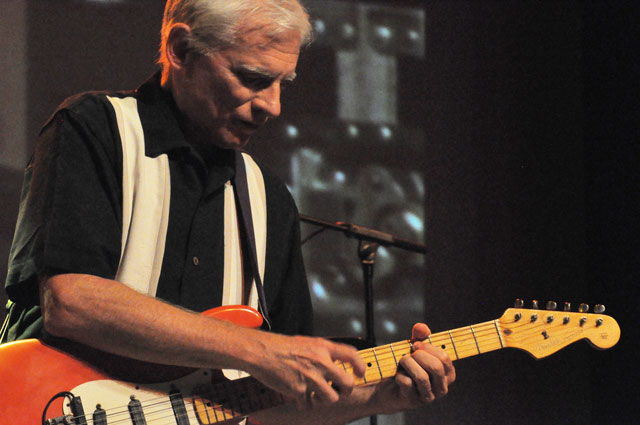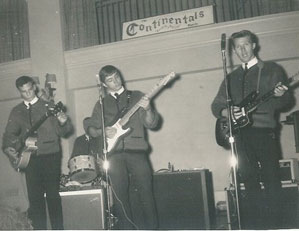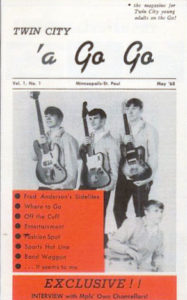Please note that I do NOT list local bands because there are just hundreds of them. The best source on local bands is minniepaulmusic.com, which has loads of info, pictures, posters, and interviews. Another web site is Garage Hangover (14 Minnesota bands). There are a few exceptions, however, some to do with bands from St. Louis Park.
In 1970 Al Jarreau moved to the Twin Cites from Milwaukee. Shortly thereafter he formed a band called Jarreau. The nucleus of Jarreau were members of Twin Cities local band Zarathustra (Rich Dworsky, Kinky Schnitzer, Dick Hedlund, and Dick Bortolussi). (Thanks to Paul Strickland for this Insider info!)
Below is Al Jarreau appearing on Bill Carlson’s “This Must be the Place” program three days after forming the new band.
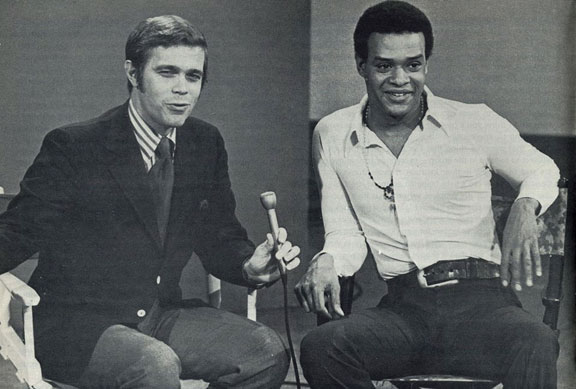
On September 27, 1970, Jarreau opened for Illusion at the Depot
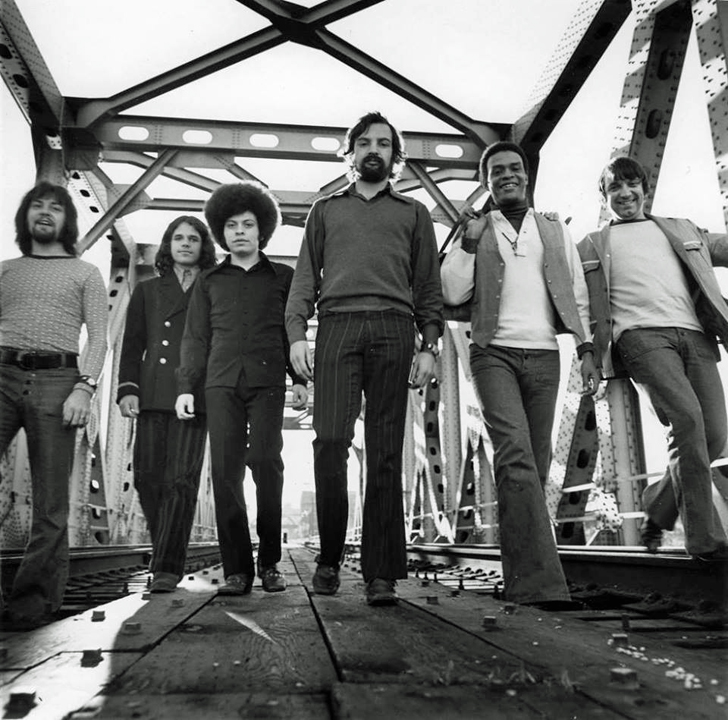
Photo of the group Jarreau courtesy Rich Dworsky
In 1971 Jarreau (the band) broke up and Jarreau (the singer), along with Dworsky, moved to LA. The rest is (better known) history.
Probably one of the most famous musical acts emanating from Minnesota was the Andrews Sisters. They were apparently born in Minneapolis, and spent much of their childhoods in the exurb of Mound, Minnesota. The following is the text of a plaque erected in the City of Mound in their honor, written by Tom Rockvam in 2006.
The Andrews Sisters, LaVerne, Maxene, and Patty, grew up in Mound, Minnesota. They spent all of their summers here from 1917 through 1931, living in a house that today would be at 2506 Commerce Blvd. They also spent a lot of time at their Uncles’ (Pete and Ed Sollie) grocery store, which today would be at 2567 Commerce Blvd. When they won an audition at the Orpheum Theater in 1931, they were hired by Larry Rich, a vaudevillian, and that was the beginning of their 65-year show business career.
They spent all of their childhood summers in Mound and visited every chance they could as adults, which included at least one week each July throughout their very busy and successful careers.
Maxene, especially, had a deep love for Mound, buying 13 acres of land on Westedge Blvd. in 1951. When she died in 1995, she was cremated and some of her ashes were spread on the Pacific Ocean and some were spread on Lake Minnetonka at the Mound swimming beach.
They recorded over 700 songs on the Decca label, sold over 90 million records, had 113 charted hits, had 12 gold records, were the first female group to have a gold record go platinum, were in 18 movies, and were the first and only female vocal group to be inducted into the Vocal Group Hall of Fame in 1998. They had 46 top ten hits in their career, which is more top ten hits than Elvis Presley or the Beatles.
During World War II, they entertained over 161 million armed forces personnel, both in the United States and during their USO tours abroad. Daily they brought upbeat music, laughter, happiness, and hope to everyone during World War II, which was a dark period for Americans.
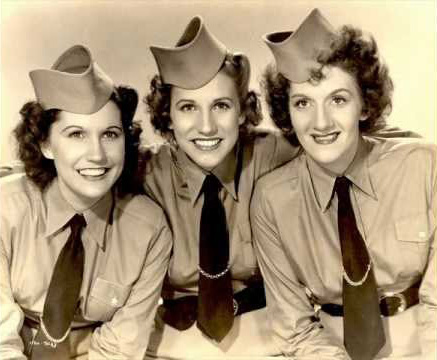
Patty Andrews said that because of all her happy memories in Mound, the only way she could describe Mound is that “It is Heaven on Earth!”
Dubbed the “Godfather of Minnesota Rock” by Tom W. Tourville, Augie Garcia is a Twin Cities music legend. I don’t normally follow the careers of individual artists, but given the importance of Augie’s career in Twin Cities music, and the availability of information about where he played thanks to the newspapers.com database, I thought I’d try to put together a chronology of what music venues he played at over the years. This is NOT a biography of Augie Garcia by any means, but perhaps an attempt to follow his musical footsteps.
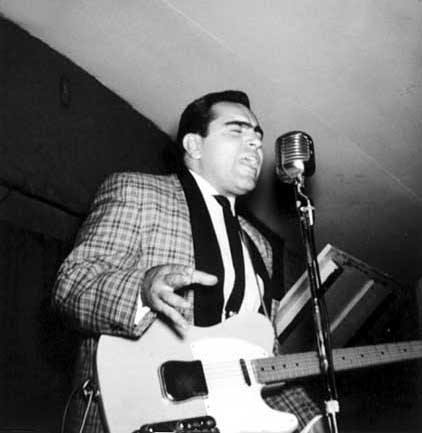
Photo courtesy Minnesota Historical Society
SOURCES
The following was gleaned from several sources, including:
- An audio piece on the Current
- An inventory of photos at the Minnesota Historical Society
- Articles from the archives of the Minneapolis Star and Tribune. Most of these come from the entertainment column “After Last Night,” written by Will Jones for the Minneapolis Tribune. What would we do without Will Jones?
- Tourville’s book Minnesota Rocked!! The 1960’s, 4th Edition (approx. 1996)
- A multi-page article by Dave Hill in the September 1972 issue of the Insider
- A 1964 Ph.D. thesis by Robert Stebbins on the history of jazz, and
- Interviews with family members.
Please contact me with additions or corrections.
EARLY YEARS
Augustine Rudolph Garcia was born on February 19, 1932, in St. Paul. Although of Mexican-American heritage, Augie became known more for jump blues rather than Tex-Mex. Growing up on the West Side Flats in St. Paul, his uncle Frank Garcia Pascquale taught him Mexican songs as a child and bought him his first guitar, which he had embraced by age 9. His father taught him “La Bamba” at age 10 (long before Ritchie Valens’ hit came out). He favored songs by the Mills Brothers, the Ink Spots, the Hi-Los, and the Four Freshmen.
1947
In 1947, at age 15, he made his TV debut on KSTP-TV, possibly on David Stone’s Sunset Valley Barn Dance. In a 1993 interview he said the group was paid in canned goods from Stokely’s Fine Foods – peas and tomatoes.
1948
In 1948 he was in a Caribbean-flavored group called the Boleros. Fellow band members were Al Capiz, Jesse Lopez, and Dick Rowley.
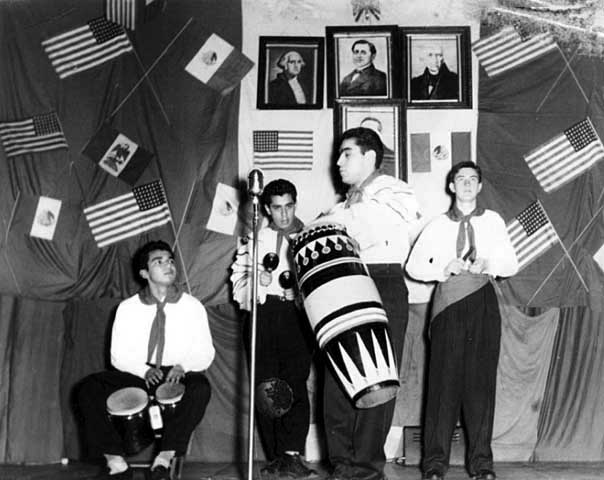
The Boleros, 1948. Photo courtesy Minnesota Historical Society
1949
The photo below from 1949/50 shows Augie and the Boleros performing on the Arle Haeberle show on WTCN-TV.
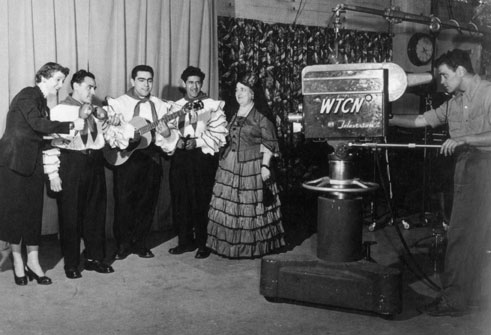
Photo by Edward G. Edmunson, courtesy Minnesota Historical Society
1950
In 1950 Augie participated in the annual Festival of Nations at the St. Paul Auditorium, playing Mexican music. There he met some musicians representing Italy, and they formed his first rock ‘n’ roll band. The group was eventually made up of Joe Sarro, Mike Continelli, Wally Flanagan, and Dom Tallarico. They were called the Continentals after Continelli, who played bass.
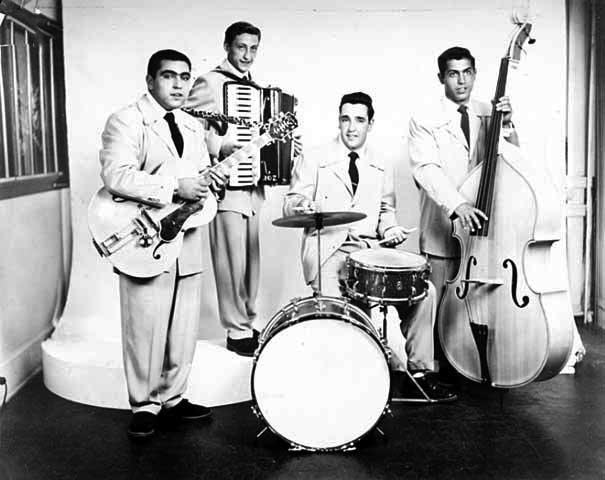
The Continentals, 1951. Photo courtesy Minnesota Historical Society
1951
RIVER ROAD CLUB
Stebbins:
In 1951 Garcia and drummer Jesse Lopez opened at the River Road Club with a small jazz group playing a Shearing style. The band broke up a few months later when the men were called into service. (sic)
1952 – 1954
Augie enlisted in the Army in September 1952 and served in Korea until released in July 1954. During his time in service, he was exposed to the rhythm and blues he became known for. He was particularly taken with Fats Domino records: “It was a rock, a shuffle sound that I liked,” he told the Insider. He also liked Louis Prima.
The story also goes that during a stop in Hawaii he fell in love with Bermuda shorts as a fashion statement. They became his trademark and he wore them winter and summer. Augie’s brother Bob remembers their mother cutting off the legs of his pants, even on his tuxedos.
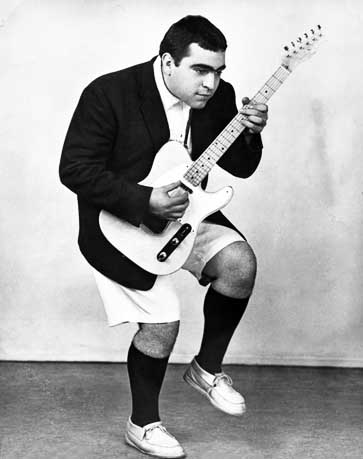
Photo courtesy Minnesota Historical Society
1954
RIVER ROAD REDUX
When he returned from Korea he began working for NSP and put the band back together, calling it the Augie Garcia Quintet.
Stebbins:
In 1954 the [small jazz] group was playing at the River Road Club again, but they never sold very well as a jazz band. As the years went by, they converted to rock-and-roll, a formula which brought them considerable success.
They played what he called “blues,” later “rhythm and blues,” with songs like “Goin’ to Chicago” and “Let the Good Times Roll.” The term “rock ‘n’ roll” hadn’t been invented yet – they called their music “kicksy.” He always had a black sax player. They were regulars at the River Road Club from 1954 to 1958. The band played eight times a week – every night and an extra matinee on Sundays.
MHS photos show the band performing in front of a banner that says they were featured on the Key Room Show on KEYD-AM. The banner gives the show’s host as Dave Reau, and the time slot as 11-11:15 am. The Key Room was broadcast on Saturday mornings starting at 9:00 am. Available ratings books show that the show ran until 11:15 am from November 1953 to August 1954; to 11:30 am from September to October 1954; to 11:00 am from November 1954-April 1955; and to 11:30 am from May to August 1955.
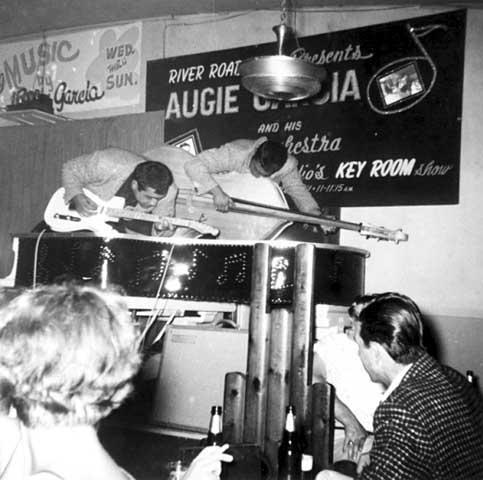
Augie and Mike Continelli at the River Road Club, with banner advertising Key Room radio show. 1955 Photo courtesy Minnesota Historical Society
1955
THE PRESS BEGINS
The first article in the Minneapolis papers on Augie, dated March 29, 1955, was substantial: a long piece by Will Jones entitled, “Under the Bridge Hides a Hot Guitar.” It’s long but bears repeating in full, as it is Augie’s introduction to the Twin Cities.
Just finding the River Road club, a beer joint that lies at the end of a narrow road that winds along the river under the Mendota bridge, is a small accomplishment in itself.
Once you get there – as I did over the weekend – the reward comes in the form of a short, barrel-chested guitar player named Augie Garcia.
Garcia works in Bermuda shorts, pink-and-charcoal argyle socks, a sleeveless kind of pink toga, and a pair of moccasins that look like sacks. He plays a guitar that could have been designed by Salvador Dali.
His quartet includes a drummer with a loud, relentless beat and a piano player who stands up while playing. They work under a dim blue spotlight.
Garcia hunches over his guitar in an ape-like pose, sweats profusely, and hoarsely chants such inspired lyrics as “Drinkin’ wine, spo-dee o-dee.”
A college-age crowd keeps the dance floor jammed. They work, too, and enjoy it. They were pretty tolerant about letting a couple of pairs of old married folks two-step around the edge of the dance floor, the better to observe the fun.
In fact, I got bumped and shoved less on that dance floor than I do in the Flame room. Garcia plays Friday, Saturday, Sunday and Wednesday nights.
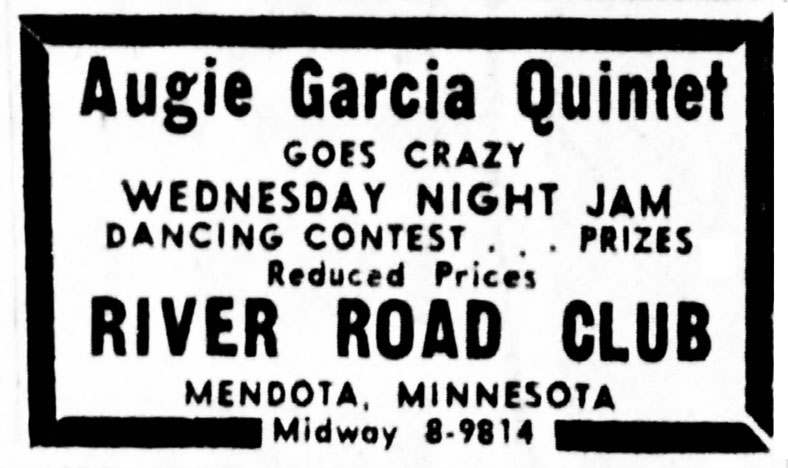
Minneapolis Star, November 1955
The band blasting it out at the River Road Club. Below are Augie on guitar, Willie Brown on saxophone, and Buddy Davis on piano.
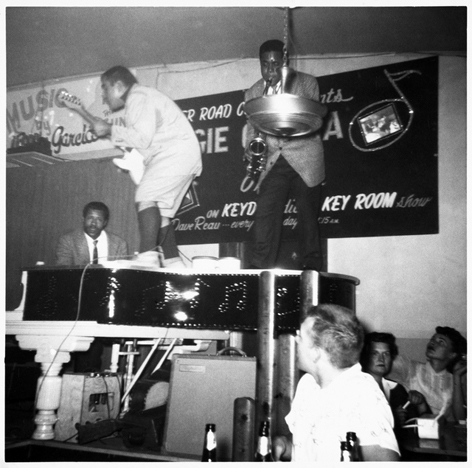
Photo courtesy Minnesota Historical Society
1956
AUGIE, ZINGALE, AND ELVIS
In May 1956 Augie was approached by WCOW DJ Joe Zingale (“Mr. Rhythm”), who had a rock ‘n’ roll show in the afternoons. The DJ asked if Augie would like to open for Elvis Presley, who was scheduled to play the St. Paul Auditorium in the afternoon and at night in Minneapolis. The weather was bad and it was Mothers’ Day, so audiences were scant. Augie was not mentioned on the advertising in the Minneapolis papers – the St. Paul papers are not available to me. It is unclear whether Augie was scheduled to open for Elvis in St. Paul only. He is not mentioned in any review that I found in the Minneapolis papers, so the response to his performance comes from eyewitness accounts only.
Augie and his band performed “Ivy League Baby” and “Hi Yo Silver.” The reaction to Augie’s set was so enthusiastic and frenetic – kids were yelling and standing on their chairs – that Col. Tom Parker was worried that he would upstage the main attraction. Legend has it that the Colonel yanked Augie off the stage by his jacket, either after the second song or in the middle of the third. “There wasn’t supposed to be any competition,” Augie told reporter Chuck Haga in 1993.
Augie’s brother Bob doesn’t remember it quite that way, but does remember that Augie only played two songs and was supposed to play for half an hour. The Garcia family came to see Augie and didn’t stay to see Elvis!
Drummer Johnny Lopez’s obituary told the same story: (Minneapolis Star Tribune, January 23, 2006)
[Johnny] never tired of telling friends and family that Presley’s manager… ordered him and the rest of the Augie Garcia Quintet to leave the stage before its 1956 performance at the St. Paul Auditorium was over. “Colonel Parker was afraid that Elvis would be outplayed by a bunch of Locals,” said Lopez’s Daughter, Margo Lopez-Ulrich of Minneapolis. “They had a packed house and they really had the place rocking.”
HEADY TIMES
These were the fun days for the band – playing every night to packed houses, and making some money, too. Mike Continelli’s ex-wife Florence told her nephew Mike Nilles this anecdote about their new-found fame and fortune:
Both Mike and Augie bought brand new MGA convertibles – they were real hipsters. Only problem was that Uncle Mike had to drop the top even in the winter in order to transport his bass fiddle!
W. 7th STREET REC
By May 1956, Augie had moved to the W. 7th Street Rec. (formerly Stransky’s Bar) in St. Paul.
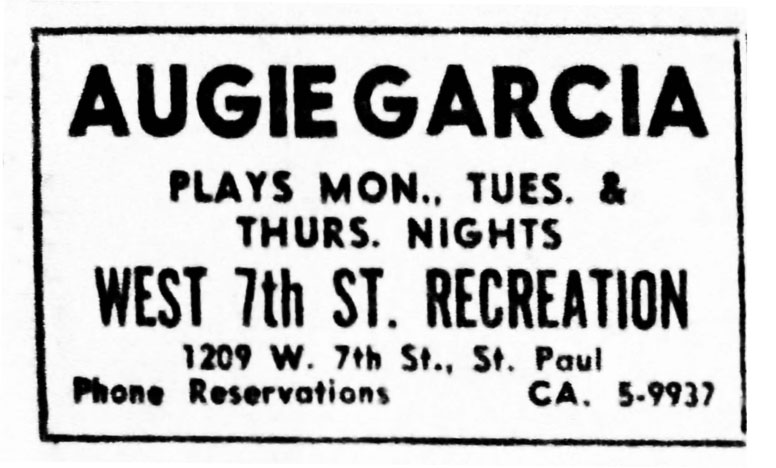
Minneapolis Tribune, May 27, 1956
1957
Item from Will Jones, January 11, 1957:
Some local rock-and-rollers – Augie Garcia, Bill Samuels and Teddy Guzman – will play for a rock-and-roll dance party in the Prom Monday Night [January 14, 1957]. Two local vocal groups, the Septones and the Chickens, also will be featured. Leigh Kamman will emcee.
An ad dated January 15, 1957, said that Augie was playing at the W. 7th Street Rec. on Tuesdays. Doc Evans was playing on Thursdays. By May 10, he was playing nightly and Sunday afternoon.
There are many fun photos of the band at its best at the W. 7th Street Rec, and I will post them here. What’s amazing is that they didn’t all end up in the hospital after falling off that tiny stage!
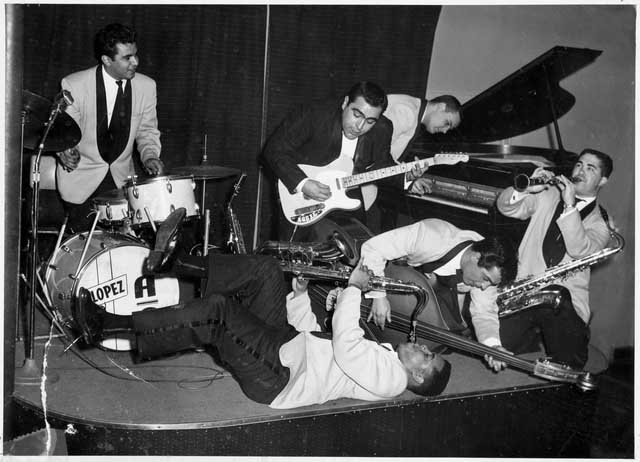
Photo by Buzz Brown, courtesy Minnesota Historical Society
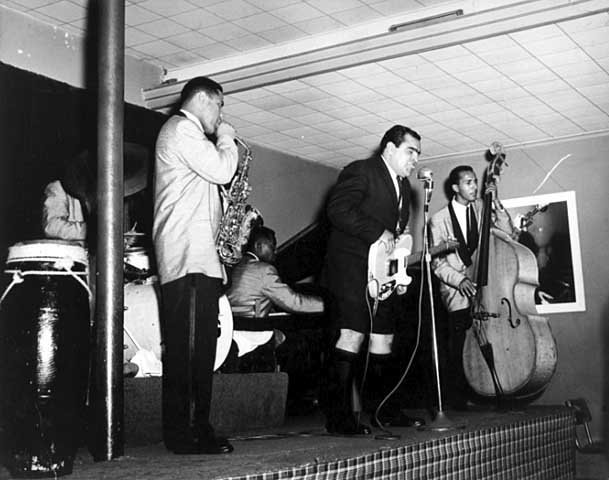
Photo courtesy Minnesota Historical Society

W. 7th Street Rec with singer Peaches Gamble. Photo courtesy Minnesota Historical Society
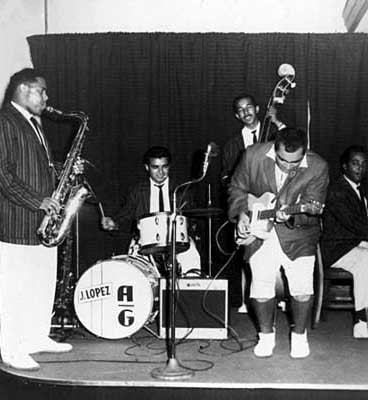
Photo courtesy Minnesota Historical Society
1958
1958 saw the Augie Garcia Quintet at a variety of venues.
On March 3, 1958, the Quintet made a special performance at the Marigold Ballroom, with vocalist George Davo. Or Darvo, depending on which ad you look at.
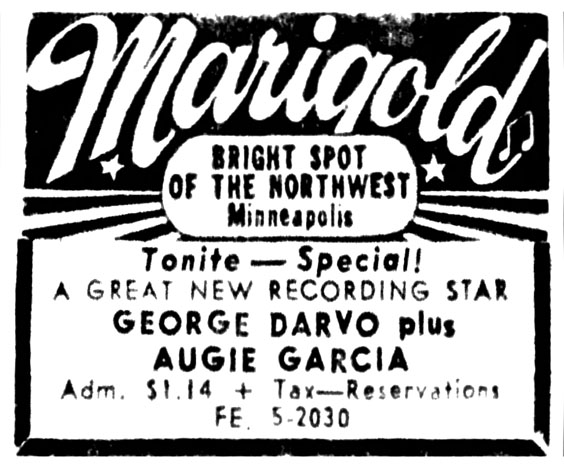
Minneapolis Tribune, March 3, 1958
On March 18, 1958, Augie and his band entertained at a “mixer” thrown for high school students attending the state basketball tournament. The event was hosted by the Panhellenic and Interfraternity councils at the University of Minnesota at Coffman Memorial Union. Other entertainment was provided by local high school talent:
- The Vincents, from St. Louis Park
- The Blue Cats, from Robbinsdale
- The Continentals, a vocal group from Washburn
- Borghilde Larson, a comedienne from Northfield
THE JAZZ LAB
On March 19, 1958, Will Jones reported on a police raid on a place called the Jazz Lab, located at 815 Payne Ave. in St. Paul.
It’s an old house where people go to sit in candle-light and listen to jazz on a hi-fi, and talk about it, and maybe eat spaghetti or something. You see persons like Augie Garcia there.
The rest of the item turned into a non-story about how the police were convinced that a book discussion group must have been drinking because of the number of cars outside. It’s unclear whether Augie was playing jazz or listening to it in the blurb above, but there it is.
On May 4, 1958, Will Jones reported that Augie was at the W. 7th Street Rec. The Insider interview revealed that the River Road Club changed hands, which prompted the move of the band.
Augie, who still wears Bermuda shorts all year long, is there every night but Monday with his band and his guitar by Picasso, supplying dance music for the generation that comes as close as you can come in St. Paul to being beat.
There’s more light in the W. 7th Rec. than there was in the last place I observed Garcia in action (somewhere under the Mendota bridge). This fact makes viewing the dancers, for us aging noncombatants, much easier.
May 14, 1958, Will Jones:
Augie Garcia, his Bermuda shorts, his guitar and his band are all going to report back to the River Road club, under the Mendota bridge, on May 21. Garcia made his first big rock-and-roll splash there, and then left on account of money. Now that’s what’s taking him back there. The owner pushed up the budget.
On June 3, 1958, Augie returned to the Marigold for another special dance.
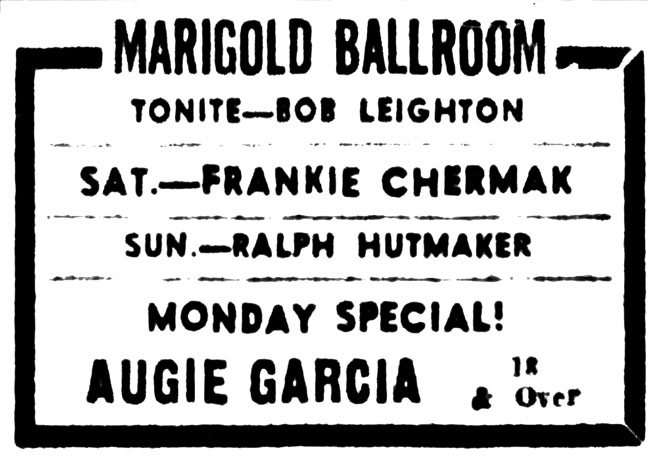
Minneapolis Tribune
CRYSTAL COLISEUM
Another early Rock ‘n’ Roll venue was the Crystal Coliseum. The 1958 ads are not very interesting, so I won’t post them, but I’ll give the dates that I found.
The earliest I found was Tuesday, June 24 – the ad said that Augie also performed on Saturdays and Sundays.
The next date was Tuesday, July 8, also mentioning Saturdays and Sundays.
After that, we have:
- Tuesday, July 15
- Monday, July 21
- Tuesday, July 29
He may have been playing the Crystal Coliseum and the River Road Club at the same time; evidence is the item below:
July 7, 1958, Will Jones:
The only instrument that isn’t amplified electronically, in Augie Garcia’s band at the River Road club, is the drum. “Sometimes Augie gets carried away and doesn’t realize when it’s quitting time,” said owner John Gospeter. “When that happens, I just pull the fuse and he’s out of business.”
On July 18, 1958, Augie was one of the guests of Mary Jo Tierney on her local TV show on Channel 9 at 3:30 pm.
1959
The only gigs I found in 1959 were two stints at the Crystal Coliseum: one in July and one in October, and both on Sundays only. These ads are a little more interesting, so I’ll post them.
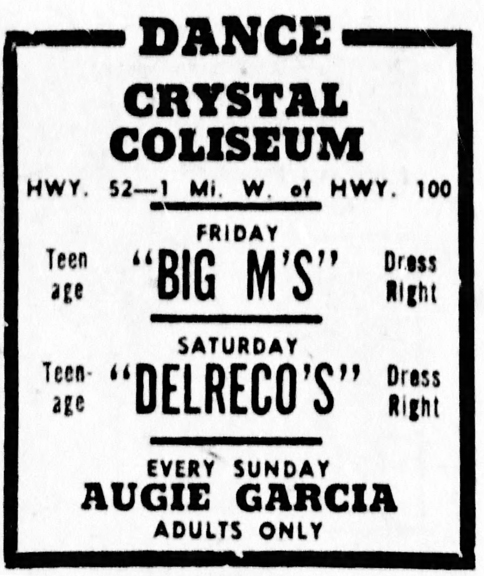
Minneapolis Star ad for July 5, 1959
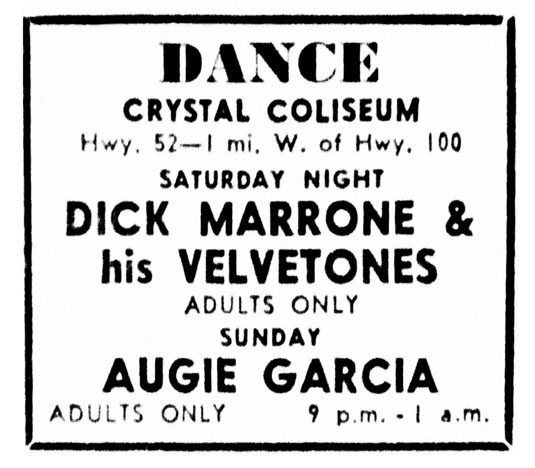
Minneapolis Tribune, ad for Sunday, July 19, 1959
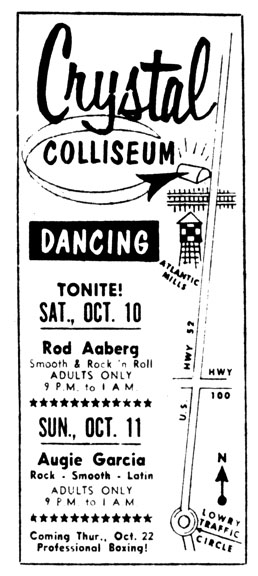
Minneapolis Star, ad for Sunday, October 11, 1959
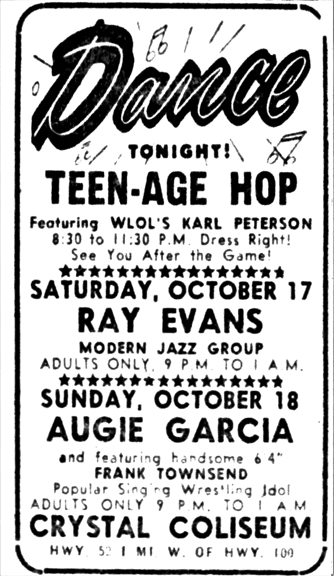
Minneapolis Star ad for October 18, 1959
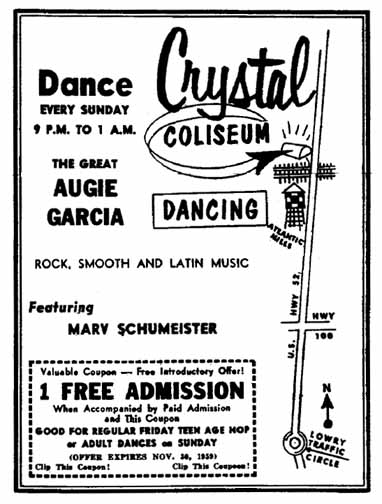
Minnesota Daily ad for Sunday, November 15, 1959
1960
February 2, 1960, Will Jones:
Augie Garcia will return to his old haunt, the River Road Club at Mendota, Friday night [February 5]. Garcia and band will appear there Tuesdays through Sundays, with matinees on Sundays.

Minneapolis Tribune, April 15, 1960
SWEDE’S
July 11, 1960: Will Jones wrote a long article entitled “Swede’s Swings in Long Pants.” Here are some excerpts:
The folks at Swede’s are entertained nightly by Augie Garcia – the same Augie Garcia who used to wear orange shorts and blam out rock ‘n’ roll at the River Road club, yet not the same Augie Garcia at all.
Garcia, always a showman, has matured into a well-rounded entertainer. His group has matured from blasting rock ‘n’ roll exclusively to become a lively, versatile, driving group, playing some contemporary jazz, Latin numbers, novelties, and a little rock ‘n’ roll too.
And Garcia has promoted himself, literally, out of the knee pants. “I used to wear the shorts winter and summer,” he said. “When I started wearing them, five or six years ago , I was one of the first around here to wear bermudas. But I walked into Sub and Herb’s, over by the campus, not long ago, and everybody in there was dressed just like me. I decided if I still wanted to be different, I’d have to go back to long pants.
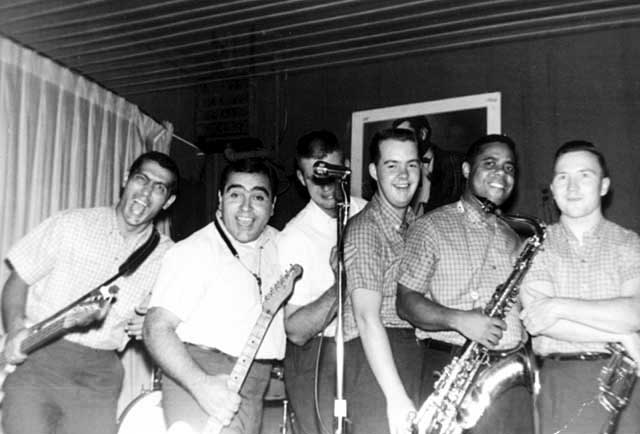
Augie and the Quintet at Swede’s, 1960. Photo courtesy Minnesota Historical Society
Between numbers, Augie plugged the judo club he had set up in the basement of Swede’s. Some 15 regulars at Swede’s had joined – no women allowed.
Here’s a stray Crystal Coliseum show on December 10, 1960. The place would burn down on June 5, 1961, ending the career of one of Twin Cities’ earliest rock ‘n’ roll dance venues.
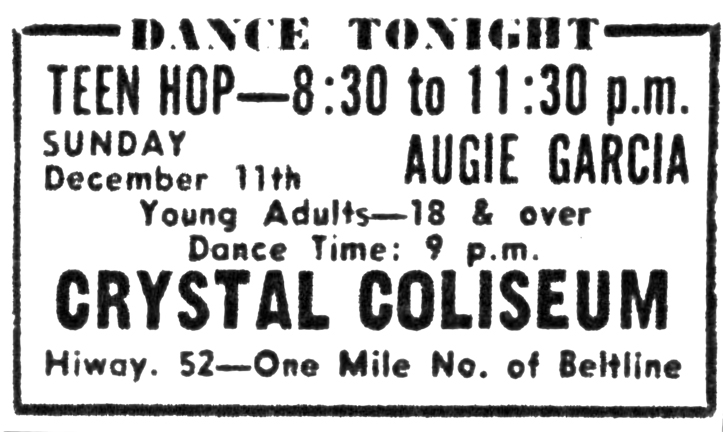
Minneapolis Star, December 10, 1960
PHIL’S BLUE ANGEL
Augie played at Phil’s Blue Angel from December 20, 1960, to April 30, 1961, when the dance hall closed down, one article said. He had to go to the Musicians’ Union 73 to attempt collection of $629 that was owed to him. No indication as to whether Augie got his money, but there were many machinations going on within the unions.
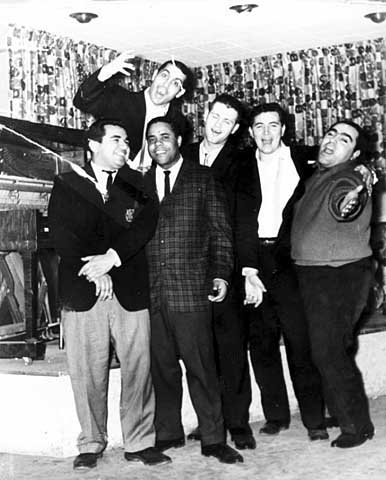
Augie and the Quintet at the Blue Angel Room. Photo courtesy Minnesota Historical Society
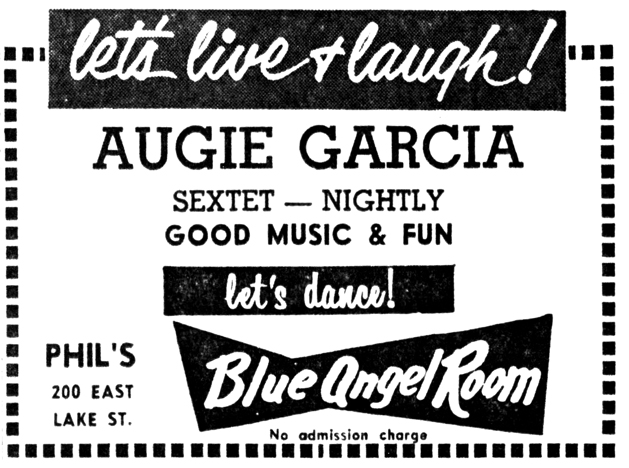
Minneapolis Star, December 22, 1960
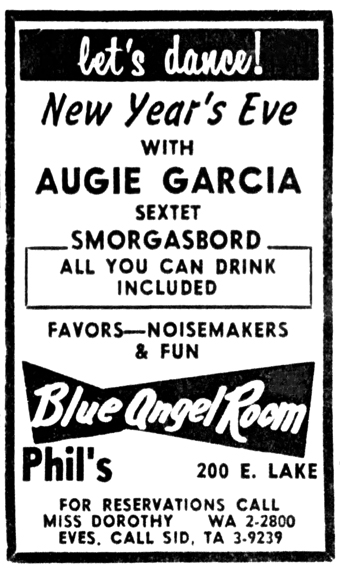
Minneapolis Star, December 29, 1960
1961
On Saturday, April 15, 1961, Augie and his band took a night off from the Blue Angel and performed at the Walker Art Center’s Annual Ball.
On May 4, 1961, Augie and his band opened at the Lakeview Inn in Spring Park, playing Thursdays through Sundays. This gig didn’t last too long – he was at the Loon by June 6, Tuesdays through Sundays, with long sessions starting at 4 pm Sundays.
INAUGURAL BALL
Augie and his band performed at the Inaugural Ball of Mayor Arthur Naftalin on July 3, 1961. Will Jones reported:
Bandleader Augie Garcia was beset on one side by city all old-timers who kept asking him to play a beat they could dance to, and my university types who kept urging him to stay with the Lake St. beat. Garcia usually favored the latter, and the ones who couldn’t get with the beat at least had a good show to watch. Prominent in the cast of dancers were all sorts of young Naftalins.
When asked to play “Anniversary Waltz” for the Naftalins’ 20th anniversary, which coincided with the inaugural, Garcia gave it a jazz treatment. That was all right with Mrs. Naftalin. She can’t stand “Anniversary Waltz.”
On August 30, 1961, Will Jones reported that the Invitation of the Week was for the wedding reception of Augie and Donna Simmer on September 11 at the Loon. “Married guests can phrase their own jokes.”
THE TWIST COMETH
The end of 1961 was the dawn of the Twist Era, and Will Jones reported that a movie called “Hey, Let’s Twist was opening at the Uptown Theater on December 22, 1961, to capitalize on the craze. The following night, Saturday, December 23, 1961, Augie Garcia and His Twisters (a name used just for that night) would play live on stage for a twist contest at 8:30 pm.
Meanwhile the twisters have pretty much taken over the Loon, where Garcia plays regularly. And Willie Brown, Garcia’s sax player, has blossomed as a twist singer.
THE LOON
In about October 1961, Augie and his band moved to the Loon Club on Lake Street, which later became better known as Mr. Lucky’s. It had just morphed from the Friendship Club that April. It was a rockin’ place, hosting such early rock ‘n’ rollers as Bill Haley, the Champs (“Tequila!”), Wanda Jackson, Conway Twitty, Jerry Lee Lewis, Bo Diddley, and local groups like Roscoe and His Little Green Men.
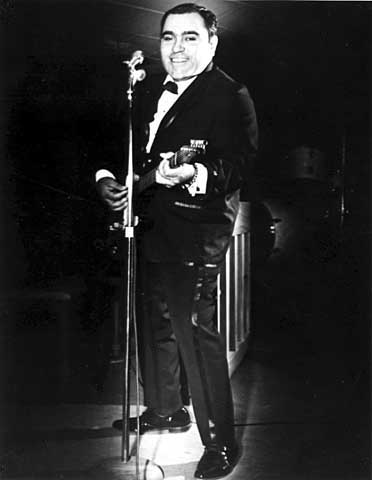
Augie at the Loon, 1961. Photo courtesy Minnesota Historical Society
The first ad found was dated October 15, 1961, where he was appearing “nightly.” Also October 29.
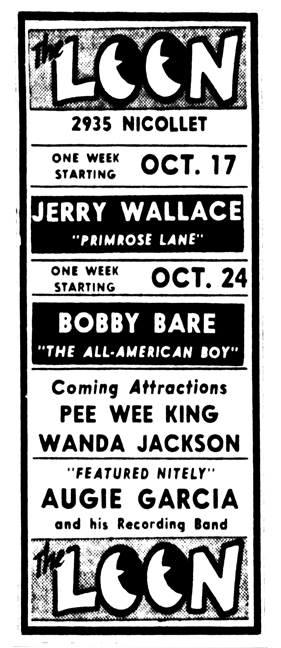
Minneapolis Tribune, October 15, 1961
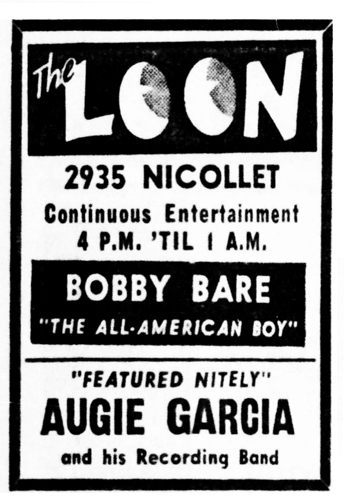
Minneapolis Tribune, October 29, 1961
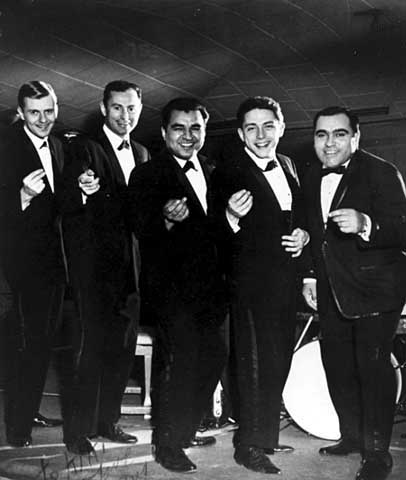
Augie and the boys at the Loon. Photo courtesy Minnesota Historical Society
Then a gap, and two more ads in 1961, where he started on December 12, and was appearing nightly on December 16, 1961.
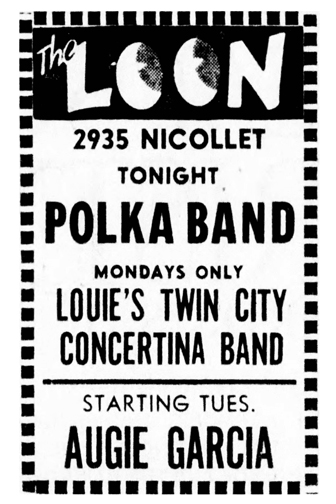
Minneapolis Star ad for December 12, 1961
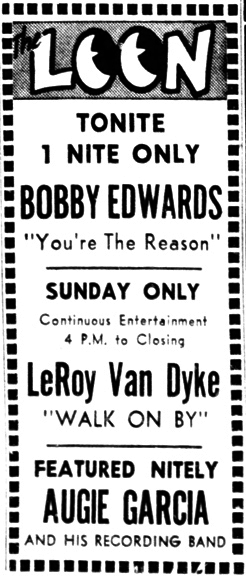
Minneapolis Tribune, December 16, 1961
1962
Augie continued at the Loon in 1962. They were obviously having fun with the Twist! On February 3, 1962, there was a Battle of the Bands between Rosco and His Greenmen (Direct from Mars) vs. Augie Garcia (Direct From Earth). How silly. Although these ads usually only mentioned Augie’s name, he was still performing with his Quintet.
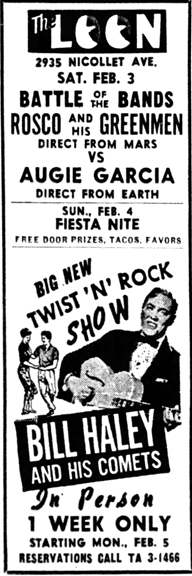
Minneapolis Tribune
Another fun show must have been Tony and the Knights (“The Peppermint Twisters”) vs. Augie Garcia’s “Taco Twisters.” Hardly correct today! Same show advertised on February 16.
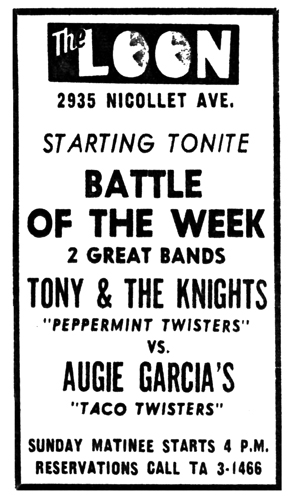
Minneapolis Star, February 13, 1962
BACK AT THE BLUE ANGEL
From April 13 to August 7, 1962, the Minneapolis Star and Tribune were on strike. On May 1, 1962, the Minneapolis Daily Herald was created by businessman Maurice McCaffrey to pick up the slack.
On May 18, 1962, the Herald published an ad for the Blue Angel Room, featuring the Augie Garcia Quintet, playing Wednesday through Friday, and Saturday and Sunday. I guess that leaves out Monday and Tuesday. Slow days.
DUFFY’S
Augie and his band took over the revolving stage at Duffy’s starting on September 10, 1962. On September 18, 1962, the Herald published the ad below announcing Augie’s change of venue:
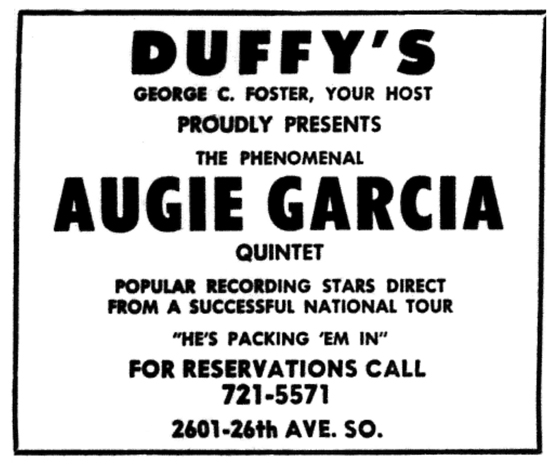
Minneapolis Daily Herald, September 18, 1962
McCaffrey intended for the Herald to continue, even after the Strib’s strike ended, and it did for a while, but the last issue of the Herald was on October 1, 1962.
On October 1, 1962, Will Jones of the Tribune filed this report:
At Duffy’s, the theme is chaos… In the two dance rooms, Augie Garcia and quintet make conversation impossible in both simultaneously, thanks to the revolving stage in the wall between the rooms.
Garcia started out his engagement there with a piano as part of his instrumentation, but the piano player complained his fingers were getting sore and bloody from trying to make himself heard. An organ was substituted for the piano, and there’s no trouble hearing that at all.
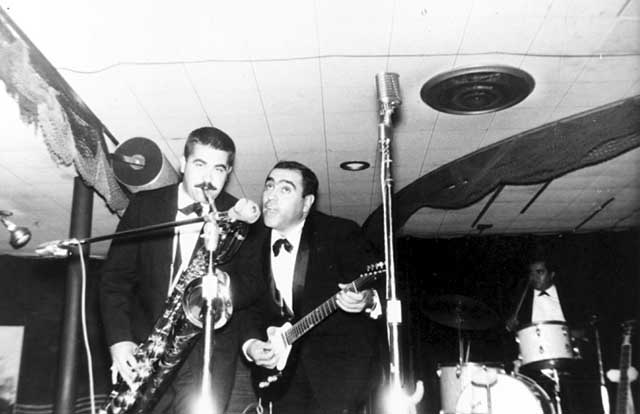
Augie at Duffy’s, 1962. Photo courtesy Minnesota Historical Society
On October 16, 1962, Jones reported that singer Shari Farris has “bounced” out to Duffy’s to sing with the Quintet.
Augie and his band opened for national acts like Chubby Checker and Little Richard at Duffy’s.
This ad is a bit hard to see, but lists the members of Augie’s ensemble:
- Augie on guitar
- Don Rustad on sax and vibes
- Art Resnick on organ
- Shari Ferris, Songstress
- Jesse Lopez on drums
- Ellen as the Twist Girl
Of course it was 1962, so the Twist was featured, but the band also played Jazz and Ballads.
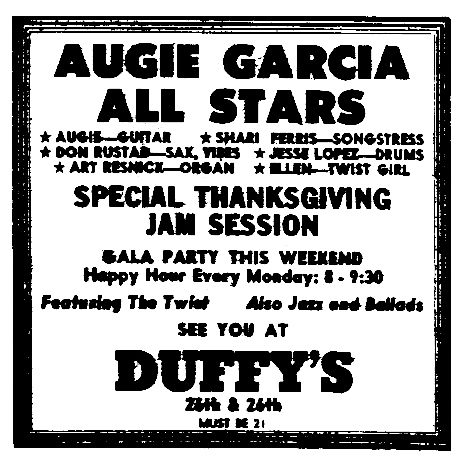
Minnesota Daily, November 21, 1962. Ad courtesy Robb Henry
1963
On July 3, 1963, Will Jones reported that guitarist Bryce Robertson joined up with Augie’s group at the Twin Lights on W. 7th Street in St. Paul on Wednesday through Saturday nights.
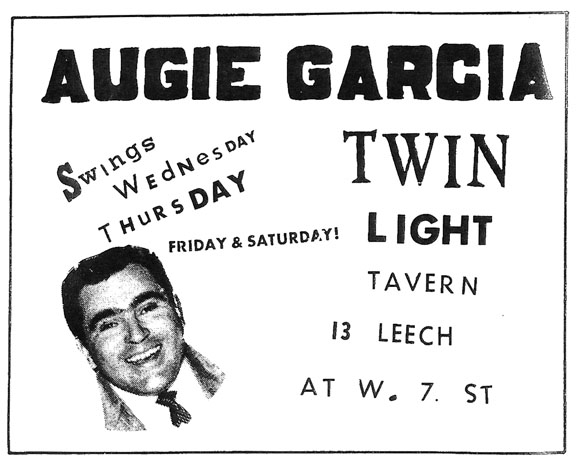
On August 9, 1963, Augie and the band opened Frank Seifert’s, which replaced the Key Club.
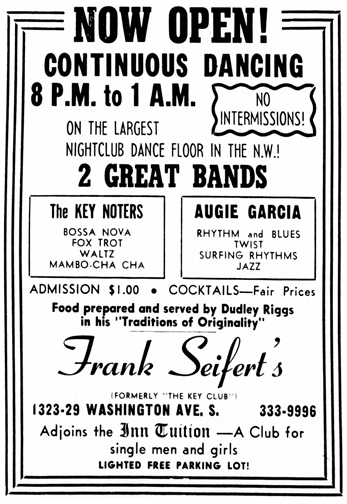
Minneapolis Star, August 9, 1963
On August 19, 1963, Will Jones observed,
The combination of Augie Garcia’s band and the old Key Club sound system adds up to so many decibels that life in the dance-hall part of Frank Seifert’s is unbearable … It’ll take some engineering…
It appears that Augie’s band was at Seifert’s until September 20, 1963.
HALL OF FAME
The Hall of Fame was located at the All Star Bowl in the Midway Shopping Center.
Augie was there in December 1963, and he could have been there in January 1964 as well.
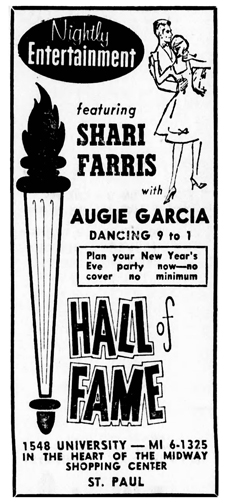
Minneapolis Star, December 28, 1963
1964
Augie’s band opened on February 18, 1964 at Papa Joe’s on W. Broadway. On March 2, 1964, Will Jones noted that the sign at Papa Joe’s still had the old name of the place, the Northern Bar. “For a long time it was strictly a rock ‘n’ roll place, but Garcia is mixing in some jazz, Latin and show numbers,” reported Jones.
HIATUS
In 1964 the band broke up and Augie went back to being an ironworker, which he did for a total of 31 years until he retired in or before 1993.
1969
SINGLE
Augie started up again as a single in 1969, first at Hafner’s on the East Side of St. Paul, then at the St. Paul Holiday Inn.
Another place he worked as a solo in 1969 was the newly refurbished Nob Hill Room at the White House. Will Jones observed that the “newly haberdashed” Augie was almost as elegant as the new room. (Tribune, November 23, 1969)
Garcia, who was playing rock on an electric guitar in these parts before some of the kids who are now dancing to that kind of music were even invented, has worn some pretty wild outfits in his career. The stage uniform was orange bermuda shorts in the early rock days. Later it was karate robes, when he was giving karate lessons between sets in the basement at the old Swede’s on Lake St.
Now it’s fancy ruffled lace evening shirts with his dinner suit as he does a complete musical about-face, picking genteel solo Flamenco guitar to accompany the piccata of veal.
Don Morrison’s column in the Minneapolis Star about the refurbished Nob Hill room indicates that Augie had been playing there from at least November 7, 1969.
1971
In February 1971, Augie and Ross Phillips began stints entertaining at the Golden Fox restaurant. Unclear whether they were working together.
1975
The last performance ads for Augie found in the Minneapolis papers were in 1975.
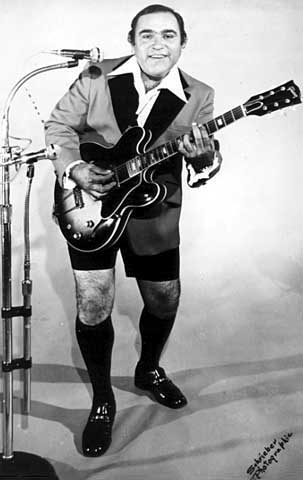
Augie in 1974. Photo courtesy Minnesota Historical Society
The first was for a gig at a place called Adam’s Rib, located on the 494 Strip. The text read, “That fabulous guy is putting it all together again. Tuesdays thru Saturdays 8:30 pm until closing.”
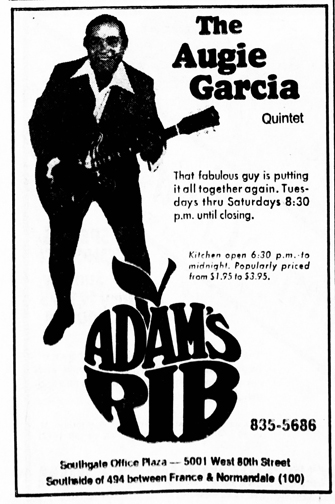
Minneapolis Tribune, January 5, 1975
The second was for Awada’s Bar and Restaurant.
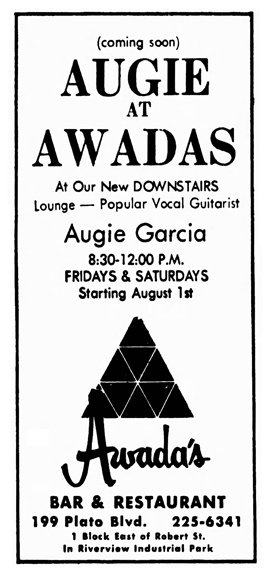
Minneapolis Tribune
1981
A profile of Augie was presented on a show called “NightTimes: Magazine,” on Channel 2 on February 3, 1981, at 7 pm and February 4 at 12:30 am.
1984
The Minnesota Rock Reunion Record Show was staged on Sunday, March 25, 1984, at the Holiday Inn in St. Paul. The program featured record and souvenir collectors and dealers as well as appearances by former members such classic Minnesota bands as the Trashmen, Castaways, Jokers Wild, The Litter, Stillroven, Underbeats, Gregory Dee, and Augie Garcia.
1989
In early May, 1989, Augie was performing regularly at Garcia’s restaurant (no relation).
1993
In a July 8, 1993, interview with Star Tribune reporter Chuck Haga, Augie said that he played private parties and weddings about once a month, and would like to do more, but karaoke, like disco before it, had done a number on live music, and was much cheaper than hiring a live band.
1996
On April 20, 1996, Garcia participated in a reunion concert at the Prom Expo Center in St. Paul. He wore his signature shorts and sang the old songs, and “the people just went nuts,” said his brother-in-law David Hase. Members of the band that night were Maurice Turner, bass; Gary Berg, tenor sax; Don Rustad, alto sax; Johnny Lopez, drums; and Cornbread Harris, piano.
AUGIE GARCIA DAY
April 20, 1996, was also designated Augie Garcia Day by Norm Coleman, Mayor of St. Paul. The Proclamation Read:
WHEREAS, Augustine “Augie” Garcia was born and raised on Saint Paul’s West Side and he rose to become a musical legend; and
WHEREAS, Augie Garcia is celebrating forty-five years as a renowned performing musician; and
WHEREAS, Augie Garcia has gnerously contributed his time and talents to benefit organizations such as Guadalupe Area Project and Our Lady of Guadalupe Church; and
WHEREAS, Augie Garcia has been a musical pioneer and has paved the way for many artists to enter the music business; and
WHEREAS, Augie Garcia has often been described as the “King of Twin Cities Rock ‘N’ Roll“;
NOW, THEREFORE, I, Norm Coleman, Mayor of the City of Saint Paul, do hereby proclaim Saturday April 20, 1996 to be
AUGIE GARCIA DAY
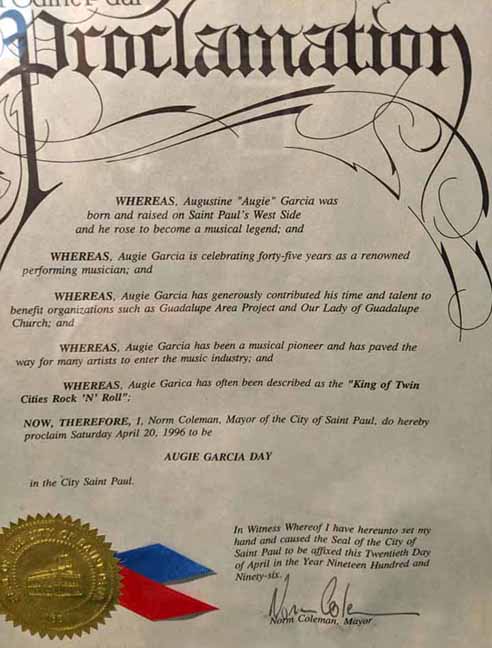
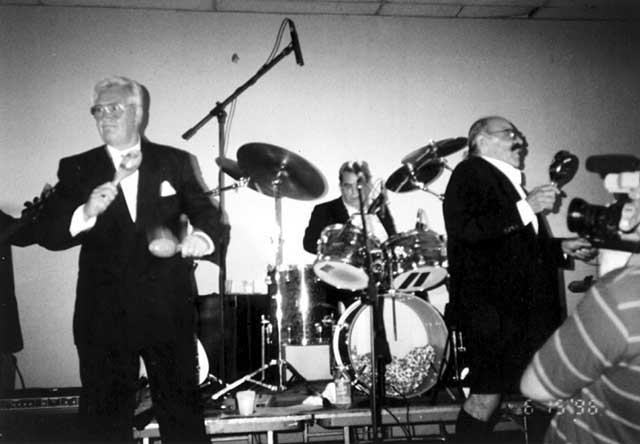
Don Rustad, Jesse Lopez, and Augie at the 1996 Reunion. Photo courtesy Minnesota Historical Society
Another reunion show followed in June 1996. A VHS tape of one of the reunion shows is available for viewing at the Gale Family Library, third floor of the Minnesota Historical Society.
1998
Garcia was instrumental in building the Korean War Memorial in St. Paul, erected in 1998.
1999
Augie Garcia died at his home in Roseville on August 6, 1999, of throat cancer. Survivors included his wife, Nancy, and daughters Angie and Elena, all of Roseville.
OTHER VENUES
- The Padded Cell (per Insider interview)
- The Torch (per Insider interview)
- Sherwood Supper Club
- Viking Lounge, Holiday Inn
- Duff’s
His show always included a song in Spanish, and he always played “La Bamba.”
MUSICIANS
Members of the Augie Garcia Quintet over the years included:
- James “Jimmy” “Cornbread” Harris on piano (Jimmy Jam’s father)
- Willie Brown on sax
- Gary Berg on tenor sax
- Don Rustad on alto sax
- Johnny Lopez (Jesse Isadore Lopez Sr.) on drums
- Buddy Davis on Piano
- Maurice Turner on bass (Prince’s uncle)
- Mike Continelli on bass
- George Avaloz
- Francisco (Kiko) Rangel, sax
- Eugenia Rangel
- Bryce Robertson on guitar (July 1963)
RECORDINGS
According to the Insider interview, Augie Garcia made four 45 rpm records, eight sides. The interview said that those four records sold about 100,000 copies.
Those sides were listed in the interview as:
- Goin’ to Chicago
- Let the Good Times Roll
- Hi Yo Silver
- Ivy League Baby
- Drinkin’ Wine Spoli Oli
- Hello Baby
- Fannie Brown
- River Road Boogie
NORTH STAR RECORDS
Three of the records were made on the North Star label. North Star was located at 1936 University Ave. in St. Paul, and recorded mostly old time and polka music, distributed only in the Midwest. Augie’s records were reportedly recorded in someone’s house on Payne Avenue in St. Paul.
“Hi-Yo Silver”/”Going to Chicago” – North Star 2025 – was recorded in 1955. Many have cited this as the first Rock ‘n’ Roll record made in Minnesota.
In an interview with Jon Bream of the Minneapolis Tribune (May 7, 1989), Augie described the recording of “Hi Yo Silver:”
We were all in one room when we set up, but toward the end of the recording we had one guy down the hallway because of the loudness of the drummer. It was kind of comical because I would say, “OK, guys, are you ready?” because we couldn’t even see one another.
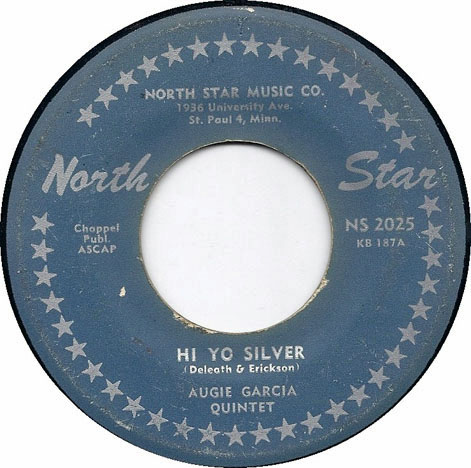
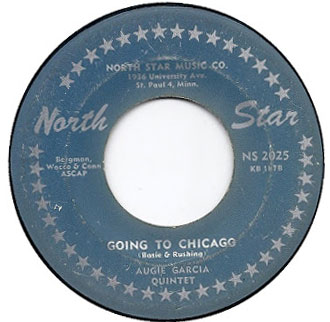
“Drinkin’ Wine Spoli Oli”/”Hello Baby” – North Star 2023 – was also recorded in 1955. This number is lower than No. 2025 above, which begs the question of which actually came first?
Jeremy Hage says,
I think “Drinkin’ Wine” came first. Not only because of the number, but also because it was released as a 78 also. I’m guessing the 78 didn’t sell well so they never pressed any 78s in later singles.
So maybe THIS was the first Rock ‘n’ Roll record made in Minnesota. Signs seem to point.
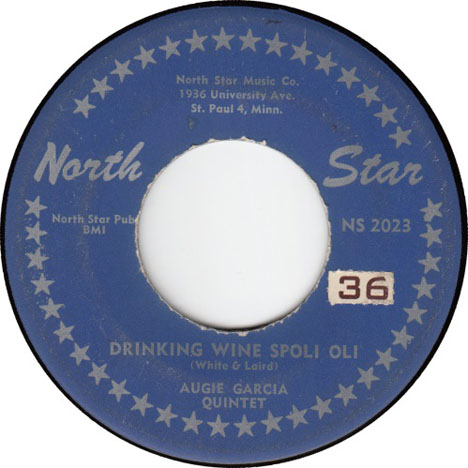
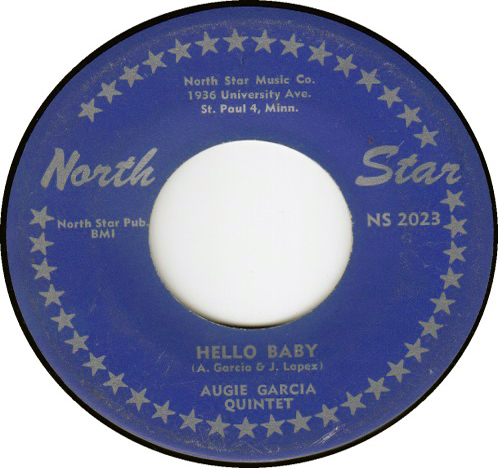
“Ring-A-Ling”/”Be My Guest” – North Star 2065 – was recorded in 1957.
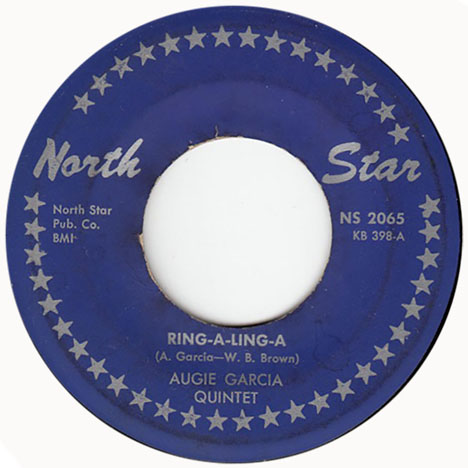
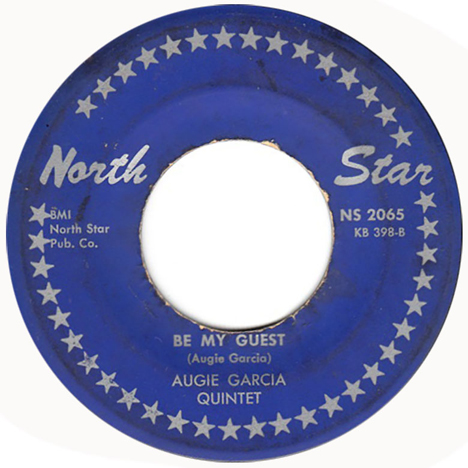
KIRK RECORDS
There were also two sides recorded on the Kirk label:
“Ivy League Baby”/”Let the Good Times Roll” – Kirk TJ I133 – was recorded in 1956.
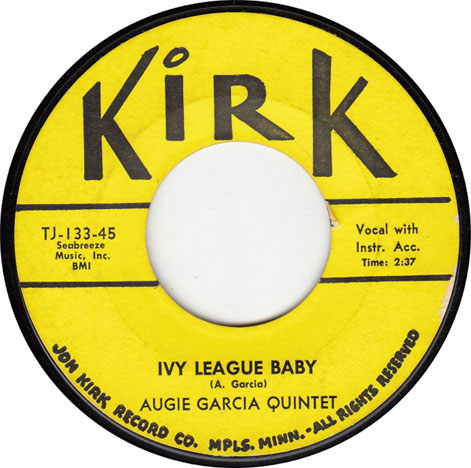
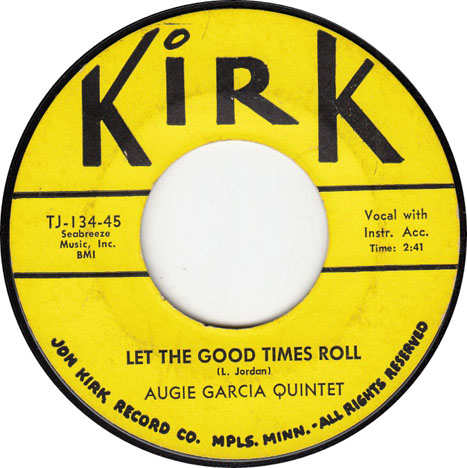
Local record expert Derik Olson says:
The Kirk record was pressed on cheap vinylite, and the glue they used to affix the label was poor quality, so all copies I’ve seen have the labels coming off, or missing entirely. I’ve never seen any other record from the Kirk label, so it was probably the only release.
“Fannie Brown” and “River Road Boogie,” mentioned in the Insider interview, were not found in any database I looked at.
RIVER ROAD BOOGIE
In 2015 the History Theater presented the play “River Road Boogie,” the story of Augie Garcia written by Joe Minjares. Ricardo Vazquez did a great job portraying Augie. The band in the play was fantastic. One fun thing was that the lady next to me had actually seen the band and said that they always wore sunglasses!
My take:
One of the key plot lines was that Joe Zingale, the disc jockey who had set up the Elvis gig, was pushing them to go on the road so they could make the Big Time, but Mike Continelli didn’t want to leave his wife and child.
Not knowing anyone personally, but being familiar with the help Joe Zingale had given the band, I was upset that the playwright had demonized Zingale and made him the bad guy who was pressuring them to go on the road. I even asked Mr. Minjares if he hadn’t overstated that point, and he admitted that he had. Artistic license or dramatic tension is one thing, but I’m not convinced it has its place in a History Theater.
Mike Continelli’s family:
I asked Mike Nilles, Mike Continelli’s nephew, for his and his family’s opinion of the play, and he generously provided this analysis:
The Continelli family made ourselves available to the playwright and the producers before it went it into production. At first we were excited to find people (my mom and two aunts) who were around and familiar with the band’s history, but suddenly they quit responding to us. We found out why – they dramatized the story greatly, making my uncle Mike the antagonist, to Augie’s protagonist. They invented three grossly false premises about him:
1) That Mike and Augie met in Korea during the war. Mike was stationed in Stuttgart, Germany, and had met Augie previously in St Paul, forming the Continentals, as the biography above states.
2) That Mike was continually haunted by the fact that he had shot and killed someone in the Korean conflict. See point #1. He wasn’t even there and the last time an American soldier shot someone in Germany was about 10 years before my uncle arrived there.
3) That Mike was the reason Augie’s band didn’t get signed by a major label in Chicago, following their frenzied set in front of Elvis. In the play they depicted him as holding the band back from fame and fortune because he couldn’t commit to touring, since he was married and had children. This would have been around 1956 according to the play, right after the Elvis show. According to Mike’s ex-wife, Florence, she was his girlfriend back then, and they got married in 1957. But their first child, my cousin Constance Continelli, wasn’t born until 1964. Others have indicated that it was indeed Augie who was reluctant to tour, due to his domestic priorities.
We understand the use of “artistic license” in theater, and the revised story made for more dramatic tension. However, it painted an unflattering picture of my uncle, which was not what he was like. He and Augie were both the founders and the “madcap” souls of the group – as you can see in many photos of the band – and had lots of fun together. So this depiction was especially upsetting to his relatives because Mike and Augie were lifelong friends. I remember Mike flying from Reno (his home) to St. Paul for an Augie tribute. We were all sadly disappointed by the play.
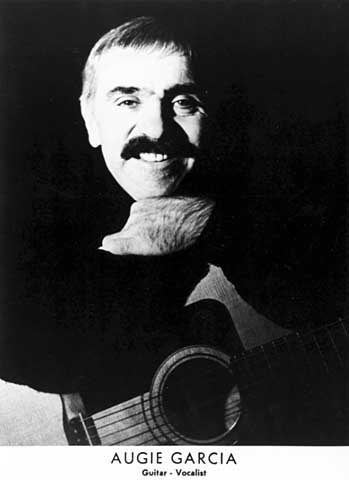
Photo courtesy Minnesota Historical Society
Save
Bruce Herbert Dybvig was a young Big Band musician and leader of some consequence in the 1940s and ’50s in the Twin Cities.
He was born on August 27, 1928, in Iowa. In 1940 he was living in St. James, Minnesota.
His musical story is told well by Leigh Kamman in a September 1950 issue of St. Paul Musician, the newsletter of the St. Paul Musician’s Union.
1946
SHUFFLETOWN BAND
It all began back in January 1946. Bruce, then a student at Minneapolis Central High School, organized the younger musicians of eight Minneapolis high schools. With fervor and a load of ideals they set books imitative of the Kenton, Rayburn, and Herman styles flourishing at that time. Most of the arrangements were scored by a young tenor man, Frank Lewis. Bruce, 17, and a high school senior, booked his 16-piece powerhouse on weekends at Shuffletown, a local community center.
The band was referred to in the local press as the Shuffletown band, after the place they performed every Friday night for two years. Dybvig had a day job driving a bakery truck. Shuffletown was apparently both a place and an organization, sponsored by the Loring Park Community Council, and made up of 600 members.
The photo below showed part of the then 16-member band holding a jam session. Pictured are Dybvig, Jack Cottrell, Jack Coan, Bob O’Connell, and Jack Wellnitz, with Paul Kaatrud at the piano and Tinkie Ross, chantuse, perched atop the piano.
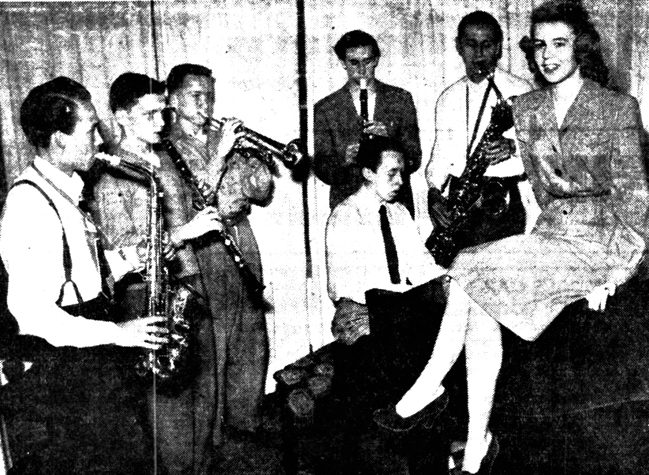
Minneapolis Tribune, Sunday, June 2, 1946
LOOK AMATEUR SWING BAND CONTEST
In April 1946, Look Magazine decided to run a national contest to find up and coming young musicians. Dybvig and his orchestra decided to enter.
Kamman:
Bruce, who is a rather long-ranged planner, for young men, was asked how he happened to enter the contest. “I didn’t happen to enter the contest,” he replied. “It seemed like a good thing. Everyone liked the band at Shuffletown back home. We were cocky kids, and we wanted to see how we stacked up against bands from other areas, so here we are.” Bruce, in short, never happens to do anything.
The Regional contest took place in Chicago on June 30, 1946, and involved 40 bands from 10 states. To get there, the 20 members of the band:
scraped up a flivver, “touched” their parents and rode or hitch-hiked to Chicago… They were given free lodging in a Chicago hotel – in rooms without bed linen because of some interruption of service. (Minneapolis Star, August 15, 1946)
ON TO NEW YORK
The Finals were to be held on August 24, 1946, at Carnegie Hall in New York City, but the problem was how to transport 20 teenagers and a chaperone with limited funds. Chicago was one thing, but New York was something else. The contest would pay for 17 musicians, but the kids of Shuffletown were going to have to come up with the rest by raising the cost of dances. But then polio began cutting attendance.
Dances were held to raise revenue; one on August 2, 1946, for the uniforms and arrangements, and a last ditch fundraiser for the musicians and extra chaperone on August 16. Fortunately, 250 of the 600 members of Shuffletown came out and the coffers were filled. The “Shuffletown Band” could ride the train in first class accommodations to New York.
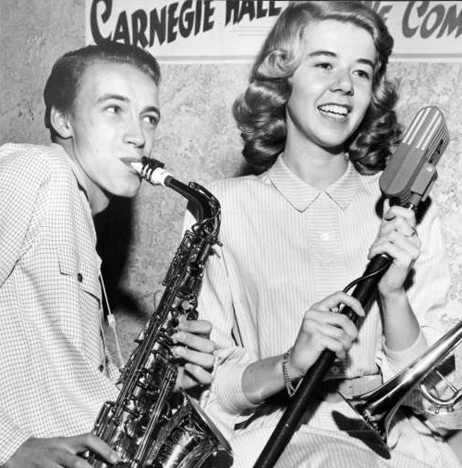
Dybvig and singer Tinkie Ross. Minneapolis Star, August 15, 1946. Photo Hennepin County Library
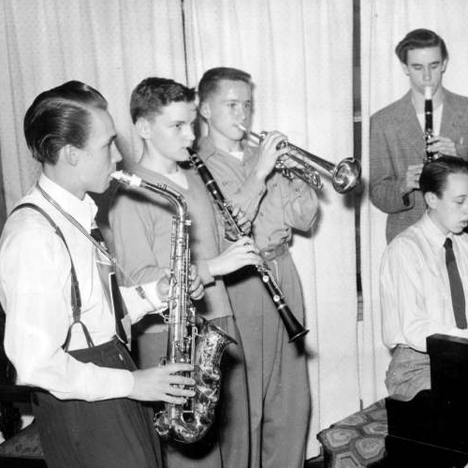
Photo courtesy Hennepin County Library
Kamman:
In New York, finally, his big 20-piece band came through. Against young music makers from Los Angeles, Kansas City, and New York, the Dybvig crew walked off with the big band award at Carnegie Hall. And instrumental in their winning was arranger Frank Lewis, who gave the band its style in the timely sound of big names of the day.
The band’s triumph was reported in the November 12, 1946, issue of Look:
This 16-piece band [actually 20] came out of the Midwest to win the national award. It is an All-Minneapolis outfit, recruited from eight local high schools. In June the band traveled by day coach and jalopy [without brakes] to Chicago where it won the regional finals. Then, sponsored by the Loring Park Community Council, the musicians traveled first class [by train] to the New York finals. … Look’s nationwide amateur swing band contest has given these award winners and scores of other outstanding young musicians a boost toward the opportunities in the field of music that they have long dreamed about.
The orchestra played:
- “Blue Lou”
- “I Cover the Waterfront”
- “Mandy”
Members of the band were:
- Leader: Bruce Dybvig (also best alto sax – an article said that Dybvig had only been playing sax for two years.)
- Arranger: Frank Lewis
- Trumpets: Jack Coan, Dick Zemlin (and special award), Jerry Strauss, Phil Liniwic, Don Specht
- Saxes: Bruce Dybvig, Frank Lewis, Robert O’Connell, Donald Narveson, Jack Wellnitz, Wayne Herold
- Vocal: Tinkie Ross
- Trombones: Stan Haugesag (also special award), Duane Solem, John Roth, Darrell Barnett
- String Bass: Paul Sanders
- Piano: Paul Kaatrud (also best piano)
- Drums: Jack Cottrell
- French Horn: John Kohler
The Afro-American newspaper also reported that on August 24, 1946, “the two Kings of the trumpet, Cootie Williams and Erskine Hawkins,” held a jam session at Carnegie Hall “that will never be forgotten in the annals of jazz.” The session was to “pay tribute to the amateur swingsters” unearthed by the contest. Every band leader who was in and around New York showed up for the event, and proceeds from the jam-packed event went to the Boys’ Club of New York. At the end of the evening, the wives of the esteemed trumpeters presented gold statuettes to be given to the outstanding trumpet players who had been “unearthed” by the contest. (August 31, 1946)
An interesting note is that an 18-year-old Sam Butera, a contestant from another band, won the award for Best All-America Instrumentalist. Butera went on to have a successful career playing tenor sax with his band the Witnesses.
HOME TO MINNEAPOLIS
The band arrived home as heroes, greeted by Mayor Hubert Humphrey and other Civic leaders.
Back to Kamman’s narrative, written in 1950:
Dybvig and men returned to the Twin Cities for two years’ worth of one-nighters at colleges, high schools, civic events, and sales promotions. The important fact was that the band was working, learning, and doing a little over-achieving, which in the light of experience, isn’t as negative as were the sneers and snide remarks of other local music makers. The band was playing some difficult and intricate modern scores the snide characters could and would not cut.
The photo below isn’t very good, but it shows the orchestra at its peak strength of 22 members.
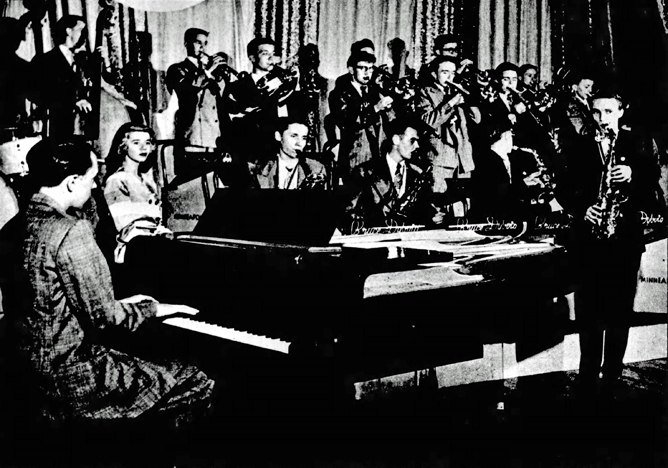
Minneapolis Tribune, September 8, 1946
In the photo below, Dybvig poses with the trophy and his new vocalist, Shirlie Larson, who replaced Tinkie Ross. The caption indicated that the band was made up of 22 members, and would make its first public appearance at a dance for the West Lake Veterans Association at the Minneapolis Armory on November 2, 1946.
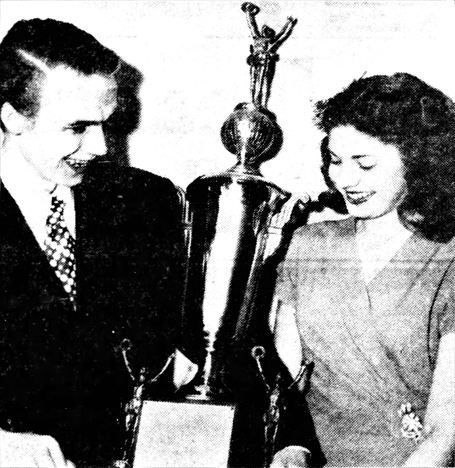
Minneapolis Star, Thursday, October 31, 1946
SNYDER’S DANCE JAMBOREE
Snyder’s Drug Stores sponsored a huge dance at the Minneapolis Auditorium on November 8, 1946, complete with an on-site medical team for all “broken bones and bruised shins.” Dybvig’s orchestra numbered 22 members. There was a jitterbug contest during intermission, with Miss Lillian Vail, Mr. David La Vay, and Miss Dorothy Lundstrom as judges. LaVay, at least, was a dance teacher. The Master of Ceremonies was Impersonator Joe Jung. The show was to be broadcast over WTCN between 11 and 12 pm.
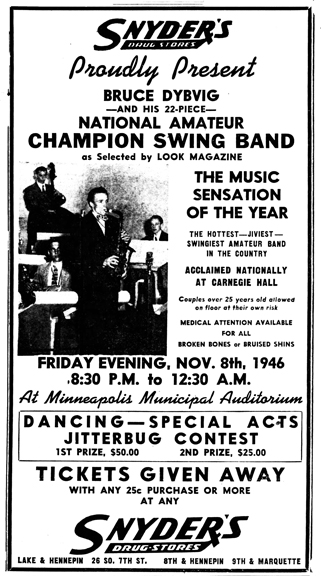
Minneapolis Star, Thursday, October 24, 1946
The ad below shows Dybvig’s orchestra accompanying a Dayton’s fashion show at the Lyceum Theater on Saturday, December 28, 1946.
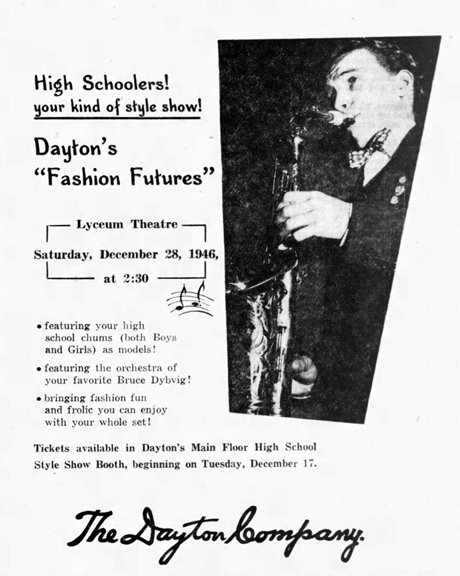
Minneapolis Star, Monday, December 16, 1946
Dybvig’s 22-piece orchestra was back at the Minneapolis Armory for a New Year’s Eve dance for the West Lake Veterans Association on December 31, 1946.
1947
On February 15, 1947, the band performed for the Congressional Ball at Carleton College in Northfield, Minnesota.
In the Spring of 1947, the band provided the music for the Junior Class Prom at the University of Minnesota.
On July 25, 1947, Dybvig’s band was hired to play for the Aqua-Teen-Twirl, a dance for teens at the Minneapolis Auditorium with two other bands directed by Jerry Dibble and Bud Strawn.
In the days when the Labor Temple was a hotbed of Big Band, Jazz, and Rhythm & Blues music, Dybvig was there at least once, sharing the bill with none other than the Prince Rogers Combo, father of Prince.
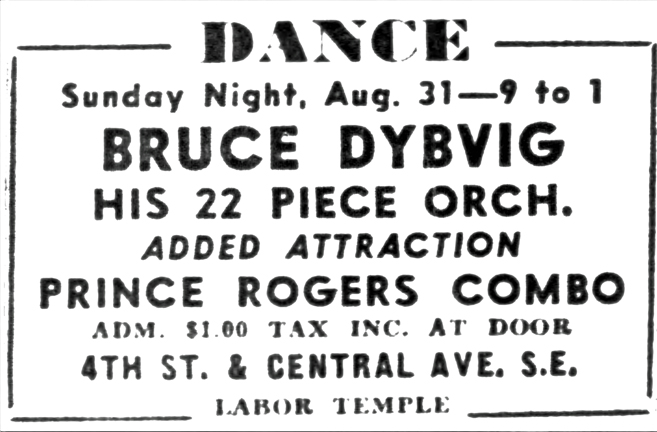
Minneapolis Star, Saturday, August 30, 1947
Kamman:
Another milestone in the cycle of seasoning was a “We Call It Jazz” concert. A local disc jockey and a brother-in-law of Eddy Condon, co-sponsors of the affair, invited Bruce to play a concert for modern big bands in December of 1947. Bruce brought 5 brass, 4 trombones, 1 French horn, 6 reeds, and 4 rhythm to that December 14, 1947, session. 20 men honked and blasted in dissonant registers to the one thousand people crowded in the Radisson Hotel ballroom. Dybvig and men almost out-Rayburned Rayburn that night. The audience was impressed, impressed with initiative and youth and there was the feeling that with those qualities the refreshing, the new, and the thrilling, were also there.
1948
Two engagements at the Marigold Ballroom were found, but with 22 musicians, the fee probably couldn’t pay everyone enough to be worth it.
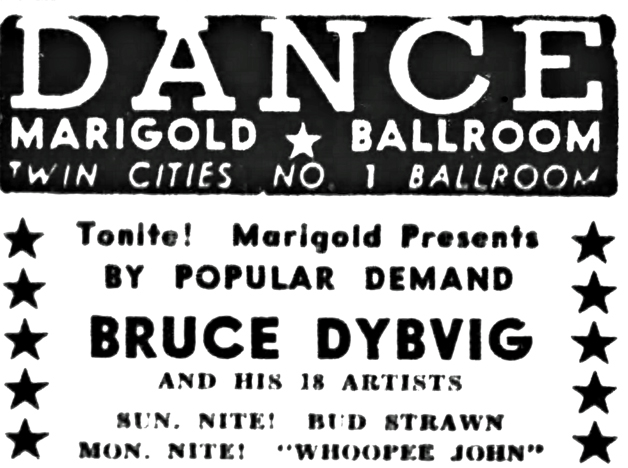
Minneapolis Tribune, Saturday, January 31, 1948
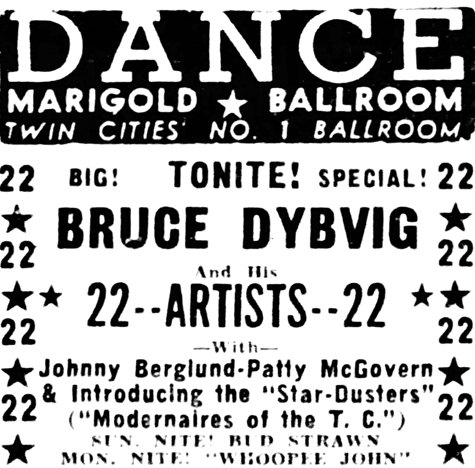
Minneapolis Star, Saturday, February 7, 1948
Kamman:
Still another cycle in the development of the Look All Americans was a meeting with Johnny Bothwell. The meeting resulted in a partnership between Dybvig and Bothwell. An Eastern tour followed which ended abruptly about two months later in August of 1948. The same thing happened to this Bothwell venture that has happened to every other Bothwell venture – that ultimately has resulted in Bothwell’s “unwilling retirement.” But in spite of the breakup, which almost cost Bruce his health, there were positive effects. It made men of his 20-year-olds. Experience, big name musical direction under Bothwell’s influence, playing constantly the combined Dybvig-Bothwell book, and living on the road knocked out that starry-eyed look.
Then 19, Dybvig returned home and retired to seclusion for 30 days to eat, sleep, and think things over. At the end of the retreat, rested and bolstered by an evaluation of the Bothwell experience, he began a long haul up and out of debt. He reorganized the band with practically the same personnel and began putting out a brand of music that startled local dance fans. Many a couple did a double take to see if Dybvig or Bothwell were making with the music.
1949
Is the ad below for an appearance at Schlief’s Little City on June 8, 1949, implying that Dybvig’s band is from New York?
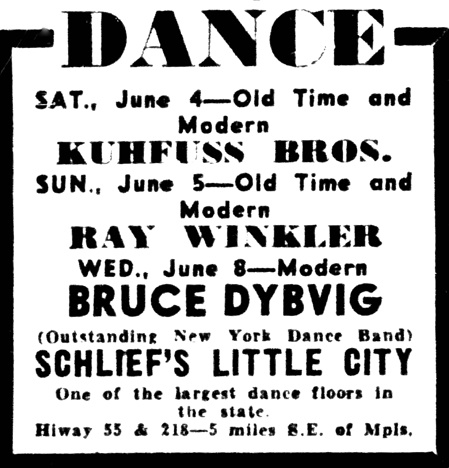
Minneapolis Star, Saturday, June 4, 1949
Kamman:
In the summer season of 1949 the band jumped northward to Winnipeg Beach, Manitoba. Result was a season of American jazz and dance music for some very happy Canadians.
Following his return to the Twin Cities in the fall of 1949, the band began another season of filling dance calendars with his 16 and 20-piece operation. The business of budgets and sizes of bands began to raise its ugly heads, and Bruce began to change his thinking about the business once again. Faced with a book for 16, 20, and 22 men, Bruce with aid of local arrangers Pops Wakefield, Derk Fisher, and Jack Nowicki built a 7-piece unit geared to fit into his big band.
Trumpet, brass trumpet, alto, baritone, piano, bass, and drums have been blended into one of the most flexible groups heard in these parts. The sound is big with rich effects carried by the baritone.
Bass trumpet, alto voiced with the baritone, give still greater depth. The unit is versatile. The job best demonstrates a new versatility. For sake of trend it’s Dixie, Yank Lawson style on one side, waltzes with a full non-tenor melody next, and ballads with rich, soft backgrounds and occasional sleepy alto reminiscent of the Bothwell era. Bruce has his earnest young moderns playing commercial, and the experiment seems to please the dancers and fans alike, because the band has a style all its own.
All these current and timely sounds emanate from Bar Harbor where Bruce Dybvig is building a new reputation and cycle of experience. It’s a new step in the right direction for a persevering and mature young man of music, for now at 21, with five years of band leading under his saxophone, he combines musical skill with big name experience, and a wise insight into the financial affairs of the business plus a basic music business philosophy. From here Dybvig looks like one of the names of tomorrow, and name someone will latch onto.
1950
On March 6, 1950, the Dybvig band performed at the Music Bar at 408 Cedar Ave.
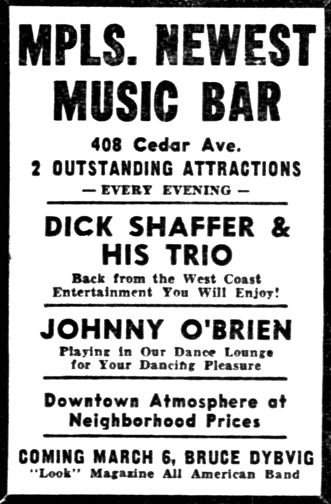
Minneapolis Tribune, Saturday, February 25, 1950
Dybvig had an 8-piece band working at the Bar Harbor resort near Brainerd during the summer of 1950. The ad below for May 6, 1950, boasts that Dybvig has performed at the Symphony Ballrooms in Chicago and Boston. He would work at the Bar Harbor or Breezy Point resorts until about 1963.
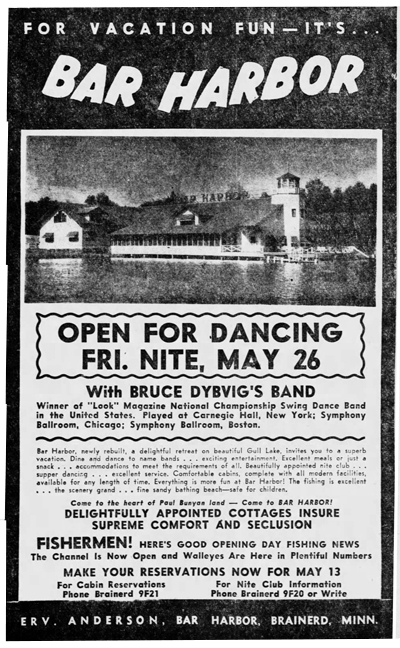
Minneapolis Tribune, Sunday, May 7, 1950
After Bar Harbor came a stint at Snyder’s Cafe, in September 1950.
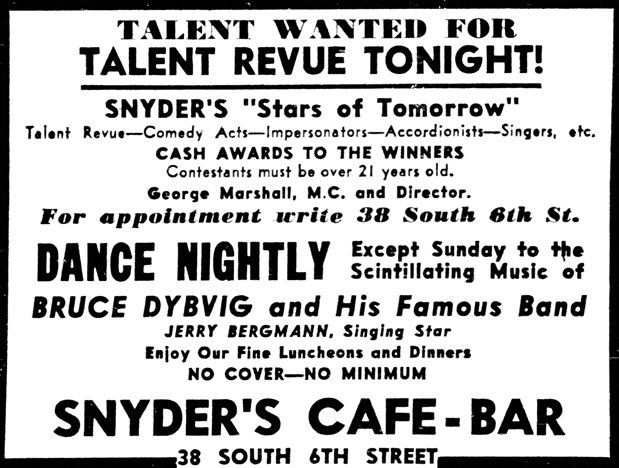
Minneapolis Star, Tuesday, September 19, 1950
Thanksgiving time 1950 saw Dybvig at the Prom Ballroom.
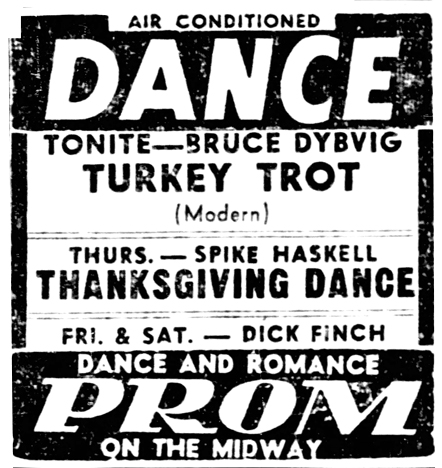
Minneapolis Tribune, Wednesday, November 22, 1950
1951
Dybvig’s band was still popular, as evidenced by the fact that the Edina-Morningside High School Class of 1951 specifically requested that they play for their graduation dance.
1952
In January 1952 the Minneapolis Flame began to program jazz on Sunday nights, a show called “Jazz Carousel” produced by Dybvig. Both Dixieland (Harry Blons) and modern (Percy Hughes) jazz was presented. Dybvig’s show was described as “His Ultra Modern Music” in 1952. In 1952 he also performed at the Point.
In a conversation with columnist George Grimm, Dybvig explained that teenagers no longer wanted the “firehouse style of fast, loud, jump music.” Now they want six slow numbers to one fast one. Or they want the “Business men’s Bounce: a hotel style two-beat where you dance on every second beat.” (Minneapolis Tribune, January 3, 1952)
In the spring of 1952, Dybvig’s band provided the music for Blake School’s end of school dance for the senior class at the Woodhill Country Club.
1953
In 1953, Dybvig introduced his 8-member Royalaires at the House of Hastings and the Point in Golden Valley.
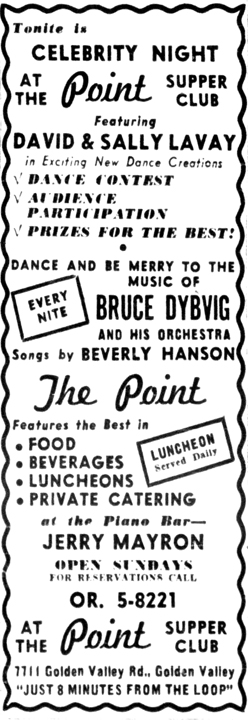
Minneapolis Star, Friday, February 27, 1953
Starting December 14, 1953, Augie’s Theatre Lounge featured Bruce Dybvig and his trio. Members included Elaine Bravis on bass, and Rufus Webster on piano. Sally Saylin, who had sung and played piano in the lounge at Augie’s since 1946, was held over in the piano bar. (Minneapolis Tribune, December 13, 1953)
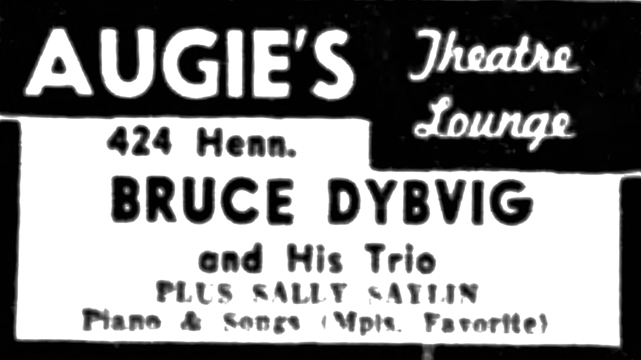
Minneapolis Tribune, Wednesday, December 23, 1953
1954
On July 20, 1954, Dybvig’s Royalaires played the Aqua Canopy show on top of the L.S. Donaldson Co. Canopy between Sixth and Seventh Streets on Nicollet Ave.
In 1954, Will Jones called the Royalaires, performing at the Point in Golden Valley, the “brightest bunch of show-offs around these nights:”
Sometimes It’s a vocal group with five voices and rhythm accompaniment. Sometimes it’s an instrumental group. With a bongo drummer added, it’s a Latin band. And they’re mostly all capable soloists.
Sample versatility: Frank Lewis, the arranger, also sings, also plays bass, and also plays tenor sax. (Minneapolis Tribune, August 25, 1954)
In November 1954, Dybvig was sentenced to 30 days in the workhouse for driving after his license was suspended. (Minneapolis Tribune, November 4, 1954)
1955
On April 16, 1955, Dybvig’s 10-piece band was chosen to play at a sock hop when the City of Richfield celebrated its receipt of its All-America city award. The dance was held in the new Richfield high school’s gymnasium. Six or seven original members of the 1946 band were expected to be hand. A highlight of the dance was the judging of the Richfield entry in the 1955 Miss Minnesota contest. (Minneapolis Star, March 3, 1955)
In October 1955, Dybvig was expelled from membership in the Minneapolis Musicians’ Union Local 73. The union said that the expulsion had to do with failure to pay union members hired for work in orchestras. On July 18, 1958, Dybvig filed suit against the union, charging that he was “maliciously blackballed without just cause,” and demanded $30,000 for “great embarrassment, humiliation and emotional anguish and physical ills;” $200,000 in punitive damages; and return of $400 which he said he had been require to post with the union to pay any claims that the union had against him. (Minneapolis Star, July 18, 1958)
1956
On August 12, 1956, Will Jones of the Minneapolis Tribune wrote a long story with the unfortunate titles, “Death of a Band: Triumph to Defeat in 10 Years” and “‘Band of Tomorrow’ is Forgotten Today.” The article spoke of a final 10 year reunion of the original band members and gave updates of each. Even that event resulted in a loss of $1500. Some highlights of that article:
- In the last ten years Dybvig figured he had worked 1,200 engagements and grossed $125,000, ending up with an average hourly wage of $1.25.
- He had trouble getting work in Minneapolis, so he had to dream up a job for himself, publishing a directory of talent and entertainment services for the area. An article from 1958 show that he was listed as president of Talent Directory, Inc.
- He should have known that Big Bands died in 1946 and it was pointless to try to keep his going.
- Dybvig said that the representative from Look lost interest and failed to deliver on promises of hotel and movie contracts.
- Bruce always wore his hair long, despite taunts similar to rock ‘n’ roll musicians a decade later. He finally got a crew cut when he took up water skiing and his hair got in his eyes.
1956 was another bad year for Dybvig; his wife Inez divorced him for “Cruel and inhuman treatment” (in those days you had to have a reason). They had married in 1947 and had two children. Bruce blamed the breakup on the long and unusual hours of a musician. (Minneapolis Tribune, June 9, 1956)
1958
In 1958, Dybvig sued the Minneapolis musicians’ union for expelling him in 1955. See 1955 above.
1960
Dybvig’s was the house band for the summer of 1960 at the Bar Harbor Resort in Northern Minnesota.
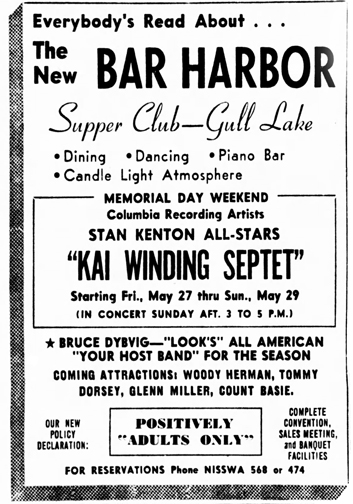
Minneapolis Tribune, Friday, May 27, 1960
1964
By 1964 only two of the original 20 members were working professional musicians.
1965
In 1965, Dybvig “allowed himself to be arrested rather than pay 55 cents to an argumentative taxi driver who didn’t want to wait outside a downtown restaurant while Dybvig got a takeout order of Spaghetti.” (Minneapolis Star, June 19, 1975)
1970
In 1970 he was arrested for writing a bad check, and spent 106 days in the Hennepin County jail after refusing to post a $100 bond while awaiting trail. He was released on his own recognizance in March 1970. “He was convicted of forgery and placed on probation for two years. He had not ingratiated himself with courthouse employees. A condition of his probation was that he not ‘loiter’ in the building.” (Minneapolis Star, June 19, 1975)
1971
In 1971 Dybvig said that prisoners in the jail were frequently mistreated, a charge that Sheriff Don Omodt said were “totally unfounded.” Nevertheless the board of directors of the Urban Coalition of Minneapolis voted to investigate conditions. (Minneapolis Tribune, August 6, 1971)
1975
Dybvig shows up in the news again in June 1975 as a frequent observer in Hennepin County District Court, as described in an article about court watchers by John Carman in the Minneapolis Star on June 19.
Cream performed at the New City Opera House on May 5, 1968.
MAGOO’S
Magoo’s was next to the NCOH, and was open to kids under 21. The Castaways were booked to play at Magoo’s, “celebrating” Cream.
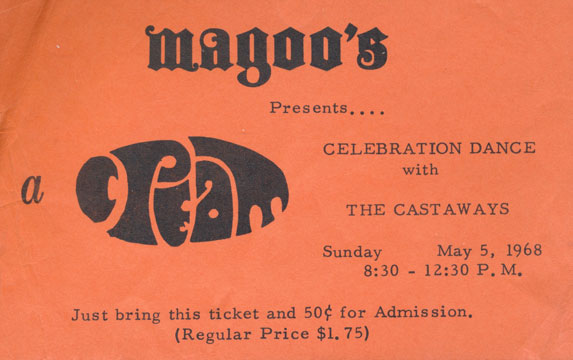
Lonnie Knight:
I got to see part of that show. Jokers Wild was playing at Magoo’s… We went over to New City every break.
Tom Husting:
Well, I will attempt to add my recollection of that day. I was the guitarist in the Castaways at that time. It was certainly an honor to be on that bill that day. The Castaways played a set, maybe two, at Magoos that evening. To whittle a finer point from a previous comment, Magoos served 3.2 beer, so the 21 age requirement would have pertained to Magoos, not necessarily NCOH. We finished our set and headed next door to catch Cream’s set. The two clubs were connected through a hallway.
I think accounts by various Litter folks are pretty accurate. Cream was way late, Litter played quite a while, and there was a lot of nothing prior to Cream coming on. There were vocals from Clapton and Bruce, for sure, but there was also P.A. trouble. I remember Sunshine, Spoonful, and Ginger Baker’s solo tune. There may have been one or two others, but it was largely a jam set which reflected their new album which just came out, Wheels of Fire.
As far as Cream playing Magoos after – I seriously doubt it. David Anthony (booking) as I recall, may have gotten Lonnie, Pete and Denny (Jokers Wild) to play a set at Magoos, as they were all present, and Cream was late. The observer may have seen the Jokers and thought they were seeing Cream, I don’t know, But I think the Jokers were asked to play in order to have some music happening either before or after the Cream set.
All in all, one of the coolest near disaster gigs in Minnesota history. Will live in infamy.
THE LITTER
The opening act for Cream was the local band the Litter.
The actual ticket to the Cream show, also sent by Steve, shows both the Litter and the Castaways on the Opera House bill:
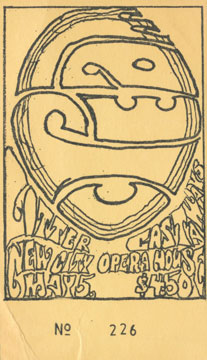
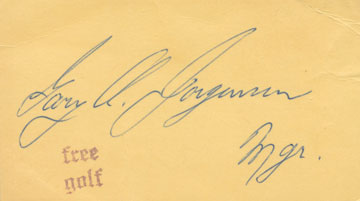
And the poster (with an erroneous “The” before Cream) lists both Magoo’s and the New City Opera House:
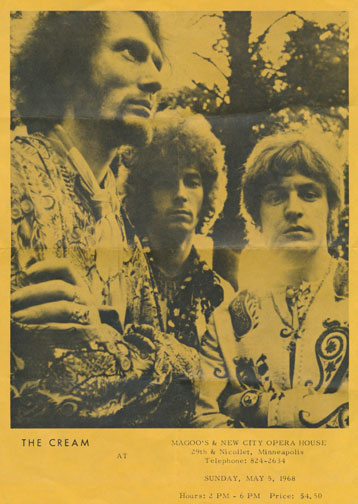
Poster courtesy Steven Richardson
Members of the Litter remember:
Denny Waite, lead singer:
The Litter opened for the one and only Cream concert in Minnesota. It was in the Spring of 1968, a Sunday afternoon gig at ‘The New City Opera House.” For those of you who don’t know, that place was an old 1920s dance hall on Nicollet Ave, just off Lake Street. K-Mart sits there now. (Zippy Caplan, our lead guitar player, won the contest to re-name the old Mr. Lucky’s with the new grandiose title.)
On the day of the concert, we set up our gear in front of Cream’s towering Marshall amps, and of course Ginger Baker’s hallowed drum kit. The place was packed with Cream’s loyal Hippie fans. The fire marshal would have shit if he saw how packed! We were supposed to play a half hour. Cream showed up an hour late, which gave us (the Litter, in stage hog heaven) an hour and a half to warm up the crowd. Cream finally arrived to a huge welcome of clapping and cheers.
When they started the first song, “Sunshine of Your Love,” Clapton went a fret too high for a couple measures, then a fret too low before settling into the right key. He was just messing with us. Halfway through the first verse their P.A. made a loud buzzing noise and quit working. Ours was about as good as theirs but they didn’t use it. They kept playing “Sunshine” as an instrumental for about 15 minutes, then two more 15 minute instrumentals, including the one with Baker’s drum solo. They played incredibly well of course. They couldn’t help that, but there were no vocals.
When 45 minutes were up they walked out the back door, no encore. They had said not a word to the totally packed house of adoring fans. As they left, the dangerous Mr. Baker took a big swig of beer and spit it on the fans near the edge of the stage. We were astonished, and didn’t react, too Minnesota nice and repressed? Applause was short, as we looked at each other and asked, “What the hell was that all about?”
Later, back at the Litter House by Lake of the Isles, their road manager told us the back story to their rude behavior. Being from Europe, where every decent city has an opera house, they looked forward to playing in a great concert hall with wonderful acoustics. When they arrived at the creaking, old dance hall with the fancy name for a sound check, they were royally pissed off. They told their manager they wouldn’t do the gig. He said they would get sued and end up paying New City Opera House. He told them they had to play a minimum of 45 minutes. They said, “Okay, but we’re not gonna fuckin’ sing.” (quoting their manager) It was part of the plan to make their own P.A. system go down at the beginning of the first song.
I must admit that they sounded fantastic, even on auto pilot, and probably half asleep! Reminds me of the old saying, ” Sometimes it’s better not meet your heroes in person.” Oh well, rock gods are only human, after all.
Tom Murray:
After playing drums in the Litter that show, I was still playing with one kick-drum. After watching Ginger playing two kicks, the next day went to B-Sharp and bought another kick !!! Been playing double kick whole career since that show !! Now I use double kick pedal on shows. Cream was a great band . I had a short talk with Ginger in the late ’90s here in Colorado just before he moved to South Africa . He is a true Legend !!!!!!
THE SHOW
The show was reviewed by Connie Hechter in the Insider, who admitted that he wasn’t actually there. But from what he was told, the night was fraught with problems:
- The band was late
- They insisted on setting up their own amplifiers instead of using that of the Castaways, already on stage
- Their microphones didn’t work
- The show was less than an hour long
Connie reported that NCOH manager Gary Jorgenson perceived an attitude that the musicians were doing the audience a big favor.
But reviews of the music were positive. “They played like schooled jazz musicians,” said one fan. Connie’s take was that “the experience to hear really supberb instrumentalists in the pop vein was worth the agony; the ecstasy was delicious.”
Someone said that Cream played so loud that a structural beam in the floor had cracked and split.
Other comments:
Tom Pinkert:
The city had been flooded with counterfeit tickets and we had gotten ours. Security at the door was lax and aside from a surly look from the ticket taker everybody got in — and I mean everybody, that place was jammed. I remember it so well because we found a place to sit directly in front of these gigantic speakers, and once we got there moving away from them was impossible. There were some warmup bands, there was a lot of waiting, and to say Cream played for an hour would be generous (I’d say more like a half hour). It was very obvious Cream was not happy.
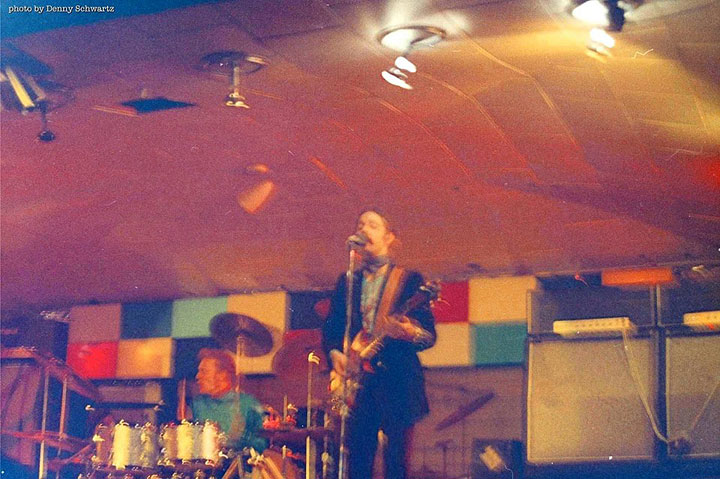
Photo by Denny Schwartz
Gary Schwartz:
I remember the Litter playing and then waiting forever for Cream to arrive. I think it was over an hour. I also remember the crew nailing Ginger Baker’s bass drums to the floor with about 6″ spikes.
John Ebert:
I was on Nicollet Avenue near Lake Street and went into a club just by chance (it must have been Magoo’s) and when I got to the band room, the Cream threesome were in there playing to an empty room. From time to time, a person might come in and would leave, but for the most part I recall myself being the only person present for their jam. Ginger Baker was kicking a double bass drum-kit. The room had a very low ceiling, black walls, and a few unnoteworthy colored lights for illumination. I can only attribute the lack of people as the band must have wanted to practice and play in relative secret. Of course, the other people present were Jack Bruce and Eric Clapton.
According to the Insider, Stillroven was preliminarily to be on the bill as well.
From Wikipedia:
Dan Israel is a 15-year veteran singer-songwriter currently based in Minneapolis who won Song of the Year (for “Come to Me”) in the 2005 Minnesota Music Awards. He led the folk-duo One Town Horse in Chicago in the late ’80s and early ’90s, went on to lead the more electrified folk-rockers Potter’s Field in Austin, TX in the mid ’90s (where he was named one of Austin’s top 15 songwriters), and finally relocated to his hometown of Minneapolis in 1996, where he formed Dan Israel and the Cultivators and released a slew of critically acclaimed CDs, both solo and with the Cultivators. His 2000 solo release Dan Who? received a 4-star review from noted music scribe Jim Walsh (then at the St. Paul Pioneer Press), who summed up his outrage at the under-recognition of Israel’s talent with these words: “Well, somebody buy a billboard, hire a blimp, and give this guy his due already. His name is Dan Israel, one of the mad ones, one of the strugglers, and he just made the record of his life.”
Israel has been reviewed favorably in national magazines like Paste and No Depression and in major American newspapers such as the Chicago Sun-Times, has received extensive radio airplay both stateside and overseas, has showcased multiple times at the prestigious South by Southwest Music Conference, and has opened for acts such as Morrissey, the Tragically Hip, Todd Snider, Iris Dement, Peter Himmelman, the Honeydogs, Mason Jennings, Martin Zellar, Mary Lou Lord, Ike Reilly, Steve Poltz, the Silos, and many more.
His influences include such popular choices as Bob Dylan, Neil Young, the Beatles and The Rolling Stones as well as ones more unique to his particular jangly folk-pop style – Westerberg, the Jayhawks, Petty, the Byrds, Big Star, World Party, Husker Du/Sugar/Mould, R.E.M., and others.
See Dan’s website at http://www.danisraelmusic.com/
Growing up in St. Louis Park, Dan Israel lived at 2822 Salem Ave. So.
David Carroll, nee Carroll Bateman, had a 30+ year career in the Twin Cities as the premiere Elvis impersonator. Please see the bottom of Elvis’s page for information about his life.
DAVID Z DISCOGRAPHY
The following is a list of projects that David Z has been involved in. The code for the last column is as follows:
E: Engineer
P: Producer
M: Mixer
W: Writer
|
Artist |
Production |
Lable |
Role |
| Government Mule | The Deep End | ATOR | P/E/M |
| Elvis Costello | Almost Blue | Columbia | Writer |
| Jonny Lang | Lie to Me | A&M | P/E/M/W |
| Jonny Lang | Wander This World | A&M | P/E/M/W |
| Prince | Purple Rain | Warner Bros. | E/M |
| Prince | Around the World in a Day |
Warner Bros. | E/M |
| Prince | Parade | Warner Bros. | E/M |
| Prince | Graffiti Bridge | Warner Bros | E/M |
| Prince | “Kiss” | Warner Bros. | E/M, Arranger |
| Prince | For You | Warner Bros. | E/M |
| Prince | Delirous | Warner Bros. | E |
| Fine Young Cannibals |
The Raw and the Cooked – Grammy nominee Record of the Year |
London/MCA | P/E/M |
| Etta James | Let’s Roll – Grammy Award Winner |
BMG Records | M |
| Etta James | Blues to the Bone – Grammy Award Winner |
BMG Records | M |
| John Mayall | Stories | Eagle Records | P/E/M |
| John Mayall | Along for the Ride | Eagle Records | P/E/M |
| J ohn Mayall with Eric Clapton |
70th Birthday Concert | Eagle Records | P/E/M |
| Kenny Wayne Shepherd |
Ledbetter Heights | Giant | P/E/M |
| Collective Soul | Collective Soul | Atlantic | E/M |
| Billy Idol | “Cradle of Love” | Chrysalis | M/additional P |
| Big Head Todd and the Monsters |
Sister Sweetly | Giant | P/E/M |
| Janet Jackson | “He Doesn’t Know that I’m Alive” track from “Control” LP |
A&M | E |
| Steve Cropper and Felix Cavaleri |
C&C | M | |
| Tab Benoit | Fever for the Bayou | Telarc | P/E/M |
| Tab Benoit | Power of the Ponchartrain |
Telarc/Concord | P/E/M |
| Frank Black (The Pixies) |
Marathon | Virgin/Back Porch | M |
| Bernard Allison | Storms of Life | Tone Cool Records | P/E/M |
| Roland Gift (formerly of Fine Young Cannibals) |
It’s Only Money | MCA | P/E/M |
| Neneh Cherry | Red Hot and Blue | P/E/M | |
| Buddy Guy | Heavy Love | Silvertone | P/E/M |
| Bodeans | Black and White | Warner Bros. | P/E/M |
| Storyville | A Piece of your Soul | Atlantic | P/E/M |
| Mark Collie, Tim McGraw, Kelly Willis, Gatemouth Brown |
Live at Brushy Mt. State Prison |
MCA | P/E/M; Co-Produced with Tony Brown |
| Gram Parsons | GP | Warner Bros. | Writer |
| Gary and Dale Rossington (of Lynrd Skynyrd) |
“Rossingtons” | Sanctuary | P/E/M |
| Freddy Jones Band | Lucid | Capricorn | P/E/M |
| Jody Watley | Looking for a New Love | MCA | P/E/M |
| A-Ha | Memorial Beach | Warner Bros. | P/E/M |
| Sisters of Mercy | Temple of Love | East West | P/E/M |
| The Time | The Time | Warner Bros. | E/M |
| Sheila E | Hold Me | Warner Bros. | P/E/M |
| Lipps, Inc. | Funkytown | Casablanca | E/M |
| Surface | Happy | Columbia | P/E/M |
| Jesse Johnson | Jesse Johnson Review | A&M | E/M |
| The Jets | “Crush on You”/”You’ve Got it All” |
MCA | P/E/M |
| The Family | The Family | Paisley Park | P/E/M |
| Leo Kottke | Standing in my Shoes | Private Music | P/E/M |
| Leo Kottke | Clone (with mike Gordon from Phish 2004) |
Private Music | E/M |
| Angelique Kidjo | AYE | Island | P/E/M |
| Maldita Vecindad | Maldita Vecindad | BMG Mexico | P/E/M |
| Benjy Davis Project |
P/E/M | ||
| Voice of the Wetlands Allstars: Dr. John, Allan Tousaint, Cyril Neville |
TBR | P/E/M | |
| Al Green | Music from the Motion Picture “Michael” |
Giant | P/E/M |
| Tevin Campbell | Music from the Motion Picture “The Goofy Movie” |
Disney | P/E/M |
| Jonny Lang | Music from the Motion Picture “The Love of the Game” |
P/E/M | |
| Prince | Music from the Motion Picture “Girl 6” by Spike Lee |
P/E/M | |
| Buddy Guy | Music from the Motion Picture “I’ll be Home for Christmas” |
P/E/M | |
| Jermaine Jackson | 1988 Summer Olympics LP | Arista | P/E/M |
| Chris Duarte | Tailspin Headwhack | Silvertone | P/E/M |
| Aswad | The Best of Aswad | Mango | P/E/M |
| Syl Johnson | Bridge to a Legacy | Texas Music | M |
| The Go-Gos | Go-Gos Greatest Hits | I.R.S. | P/E/M |
This page lists the sources used for the Depot/Uncle Sam’s/Sam’s venue page. In most cases, the source of the information is given within the document. In other instances, sources are identified by abbreviations. I’m putting this rather cumbersome list of sources here so it doesn’t muck up the main page, and to allow you to toggle between the two pages as needed.
If there are any sources of information you think I have missed, please feel free to contact me.
PHOTO CREDITS
As always, photo credits are provided for each image shared with me to post. I want to especially thank some people for their special help.
Huge thanks to Mike Barich for allowing me to post some of the hundreds of photos that he took of Depot shows as staff photographer for Connie’s Insider. Mike’s negatives had been stored in his basement for decades before David Roth of tpt volunteered to scan them for Mike. Thank you, David!! These photos are priceless in telling the story of what it was like during the glory days of the Depot.
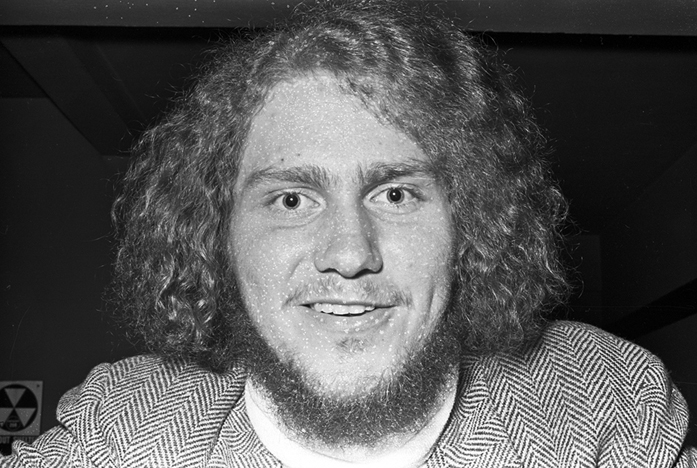
Self Portrait – Copyright Mike Barich
Darrell Brand shared his Joe Cocker photos early on, and when I saw some of his photos of the Gathering in the Depot event, he sent me those too. Darrell has had quite a career in photography and I thank him for sharing the fruits of his early labors with us.
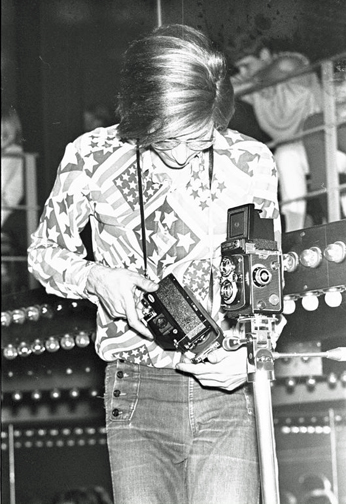
Darrell Brand at the Gathering. Photo copyright Mike Barich
P.S. I sent this picture to Darrell on his birthday, which was just days after Mike identified him, and Darrell not only said that he was wearing his favorite shirt, but demonstrated that, 50 years later, he still had it and it still fit!
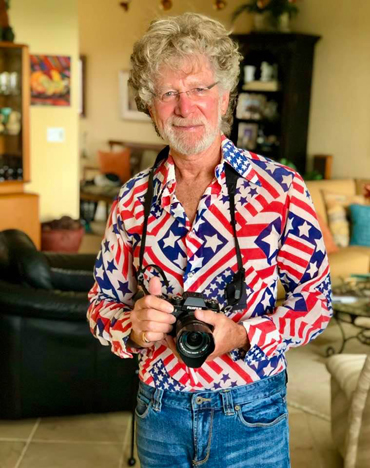
Courtesy Darrell Brand, 2020
Thanks as well to Mark Freiseis for sharing his collection of posters from Depot shows that he obtained by removing them from bulletin boards, etc. after the concerts and stashing them under his bed! They are now beautifully framed; many of the images you see here were photographed through the glass, so you can see Mike for yourself!
Steven Laboe took thousands of photos during the Uncle Sam’s era, and has been generously sharing them on his Facebook page and with me. Unfortunately, many more slides of the live acts during that time were lost through miscommunication, and I commiserate with Steve with that terrible loss. But many more photos remain, and you will see several on this site.
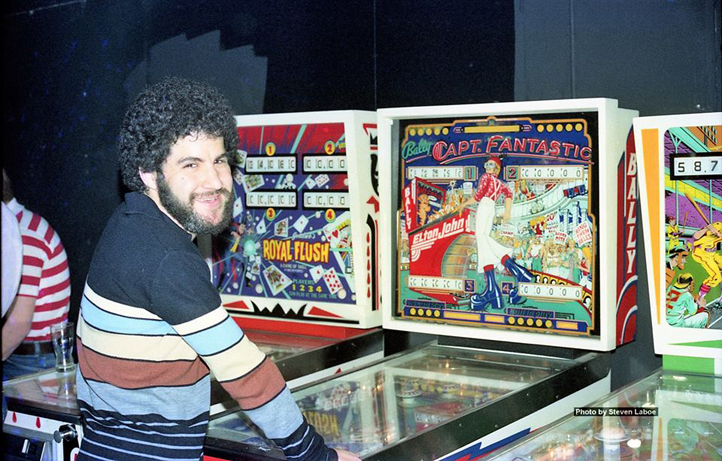
Steven Laboe in 1977. Photo courtesy Steven Laboe
I found several excellent photos in Chris Riemenscheider’s book on First Avenue, and after obtaining permission from the various people who had provided them, they were sent to me for posting by Josh Leventhal of the Minnesota Historical Society Press, the publisher of the book. He did this while working at home, a tremendous feat, and I thank him for doing it so quickly.
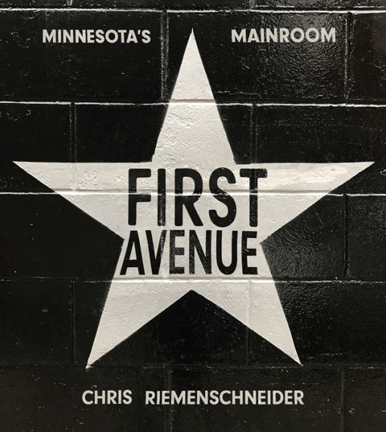
Chris Riemenschneider’s book, courtesy Barnes and Noble
WRITTEN RESOURCES
Sources fall into four categories:
1. PRIMARY SOURCES
First and foremost I have used primary documents to the greatest extent possible. I have been able to get incredibly helpful documents from the City of Minneapolis, the State of Minnesota, the Hennepin County Courts, and the U.S. Bankruptcy Court. These materials are a matter of public record and can be accessed by anyone.
MLD: City of Minneapolis Licenses and Consumer Services Division
On November 7, 2019, I made a request to the Minneapolis City Clerk for all information on file related to the liquor license at 29 N. 7th Street aka 701 N. First Avenue, from 1970 to 1983. On January 17, 2020, I received 113 pages of documents. Most of these documents were copies of the annual applications made by The Committee, Inc. for renewal of their Class A on-sale liquor license and related materials.
On January 30, 2020, I made a subsequent request for materials related to the Committee, Inc. On February 10, 2020, I received 26 additional pages of materials. Most of these were signed contracts and agreements.
I have also received two detailed emails in response to my questions from Enrique Velasquez, Manager, Licenses & Consumer Services Division, Department of Community Planning & Economic Development.
The City of Minneapolis has gone above and beyond to find requested documents and answer my questions.
SS: Secretary of State
Documents were requested regarding filings for the organizations listed below. These were accessed online. Go to the Business and Liens section.
- 2M, Inc.
- The Committee, Inc.
- Minneapolis Entertainment, Inc. (The Minnesota Scene, Inc.)
- F-Troop LLC
- 701 Ventures, Inc.
- First Avenue Productions LLC
- First Avenue Productions, Inc. (not affiliated with First Avenue)
Bankruptcy Documents Accessed Through PACER.GOV
BP: Voluntary Petition for Chapter 7 Bankruptcy, Case No. 04-46176, U.S. Bankruptcy Court, District of Minnesota, November 2, 2004
BPA: Bankruptcy Purchase Agreement between Committee Estate Trustee John R. Stoebner and F-Troop LLC, November 5, 2004
Trustee’s Final Report and Proposed Distribution, In Re: The Committee First Avenue, Case No. 04-46176, U.S. Bankruptcy Court, District of Minnesota, July 9, 2007
The Committee, Inc., John R. Stoebner, Trustee vs Allan Fingerhut and Rose Fingerhut. Case No. 04-46176, U.S. Bankruptcy Court, District of Minnesota, March 3, 2005
2. NEWSPAPERS
I have used the newspapers.com database heavily to access relevant articles. Newspapers don’t always get it right, but for the most part these articles include “soft” reports with descriptions, interviews, and observations. They are also extremely useful in dating events. These sources are all listed within the document itself, as applicable, with newspaper name and date.
Newspapers.com is available on a subscription basis for about $30/six months.
Other publications like City Pages and the Twin City Reader are on microfilm at the Minnesota Historical Society. I haven’t gone through them as thoroughly as I would like.
Tom Campbell and Denny Johnson miraculously came in possession of almost a complete set of Connie’s Insiders, and allowed me to copy them. These are priceless sources of information about the music scene in the Twin Cities from 1967 to 1978. Connie didn’t have much to say about Uncle Sam’s, but covered the Depot extensively. Thanks so much to Tom (minniepaulmusic.com) for sharing these with me.
Other copies of Connie’s Insiders were shared with me by Dennis Libby, including the elusive first and second issues!
3. SECONDARY SOURCES
I have used blogs, magazine articles, books, and similar materials sparingly. (I probably haven’t found them all.) These secondary sources have many errors and contradictions. They are identified with codes shown below and information from them is sometimes in brackets if I wasn’t able to substantiate the information. These secondary sources will be clearly identified, and the amount of salt taken is up to you.
CR: First Avenue: Minnesota’s Mainroom by Chris Riemenschneider: Minnesota Historical Society Press, 2017
CRM: “Prince of Clubs,” by George Dixon, Corporate Report Minnesota, August 1985
Current 2014: “Steve McClellan talks about the early days of First Avenue and DEMO’s bright future:” The Current, Andrea Swensson, November 20, 2014
Hi Jinx and Hearsay, by Martin Keller: Minnesota Historical Society Press, 2019
Inc.com: “Case Study: His rock club was in ruins. His partnership was crumbling. Could Allan Fingerhut save his business and his friendship?” by Lora Kolodny, inc.com magazine, May 1, 2005
Journal: “First Avenue closes?? For good?” by Sarah McKenzie, The Journal. This article is dated April 25, 2007, on the Internet, but it obviously was published in November 2004.
Matos: “Everybody Is a Star: How the Rock Club First Avenue Made Minneapolis the Center of Music in the ’80s” by Michaelangelo Matos, March 14, 2016, on an online news source called Pitchfork.
MINNPOST: “A brief history of Minneapolis’ First Avenue” by Ehsan Alam, November 27, 2017
MM: “Not Your Father’s First Avenue,” by Andrea Swensson, Minnesota Monthly, July 18, 2013
“The Most Influential Movers and Shakers of the Twin Cities Music Community,” 1990
MPR: “The Future of First Avenue,” by Chris Roberts, Minnesota Public Radio, July 2, 2004
NYT: “First Avenue Is Dead (Long Live First Avenue!),” By David Carr, New York Times, Nov. 15, 2004
SN: “A 20-Year Milestone: First Avenue weathers changin’ times,” by D.L. Mabery, Skyway News, December 26, 1990
30th: First Avenue 30th Anniversary booklet, 2000
TCB: “First Avenue Keeps Bringing the Minneapolis Sound:” Twin Cities Business, November 1, 2009
4. INTERVIEWS
The least reliable source, of course, is a human being trying to remember something from 50 years ago! Memories fade. Perceptions change. Like the Rolling Stones at Danceland, I will include everything, and if there are competing versions, you the reader can decide who to believe. Any material from an individual will be clearly identified as such. But these people were THERE, and they have been very generous with their time and patience. I very much appreciate the help given to me by the following people:
- SM: Stephen Thomas McClellan – several conversations and emails
- DS: Danny Stevens – Three meetings, several emails.
- AF: Allan Fingerhut – phone interview
- BF: Byron Frank – phone interview
- SG: Sharron Grohoski – phone interviews
- JM: Jack Meyers – phone interview
Doc Evans was an institution in the Twin Cities until his sudden death in 1977.
His son Allan Evans has created a website about his father that has everything you need to know about this prolific and gifted jazz cornet player.
In addition, Allan has written a personal memoir about his father.
1956
LAS VEGAS
Although Elvis’s career started in 1954 and he had some records on the country chart, he didn’t have a record on the main Billboard charts until March 3, 1956 with “Heartbreak Hotel.” Many people who were around at that time attribute this to be their first exposure to rock ‘n’ roll, and is on Dawson and Propes’ list of candidates for the first rock ‘n’ roll record. Their other candidate for 1956 was “Blue Suede Shoes” by Carl Perkins.
In April 1956, Elvis was booked into the New Frontier Hotel in Las Vegas, where he bombed – and was the butt of jokes thereafter. He eventually got even.
T.B. SKARNING
Local Booking agent Thorstein Bjorn (T.B.) Skarning decided to bring Elvis to the Twin Cities, and mortgaged everything he owned to do it, including a drug store, an apartment building, and personal property. On May 13, 1956, Elvis performed two shows in the Cities: the first at 3 pm at the St. Paul Auditorium, and the second at 8 pm at the Minneapolis Auditorium. The ad also promised singers, dancers, and comedians. On May 10, 1956, Minneapolis Tribune Entertainment columnist Will Jones reported that a Minneapolis mother called Skarning and asked him to have Elvis behave like a gentleman. “I’ve seen him on TV, and I don’t like him.” She had two teenage daughters that she couldn’t stop from going to the show and she was worried.

Minneapolis Tribune, May 9, 1956
JUST ASK
The day before the two concerts, the Minneapolis Tribune published Russell Bull’s “Just Ask” feature, with the question, “Why is Elvis Presley the teen-agers’ idol?” The five answers, with photos of the respondents, were:
Dianne Nichols of Willmar: “He is the best looking singer I know. His singing should get anyone shook up, that is, anyone who loves good music.
Sandra Vatne of Minneapolis: I think it’s because he’s got real down to earth humilty and that’s something most high school boys don’t have.
Kay Carriveau, Minneapolis: Great grandma had Rudolph Valentino, grandma had Rudy Vallee, mother has Clark Gable and I’ve got Elvis Presley.
Beverly Holmquist, Willmar: When I her him sing, I get shivers up and down my spine. His looks remind me of my dream boy.
Bruce Vatne, Minneapolis: The kids went crazy for rock and roll music before Elvis came along. His style of presenting it took hold like wildfire.
ST. PAUL
Bill Diehl reported that the 2:00 show at the St. Paul Auditorium drew only 800 fans; another report was over 3,000. The small crowd was attributed to severe storms and tornadoes that were popping up all over the ‘Cities that day. It was also Mother’s Day. Colonel Parker physically yanked opening act Augie Garcia off the stage after only two songs, afraid he was stealing the show.
The show started on an ominous note when Elvis broke a guitar string and it hit him in the cheek. Dede Smith (see below) also reported that he threw his guitar in the air and it gashed his head, starting him bleeding. Skarning’s secretary patched him up and the wound was hidden by his hair, Dede reported, but it started bleeding again at the end of the Minneapolis show “and everybody was mopping up his awful cut.”
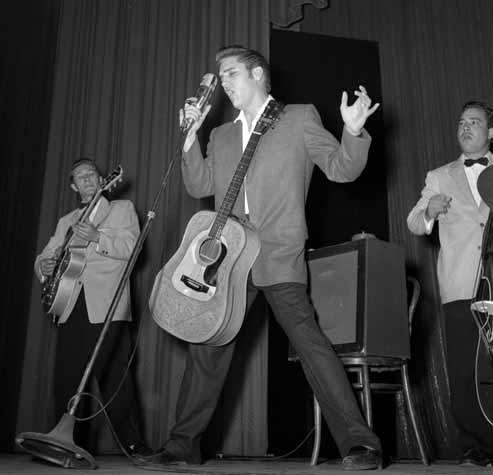
Photo from the St. Paul Show, courtesy Minnesota Historical Society
BILL DIEHL
Although Bill Diehl would become a much beloved rock ‘n’ roll disc jockey in the fall of 1956, (never say rock ‘n’ roll on WDGY!), that May he worked for staid old WTCN and was also a columnist for the St. Paul Pioneer Press. He was also 30 years old. On May 20, in his Sunday Pioneer Press column, he wrote a scathing open letter to The King:
Dear Elvis:
Last Sunday we met you for the first time. Remember Sunday? It was a day of disappointments. The weather was disappointing. Your crowds both at the St. Paul and Minneapolis auditoriums were disappointing (a Twin Cities total of something like 25,000 was expected and the combined total was only about 6,000). And Elvis, we’re sorry to say it, but your act was disappointing.
This column has been quite a booster of yours. And we’re not giving up on you. Yet. We liked you because you dared to be different. and we liked you because we heard you didn’t drink or smoke. Knowing you were idolized by millions of kids, we thought you were setting a fine example.
Oh, we heard grown-ups make cracks about your sideburns but so what? And we heard that you looked like “one of those hoodlums.” Again, so what? Maybe the kids would let their sideburns grow, but also in setting an example — didn’t smoke and drink, maybe eventually the kids would ape you that way, too. And you’d accomplish something.
So we said, okay, come on, Elvis! We saw you, talked to you and were impressed by your courtesy and consideration and poise in the dressing room. You were generous with autographs and interviews. Your fingers showed no yellow stains, so we assume the stories about your not smoking are true. Your hair was long, sure, but neatly groomed. Even your fingernails were reasonably clean. Yes, you had pimples as some people cracked, but many at your age do. (I might be getting one on the end of my nose right now!)
But then, Elvis, we saw your act. And we were, in a word, disappointed. Somebody, probably an adult, has told you to wriggle around when you sing. Your actions, Elvis, were “low.” And you don’t have to be like that, boy. Your records are selling like crazy to kids who have never seen you but who like your singing style . . . free and uninhibited.
On stage, Elvis, you were nothing but a male burlesque dancer. Your gyrations were straight from strip-tease alley. Happily, you did leave your clothes on. Now, you flopped in Las Vegas because you were playing to adults who don’t dig you. some calculating adult booked you in there — and he was pushing you. You got the bounce.
Do you wonder why flops No. 2 in St. Paul and No. 3 in Minneapolis happened? Oh, they’ll blame the weather and Mother’s Day and anything else. We’ve been asking around, though, and I’ll tell you one big reason: Moms and Dads had seen you on TV and didn’t like your unnecessary bump-and-grind routine.
If more Moms and Dads had seen you, I bet not even the scattered 6,000 would have turned up. You disillusioned many of your fans needlessly. You set a fine example with your courtesy and by not smoking and not drinking. Why, Elvis, do you resort to your “Pelvis Presley” routine? You’d better drop it before more and more people drop you.
Of course, there’ll always be a few crackpots to screech: “Oohhh, Elvis” when you do your hip-wriggle bit. But by now you should know that in show-biz nothing grows in dirt. Clean it up and you’ll really clean up.
Hopefully, Bill Diehl
WILL JONES
Will Jones reviewed the St. Paul show and provided some minute details:
Elvis Presley, young bump-and-grind artist, turned a rainy Sunday afternoon into an orgy of squealing in St. Paul Auditorium. He vibrated his hips so much, and the 3,000 customers squealed so insistently at the vibrations, it was impossible to hear him sing. None of the smitten seemed to care. The crowd was much smaller than expected. Presley faced a sea of empty seats. When the noise started, however, even the empty seats seemed to be screaming.
Presley wore a Kelly green jacket, tight blue trousers, and, disappointingly, black leather shoes. He only sang “Blue Suede Shoes.” (I couldn’t actually hear him sing it, because of the squeals. A girl in tight pink slacks assured me that’s what it was.)
Tight pink slacks were almost a uniform among the fans. Tight white slacks and tight black slacks were popular. Presley was wearing tight black jeans and a black silk shirt when he arrived at the auditorium. A dozen policemen marched him into his dressing room. Then he stood around with his hands in his jeans posing for pictures and talking with reporters.
He smiled a faint, half-sneering kind of smile at times. He didn’t look nearly so tortured or pouty as he does in most published photographs. His brown hair doesn’t appear so dark, either. He has pimples all over the back of his neck, a few on his chin, and a number of nervous facial mannerisms. The most intriguing is the repeated, rapid puffing of a single cheek. His long eyelashes have a Valentino-like, mascaraed look.
… People kept handing him pictures and slips of paper to autograph. His right cheek twitched each time he signed an autograph.
… Presley came here from Memphis, his home. He’s been so busy he hasn’t had a chance to get home for a while. He got a few free days by surprise after he flopped at a Las Vegas night club. They replaced him with a girl singer. The older customers in Las Vegas just didn’t dig him.
I asked Presley about his movie plans. He’s been signed for one picture a year for seven years by producer Hal Wallis. … “Mr. Wallis asked me what kind of a part I’d like, and I told him one more like myself, so I wouldn’t have to do any excess actin’. So he’s havin’ somebody write one for me like that.”
… The policemen let a few lucky girls at a time into the dressing room for autographs. One who came in had a haircut just like Presley’s. Another one brought him a flattened greasy popcorn box to sign.
He had a way of whipping up the crowd at the start of a song by playing a few introductory notes, stepping to the microphone, and then singing nothing. Squeals! Another pause, another false start, more squeals, and finally the song.
When he wanted silence to announce a number he held up a hand in the traditional platform gesture – but a double-jointed thumb twitched as he held the hand aloft.
In moments of public passion, he clutched the microphone to his forehead. He ended up limp and sweating and loped off the stage half-staggering. The mob screamed and ran for him. The police marched him to a waiting car.
A young, beautiful, well-dressed, highly-made-up blonde tried to get in the car with him. The police barred her. “I’m a member of his company!” she cried. “I belong with him! Stupid police!” Presley got away. The blonde walked around in the rain complaining to bystanders while the rain made a soggy mess of her hair.
MINNEAPOLIS
Skarning still held out hope that the Minneapolis show would make up for it, but the 8:00 show at the Minneapolis Auditorium drew a paltry 1,300, when he needed 20,000 to break even. Skarning lost his shirt. According to Dede (see below), the show was opened by a girl singer.
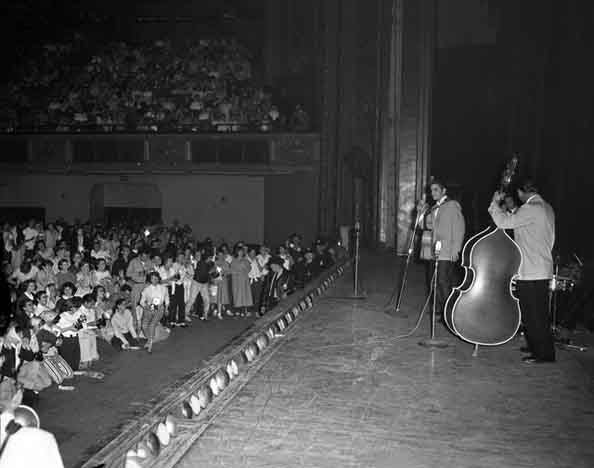
Photo from the Minneapolis Show, courtesy Minnesota Historical Society
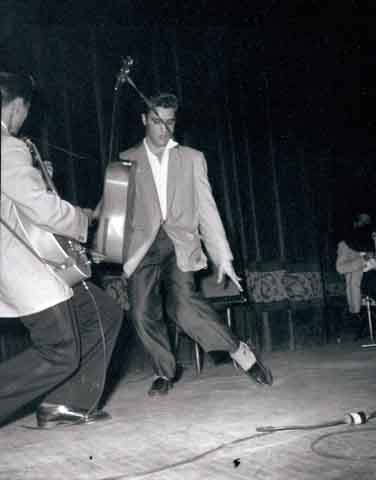
Photo from the Minneapolis Show, courtesy Minnesota Historical Society
Below are a series of photos taken by the Minneapolis Tribune:
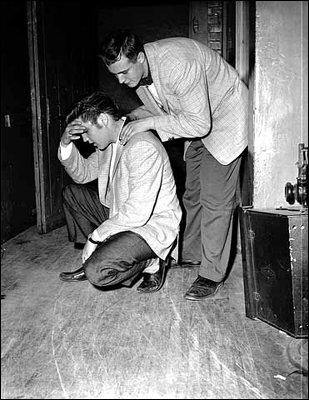
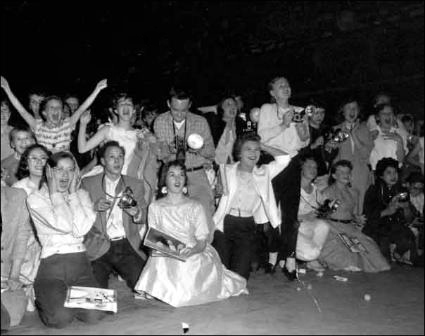
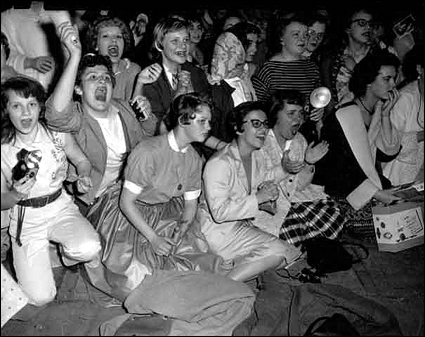
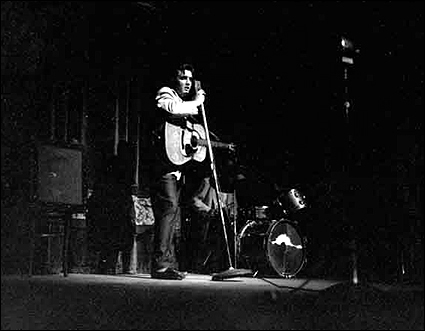
THOSE GIRLS FROM ST. LOUIS PARK!
But Dede Smith, Timi Anderson, and Suzie Olson, three young reporters for the St. Louis Park High School Echo, had nothing but good things to say about their hero Elvis, whom they got interview before the Minneapolis concert. Here is their official review, dateline June 7, 1956.
Elvis Presley, 21-year-old singing sensation from Memphis, stormed the Minneapolis Auditorium May 13 with his belting, dynamic style. He was greeted by a laughing, shouting, idolatrous mob as police escorted him from his car to the stage door. Smiling and waving, he set off boisterous yelling and moaning.
Backstage, the handsome dynamo practices his songs and talked to reporters while the crowd out front chanted, “We want Elvis!”
We asked Elvis his opinion of the screaming girls, and he said, “When they stop screaming, Ah’ll start worrying.” He talks with a soft southern drawl. He said he didn’t mind girls wearing jeans – “Ah just like girls.”
As time progressed, Elvis acquired a good case of stage fright. He paced the floor, twitching. His hands were cold, and he occasionally leaned on a wall or a person, whichever was handiest.
Once onstage, Elvis took a typically dramatic stance, whanged on that old gee-tar, stomped his toot and wailed, “Now since ma baby left me . . . ” At that, the girls pushed toward the stage, frantically screaming. Police sought to hold them back. Howls continued throughout the entire performance, and only and occasional word of songs such as “Blue Suede Shoes,” “Money Honey,” and “I Got a Woman” was heard. Nobody seemed to care that he couldn’t be heard. Just to see him was enough. After a half-hour performance, he dashed off stage, exhausted. Later, as he got into the car to leave, hundreds of girls yelled after him, and Elvis Presley drove off, leaving a trail of happy memories.
On a blog that I have failed to properly document, a letter was published that Dede wrote to her older sister Julie about a week after the show. It contains many more details, some inconsequential, some interesting, at least one nearing scandalous, considering the fact that the girls were only 14 years old. They had wrangled their way into the press conference and had some private time with Elvis.
At the press conference, Elvis wore black. “He was so sweet and so really charming and so kind and so nice and so twichy and so real and so human and so cute and so honest and so playful and so wonderful and so interested in us and so soft and warm and he was – is – so terribly SEXY!!!!!!!” With him was a man Dede described as Elvis’s best friend Eddy, who was on leave from the Army. And as for that question about whether Elvis likes girls who wear jeans, the real answer was, “Honey doll, Ah just like girls, with any kind of clothes, or without.” This was followed by Dede writing eeeeeeeeeeeeooooooo!!!!!!!!!!!
Here’s Dede again:
You’d think he isn’t the nervous type, wouldn’t you? Well, I’ve never seen anyone as nervous as Elvis Presley before he went on that stage. He had changed into his costume of a bright yellow sports jacket and lite brown slax. He had on a beautiful watch with diamonds on it and a huge diamond ring on his right hand. He wasn’t wearing blue suede shoes … just dirty black loafers (Eddy said he didn’t have time to polish them.) And brown sox with fleur de lis or some such thing on them.
Eddy had to almost push Elvis on stage . . . and once he was on Elvis recovered himslef. Elvis’s legs went into a stuttering – squirming movement, those dark rimmed eyes fixed on infinity, his long hair flopping over his forehead, his body almost rigid with emotional intensity yet throbbing like a high powered car with the gas wide open and the brake set tight . . . Every once in a while he’d kick the microphone forward and pull it back again.
Other songs he sang were “Only You,” “I Was the One,” and two others that Dede couldn’t hear at all.
Once he ran downstage to the footlights and girls howled like madwomen. He was on for about a half hour and then he ran off stage and kept right on running until he came to a piano at one corner of the stage and collapsed on it. You see, I found out that when he was in St. Paul he’d thrown his guitar up in the air and it had gashed his head, and he’d started bleeding. Skarning’s secretary had fixed it up, she told me. It started to bleed again when he got offstage here and everybody was mopping up his awful cut. I guess it was pretty bad – it was covered up by his hair (poor darling). [See St. Paul above.]
He is afraid he is going to be drafted as Eddy was and he made us promise that if he was we’d write to the President. We said we would. He was just glassy-eyed afterward and could hardly catch his breath. . . . He went to his dressing froom after a little while and later went out to the car. He motioned to us to come to him and said to me “C’mere baby” and we started to come and a cop got in our way and before I could get a word out he was gone. He wanted to kiss us goodbye too. He had been very disappointed that no one had been out at the airport to meet him. He also wished there had been more people there at the performance. There were 4,000. I still can’t believe it happened to me. . . . He likes to be around girls, and we were the only girls backstage.
Please save this letter and the other one so I’ll have a written record of it all.
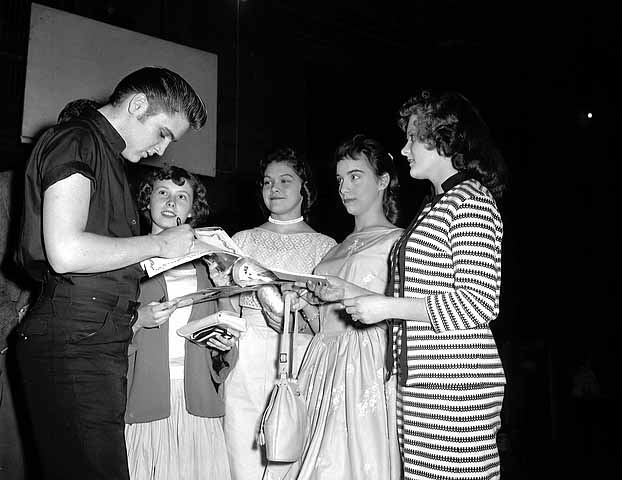
Photo from the Minneapolis Show, courtesy Minnesota Historical Society
The photo above of Elvis signing autographs was posted on a Star Tribune blog in 2011, and it turned out to be our girls! Suzanne Olson wrote:
I thought you might be interested to know that I’m one of the girls in the Elvis photo. In fact, I may be the only living person left in that photo. The girl standing closest to Elvis is Timi Anderson, then myself, next to me is Dede Smith, who is responsible for getting us all backstage for the concert, and the girl on the far right is Anna Skarning, the promoter’s daughter.
Last year Dede Smith and I found each other after a 45 year lapse and she wrote to me the whole story about how this miraculous event was accomplished. Unfortunately she died a few months later which was very sad for me having just found her. Timi Anderson died quiet a while ago and Anna Skarning was someone I saw backstage for the first time and never again …
Timi, Dede and I all knew each other and went to St. Louis Park Junior High School. Dede and I were 14 years old and were best friends, Dede and Timi were neighbors and I believe Timi was 13 at the time. I have no idea how much the ticket cost. I think Dede must have purchased them. I remember waiting out in the pouring rain for hours before we were allowed in. Then it was a mad stampede to get seats. Dede’s mother was a free lance writer and Dede was following in her footsteps and had a part time job writing for the local Sun Newspaper. She was the one who bugged the promoter to get us back stage which happened very shortly after the mad stampede.
Watching the concert from back stage was such a surreal experience. I remember thinking that he was unlike any 21 year olds I had ever come in contact with. He didn’t seem at all adult, and at the same time very adult. I’m sure it had something to do with how sexy he was. I didn’t really take it all in until the next day. Of course when we went back to school on Monday nobody would believe us that we had been back stage. That is, until the Parade Magazine came out 2 Sundays later. Then we were celebrities. And continue to be every time the picture is printed (about once every 10 years). The picture even turned up in another class yearbook that was remade for a 1968 reunion yearbook a few years ago.
I never imagined that Elvis would continue to become such an icon. And yes, I’m still a fan. At one time I even had an autograph on a program from the event and I threw it out because it was such a bad scrawl that it was illegible. I’ve been kicking myself ever since.
ANOTHER ST. LOUIS PARK REVIEW
Okay, yes, I am from St. Louis Park. This review is from the Just Us, the newspaper of Central Junior High. (June 8, 1956) It is much shorter.
As the anxious crowd pressed closer, at last a lean, tall, young man walked onto the stage. He paused, strummed a few notes on his guitar and began to sing. The girls screamed and squealed in delight and the boys quietly ignored them.
The reason for all this hurry and flurry in the hearts of female Park teenagers? The answer lies in the personal appearance tour of Elvis Presley. In the last few months, Presley’s records have climbed to tops in the pops. “Heartbreak Hotel” has been the Number 1 song in the Twin Cities.
That night, when the young lassies returned from Mr. Presley’s appearance, they brought home highly valued possessions. Among the prizes won were: candy he threw to the audience; change collected by an anxious fan; buttons off of his shirt and coat; and more common things such as autographs and pictures taken by his much sought for side. (?)
1967
Elvis was not on tour, but he was not forgotten. Here’s a flier for the France Ave. Drive-In, featuring three of his films made in 1965 and 1966. Judging from the date, this must be from 1967. Who could resist WDGY Date Nite! You could meet the WDGY All Americans (what they called their DJs), win free records and transistor radios, and get yourself some autographed pictures and free theater tickets. One lucky boy and one lucky girl won a portable stereo, courtesy of Goodman Jewlers. All that was missing was a band, but it was March and maybe it was still a little nippy, thus the heaters for your car.
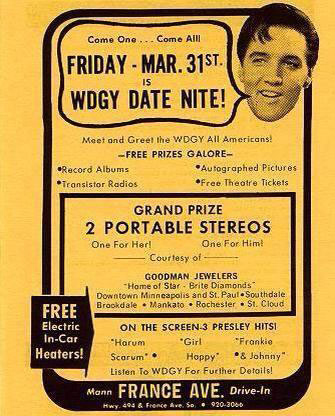
1971
Elvis appeared at the Met Center on November 5, 1971.
The Minneapolis Tribune published a half-page of ’50s-themed cartoons by Dick Guindon to announce the concert. The paper said it was the first of 12 one-night stands that Elvis was doing in November. “The singer’s strict devotion to his work is evidenced by the fact that no women are allowed backstage during the show.”
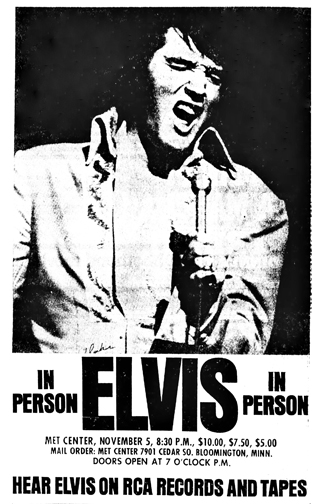
Minneapolis Tribune, October 10, 1971
The caption for the photo below reads:
Elvis sets off a Storm of Light
The spotlights stabbed down on a figure in a tight, spangled suit, a guitar twanged, and the capacity crowd in Metropolitan Sports Center burst into sound and light. Elvis Presley was on Stage. Flashbulbs (nearly 100 can be counted in this 3-second exposure) popped almost continuously as Presley performed the songs that made him famous in the 1950s and sang some new ones.
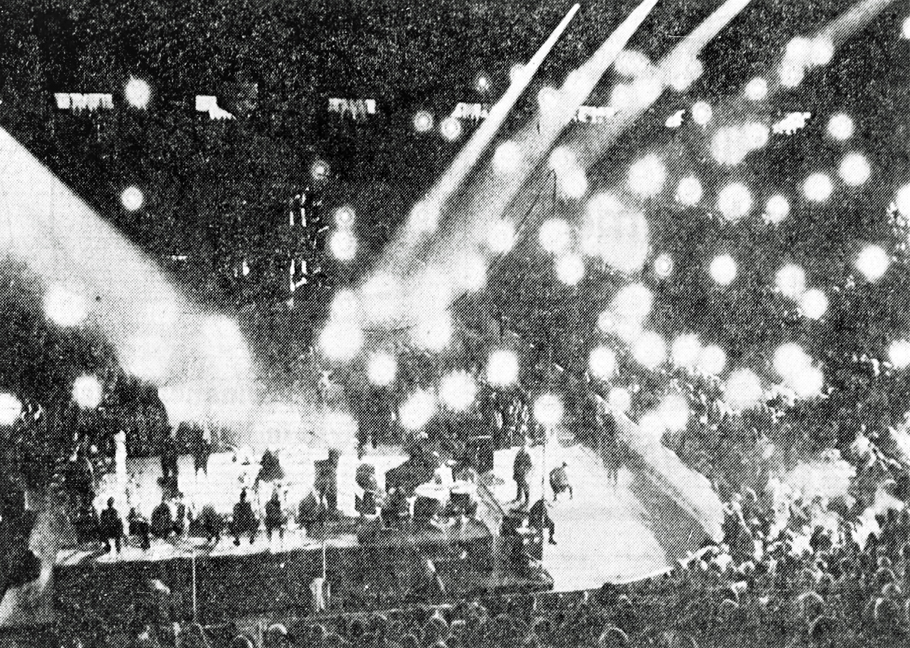
Photo by Peter Hohn, Minneapolis Tribune, November 6, 1971
The Insider’s review was not impressed with “The King,” calling him “cold as a herring.”
MINNEAPOLIS TRIBUNE
The Tribune’s review by Mike Anthony was decidedly more positive:
Thousands Cheer As Elvis Takes Stage
When Elvis Presley sauntered onto the stage of Met Sports Center Friday night – his guitar slung over his shoulder – the flash bulbs lit up the room and 17,600 people gave out a bellow that might have been heard in Osseo.
At that moment, Joanned Azzoni, 21, St. Paul, put her hands above her ears and screamed, “I can’t believe it. I can’t believe it.”
Miss Azzoni is an Elvis fan. She has posters all over her room at home, she said, and a menu on top of her TV set, from Presley’s last appearance in Las Vegas, Nev., as well as a bunch of rocks, supposedly from Presley’s home in Memphis, Tenn. The rocks were given her by her grandmother.
The day tickets went on sale for Elvis’s show, Miss Azzoni was at the Met Center along with several hundred others at 7 a.m. “And I have been crying since I got them,” she said.
Five minutes before the show started she and her friends, Julie Jaeger, 20, and Linda Jaeger, 28, were waiting, binoculars poised.
“I couldn’t concentrate at work all day,” said Julie “Who could concentrate? All the orders I sent out, they must have been all wrong, I have no fingernails left.
Said Linda, “I’ve waited 15 years for this. When I first saw Elvis on the Sullivan Show I vowed I’d see him some day.”
Seemingly everybody brought binoculars and a camera. The flash bulbs popped all evening. Three middle aged women sat in the balcony before the show peering at the stage. “Is that him?” said one. “No it can’t be. He’s got a moustache,”
Diane Nelma, 28, flew in from Chicago, Ill., Friday night to see the show and planned to fly right back afterward. “Why?” Because I just love him,” she said.
The age range of the audience was wide but it was predominantly later 20s and early 30s, ran through 70 minutes of many of his old favorites (“Heartbreak Hotel,” “Blue Suede Shoes,” “Love Me Tender”) and some newer songs (“Proud Mary” and “Bridge over Troubled Waters”). He sounded better than ever.
Clad in all white, he finally threw the flowing red scarf from around his neck into the audience. It landed on a policeman seated below the stage and six girls leaped at the policeman. One lucky girl got the scarf and ran to her seat.
In 2019, Frank Heino says that he was the police officer in question! “ A highlight of my career! I didn’t know that he tossed the scarf, I thought the girls were rushing the stage. I was later told about scarf landing on my helmet and sliding down the side!!!”
Cheri Kuhlman remembers,
When he performed here, he stayed at the Marriott Inn on 494 and rented the whole top floor just for him and his family. My brother Steve and his wife were leaving the Marriott on the side parking lot when the limo came in the side door. My brother’s wife got so nervous, she said “Steve, that is Elvis!” He said “Go get his autograph,” and she said, “My knees are shaking too much.” Elvis waved at her before she got in the car. She was happy just for that wave.
MINNEAPOLIS STAR
Freelance reviewer Jim Gillespie reviewed the concert for the Star (November 6, 1971), with the headline “Elvis on stage: He’s unchanged and so is fans’ love, love, love. Gillespie noted that the place was packed, including the bowl area behind the stage, where people got a view of the King’s head. The show began with the Sweet Inspirations, followed by comic Jackie Kahane. After the intermission/souvenir hawking break, the 20 piece band broke into the theme to “2001,” and Elvis himself appeared.
Elvis, resplendent in his white jumpsuit and cape with red trim and his chunky, bejeweled belt, surveyed the crowd, strapped on his trusty Gibson, and blasted right into “That’s Alright Mama.” The five piece country rock band behind him was superb, featuring James Burton on lead guitar.
The audience was rather sedate except for the screaming. No one stood up on their seat or rushed the stage. They just wanted pictures. Presley really put it on them, too. The cat can still really move. A little stylized maybe, but it’s difficult to be spontaneous when you’ve been at it for 15 years. . . . He didn’t seem to take the whole thing too seriously and seemed very relaxed.
The up-tempo numbers were easily the most impressive and his low-down nasty blues feeling shone through the glitter often enough to make me shed a tear for what might have been if he had not been seduced into the Muzak field and the cinema some years back. “Bridge Over Troubled Waters” was so slick I kept expecting to trip over the slot machines.
JIM KLOBUCHAR
Jim Klobuchar’s humorous column of November 6, 1971, focused on the expenses incurred at the Mariott Inn, where “batteries of accountants are computing the bill for Elvis Presley’s two days of the quiet, meditative life among the scenic cloverleafs of interstate Hwy. 494 in Bloomington.” One “convalescing” spokesman for the hotel estimated the tab at at least $4,000, more than any sultan, maharajah, movie star, or circus.
Klobuchar reported that the concert broke all Met Center gross receipts ($150,000), security guards (60), and “adoring witnesses (17,084). Two entire floors were reserved for the party, with 60 rooms and “one king-sized bed especially fashioned by the motel staff to meet Presley’s various specifications.” The hotel had to build two suites for Presley and colonel Tom Parker, and turn another into a formal dining room.
Presley arrived “unpretentiously aboard one of his three jet planes with his personal physician, security chief, 12 bodyguards, guitar tuner, and the balance of the city of Nashville.” Perhaps still feeling a little lonesome and insecure, Elvis also hired six off-duty Bloomington policemen for corridor patrol on the Marriott’s second and third floors. Security guards manned all entrances and exits, the elevators, laundry chutes and dumb waiter passageways to protect Presley from the ambushes of wily, desperate women.”
Presley’s bed had twin headboards and a hot pink bedspread. Underneath it was an orange rug. Elvis burned incense in the ashtrays. The plain white bedsheets were so big they had to be special ordered from GEM Department Store.
As for his palate, he had “two cheeseburgers and a glass of milk before the concert and ordered 21 slices of bacon, six eggs and an omelet Saturday morning. A half-eaten apple and banana peel were found in his bed Saturday morning. Which tells us the value of keeping ourselves nourished at all times.”
1974
Elvis came to the St. Paul Civic Center on October 2 and 3, 1974. On the second he wore his Peacock suit, and on the third he wore his Chinese Dragon suit.
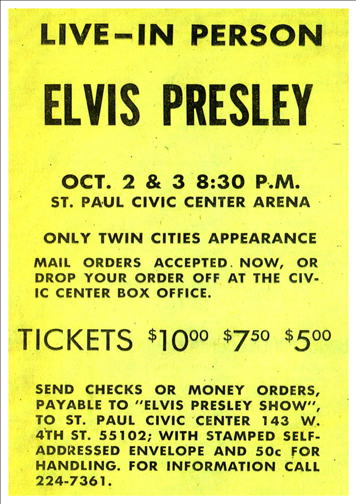
Image courtesy storenvy.com
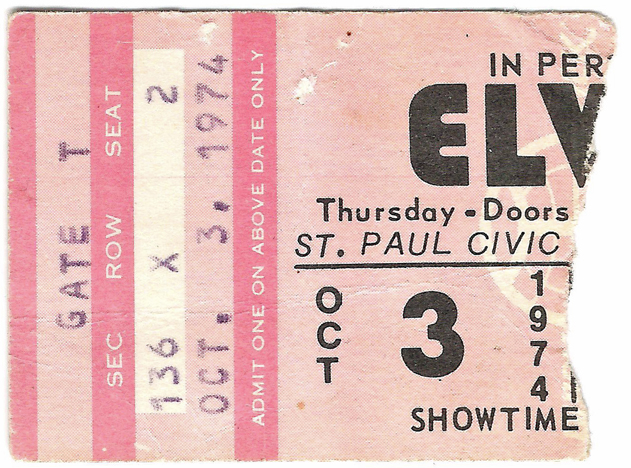
Ticket image courtesy Mary B. Chapman
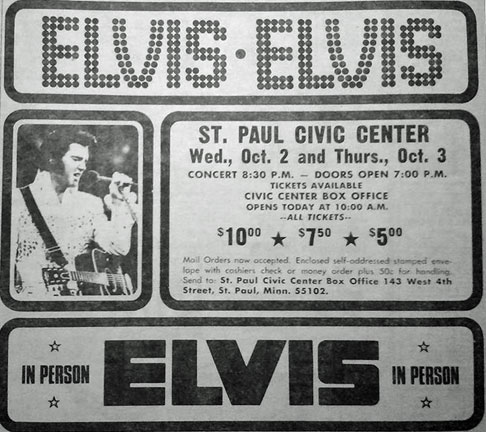
St. Paul Pioneer Press ad courtesy Jim Froehlich
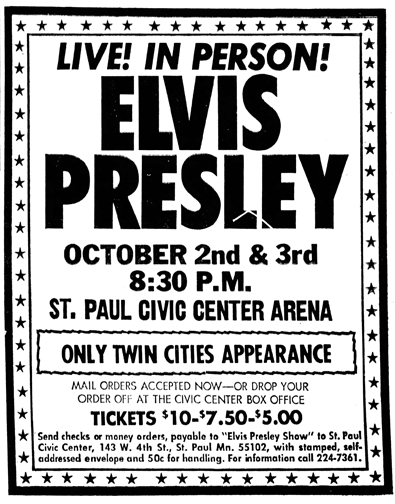
Minneapolis Tribune, August 11, 1974
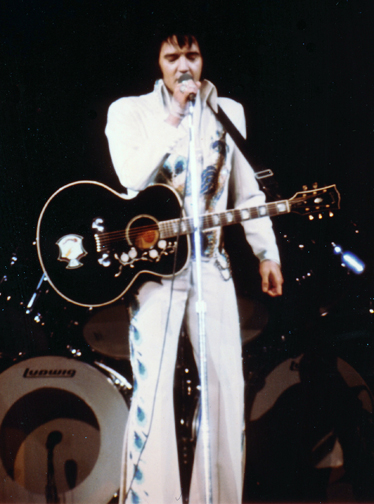
October 2, 1974 – Image courtesy Scott Coltrane
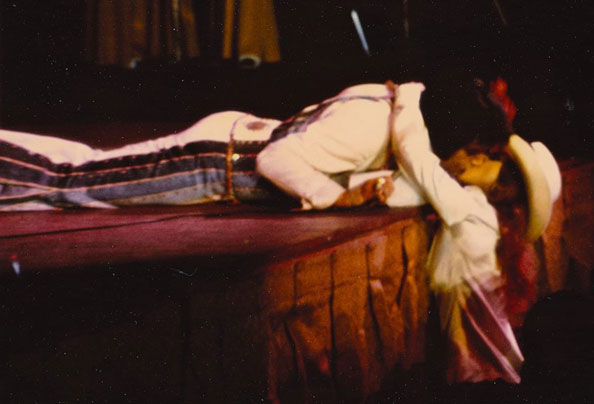
Photo courtesy Scott Coltrane
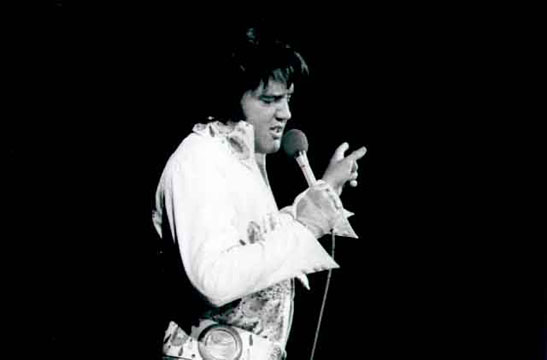
Photo courtesy Minnesota Historical Society
ST PAUL PIONEER PRESS
Here is the review from the St. Paul Pioneer Press by Mike Sweeney.
Elvis Still Makes ‘Em Scream
Elvis Presley, noticeably plump in a white jumpsuit with a peacock on the back, rode the nostalgia wave into the St. Paul Civic Center Auditorium Wednesday night.
“This is a huge building,” the 39-year-old acknowledged king of ’50’s rock and roll told some 17,000 fans. “What is this, the Astrodome?”
He began his 50-minute concert with “See See Rider,” an early tune that set the pace for the evening.
Elvis’ fans, including teeny-bop bubblegummers, middle-aged women with beehive hairdos and grandparents, seemed to love it.
As Elvis took his audience through the 1950s with songs like “I Got A Woman,” “Treat Me Like A Fool,” “Blue Suedes Shoes” and his trademark “Hound Dog,” he periodically bantered with the audience and called twice on backup vocalists.
As his backup groups sang and he wandered the stage talking with the audience. Elvis seemed tired. He looked tired – like a man on the brink of middle-age with an enormous reputation to uphold.
Elvis played his reputation as a hip-swinging, hair-tousled, pout-lipped rock star to the hilt.
The fans loved it, at least those close enough to see clearly, as he shot a hip hither and a shoulder yon to the beat of a drum.
Screams, which marked Elvis’ concerts in years gone by, were heard periodically throughout the evening and woman flocked near the stage to catch one of dozen or more silk scarves he intermittently tossed to the audience.
The scarf catchers were an unusual seated group of women grasping at a legend.
Twice, Elvis lay or knelt on the stage and briefly kissed two scarf catchers. The second one, a young girl, politely said. “Thank you.”
Elvis’ renditions of the upbeat tunes which made him famous like “Hound Dog” scored well with the audience as memory grabbers, but lacked the verve and vitality which is why most folks remember them.
His ballads such as “Hawaiian Wedding Song” scored less on the reaction scale, but were delivered better and reminded the audience Elvis can indeed sing a fine song when not image-living.
He ended with “Can’t Help Falling In Love With You,” which brought numerous women to the stage lip, screaming “Elvis!” and reaching to touch his hands.
Elvis gave the audience what it wanted and it appeared appreciative.
After all, as the king himself told his fans after a short explanation at his large rings containing 11 half carat stones: “The reason I’m telling you about these rings is that you help pay for them.”
MINNEAPOLIS STAR
Roy M. Close wrote the review for the Star:
Music is incidental in Presley “pageant”
Some things must be seen to be disbelieved, and the Elvis Presley Show is one of them.
Presley, the undisputed rock and roll king of the mid ’50s, is now 39 years old and more than slightly paunchy. But as his sellout concert last night demonstrated, he remains a glittering sex symbol whose physical presence alone is sufficient to send normally rational women into squealing paroxysms of delight.
If his singing hasn’t improved with the experience of two decades, at least it hasn’t gotten any worse. And Presley has clearly mastered the art of selling that image of himself that audiences are most eager to buy.
This two-hour show is a model of vulgarity, a slick package delighted to present the image without forcing its owner to work any harder than necessary. It is a fully costumed, dazzlingly lighted extravaganza with a supporting cast of more than two dozen. It is, in short, a pageant in which the performance of music is almost incidental.
Although Presley didn’t seem actually bored by them, his delivery conveyed the distinct impression that he has long ago forgotten what (if anything) the songs were about. He seemed happiest when he was distributing scarves – of which he had an apparently an inexhaustible supply – to ecstatic women in the first row.
In January 2019, FTD, and Australian Fan Club, released “Elvis: St. Paul to Wichita” as a 5″ digipack, taken from the original soundboard source, as a 2-CD set. In the photo below he is wearing his “Peacock Suit.”
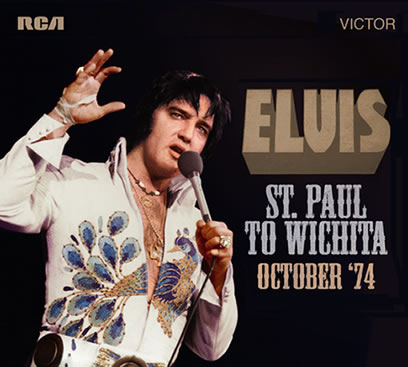
1976
Elvis came to the Met Sports Center on October 17, 1976. (He also appeared in Duluth on October 16.)
This may be the time that Robyn Cunningham Rasmussen remembers:
I’m not sure what concert it was in his later years, but he was staying at the (then) Hilton Hotel; it was winter and he was craving watermelon. The food service people were scrambling to find some. Long story short they ended up calling Bernie Kessel – he told them to call Edelsteins…..who got The King his watermelon!!!
This is his Inca Gold Leaf suit.
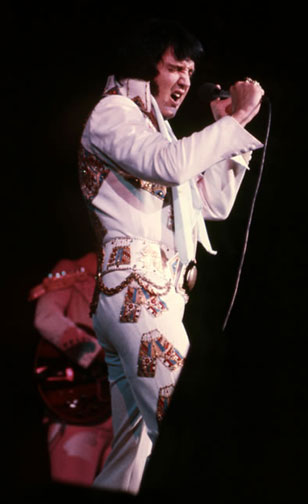
Photo courtesy Tim Healy
St. Louis Park grad Scott Coltrane was a huge Elvis fan, even in high school:
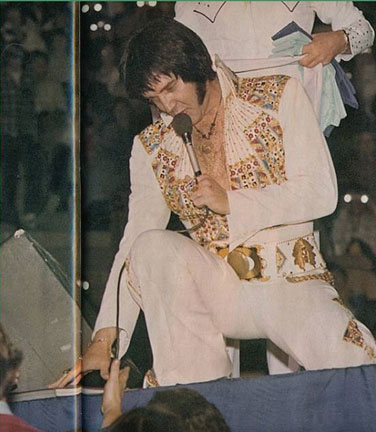
Photo courtesy Scott Coltrane
Right there in SLP I was running a worldwide fan club, called DISK. It stood for “Deal Initiators for Stuff on the King” — clever, huh? But it was! It was a precursor to eBay. People would send me a list of their wants and their for sales, and I would hook up buyers and sellers. Of course I’d take the best stuff for myself. It was mainly records and magazines. I also had dozens of Elvis pen pals around the world. After graduation [1974] I began following Elvis around on tour, see one show, drive through the night to the next town, sleep in the car, see the next show, etc.
But one time when he came to Minneapolis and played the Met Sports Center something unusual happened, for both him and me. I heard he was a Muhammed Ali fan and so I got a book about Ali, wrapped it in cellophane, and when he walked in front of me on stage I jumped up from my first row seat and put it at his feat. He knelt down and looked first at it, and then me, and that’s when I reached up to shake his hand. Right at that moment everyone else jumped up to do the same. So, anyway, I told that story for two decades with no proof whatever. Then one day a tribute magazine came out and it had a photograph some anonymous person who was there that night had taken, and it showed my hand! And the book, too! Look at the lower left of the stage. You can plainly see the book. The lone hand reaching up is mine. You can only barely see the rolled up cuff of my blue flannel shirt and the very top of my head, but that is me. There simply cannot be two people who gave Elvis that book.
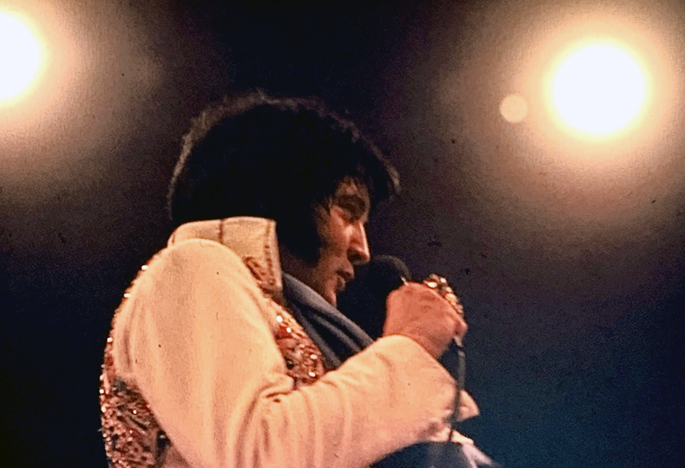
Photo courtesy Scott Coltrane
MINNEAPOLIS TRIBUNE
Here is the review of the show in the Minneapolis Tribune by Michael Anthony (October 19, 1976).
Elvis Shakes, Rafters Rattle, Money Rolls
Elvis Presley, “the Big One,” as he has come to be called, shook those famous hips, handed out a few dozen scarves and sang for 72 minutes to a capacity crowd of 15,800 screaming fans at Met Sports Center Sunday night. These days, a Presley concert is much ritual as anything else, and it begins as the crowd enters the auditorium. “Elvis Super Souvenirs” – posters, photo albums and buttons (big ones this year, the size of a pizza) – are aggressively hawked at various tables, and we’re reminded of those souvenirs by the announcer throughout the show. (Col. Tom Parker, the mastermind behind Elvis’s career all these years, knows about such things. Parker started out in the 1930s selling foot-long hot dogs at state fairs.)
The show itself also has become ritualized. We expect, that is, the lights to dim just before a drum roll and the band’s statement of Richard Strauss’s arching theme from “Thus Spake Zarathustra.” We expect the room to come ablaze from thousands of flash bulbs – to say nothing of the ear-piercing screams – as the Big One walks onstage. We expect – and it happens during the songs he’s not too interested in – the scarf schtick, only now it’s become rather machine-like. Trailed by a dutiful stagehand who loops scarves around the Presley neck, Elvis approaches the crowd and drops one of the scarves into a stretched-out hand near the stage. For one brief, shining moment that scarf was around the Big One’s neck. With one scarf Elvis cleaned out his right ear before throwing it to the crowd. And three girls, standing on tiptoes, actually got a kiss.
There’s also a “Let’s Pretend” element to the show. Let’s pretend that Elvis, dressed in a tight white jumpsuit extravagantly overlaid with rhinestones, won’t really be 42 next Jan. 8, that he doesn’t have a weight problem so serious he had to check into a hospital last year to drop about 30 pounds, and that his predominately female, mainly middle-aged audience is still teen-aged: chewing gum like mad, saying “Kid” in front of each sentence and hurrying home from school to catch “American Bandstand.” For his part, and perhaps to amuse himself more than anything else, Elvis plays the role, but he exaggerates it in the same way that Mae West used to satirize by exaggerating female sexuality. He winks at, he teases the audience, and his pelvis swivels are now elaborate, amusing affairs accompanies by rim shots from the drummer. What else for a 41-year-old millionaire, so establishment these days that Richard Nixon made him an honorary narcotics officer, but to parody the Elvis of old, once the epitome of teen-age rebellion and outrageous sexuality?
Taken as is, however, this was a much more satisfying concert than Elvis’s last performance here, in St. Paul two years ago. The format was the same: brief opening acts (J.D. Sumner and the Stamps Quartet, comedian Jackie Kahane and the Sweet Inspirations) with the singers backing Elvis for his set in the second half. But the boredom that clearly afflicted him throughout much of the earlier show surfaced only occasionally this time around, and often Sunday we got a chance to hear him really sing, especially on newer tunes, such as his current heart-on-sleeve single “Hurt.” When he wants to use it, Elvis’s baritone, with its resonant bottom and somewhat nasal top, is in as good shape as ever and, of course, as a performer on stage, singing or just fooling around, he has more charisma than a dozen other top performers combined. Will Elvis endure? Judging by the screams of the audience he’s in no trouble. Nonetheless, his records are no longer guaranteed the top spot on the charts and, contrary to the old pattern, this particular concert took weeks to sell out. (However, in Duluth, where he performed the night before, the tickets went in three hours.) Here, it may have been the $12.50 price that kept some away.
MINNEAPOLIS STAR
Jon Bream reviewed this concert for the Star (October 18, 1976), and he wasn’t pleased.
Elvis: Lethargic king takes middle of road route
After commenting on Elvis’s physical decline, Bream laid into the show itself, calling it a “vulgar display of commercialism that was devoid of artistry, showmanship and integrity.” He said it was more like going to a museum than a concert, in that it wasn’t important what he was now, but what he had done to become the King of rock ‘n’ roll: “launched the careers of hundreds of rock stars, inspired thousands of rebellious youths, and caused millions of hearts to throb.”
Onstage, Presley was neither a parody nor a shadow of his former self. The singer’s once powerful, earthy voice is faltering and rather undistinguished. He didn’t hit all his notes and his style was characterized largely by an emotional ambivalence. There was more drama than emotion in his voice. His feelings were certainly hard to believe.
But Presley has an overwhelming charisma that makes the show more than a photo-snapping session of an over-the-hill hero. Presley smugly strolled about the stage tossing scarves to ecstatic female fans. (He even bent over to kiss three women.) The sex symbol struck the obligatory Elvis hip-shaking poses three or four times to satisfy his fans, but otherwise he was subdued, usually keeping his left hand on his hip and holding the microphone in his right hand. He seemed casual and lethargic, showing no enthusiasm or energy…
THE ENTERTAINER
This review by Seth Schwartz (October 22, 1976) is a long one, but because it is very direct and also not very accessible, it is quoted here extensively
The King Takes a Dive
There’s only one thing more depressing than the sight of Elvis Presley on stage in 1976. That’s the blind adulation of his fans as they rush the stage, grabbing for one of the sweat-stained scarves methodically tossed to the crowd by their bored and overweight King. And I say that as one who has long considered Elvis to be the greatest singer in the history of rock and roll, and a performer (on stage, on television, even in his movies) of uncommon magnetism.
More than half of the Elvis Presley show at the Met Center last Sunday night can be dispensed with within a paragraph. Joe Guercio and his Hot Hilton Horns, “straight from the Las Vegas Hilton,” cranked out “a Fifth of Beethoven.” Introduced as “one of the top gospel quartets in the country,” J.D. Sumner and the Stamps offered a stage presence and a song selection (including Paul Simon’s “Gone at Last”) with all the pious dignity of a McDonald’s commercial. Twenty minutes of shtick by a comedian whose name I’d rather forget followed by the Sweet Inspirations, Elvis’s female backup trio. The Inspirations zipped through a Stevie Wonder medley of no impact whatsoever, introducing themselves by their first names and Zodiac signs. The house lights came up, and in the 25-minute intermission that followed we were bombarded by exhortations of the P.A. system to purchase Elvis buttons, Elvis portraits, and Elvis pennants (all on sale at the arena) as well as plugs for Elvis’s crummy new album on RCA records and tapes.
As the lights went down and the band took the stage, and blinding flash of Instamatics signaled the Presley entrance. I think I looked forward to this moment as much as anyone, and I felt nothing: Not a presence, not an aura, and certainly not the sense of an American legend come to life. What I saw was a puffy-looking Presley in an ugly haircut and an uglier jewel-studded white jumpsuit, already sweating under the spotlights and looking uncomfortably close to the National Lampoon‘s cover caricature of a few month’s back.
He picked up his prop guitar and went into “C.C. Rider.” It was the first in an endless succession of throwaways that (said a friend) sound like the humming and mumbling you might hear from Elvis while puttering around the kitchen. In the shower, he probably sings with twice this much force. “Love Me,” “All Shook Up,” “Teddy Bear,” “I Got a Woman” – these songs went by like a breeze, without a hint of passion or power.
Yet there were one or two moments during which Presley tapped into what seemed to be a great reservoir of unused vocal power. These moments came without logic or warning. Why the man chose to sink his teeth into “You Gave Me a Mountain” rather than “Jailhouse Rock” is beyond me. But in the former selection and also in the otherwise unexceptional ballad “Hurt,” I detected a conviction missing from 90 percent of the performance.
… As for the Presley stage presence, it was hardly there at all. I didn’t expect to see the man whose hip-swinging gyrations were once blocked off the Ed Sullivan Show, but even the more recent karate-based routines were conspicuous by their absence. Tim Holmes noted that All Elvis’s moves seemed like variations on standing still. Indeed, if the merest shake of a leg can bring forth screams of ecstasy, why bother with anything more?
The rest is speculation about Elvis’s future, of which he had but little left.
ELVIS: THE CONCERT YEARS 1969 – 1977
In 1997, a Norwegian Elvis fan named Stein Erik Skar published a book that chronicled all of Elvis’s concerts from 1969 until his death in 1977. This book is out of print and, although clumsily translated, is a valuable resource, providing concert dates, narratives, newspaper reviews, names of musicians, and more.
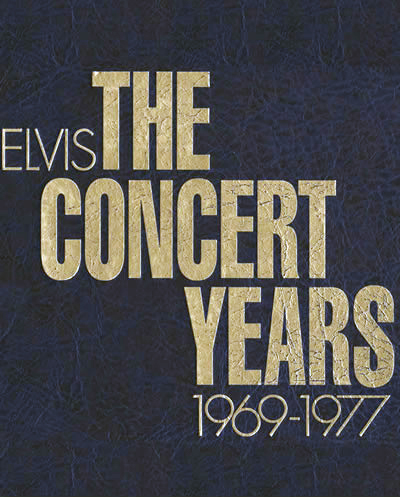
This is what the book had to say about Elvis’s 1974 concert in Minneapolis:
In Minneapolis hundreds of members of the audience completely lost their heads when Elvis was on the point of leaving the stage. A fan tells: “As though he wanted to prepare us he sang “Funny How Time Slips Away and lastly “Cant Help Falling in Love.” Then all hell broke loose. During the show the audience shouted as soon as Elvis turned his face twoards them. How this wasn’t enough. They jumped over railings, dived over chairs. I myself managed to get on to the stage but never stood a chance – my camera was damaged, my head also fared badly. 24 security guards couldn’t manage to keep them back. A grown man fought a little girl over a scarf. Fans and ticket collectors fought – a man punched out one of the ticket collectors. It was insane.
Hmmm…. methinks either this didn’t happen or maybe a different city. None of the other reviewers mentioned anything like this.
A BOOK AND A CD
A company in Australia also published a book specifically about this concert, called Elvis In a Minnesota Minute, by Ted Healy. According to the website Elvis Australia, only 1,500 copies were published, and are now out of print.
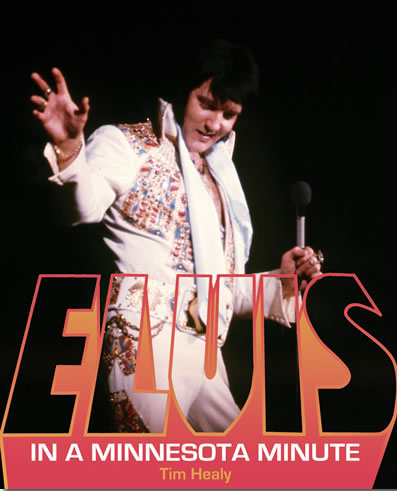
A Minnesota Moment CD features Elvis’ live performance on October 17, 1976 at Metropolitan Sports Center. Bonus songs are from Dayton and Sioux Falls on the same tour. The information on the Follow That Dream Website gives the names of the musicians and interviews with them:
Lead guitar: James Burton
Rhythm guitar: John Wilkinson
Acoustic guitar and harmony vocals: Charlie Hodge
Bass: Jerry Scheff
Drums: Ronnie Tutt
Piano: Tony Brown
Electric piano: David Briggs
Vocals: Kathy Westmoreland, Sherrill Nielsen, The Sweet Inspirations and J. D. Sumner & The Stamps
The Joe Guercio Orchestra conducted by Marty Harrell
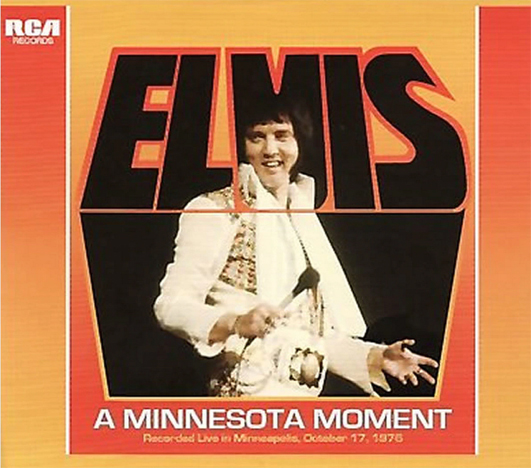
1977
Elvis appeared at the St. Paul Civic Center on April 30, 1977.
PIONEER PRESS
Here is the review in the St. Paul Pioneer Press by Charley Hallman.
Nasal Drip Cut Short the Hips
Elvis Presley cut short his appearance before 17,000 spectators at the St. Paul Civic Center Saturday night because of a bad cold. Ray Crump, equipment manager of the Minnesota Twins and a friend of Presley’s said the entertainer “apparently picked up a cold” after jogging around Lake Nokomis in Minneapolis Saturday afternoon.
Crump, who spent most of Saturday with Presley, said Elvis has dropped “a lot of weight, probably about 40 pounds” in the last two months. He has lost most of the weight through jogging and a heavy exercise program, Crump said.
Elvis dedicated his Saturday night concert to Crump’s boss Calvin Griffith and the Minnesota Twins baseball team. “It was a nice thing for him to do,” said Griffith after Sunday’s 6-5 Twins victory over the Detroit Tigers. “Maybe it had something to do with our winning today,” Griffith said. The Twins president and many members of his organization attended Saturday night’s concert.
“That was probably the worst concert Elvis has done in a year,” said Crump. “Not that many of us noticed, but he has been averaging an hour and a half in most of his shows on this tour.” Several times during Presley’s appearance, the singer had to stop for a drink of water and an assistant, Charlie Hodge, stood by with a box of Kleenex for Presley to use, which he did on at least two occasions.
Presley even joked about it during the concert. “It’s difficult to sing a love ballad with your nose running,” Presley told the audience. Presley’s early cutoff of the music stunned many of the concertgoers. There was no applause nor was there an encore at the end of the show.
The swivel-hipped rock singer, now 42, has weighed as much as 250 pounds recently, but he is now apparently down near 200. Several times during his concert appearance Saturday he had to rehitch his belt after his loose hanging trousers appeared to slip down over his hips.
SCOTT COLTRANE
Scott Coltrane, a huge Elvis fan, takes exception to the review:
That last review by Charley Hallman irks me. He said Elvis was sick with a cold and cut the show short and so the audience was “stunned” and gave no applause. That’s pure bull. I was there in the third row center main floor, and there was plenty of applause. This is one of the things that bugs me how towards the end of his career critics seemed to want to misreport or shape their review so that somehow Elvis was losing his stuff. It made for a better story, I guess — the great man falling down.
But I will tell you as an eyewitness to many, many concerts, I never saw Elvis fail to put on an excellent show. I once saw him get hit in the head with a frisbee that some moron threw, and he went right on with the show. And I never saw an audience fail to do anything by wildly applaud him. His voice was strong right up until his very last concert, which I was at. I saw every show on his last tour but one, and I only missed that because I totaled my car on the way. And, just for the record, he was never as fat and blubbery as you see some of these impersonators are today. That is a complete myth.
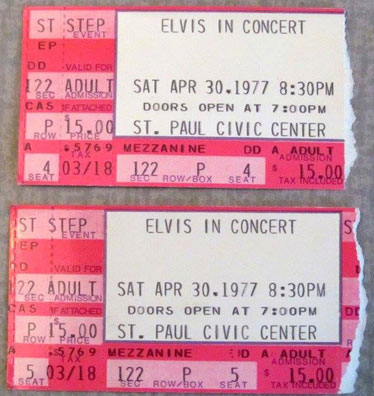
Greg Cosimini posted his parents’ tickets to Facebook
This was called his Mexican Sundial Suit.
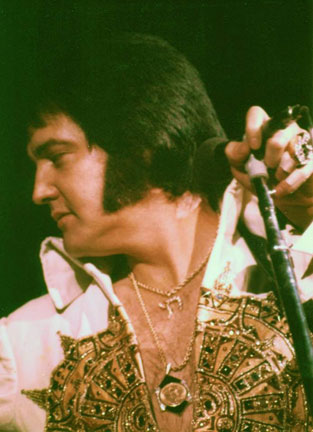
Here’s a photo Scott Coltrane took at that last concert
MINNEAPOLIS TRIBUNE
Michael Anthony reviewed the show for the Tribune. (May 5, 1977) He put the attendance at 15,600, and made much of the fact that Elvis had returned just six months after his last concert here.
After some speculations as to whether the King still has it or not, and whether his relationship with Tom Parker was on the skids, he turned to the concert itself:
More often than not, the singer has seemed bored onstage, his attention focused – when it is focused – more on the ritual of throwing scarves to females in the audience, on joking around with the band and parodying his “Elvis the Pelvis” swivels, than on singing songs he has apparently lost interest in.
Saturday night, things were a bit different, however. Dressed in his customary all-white outfit – bellbottom pants and a puffy doublet-sleeve shirt extravagantly overlaid with jewels (rhinestones?) in exaggerated American Indian designs – he really did do some singing for a change. It was either just the mood of the moment or the fact that he backed off from the scarf shtick for most of the set so as apparently not to cause a riot among the hundreds of women crowding the front.
And oddly enough, it was the oldies that brought out Elvis’s unique vocal power, such tunes as “Jailhouse Rock,” “It’s Now or Never,” and “Hawaiian Wedding Song.” The show iself was largely the same as that performed last October at Met Center: a first half performed by Elvis’s excellent band (featuring the ever-popular Hot Hilton Horns), the Sweet Inspirations, J.D. Sumner and the Stamps Quartet, and comic Jack Kaahane (and his ever-popular “these kids today … ” monologue).
Elvis sang basically the same material as he did in October, though he was onstage this time for just 60 minutes (75 minutes at Met Center). He’s apparently adding Paul Anka’s “My Way” to his repertoire because he sang it – and quite well – while reading a lead sheet. “I don’t know the words,” he said to his pianist and grabbed the music.
LISA MARIE
2003
Elvis’s only child wanted her own singing career, and on April 8, 2003, at age 35, she released her first album, “To Whom it may Concern.” Her first concert was held in Orlando in March 2003, in front of 1,000 people at the National Association of Record Merchandising Convention. (Minneapolis Star Tribune, March 22, 2003) The CD entered the local chart at No. 3 (No. 5 nationally), but fell to No. 17 the next week.
Lisa Marie’s debut in Minnesota was at the Orpheum Theater, opening for Chris Isaak on August 9, 2003. She also did an autograph signing at 2pm that day at Sam Goody Record Store at the Mall of America.
Jon Bream of the Star Tribune covered this appearance quite extensively. He wrote a long article about Chris Isaak, and then asked Isaak how he thought Presley was coming along. Isaak responded:
I see her getting hotter and having more fun every night. She’s new at this as an entertainer. At first, she was kind of frightened, and then she realized she could do it. Literally on the the third day, I noticed her going, “Hey, the audience came to see me, too.”
(Both articles August 8, 2003)
Bream’s review, however, was headlined “Presley falls short of the stuff of legends.” (Star Tribune, August 11, 2003) The review of Presley’s part of the show is given in full below:
She has the snarling lip, the swiveling hips and the left leg that won’t stop shaking to the beat She has the bedroom eyes, too, and the and the jet-black hair.
But as a singer and entertainer, Lisa Marie Presley has little in common with her dad. In her Minneapolis debut Saturday at the sold-out Historic Orpheum Theatre, the pint-size Presley showed some potent material but not a powerful voice or a commanding stage presence.
Even though this was the last night of her first-ever tour, the most famous rookie in rock history still hasn’t found her comfort zone. She seemed guarded as both a singer and performer, afraid to assert her voice in song or in conversation. She even relied on a lyric sheet on a music stand, festooned with flowers. (Unlike her dad, she writes her own material; her debut disc, “To Whom it May Concern,” has sold more than 500,000 copies since it was released in April.)
Presley’s songs aren’t shy. They are painful purges about betrayal set to a smouldering modern-rock sound that’s more likely to evoke U2 than Elvis. But with her dusky Cher-like voice, she didn’t project loudly enough on Saturday, except on her final two numbers, the swampy, hands on the hips “Lights Out” (about visiting Memphis and seeing her burial plot) and the defiant “Sinking In” (a post-breakup confrontation about being beaten down in a relationship).
A tabloid princess since the day she was born, the 35-year-old singer/songwriter didn’t seem afraid to be in the spotlight. She just didn’t handle it with aplomb. With a voice that was barely above a hurried whisper, she talked to the worshipful audience, mentioning her autograph session that afternoon at the Mall of America, responding to shouts from fans and hoping headliner Chris Isaak wouldn’t pull any tour-ending pranks to embarrass her.
As if on cue, Isaak and his band waltzed onto Presley’s stage and presented her with flowers and a cake with one lit candle. She later reciprocated by crashing Isaak’s encore and planting a huge kiss on his cheek, leaving a tattoo-like lipstick impression. That playful moment may have said more about her personality than her own 40-minute performance.
In later articles it was revealed that:
- When she crashed his encore to plant the kiss on Isaak, she had put on “his precious suitcoat covered in tiny mirrors (making the diminutive singer look like a deflated disco ball). (Star Tribune, August 29, 2003)
- She had been in a lot of pain during the tour due to stomach problems and acid reflux. At one point on a day off on the tour she had to fly home and get an endoscopy. (Star Tribune, September 26, 2003)
- Apparently Minneapolis was not the last show on the tour, as the article above said that Presley was scheduled to perform in Milwaukee on September 28, 2003.
2012
JON BREAM
On June 19, 2012, Lisa Marie appeared at the Fine Line Music Cafe. Curiously, there were no hits on the Strib database for this show. However, when announcing a proposed 2014 show at the Dakota Jazz Club in 2014 (see below), entertainment reporter Jon Bream wrote:
Two years ago at the Fine Line, Lisa Marie Presley showed promise as a purveyor of slow, smoky-voiced, downbeat Americana, mostly taken from her 2012 album “Storm & Grace.” She seemed much more confident as headliner than she had as an opening act for Chris Isaak in her Twin Cities debut in 2003. However, her Fine Line set clocked in at less than an hour. Fans expect more from rock royalty, so we can say “That you, thank you very much.” (Minneapolis Star Tribune, April 25, 2014)
JON CLIFFORD
Jon Clifford was at the 2012 show at the Fine Line. When he heard of Lisa Marie’s death in 2023, he wrote:
This was the second time I had seen her play, the first being in Memphis. She was in fantastic form for this show.
However, my take from the night was how she wouldn’t make eye contact with anyone at all. For good reason, as I concluded. The front was riddled with 70-year-old people wearing Elvis garb and looking like they just returned from a weekend bender at the casino. I felt a great deal of sympathy for her in that no matter what she did, or level of talent, she would only ever be appreciated by those people due to being his daughter.
I hope she found joy in her life, as I am quite sure she was a prisoner of hereditary fame her entire 54 years. Safe travels Lisa, you are free.
He added, “I wish people could have seen her and appreciated her for who she was.”
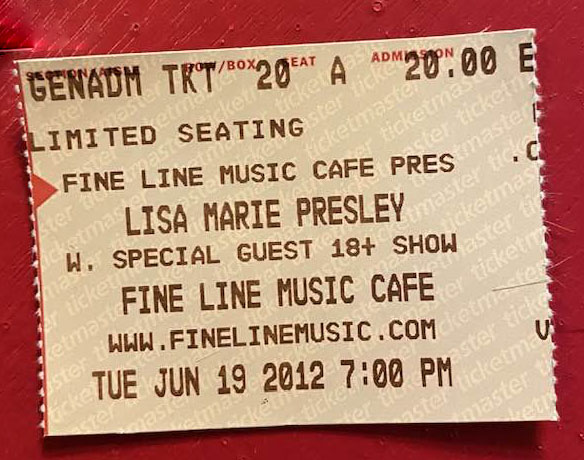
Ticket stub image courtesy Jon Clifford
STEVEN COHEN
Steven Cohen took some great photos at the 2012 concert, which he has graciously given me permission to post. Here are four of them:
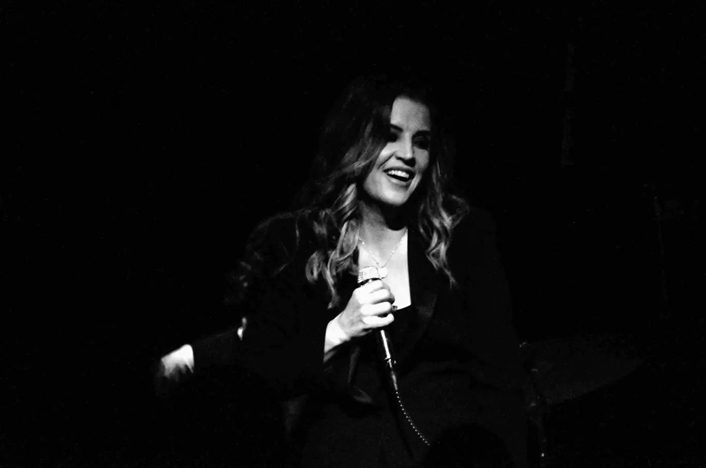
Photo courtesy Steven Cohen
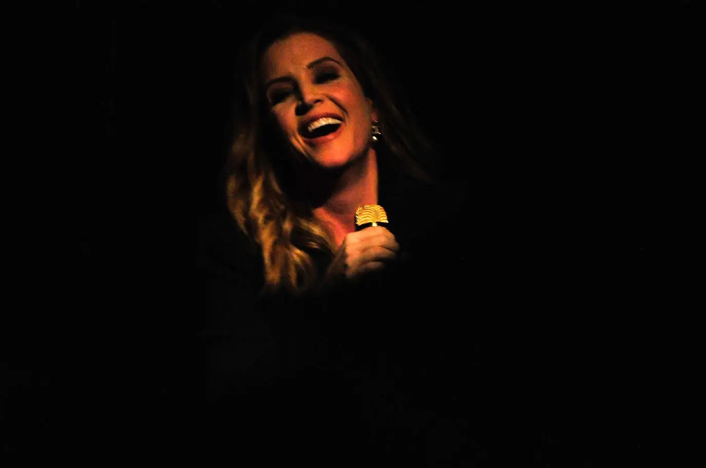
Photo courtesy Steven Cohen
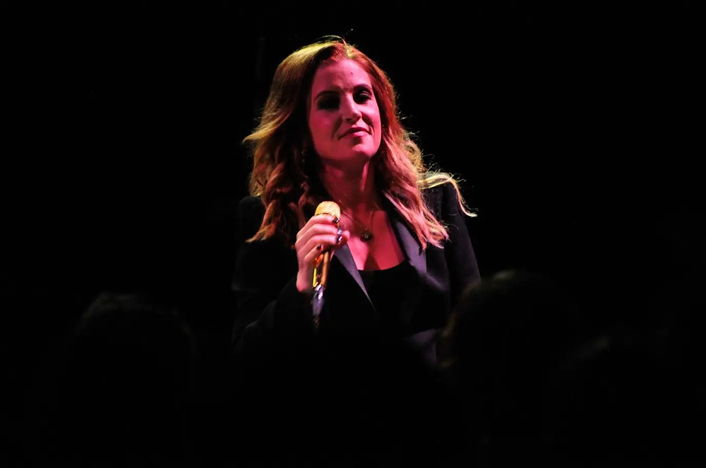
Photo courtesy Steven Cohen
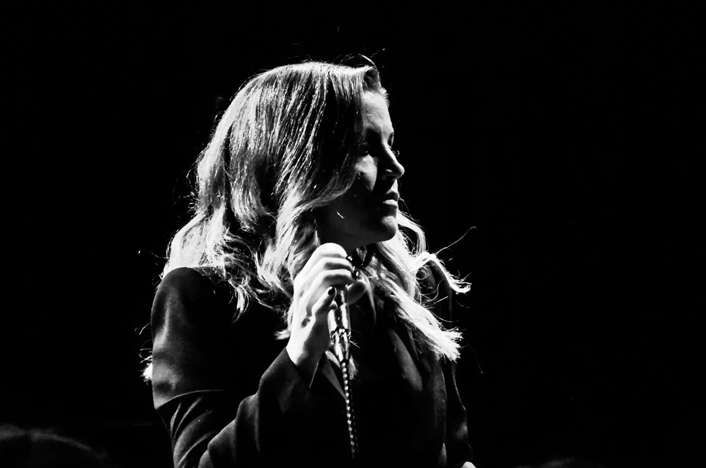
Photo courtesy Steven Cohen
2014
Lisa Marie was set to perform at the Dakota Jazz Club in Minneapolis on April 29 – 30, 2014. Tickets ranged from $50 to $200. The opening act was to be Grace Askew, who competed on Season 4 of NBC’s “The Voice. The promoters of the show announced that concertgoers would not be admitted if they were dressed like Elvis or one of Lisa Marie’s ex-husbands, Michael Jackson.
On April 28, 2014, Jon Bream announced that Lisa Marie’s U.S. tour, which was to begin at the Dakota, had been cancelled. She had just completed tours of Australia and Japan on April 10, 2014, and the cancellation was on doctor’s orders. The Dakota hoped to reschedule her for the next year, but there is no evidence that they ever did. Grace Askew honored her commitment and performed both days, with tickets at $7, but people who had tickets to Lisa Marie’s shows were admitted for free. (Minneapolis Star and Tribune, April 28, 2014)
Lisa Marie Presley passed away suddenly on January 12, 2023, from a heart attack she had at her home in Calabasas, California. She was 54.
DAVID CARROLL
Elvis was big, but there wasn’t enough of him to go around, so to fill the gap there were the Elvis impersonators. Early in his career there were scads of singers who tried to sound like the King, but that fad wore off eventually. Here in the ‘Cities, we had a flesh and blood Elvis replicant by the name of David Carroll.
David Carroll, nee Carroll Bernard Bateman, was born in East Grand Forks, Minnesota in 1938. A profile written by Dan Heilman in 1992 said that Bateman saw Elvis’s 1956 show, and started playing rock ‘n’ roll in 1962 with local bands such as the Wanderers and the Untouchables. He developed his Elvis Presley stage act in 1970 and had maintained the same band since 1971. The first ads found him playing the Golden Fox in March 1972.
On August 13, 1972, Carroll made his big debut at the Minneapolis Auditorium with a definite mixture of bands:
- The Whole Earth Rainbow Band
- Teen King and the Princes
- The Magic Touch
- The Silhouettes
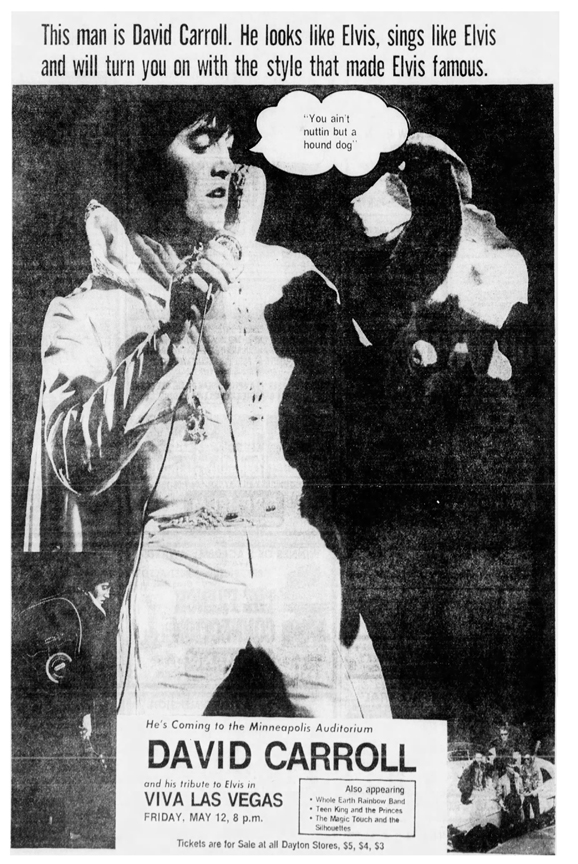
Minneapolis Tribune, April 23, 1972
He looks a little skinny to be Elvis here, but he probably filled out over his over three decade long career. The last ad found for him was on August 13, 2004, at the Medina. In 2005, Bateman received a Minnesota Rock & Country Hall of Fame Achievement Award.
Save
Herb Pilhofer, a native German who had arrived in Minneapolis around 1954, led a trio at Herb’s at 324 Marquette Ave., off and on, from 1955 to 1961. For several years during the 1950s his group performed in the courtyard behind the Walker Art Center. In 1956 and ’57 his Octet was featured at these shows. Herb’s moved to 9th Street No. off Glenwood and in November 1963 the entertainment was the Herb Pilhofer Duo, with Ted Hughart on bass. Pilhofer’s Trio worked at the Bamboo Room in the White House in Golden Valley after they left Herb’s.
In 1963 Pilhofer became the musical director at the Guthrie Theater.
In an ad in the 1964 AFTRA Catalog, Herb Pilhofer is described as “Composer, arranger, conductor, pianist… Musical Director, Minnesota Theatre Company at the Tyrone Guthrie Theatre; musical consultant to Midwest advertising agencies… Advertising music; film scores; music for the theatre and dance; special events and special effect… Jazz, third-stream, traditional; orchestral, chamber, band and vocal music……………”
In 1967 the North Stars hockey team came to town, and at some early point, a team song was written by Herb Pilhofer and Dick Wilson, called “Go For a Goal, North Stars.” Arne Fogel gives us great background info: “That’s me singing on it. Dale Menten is probably there as well, and also a guy on many sessions at the time, Bruce Winther. Most prominent female voice on the disc is that of Joanie Knutson (Joanie Pilhofer at that time). We cut the song during one session, and were called in several days later to re-do it; the client could not hear the articulation of the ‘L’ at the end of the word ‘Goal’ (it sounded like ‘Go for a Go’). So, we did it again, and that’s why you can hear us seemingly ‘over-articulating’ the letter ‘L’ at the end of the word ‘Goal’… ” Just saw this for sale for $337.50, but you can Hear it Here.
In 1969, after working at Kay Bank, Tom Jung and Herb Pilhofer founded Sound 80 Studios.
Wikipedia does not have a page on Pilhofer, but a special search turns up several projects that Pilhofer has been involved in.
If you have any additional information, corrections, or photos, please contact me!
Save
This is something called the Hollow Skating Rink Band, St. Paul, 1907.
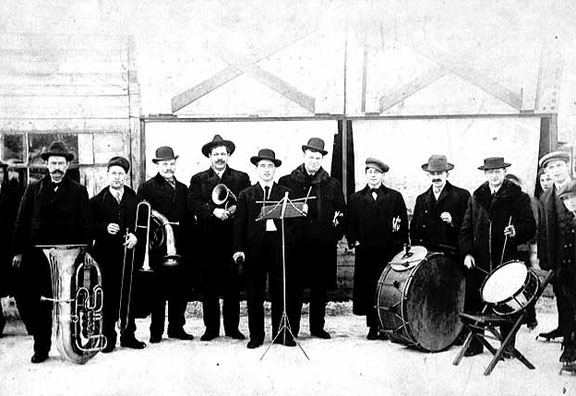
Minnesota Historical Society
This page is about John Denver’s early ties to Minnesota. Wikipedia says that he lived in Edina from 1968 to 1970, when he and his wife Annie moved to Aspen.
MITCHELL TRIO
Denver joined the Mitchell Trio in 1965, replacing the group’s namesake, Chad Mitchell. One correspondent remembers seeing him perform with the Mitchell Trio “(for $1) at a Monday night teen concert at Dayton’s eighth floor auditorium circa 1967-68 during my sophomore year in high school.”
As a member of the Mitchell Trio, Denver participated in a show at Northrop Auditorium on November 2, 1966, that also included Carolyn Hester and Godfrey Cambridge.
Denver appeared on the Mike Douglas Show in June 1967, one of many appearances to come. Neal Bond found the photo below on the Chad Mitchell Trio Facebook page! It may not be from the June 1967 appearance, but close enough!
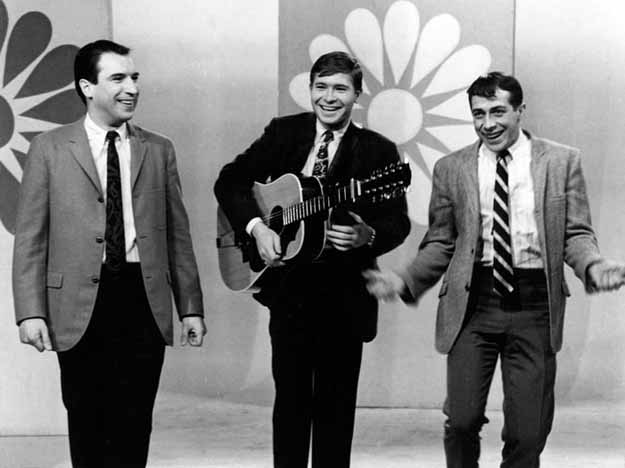
Photo courtesy Chad Mitchell Trio Facebook Page
Denver left the Mitchell Trio in December 1968 and it broke up in 1969.
On May 11, 1969, Allan Holbert of the Minneapolis Tribune highlighted Denver in his “What’s Doing?” entertainment column.
SOLO
Denver had his first solo engagement at a night club in Aspen, Colorado. He started playing mostly colleges.
From May 12 to June 1, 1969, Denver played the Golliwog Lounge at the Sheraton Ritz Hotel.

On May 22, 1969, Minneapolis Star entertainment columnist Don Morrison gave Denver a glowing review of the Golliwog show.
ANNIE
John Denver fan Corrine Smith sent in some Minnesota-related excerpts from Denver’s memoir, Take Me Home, An Autobiography.” (Harmony Books, 1994)
John first met Annie (Ann Marie Martell) “in the spring of 1966. The Mitchell Trio had performed a concert at Gustavus Adolphus College in St. Peter, Minnesota, and afterward we were invited over to the Student Union, where there was a charity drive going on.” (p. 76) And he talks about talking with this girl named Annie who “filled me with wonder.”
They connected again “in the fall,” when “the trio came back to Minnesota to do a show in Mankato.” (p. 77)
Denver married Annie in her home town of St. Peter, Minnesota, on June 9, 1967.
THE EDINA CONNECTION
Annie said in a May 18, 1969, article in the Minneapolis Tribune that they spent their first year in Chicago, but he was gone so much that they moved back to the ‘Cities, “where I have so many friends going to school or teaching.”
Denver’s account in his memoir gave a bit of a different explanation of the move from Chicago to Edina:
Chicago just proved to be too expensive for Annie and me, and after a year we moved to Minneapolis, where we found a nicer place for less money. I think it says a lot about who we were then that we moved into a staid suburban development rather than a place near the university and its Sixties counter-cultural haunts. Someone coming from a folk group might have been expected to do otherwise. (p. 86)
By at least that time they were living in a new apartment building in Edina. It has been confirmed by the Hennepin County Library that he was listed in the phone book under his real name, H.J. Deutschendorf Jr., at the Brookside Court Apartments, in Edina. This is is literally around the corner from where I grew up! I was 12 in 1969. Wonder if I knew who John Denver was? Far Out!
SUNSHINE ON MY SHOULDERS
It is fairly substantiated that he wrote the song “Sunshine on my Shoulders” while living in Edina. Jon Bream of the Minneapolis StarTribune reported that Minnesota weather inspired the song. Denver told him, “It was one of those late-winter early-spring days. It was one of those cold, dreary days where everything is gray. Spring is in fact happening. That’s why the song is slow and melancholy.”
However, here is a story from Dave Swanson:
John’s in-laws the Martells lived not too far from us on Fish Pointe Road on Prior Lake. The neighbors were the Killebrews. The Killebrews had a tennis court behind their house and when John was in town he was often seen playing tennis with Harmon. He wrote “Sunshine on my Shoulders” while sitting on the dock on Prior Lake.
Wikipedia only says it was written in Minnesota. Here are some particulars about the song:
“Sunshine on My Shoulders” was first released on Denver’s LP “Poems, Prayers, and Promises” in 1971. The album version features an extra verse, not heard on the single. In addition to Denver’s wondering on if he had a day and a song in the second verse, Denver wonders if he had a tale, and a wish. The song ends with the words “Almost Always,” being held on until the song’s end.
When it was released as a single in 1973, it was remixed with the addition of strings and woodwinds. The single was originally the B-side of “I’d Rather Be a Cowboy,” released in August 1973. The song began to receive airplay on adult contemporary radio stations and was re-released as an A-side (with “Around and Around”) in January 1974. It entered the Billboard Hot 100 at number 90 on January 26, 1974, and moved into the number one spot nine weeks later, remaining at No. 1 for one week. The song also topped the adult contemporary chart for two weeks in 1974. Billboard ranked it as the No. 18 song for 1974.
The full length single mix with the second verse has been released on most of Denver’s hits compilations. There was even a 7″ release with the “short version” on one side and the “long version” on the other.
B S & T
An odd pairing was on July 29, 1969, when Denver opened for Blood, Sweat, and Tears.
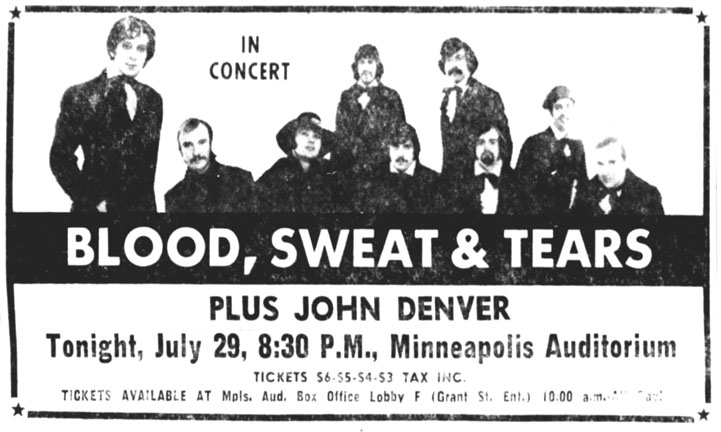
RHYMES AND REASONS
Denver’s album “Rhymes and Reasons” was released on August 31, 1969. This album included his version of “Leaving on a Jet Plane,” the song that Peter, Paul, and Mary had made famous. On most of his early publicity, he was identified as the songwriter of “Leaving on a Jet Plane.”
EDINA REVOLTS
On September 10, 1969, Denver appeared at Edina High School to perform for students who had walked out of classes. Patrick Boulay explains on the blog of the Edina Historical Society:
The school board, in an attempt to save money, was letting go teachers after they had been there long enough to get to the highest pay grade and then replacing them with cheaper new teachers. The coaches protested by not coaching practices of games. The football game that Friday had no faculty coaches present. Some former players who were over 21 volunteered to coach/supervise so the team wouldn’t have to forfeit.
About 1,200 students – approximately half of the student body – walked out in solidarity with the teachers and coaches; the walkout became a sit-in, and “they put us all in the gym.” Student Council President Kristin Carlander knew Denver and asked him to perform for the students. He was remembered to have said “I’d like to do a medley of my hit,” which was “Leaving on a Jet Plane,” which had entered the Billboard chart on October 25, 1969, stayed on the chart for 17 weeks, and was #1 for one week. The song had actually appeared on the trio’s 1967 album “1700.”
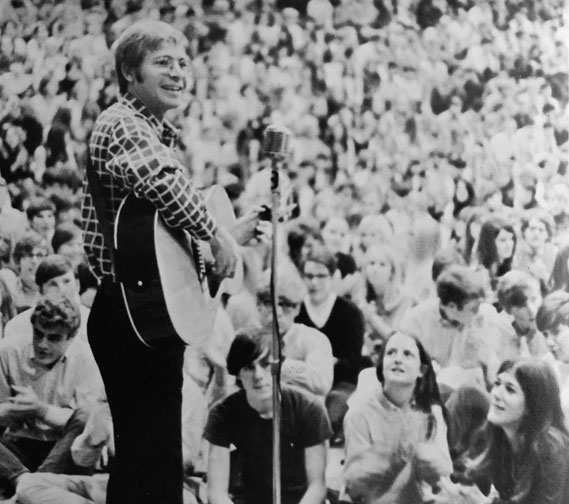
Photo of the sit-in performance, without a caption, appeared in the 1970 Edina yearbook, most likely taken by Boulay.
Denver appeared on Bill Carlson’s local TV show “This Must be the Place” the following Saturday night, September 13, 1969.
Denver was scheduled to appear on the Merv Griffin Show on October 3, 1969.
John Denver appeared at the Hamline University Fieldhouse on October 23, 1969.
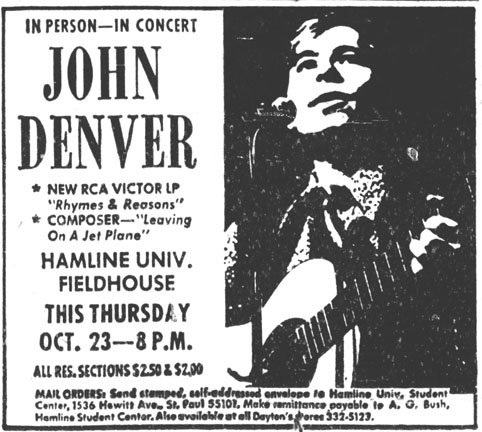
1970
This was a very transitional year for John Denver – he was doing a smattering of local and national talk shows, some national variety shows, but still a great number of college gigs in Minnesota.
On January 29, 1970, he appeared at Anoka High School’s Snow Days.
On March 1, 1970, he appeared with the Vogues at the Highland Arena at Mankato State College.
On March 8, 1970, he appeared at the Myrum Memorial Fieldhouse at Gustavus Aldolphus College in St. Peter, Minnesota.
On March 9, 1970, he appeared at Concordia College in St. Paul.
BILL AND NANCY
On June 13, 1970, Denver flew in from Washington, DC to be the soloist at the the wedding of local celebrities Bill Carlson and Nancy Nelson. Denver famously wrote the song “Follow Me” for the occasion. It always seemed a little incongruous to me, since both had big careers that don’t seem to jibe with the song’s lyrics, but that’s the story.
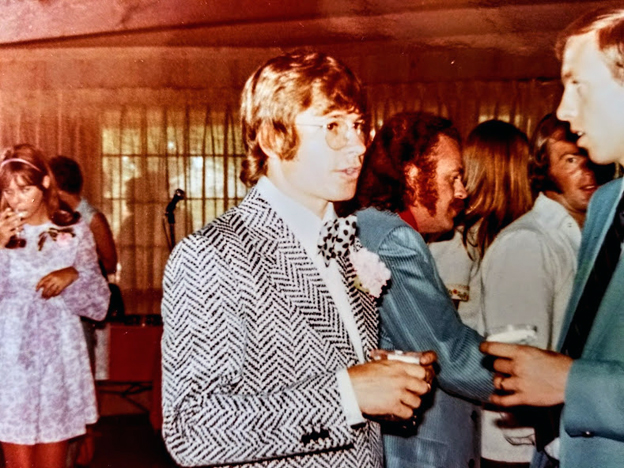
Denver at the wedding, courtesy Terry Larkin
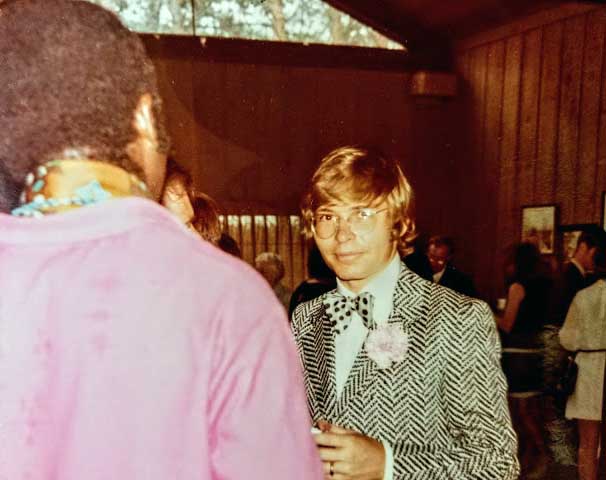
Courtesy Terry Larkin
CONCERT FOR PEACE
On August 9, 1970, Denver gave a “Concert for Peace” at the Guthrie. It was a benefit he did for the People’s Commission of Inquiry, a group of people going to Paris to help broker a peace agreement with the North Vietnamese. A review said that the overflow crowd was very receptive.
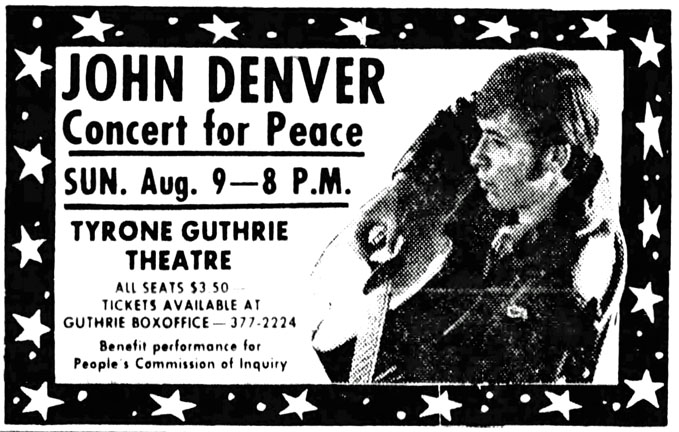
Minneapolis Tribune, August 2, 1970
BANK JINGLES
During these early days (in or before 1971), Denver wrote and recorded a couple of 60-second jingles for Northwestern National Bank, whose slogan was “May we Help you Today?” One is available on YouTube; words below. (Thanks, Steve Laboe!)
Oh I love the changing seasons
Green and growing all around
Smiling faces laughing children
Making such a joyful sound
In my dreams I see tomorrow
Time and children of my own
Someone who will stand beside me
Helping me to make ourselves a home
If your eyes can see tomorrow
Though it might seem far away
If you have some dreams to build on
May we help you today?
On September 16, 1970, Denver appeared on the Smothers Brothers Summer Show.
On November 19, 1970, a long interview by Peter Vaughan appeared in the Minneapolis Star.
On November 21, 1970, he was one of the entertainers at the Minneapolis Junior League Holiday Ball, held at the Radisson South. He was nervous, as this was not his usual kind of audience, but Margaret Morris of the Minneapolis Tribune reported that the crowd was “attentive” during his 40 minute performance. She also reported that he wore a gray and black Edwardian suit with a red carnation.
MOVE TO ASPEN
It is a little unclear when the Denvers moved to Aspen; as we see below, John was in Minnesota many times in 1971 for concerts, including benefits. One passage from his memoir may clear the matter up or muddy the waters:
It was Christmas 1970. Mountain promontories had always been part of the equation for us, and when the numbers for “Country Roads” kept growing, I figured we could afford our dream house. [When they couldn’t afford a house there, they were convinced to buy land instead and build a house later.] Just the land alone cost all the money we had at the time. We rented a place in town [presumably Aspen] and began to count the days. It was going to take another year before we could start to build. For 365 days, I fantasized about what living there was going to be like. (p. 106)
1971
On January 1, 1971, he appeared on an episode of “This is Tom Jones.”
On January 6, 1971, Wendell Anderson was inaugurated as Governor of Minnesota. Denver and Trini Lopez entertained 7,000 guests at the Governor’s Ball. At midnight, Denver led the crowd in a moving rendition of “America the Beautiful.” (Minneapolis Star, January 7, 1971)
On January 28, 1971, Denver performed at the Centennial Student Union Ballroom at Mankato State College.
On February 18, 1971, Denver performed at Northrop Auditorium as a benefit for Kevin Bauer, a University of Minnesota cheerleader who broke his neck during cheerleading practice on October 27, 1970.

Poster Imaged by Heritage Auctions, HA.com
On March 26, 1971, Denver participated in an event for Roger Goodall at the Macalester Field House. Also performing were the Rococo Band, the Sorry Muthas, and Mary Zimmerman.
Denver’s album “Poems, Prayers, and Promises” was released in April 1971. In addition to the title song, the LP includes “My Sweet Lady,” “Take Me Home, Country Roads,” and “Sunshine on my Shoulders.”
Still performing both locally and nationally, Denver performed at the Anoka Ramsey State Jr. College (now Anoka Ramsey Community College) in Coon Rapids on May 1, 1971.
Kenny Christensen tells this story:
My wife has worked for Anoka Ramsey Community College for 15 years. A year ago the college was celebrating an anniversary. They were pulling out various memorabilia from the past including concerts. My wife noticed that they had no record of John Denver having played there in 1971. She knew I had attended the concert, as I was a huge fan. They argued that John had never played there until she provided them with a copy of the ticket stub. I didn’t go to very many concerts, but when I did, I saved my ticket stubs and laminated them to my favorite album for the artist. Poems, Prayers, and Promises had just come out and I attached the stub to my album. The college included the ticket stub copy in their archives now.
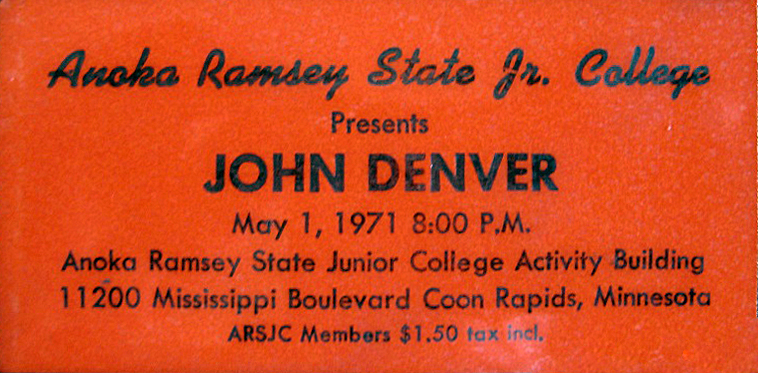
Image courtesy Kenny Christensen
On May 23, 1971, Denver and Peter Yarrow participated in a Dump the War Mass Peace Rally at the Met Center.
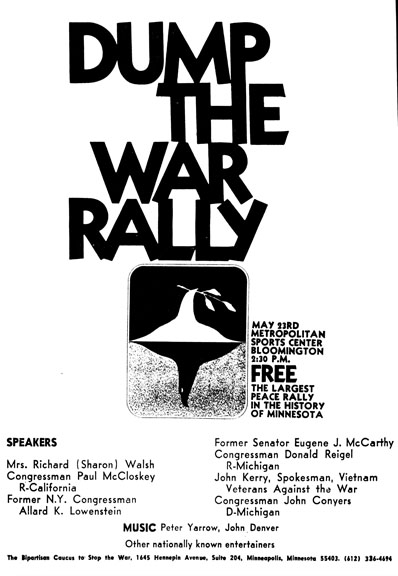
Minneapolis Tribune, May 16, 1971
The Guthrie scheduled two concerts on June 18 and 19, 1971, which sold out immediately. In response, they added another one on June 20, which sold out in three hours. The concerts were recorded, as Denver wanted to put out a live album, but apparently his record company resisted, and as far as I can tell, no live album from these sessions was ever issued.
In appreciation for the support given to him at the Guthrie concerts, Denver made a free appearance on Wednesday, June 23, 1971, at the Minneapolis Dayton’s 8th Floor Auditorium to meet his fans.
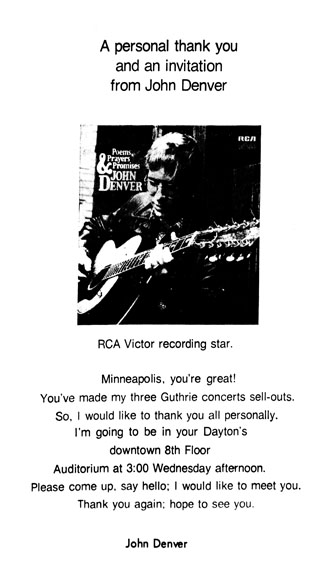
Minneapolis Star, June 22, 1971
On October 1, 1971, Denver appeared at the Benedicta Arts Center at St. Benedict’s College in St. Joseph, Minnesota.
John Denver performed many, many concerts in the Twin Cities before his untimely death in 1997 at the age of 53. Those are listed in the Events section of this site.
The Judd Group formed in Rochester in 1970. Steve McLoone was in the group from 1972-1978. Other original members include Tom Williams, Dave Williams, Dik Shopteau, Scooter Nelson, Bruce Judd, and Bryan Rossi. The band has an interesting history and track record playing with major acts; one was Bruce Springsteen at Mankato State before he was a big name. Members of the group have either written or performed or engineered or produced almost 200 records. The Judd Group was inducted into the Mid-America Music Hall of Fame in 2008.
STEVE MCLOONE
McLoone was born and raised in Waseca and played with The Sands of Tyme (horn band playing Chicago and Blood Sweat and Tears) and Cletus Hane. He then played in a group called Zero Ted from South Dakota with famous members like drummer Mark Craney (Jethro Tull, Gino Vanelli, Tower of Power, Jean Luc Ponty, etc.) and guitarist Mike Miller (Gino Vanelli, Yellow Jackets, Bette Midler, etc.)
McLoone has lived and raised all four of his children in St. Louis Park since 1981, all four graduating from SLP High School. Fun Fact: he lives in the house that Owen Husney grew-up and recorded his first solo album at Husney’s American Artists studio; one weekend he gave his studio time to an unknown Janet Jackson. He has worked on 15 records and 15 network commercials, and sang on the rendition of “We’re Gonna Win, Twins” that the Twins currently use. In 2006, McLoone was inducted into the Iowa Music Hall of Fame with the group Headstone.
Save
Described by one wag as “Dylan before Dylan,” Koerner, Ray, and Glover performed authentic roots music that remained true to its original flavor. The trio consisted of:
- “Spider” John Koerner
- Dave “Snaker” Ray
- Tony “Little Sun” Glover
Although all three were from Minneapolis, they first got together in New York City in the spring of 1962. On March 24, 1963, they recorded their seminal album “Blues, Rags & Hollers” in Milwaukee, produced by the trio and Paul Nelson, editor of the Little Sandy Review.
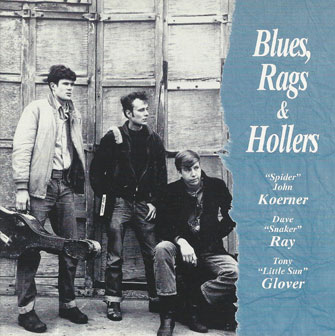
The album was first released in June 1963 on red vinyl on Audiophile Records, a “hobby label” owned by E.D. Nunn, the heir to Nunn-Bush Shoes. Only 600 copies were pressed. The album was reissued in November 1963 on Elektra Records with four of the original songs deleted. In February 1995 the album was reissued in CD by Red House Records, with the four deleted songs restored and the Elektra mono restored to stereo.
In June 1963 Will Jones notes: “They make a big point of going back to the true roots of folk music and a painfully detailed set of liner notes gives full credit whenever they have borrowed material and ideas from such heroes as Leadbelly and Blind Lemon Jefferson.” “Just for laughs” Jones said he liked to compare the album to something called “Folk Tunes Swingin’ Band Style” with Tony Martell and his orchestra doing “Greensleeves,” “Mary Ann,” “Buffalo Gal,” and “Scarlet Ribbons” with a smooth ’40s big-dance-band sound. “That, too, is folk music, folks. The contrast is startling, to say the least, and either extreme is preferable to the middle ground described in the Koerner-Ray-Glover liner notes: ‘Half-baked pop adaptations being palmed off as real folk music.'”
The original album was followed up with “Lots More Blues, Rags and Hollers,” recorded in September 1963.
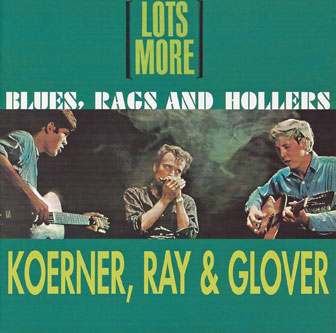
There has been much written about this treasured and unique part of Twin Cities music history, and I won’t try to reinvent the wheel here. Together or individually, these men have influenced many, many local and national musicians.
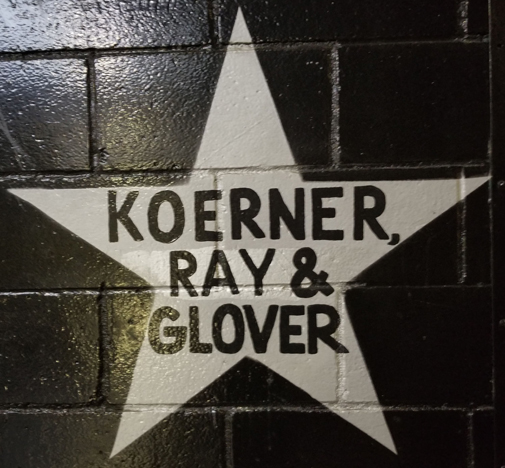
1974
THE RECORDING
In September 1974, Bob Dylan recorded the tracks for his album “Blood on the Tracks” in New York. During a visit home to Minneapolis, he was convinced that some of them needed to be redone, so his brother David assembled a group of local musicians.
Those musicians were:
- Bill Berg – Drums
- Gregg Inhofer – Piano and organ
- Kevin Odegard – Guitar
- Peter Ostroushko – Mandolin
- Billy Peterson – Bass
- Chris Weber – Guitar
On Friday, December 27, 1974, the group met at Sound 80 Studios with engineer Paul Martinson, and recorded “Idiot Wind” and “You’re a Big Girl Now.”
On the following Monday night, December 30, they returned to record “Tangled up in Blue,” “Lily, Rosemary, and the Jack of Hearts,” and “If You See Her, Say Hello.”
The drawing below depicts Dylan rehearsing “Lily, Rosemary, and the Jack of Hearts” with the band on December 30, 1974. The sketch is by drummer Bill Berg, who went on to become a Disney animator, animating 19 lead characters for the studio.
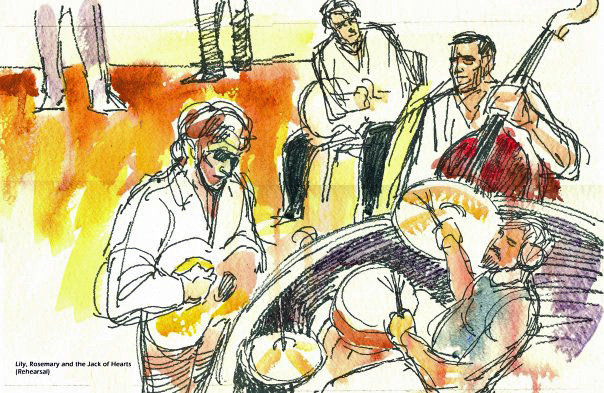
Image courtesy Kevin Odegard
1975
THE ALBUM
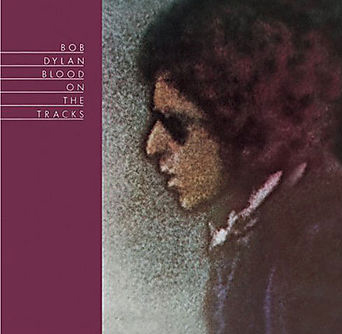
The record was released in the U.S. on January 20, 1975. It reached No. 1 on the Billboard charts and the single “Tangled Up in Blue” reached No. 31 on the Billboard Hot 100 singles chart. The album remains one of Dylan’s best-selling studio releases, going double-platinum. In 2015 it was inducted into the Grammy Hall of Fame.
The Minneapolis musicians were not listed on the record jacket. Initially they were told that thousands had already been printed up, but the error would be rectified on subsequent re-pressings. It never was. It was explained to me that the issue was not royalties – these were session players who were paid Union scale for their work. But once a record hits, others want to use the same studio, the same engineer, the same microphones, and most of all, the same musicians. The label’s refusal to identify these talented musicians, attributing the entire album to the New York musicians, was a frustrating and perplexing move that lasted for 44 years.
REUNIONS
The Blood on the Tracks Studio Band has reunited several times:
2001
The Million Dollar Bash commemorated Dylan’s 60th birthday at First Avenue on May 23, 2001. The show was the brainchild of community activist/songwriter Paul Metsa, and put together by First Avenue’s Nathan Kranz.
Five of the six Minnesota musicians performed together for the first time since the 1974 sessions.
View Kevin’s rendition of “Tangled Up in Blue” from that show Here.
Scores of special guest joined them. Sherwin Linton remembers singing “Boots of Spanish Leather” and “A Hard Rain’s Gonna Fall.”
Paul Metsa remembers that “Dylan’s childhood buddy Larry Kegan invited Bob down, telling him it was a cool scene (Bob was staying at his farm west of town) but it rained liked hell so he didn’t make it. Imagine if he did!”

Chris Weber, Kevin Odegard, Peter Ostroushko, Billy Peterson at First Avenue in 2001
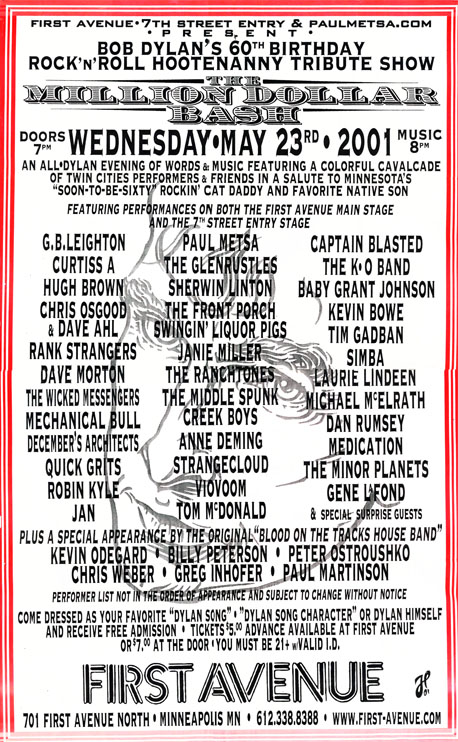
2001 Show poster by Johnny Hanson
2004
On March 3, 2004, Bill Berg joined the troupe for a sold-out encore at the Pantages Theater in Minneapolis. It was the only performance where all six original members of the band were present. I was one of the lucky 1,014 fans that night!
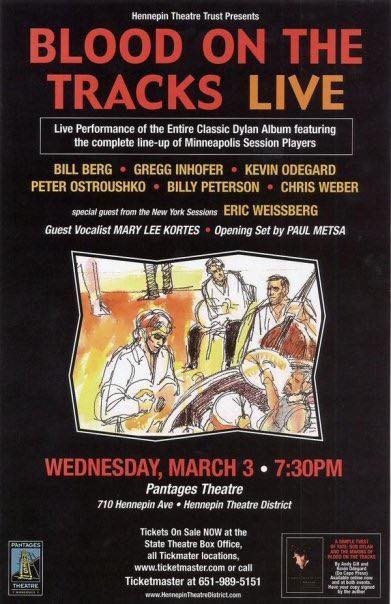
Songs were sung in the order of the album; two are available online:
- Tangled Up in Blue: Gregg Inhofer
- A Simple Twist of Fate: Kevin Odegard
- You’re a Big Girl Now: Mary Lee Kortes
- Idiot Wind: Adam Levy
- You’re Gonna Make Me Lonesome When You Go: Eric Weissberg
- Meet Me in the Morning: Pat Hayes
- Lily, Rosemary, and the Jack of Hearts: Martin Devaney (with some hilarious assistance with cue cards from Marc Percansky ala “Subterranean Homesick Blues” that turned out to be fun but unnecessary to Devaney, who never missed a beat or a line)
- If You See Her, Say Hello: Chris Weber
- Shelter From the Storm: Sherwin Linton
- Buckets of Rain: Mary Lee Kortes
Martin Devaney also did a knockout job on the harmonica throughout the show.
On March 7, 2004, Star Tribune music editor Jon Bream wrote his review of the show:
A performance by Bob Dylan’s uncredited 1974 Minneapolis sidemen put the emphasis on the musicianship, the songs and the spirit. The rhythm section of Bill Berg and Billy Peterson was superb; solos by mandolinist Peter Ostroushko and guest harmonica player Martin Devaney stood out, and Marc Percansky, a chip off the old Bob, provided perfect levity with flash cards of key lyrics to “Lily, Rosemary and the Jack of Hearts.” Best of show: Adam Levy’s blistering “Idiot Wind.”
2005
On May 7, 2005, the Blood on the Tracks Studio Band was inducted into the Minnesota Rock/Country Hall of Fame (now the Mid-America Music Hall of Fame) in 2005.
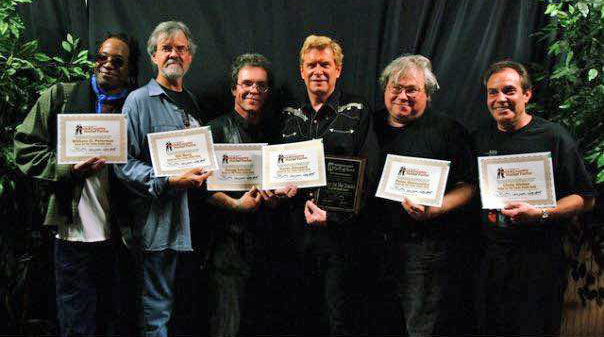
Photo courtesy Kevin Odegard
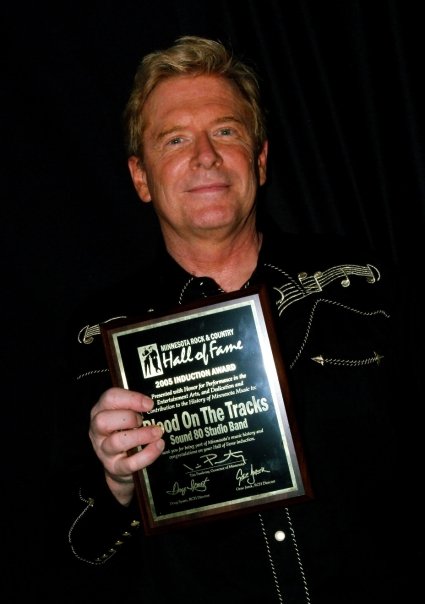
Photo courtesy Kevin Odegard
Also in 2005, British journalist Andy Gill and Kevin Odegard co-authored the successful book A Simple Twist of Fate: Bob Dylan and The Making of Blood On The Tracks. The book provides a blow-by-blow description of what went on during those two sessions at the Sound 80 Recording Studio.
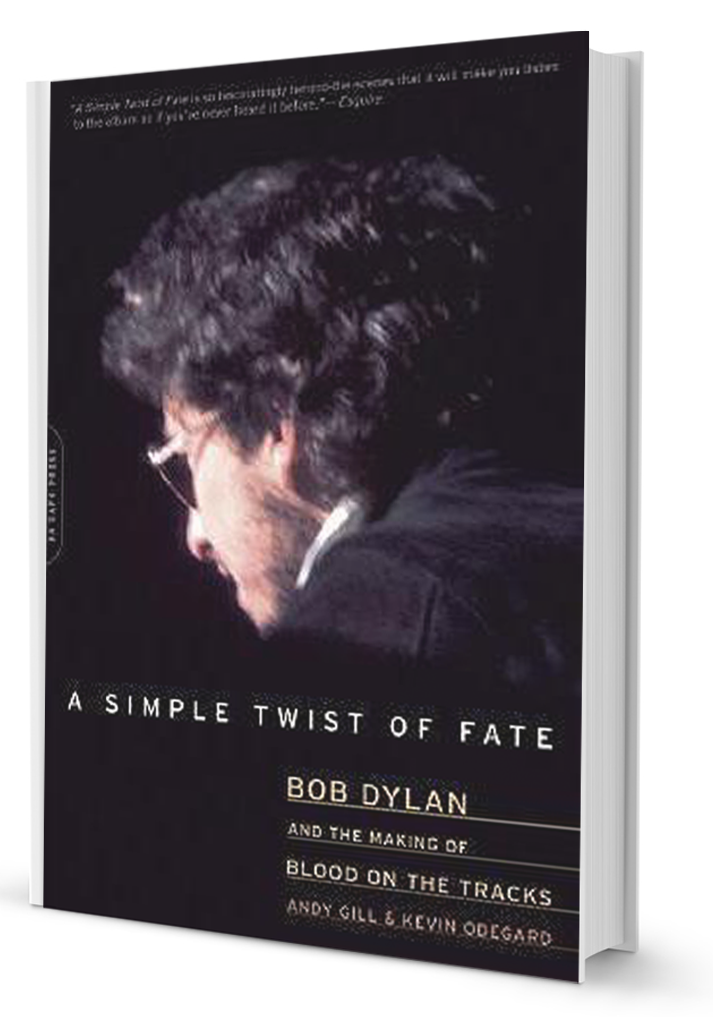
On August 14, 2005, Blood on the Tracks Live was inducted into the St. Cloud Hall of Fame, in conjunction with an exhibit of Minnesota music at the Stearns County History Museum.
2006
On May 27, 2006, Blood on the Tracks Live performed at Hibbing High School in conjunction with Hibbing’s annual Dylan Days. Musicians included Stan Kipper, Billy Peterson, Gregg Inhofer, Kevin Odegard, Bill Berg, and Peter Ostroushko.
The photos below come courtesy of Nelson French:
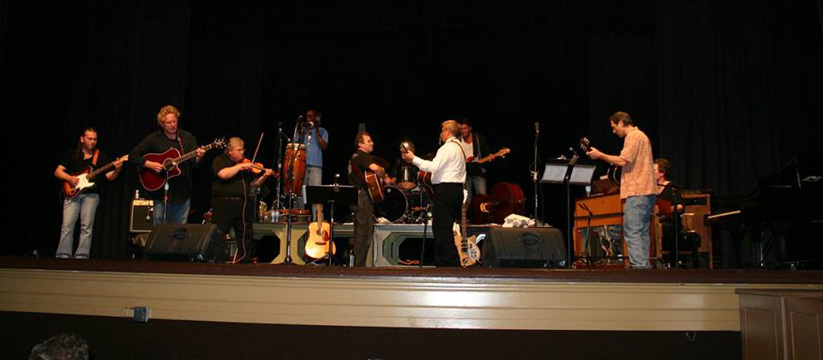
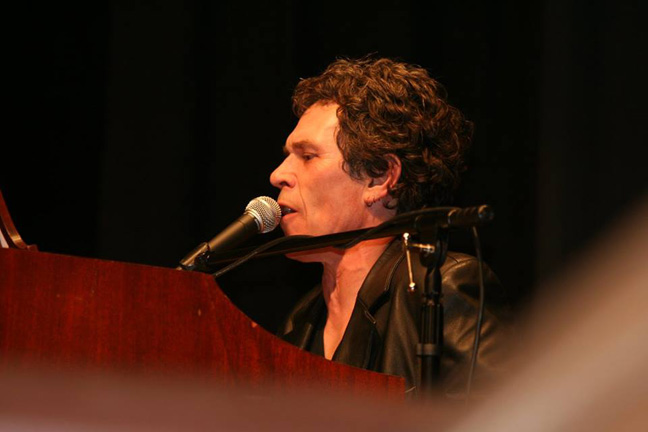
Gregg Inhofer
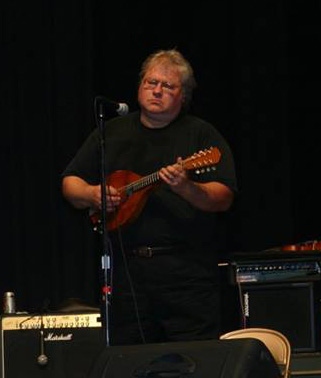
Peter Ostroushko
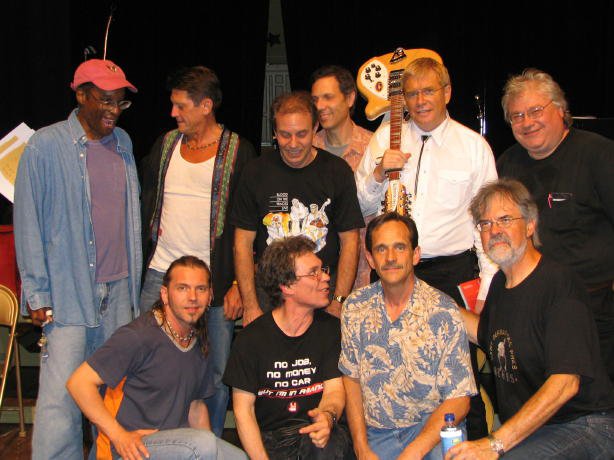
Musicians at 2006 Dylan Days in Hibbing – photo courtesy Kevin Odegard
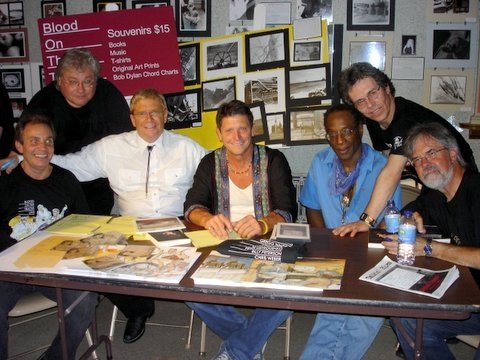
Chris Weber, Peter Ostroushko, Billy Peterson, Stan Kipper, Gregg Inhofer and Bill Berg at the autograph table in Hibbing, 2006. Photo courtesy Kevin Odegard
2008
On November 22, 2008, there was a performance at the St. Paul Jewish Community Center, which included a spoken appreciation by noted songwriter Dan Wilson. Photo below courtesy Kevin Odegard.
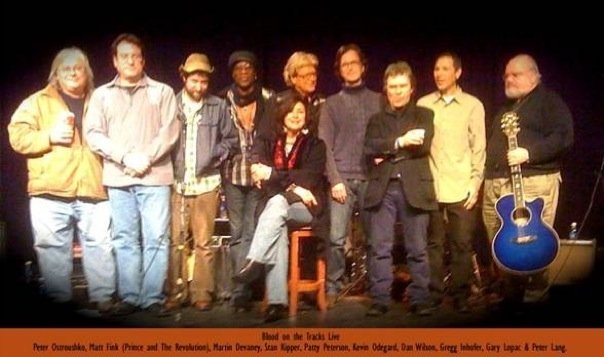
On December 19, 2008, the group performed at a Holiday Jam at e.p. atelier, an arts-driven downtown collective.
Pictured below are Jeff Boday Christiansen, Scott Dercks, Kevin Odegard, Javier Trejo, Stan Kipper, Larry Seuss. Kneeling: Mark Chico Perez, Gary Lopac. Not shown: Brian Van Tassel, and organizers Shar Kanan & Diane Ingram.
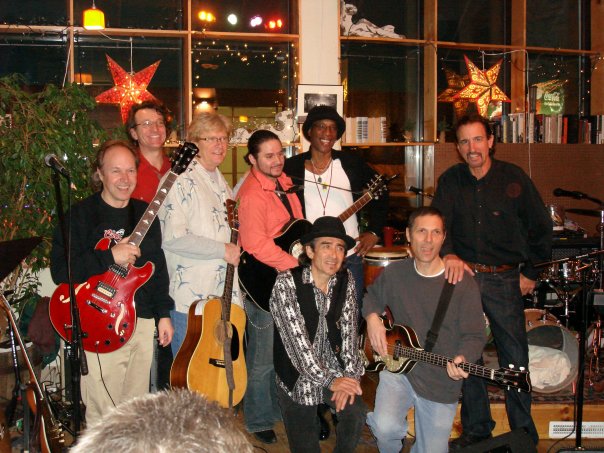
Photo courtesy Kevin Odegard
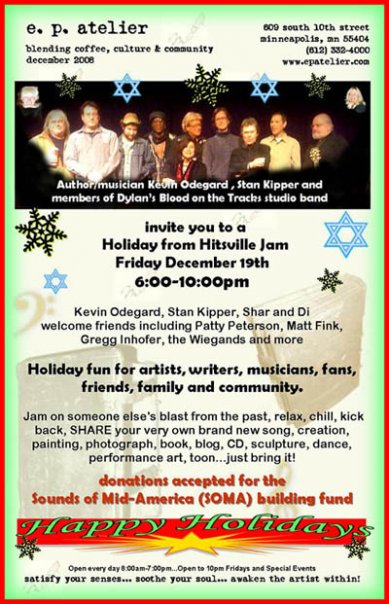
2008 Holiday Jam Poster courtesy Diane Ingram
FREE SHOWS AT THE ST. LOUIS PARK VETERANS AMPHITHEATER
2009
On July 1, 2009, Kevin Odegard initiated a “Blood on the Tracks Live” show at the Veterans’ Amphitheater in St. Louis Park, joined by fellow album mates Billy Peterson, Gregg Inhofer, and Peter Ostroushko. Kevin remembers:
In the summer of 2008, recovering from a rough patch in my life, I wandered into Wolfe Park alone on an evening walk, hearing the sounds of live music emanating from the grassy bowl of Veterans Memorial Amphitheater. At that moment I felt a new spiritual strength returning to my heart, and set out to test the waters for another round of Blood on the Tracks Live gigs.
Press Release:
The St. Louis Park Summer Concert Series presents a once-in-a-lifetime event featuring local musicians who have achieved national recognition. THE KO BAND SUMMER JAM presents Blood on the Tracks Live, a Dylan tribute band fronted by members of Dylan’s 1974 studio band, headlining a 7 pm FREE outdoor concert at Wolfe Park Amphitheater.
Unlike any other tribute band, BLOOD ON THE TRACKS LIVE is fronted by Bob Dylan’s sidemen. Performing Dylan songs from throughout his incredible career, this ever-changing lineup blends the stories behind the classics with inspired performances. The seven founding members each played a role in recording Dylan’s bestselling 1975 Columbia Records album.
Since 2000, players have included:
- Eric Weissberg (“Deliverance”)
- Bill Berg
- Willard O. (Billy) Peterson (Steve Miller Band)
- Gregg Inhofer (Olivia Newton-John)
- Kevin Odegard (co-author, A Simple Twist Of Fate: Bob Dylan and The Making of Blood On The Tracks)
- Chris Weber
- Peter Ostroushko (Red House recording artist)
- Stan Kipper (Gypsy, Little Richard, Jay Ferguson)
- Marylee Kortes
- Adam Levy (Honey Dogs, Bunny Clogs)
- Pat Hayes (Lamont Cranston Blues Band)
- Sherwin Linton
- Gary Lopac
- Peter Lang
- Matt Fink (Prince & The Revolution)
- Martin Devaney
- Patty Peterson
- Javier Trejo
- Larry Seuss
- Chico Perez
- Scott Dercks
- Jeff “Boday” Christensen
- Brian Van Tassel
Scheduled to appear at this 2009 show are studio band members Kevin Odegard, Peter Ostrousko, Gregg Inhofer, and Billy Peterson. Also on the bill are Stan Kipper, Chico Perez, Larry Suess, Scott Dercks, Kevin Bowe, Dan Israel, Matt “Dr.” Fink from Prince and the Revolution, and special guests.
THE KO BAND SUMMER JAM Opening the show is the KO Band with Jeff Dayton and St. Louis Park native Bobby Z Rivkin. In 1975, just before St Louis Park-born brothers Bobby Z Rivkin and David Rivkin earned international acclaim, they collaborated on David’s debut as a producer on “Silver Lining,” the second album by Dylan sideman Kevin Odegard. The title song, written by David, triggered national radio airplay and media interest, and the group hit the road as The KO Band, with Bobby Z on drums and Glen Campbell’s future bandleader Jeff Dayton on guitar.
David Rivkin was associated with three major Twin Cities rock ‘n’ roll bands: the Chancellors, the High Spirits, and Stillroven. Later, he prospered – both locally and nationally – as a songwriter, session musician, record promoter, producer and engineer. Among the renowned recording artists David has produced are Leo Kottke, Fine Young Cannibals, Bodeans, and John Mayall. In addition to his extensive studio work with Prince, David’s greatest success came when he produced St. Louis Park resident Steven Greenberg’s Lipps Inc.’s worldwide smash hit “Funkytown.”
Bobby Z played drums for Prince and the Revolution from 1978 to 1987. Also a successful producer and songwriter, Bobby has worked with influential artists such as Boy George, Manhattan Transfer, Colin Hay (Men at Work), Jonny Lang, George Thorogood, Wendy and Lisa, Garrison Keillor, and others.
In 2008, Bobby and David were inducted into the Mid-America Music Hall of Fame.
This is a rare opportunity to hear these local musicians who achieved national success.
WATCH THE SHOW
This first show was recorded by St. Louis Park Community TV. It can be seen Here.
MAGIC MARC
The Master of Ceremonies for this 2009 – and every – show was “Magic Marc” Percansky. Forever young, the photo of Marc below is from 2014.
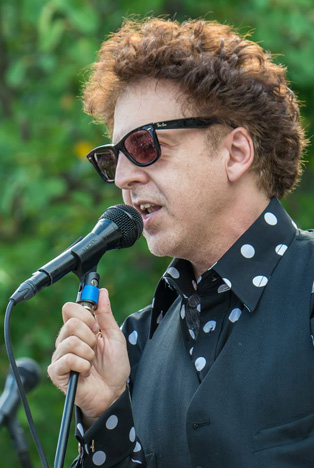
Photo courtesy Donald J. Olson
2010
Press Release:
Join us for a parade of hits from the homegrown musicians who played on Bob Dylan’s bestselling album 1975 album. The group is back for a second year at Wolfe Park, this time highlighting the songs of Dylan’s bestselling album “Blonde on Blonde.”
BLOOD ON THE TRACKS LIVE was formed in 1974 when Bob Dylan recorded his seminal album “Blood on the Tracks” in New York and then re-recorded five tracks in Minneapolis using local musicians. The story of the making of “Blood on the Tracks” is told in the book A Simple Twist of Fate: Bob Dylan and the Making of “Blood on the Tracks” by Andy Gill and Kevin Odegard.
Scheduled to appear in Blood on the Tracks Live on August 21 are original musicians Billy Peterson, Peter Ostroushko and Kevin Odegard, along with local-and nationally-respected artists Stan Kipper, Chico Perez, Matt Fink, Gary Lopac, Scott Dercks, Lonnie Knight, Scott Sansby, Jeff Dayton, Billy Hallquist, Paul Metsa, Peter Lang, Kevin Bowe, Alison Scott, Dan Israel, Patty Peterson, Gretchen Seichrist, Adam Levy, Jim Steinworth, and special guests.
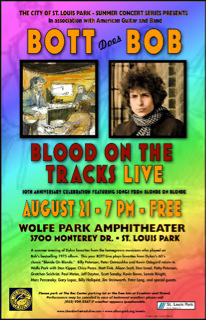
The 2010 Concert was recorded by St. Louis Park Community TV, and can be seen Here. Running time 3 hours, 10 minutes.
2011
For the third year in a row, Blood on the Tracks Live staged a tribute to the music of Bob Dylan at the Veterans Memorial Amphitheater in Wolfe Park, St. Louis Park. The concert was held on August 20. Due to the overwhelming popularity of the previous two years, a second show was added on August 17 at the Town Green in Maple Grove.
Throughout the years, numerous local musicians have joined “the family,” giving Blood on the Tracks Live a constantly changing look and sound. The group has evolved into a Dylan tribute band, not restricting artist song selections to any one album. Songs from “Blood on the Tracks” were performed, along with songs from many other albums and periods of Dylan’s career.
2011’s featured performer was Minnesota native Joyce Everson. During the 1970s, Joyce was discovered by Rod Stewart, released an album “Crazy Lady” on Warner Bros., added unforgettable harmonies to Jackson Browne’s masterpiece “Late For The Sky,” and performed on Saturday Night Live. Joyce made her first Twin Cities appearance in 20 years.
Also performing at one or both of the concerts were original studio musicians Kevin Odegard and Billy Peterson, musical director Matt Fink, Billy Hallquist, Stan Kipper, Chico Perez, Gary Lopac, Dan Israel, Paul Metsa, Patty Peterson, Scott Sansby, Mark Lamoine, Barry Thomas Goldberg, Gene LaFond, James Loney, The Unknown Idol (a man from the audience) and more. Marc Percansky was master of ceremonies at both evenings’ events.
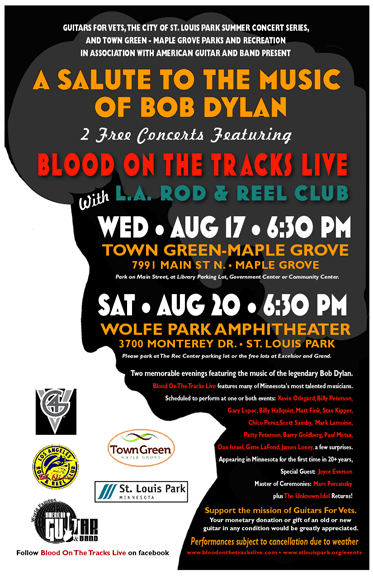
Opening the shows was the L.A. Rod and Reel Club, a band fronted by Odegard with long time collaborators Gary Lopac and Billy Hallquist. They performed a set of original material from their recently released CD “El Nino.”
The St. Louis Park show was part of the city’s Summer Concert Series and was held at the Veterans’ Memorial Amphitheater at Wolfe Park, 3700 Monterey Ave.
The Maple Grove show was presented by the City’s Parks and Recreation Department and was held at the Town Green, 7991 Main St N. The Town Green was a new urban park that provides a distinctive community gathering place with its main focus on the performing arts. The landmark feature of the park is the bandshell with a dramatic wing-like roof canopy located at the water’s edge. Seating for 300 is incorporated into a classic terraced bowl shape with ample space beyond for visitors to spread out and enjoy the park.
The St. Louis Park show was recorded by Park TV and can be seen Here. Running time 3 hours.
2012
Town Green (Maple Grove) and Veterans Memorial Amphitheater in Wolfe Park (St. Louis Park) again hosted free concerts featuring many of the area’s finest musicians performing an evening of songs by Presidential Medal of Freedom recipient and Minnesota native Bob Dylan.
This marked the fourth year in a row that Blood on the Tracks Live performed at the St. Louis Park venue and the second annual event in Maple Grove. Combined attendance in 2011 topped 5,000.
A reunion of the original session players in 2001 inspired the formation of Blood on the Tracks Live. In the decades since, the band evolved and expanded into its present configuration, which is an extremely dedicated and diverse collection of musicians who come together annually to perform “A Salute to the Music of Bob Dylan.”
Joining Odegard, the 2012 line up included many returning veterans of past shows: Bobby Z, Matt Fink, Patty Paterson, Billy Hallquist, Gary Lopac, Stan Kipper, Chico Perez, Lonnie Knight, Scott Sansby, Paul Metsa, Dan Israel, Barry Thomas Goldberg, Gene LaFond, James Loney, Jim Steinworth, Ralph Dacut, Steve Grossman, and Master of Ceremonies Marc Percansky.
Artists making their debut included Twin City Country Rock Legends the Daisy Dillman Band and Songstress Extraordinaire Mary Jane Alm, plus Kenny Krona, Aaron Ollswang, Barbara Meyer, Phil Berdahl, and Marc Partridge.
In 2012 Odegard handed the organizational reins to longtime friend and fellow musician Billy Hallquist, It was also the last year that Odegard, the last remaining member of the Blood on the Tracks band to be involved, left the group, and the event was renamed “Salute to the Music of Bob Dylan” in 2013.
The St. Louis Park show was recorded by Park TV and can be seen Here (Running time 3:38)
2013
Town Green (Maple Grove) and Veterans Memorial Amphitheater in Wolfe Park (St. Louis Park) again hosted free concerts featuring many of the area’s finest musicians performing an evening of songs by Presidential Medal of Freedom recipient and Minnesota native Bob Dylan.
This marked the fifth year in a row that Salute to the Music of Bob Dylan performed at the St. Louis Park venue and the third annual event in Maple Grove. Combined attendance in 2012 topped 6,000.
The 2013 line up included many returning veterans of past shows; Bandleader Billy Hallquist, Matt Fink, Patty Peterson, Mary Jane Alm, Jeff Dayton, Gary Lopac, Lonnie Knight, Scott Sansby, Stan Kipper, Chico Perez, Paul Metsa, Dan Israel, Gene LaFond, James Loney, Jim Steinworth, Ralph Dacut, Aaron Ollswang, Kenny Krona, Barbara Meyer, Steve Grossman, Jeff Victor, and Master of Ceremonies Marc Percansky.
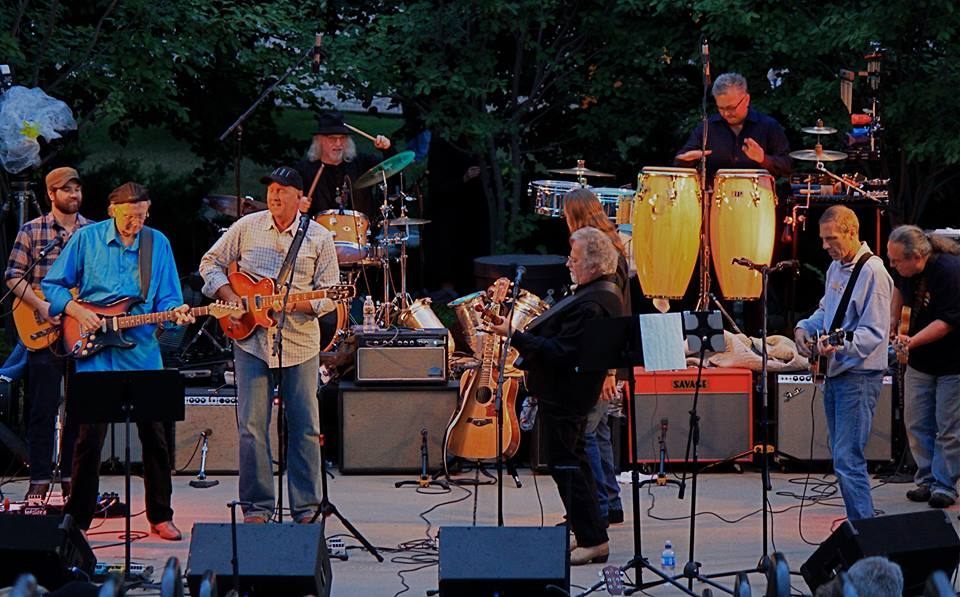
Artists making their Salute to the Music of Bob Dylan debut include Arne Fogel, Willie Walker, and Courtney Yasmineh.
As in previous shows, members of Salute to the Music of Bob Dylan performed a set of original material to kick off the evening.
Minnesota-born Thomas Page was also on hand to inform Dylan fans about his project to create and place a commemorative statue of Bob Dylan at a prominent site in his birthplace, Duluth.
The 2013 concerts were the first ones produced by Billy Hallquist.
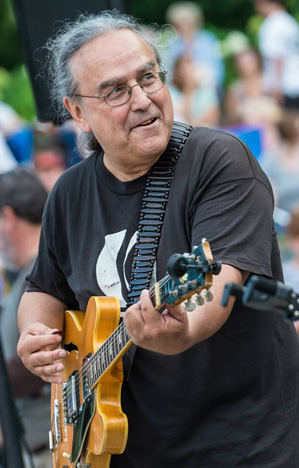
Photo of Billy Hallquist courtesy Donald J. Olson
The St. Louis Park concert can be seen Here. (Running time 3 hours, 38 minutes)
2014
Salute to the Music of Bob Dylan Welcomes Dylan Violinist, Scarlet Rivera
Town Green (Maple Grove) and Veterans Memorial Amphitheater in Wolfe Park (St. Louis Park) again hosted free concerts featuring many of the area’s finest musicians performing an evening of songs by Presidential Medal of Freedom recipient and Minnesota native Bob Dylan.
This marked the sixth year in a row that Salute to the Music of Bob Dylan (formerly Blood on the Tracks Live) performed at the St. Louis Park venue and the fourth annual event in Maple Grove. Every year these shows draw thousands of attendees.
The core band, consisting of leader Billy Hallquist, Matt Fink, Lonnie Knight, Gary Lopac, Stan Kipper, Chico Perez, Ralph Dacut, Jim Steinworth and Aaron Ollswang was joined by guests Patty Peterson, Gene LaFond, Barbara Meyer, James Loney with Edie Rae and Colleen O., Barry Thomas Goldberg, Arne Fogel, Dan Israel, Mark Lamoine, Kenny Krona and Steve Grossman. Keeping the watches wound and trains on time was Master of Ceremonies “Magic” Marc Percansky.
This conglomeration of talent boasts nearly 1,000 years of combined experience and 100,000+ performances.
A brief set of original material by Chrome Horse Diplomats preceded the Dylan Salute at each show.
SCARLET RIVERA
Making a special appearance was world-renowned violinist Scarlet Rivera. Scarlet burst on the scene when Dylan hired her to record and tour with him during the epic “Desire,” “Hard Rain,” Rolling Thunder Revue and Renaldo & Clara period. Since those heady days she has continued to perform and record solo and with a long line of “A-list” artists around the planet.
Scarlet worked with Salute to the Music of Bob Dylan last May at a benefit to restore the Historic Duluth Armory and made such an impression that inviting her to the Twin Cities events was inevitable.
The August 6 concert took place at Town Green, 7991 Main Street N., Maple Grove.
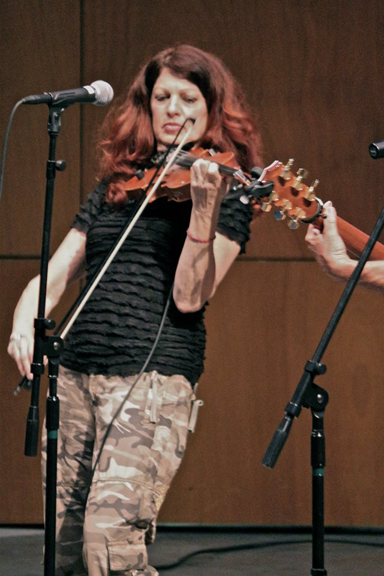
Scarlet at the Maple Grove show. Photo courtesy Neil Schloner
On August 9 the show moved to Veterans Memorial Amphitheater in Wolfe Park, 3700 Monterey Dr., St. Louis Park.
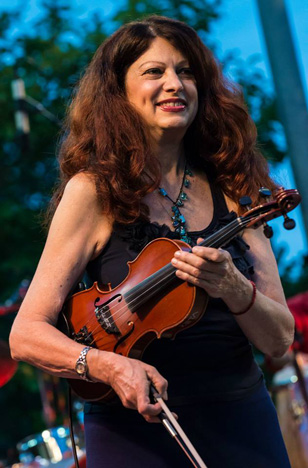
Photo courtesy Donald J. Olson
The highlight of the concerts was the song “Hurricane,” where Scarlet and Lonnie Knight went string-to-string in tour de force performances that sent chills down our spines.
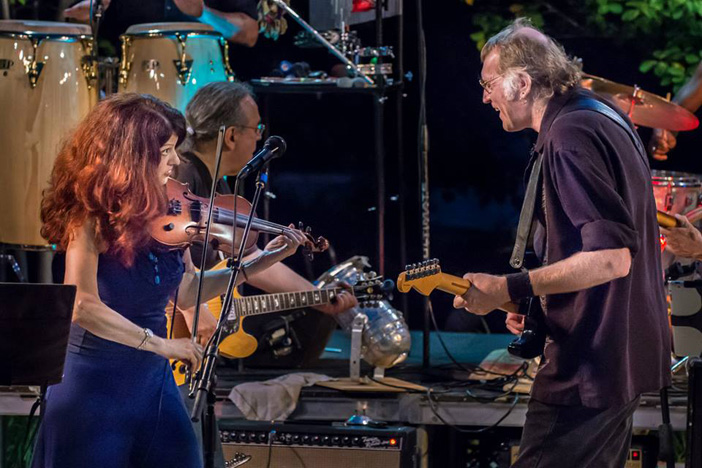
Photo courtesy Donald J. Olson
The St. Louis Park concert can be seen Here (Running time 3:19)
THE DAKOTA
An added treat was a concert on August 10, 2014, at the Dakota, featuring Scarlet Rivera backed by the “Salute to Bob Dylan” house band.
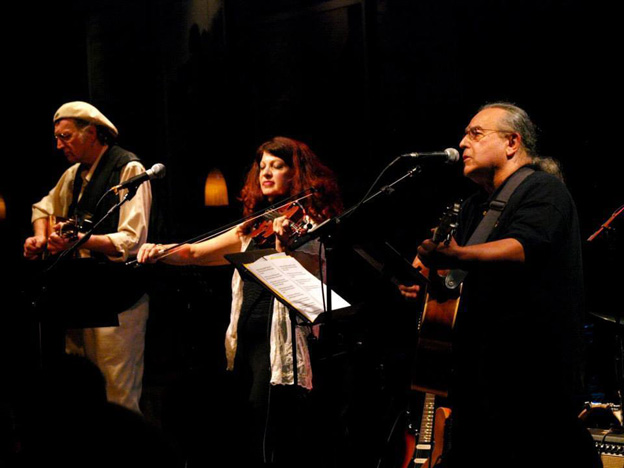
Lonnie Knight, Scarlet Rivera, Billy Hallquist at the Dakota. Photo courtesy Neil Schloner
2015
For the seventh year, some of the Twin Cities’ top musicians gathered for free outdoor concerts featuring the music of Presidential Medal of Freedom recipient and Minnesota native Bob Dylan. Each year’s events have evolved and grown, and this year was no different. This year featured a classic lineup of some of Bob’s best known songs to celebrate 15 years of honoring these uncredited but extremely talented musicians.
A TRIBUTE TO BILLY HALLQUIST
After a brief set of songs by Jeff Dayton, this year’s shows began with performances of original songs written by Billy Hallquist. Hallquist acted as organizer, bandleader, publicist, guitarist, and singer at these shows, and was the glue that holds them together. In late 2014 he was diagnosed with stage 4 colon cancer, and braced for a second fight for his life, having survived polio as a child.
Even while undergoing chemotherapy, he continued to organize the 2015 summer concerts, including two additional concerts featuring “Minnesota Legends” groups Jokers Wild, Thundertree, and the Litter.
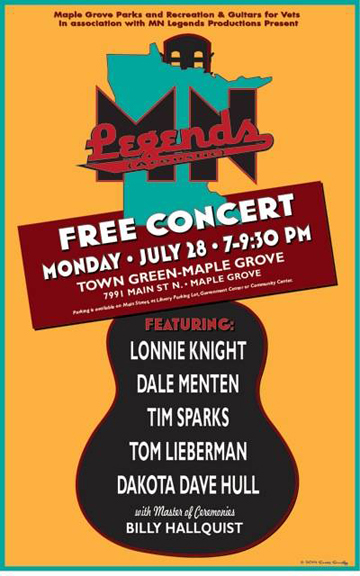
A fund was set up to offset some of Billy’s medical expenses, and donations were accepted at the Dylan concerts. Billy was a much-loved fixture in the Minnesota musical community; he was a member of Thundertree and the K.O. Band, and put out two of his own albums: “Persephone” and “Travelin’.” His son Dan was the producer of the 2015 Dylan concerts, and Odegard was back in the lineup.
The core band, consisting of Hallquist, Odegard, Gary Lopac, Jeff Dayton, Bobby ‘Z’ Rivkin, Scott Sansby, Lonnie Knight, Jim Steinworth, Aaron Ollswang, and Mark Lamoine were joined by Stan Kipper, Chico Perez, Matt Fink, Patty Peterson, Mary Jane Alm, Ralph Dacut, Kenny Krona, Dan Israel, Steve Grossman, Barbara Meyer, James Loney with Edie Rae and Colleen O, Barry Thomas Goldberg, Arne Fogel, John Pattison, Patrick Nettesheim, and Courtney Yasmineh. Master of Ceremonies was “Magic” Marc Percansky.
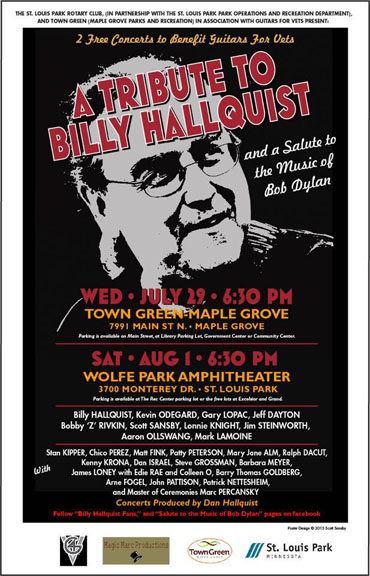
The St. Louis Park concert can be seen Here. (Running time 3 hours, 9 minutes)
Billy Hallquist died on October 12, 2015, and the concerts came to an end.
2017
We lost the brilliant Lonnie Knight on May 7, 2017, also from cancer.
SUMMER OF LOVE
Perhaps unwilling to give up those happy vibes, or wanting one last celebration, in 2017 Kevin Odegard organized a “Summer of Love” concert at the St. Louis Park amphitheater. Kevin wrote:
After a year’s hiatus, the Minnesota musicians who brought us the tributes to Bob Dylan for seven years are back for one final concert, saluting the 50th Anniversary of 1967’s Summer of Love.
It was a summer like none before or since, with unforgettable music coming from our radios, TV shows like “Shindig” and “Hullabaloo,” and the 12-string guitars of local bands, jingle-jangling the message of peace and love in a difficult time of unrest. St. Louis Park contributed musicians to local groups like the High Spirits, the Chancellors, the Avanties, and others who played as we danced at Mr. Lucky’s, the Barn, and right here at the Purple Cigar.
On July 29 at 6:30 in Wolfe Park, a bumper crop of Minnesota’s finest rock musicians re-imagines the hit songs and the joyful anthems of the flower power generation.
Kevin Odegard, leader of the Minneapolis band that backed five cuts on Bob Dylan’s seminal “Blood on the Tracks” album, is a co-producer of this, his final park concert. He marks it with a poignant, special suite written just for the occasion.
Fellow “Blood on the Tracks” alumnus, Americana music virtuoso Peter Ostroushko, returns to the Wolfe Park stage this summer. Ostroushko is nationally known for his appearances on “A Prairie Home Companion,” among his many other accomplishments.
The concert is co-produced by Odegard’s lifelong pal Stan Kipper, who has played with Chuck Berry, Little Richard, Jay “Thunder Island” Ferguson, and many of America’s greatest stars. Kipper says, “The concert this year will a perfect time to celebrate with family and friends. Reconnect with yourself, wear flowers, break out the bell bottoms and sandals, dance with your family and neighbors, sing along with us, and remember the days and fun times you had during the Summer of Love. It’s going to be the best night of the summer for the folks at Wolfe Park in SLP!”
Other musicians on the bill include Barbara Meyer, Gary Lopac, Aaron Ollswang, Jim Steinworth, New Primitives and fun surprise guest musicians. The MC is St. Louis Park’s Magic Marc Percansky.
“And we’ll tip the hat to Bob Dylan before it’s all over,” says Odegard, “with the help of a choir and ukulele club.”
Opening the show is Milwaukee’s Kharma Shotgun, the official band of Guitars for Vets charity. The band also acknowledges the loss of core member and guitar player extraordinaire, Lonnie Knight, with a rendition of Leonard Cohen’s “Hallelujah.”
This year’s show is rain or shine, thanks to the completion of the sheltered ROC, St. Louis Park’s new covered facility adjacent to Wolfe Park.
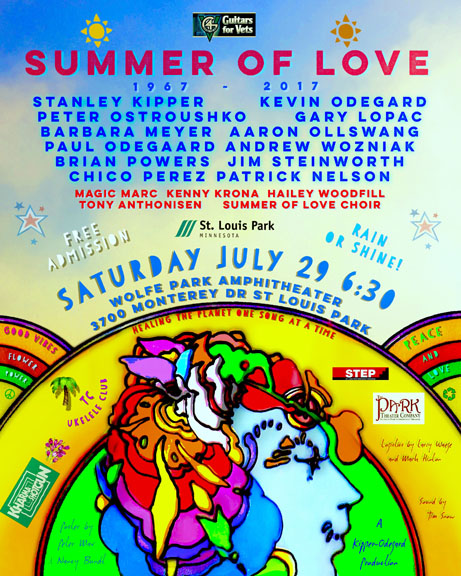

Photo courtesy Donald J. Olson
The concert can be viewed Here (Running time: 2 hours, 47 minutes)
GUITARS FOR VETS
In 2010 the show began to raise support and awareness of Guitars for Vets, a national organization dedicated to serving veterans who face challenges due to post traumatic stress disorder and traumatic brain injury. Participants receive basic music instruction and, upon completion of the program, a guitar of their own. Cash donations and guitars are collected at the concerts for the G4V organization, and G4V merchandise is for sale as well. According to longtime stage manager Marc Percansky, our efforts over the years totaled $35,000 in donations.
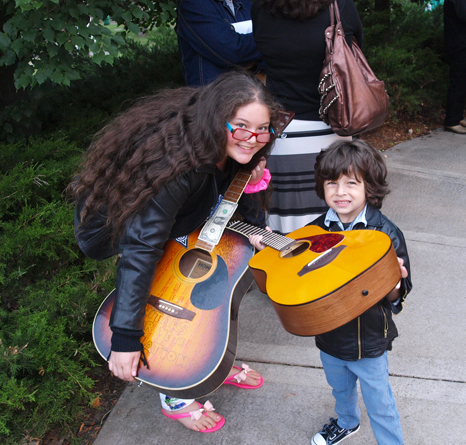
Basha Goldwater and Abe Percansky-Segal collect donations in guitars at the 2013 St. Louis Park show. Photo courtesy Neil Schloner
KEVIN SUMS UP THE CONCERTS
Over seven years, we included four of the six Minnesota musicians in performances that went far beyond the five songs we’d recorded at Sound 80 all those years ago. Unforgettable performances by Patty Peterson, Paul Metsa, an “Unknown Idol” plucked from the audience (the late John Pattison), Peter Ostroushko, Mary Jane Alm, Jeff Victor, Dan Israel, Stan Kipper, Barbara Meyer, Steve Grossman, Jeff Dayton, Gary Lopac and a ragged outfit called Dirt Farmers. On keyboards much of the time was Matt Fink of the Revolution. Bobby Z showed up twice to play with his first band mates. Best of all, the community of St Louis Park supported us and a corps of volunteers led by Jeanne Andersen showed up year after year for our homespun crusade.
You may be interested in visiting Kevin’s YouTube page, Here.
MY STORY
I also have to tell this story. I met Kevin Odegard through Joe, our mutual hairdresser. Kevin had this idea to use the St. Louis Park amphitheater, and Joe knew I had connections within St. Louis Park and I was into music. So Kevin and I had a meeting and he handed me a press release he had written, announcing that the KO Band was getting back together, and by the way, after that would be the Blood on the Tracks Studio Band. Well, I had listened to BOTT incessantly in the ’80s, been to the show at the Pantages, saw them inducted into the Rock/Country Hall of Fame, and knew what a big deal they were, and yelled at my new friend that nobody cared about the KO Band – BOTT was the draw here! Nevertheless I was skeptical, since I’d never seen more than 30 people at the Amphitheater.
Well, I turned the press release around and contacted the person at the city, who wanted to know where she could hear them play. Lady!! I finally explained it to her, and papered the papers with releases. My friend Seth Rowe at the St. Louis Park Sun-Sailor was so wonderful at spreading the news, and it must have made the Strib as well. When the day came, I put signs out in case people didn’t know where to park, and I was so nervous! I sat in the back with Park TV cameraman John McHugh and watched the place fill up, with wonderment. It was at capacity, as it was every single year, even the year it was raining! We did it! Well, I didn’t do anything – I can’t sing or play a note. All these years later I still get my hair done by Joe in gratitude for introducing me to Kevin!
Jeanne
Thanks due to Kevin Odegard, Marc Percansky, and to Park TV, for recording these wonderful concerts. They were always the highlight of my summers.
2018
ABOUT THOSE CREDITS…
Kevin:
My 2004 book about those long-ago sessions had set the stage to ignite a campaign to correct the historical record, a campaign which would see the names of all six uncredited Minnesota musicians who had played on the now-classic Bob Dylan album, considered by some to be a masterpiece. It took a full decade for this to happen, and happen it did on November 2, 2018, with the release of “More Blood, More Tracks” on Columbia Legacy Records.
What Kevin doesn’t say is that there were some false starts, where journalists butchered their names or messed up other details. In addition, “More Blood, More Tracks” comes in three formats, and only one includes the Minnesota Musicians’ names. You must buy the six-CD set, which runs at a little over $100 (down from the original $165) in order to find their names, which are on page 56. Just a list, no explanation of why they weren’t there before. But such a thing does exist, no doubt due to Kevin’s persistence.
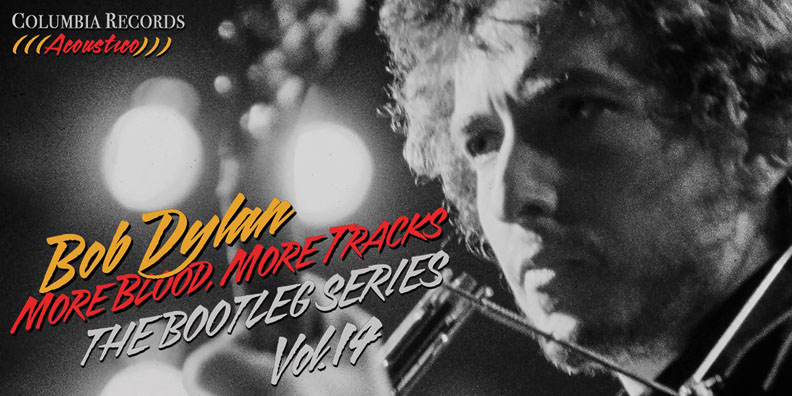
THE METSA INTERVIEWS
On the occasion of the release of the box set, Paul Metsa conducted four interviews with members of the band on his Tower of Power TV show. These episodes are available on YouTube:
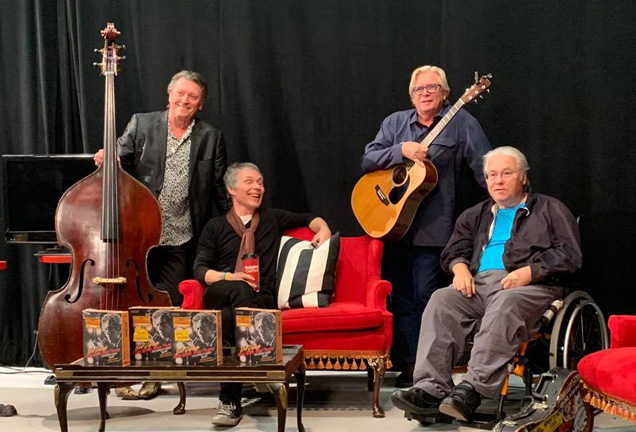
Billy Peterson, Gregg Inhofer, Kevin Odegard, and Peter Ostroushko on the Wall of Power. Photo courtesy Kevin Odegard.
2021
Two of the original Minneapolis Blood on the Tracks studio musicians passed away in 2021.
Chris Weber died on January 27, 2021, in Concord, California, of complications of COPD at the age of 73.
Peter Ostroushko died on February 24, 2021, in Minneapolis, of heart failure. He had had a debilitating stroke at the beginning of 2018.
BOB DYLAN’S 80TH BIRTHDAY BASH
On the evening of Bob Dylan’s 80th birthday, May 24, 2021, a celebration was held at First Avenue, similar to the concerts that had been held in St. Louis Park and Maple Grove. A core band of Minnesota’s best musicians, dubbed the “St. Louis Park Wrecking Crew,” was assembled: (All photos courtesy Jeff Taube, MidAmerica Talent)
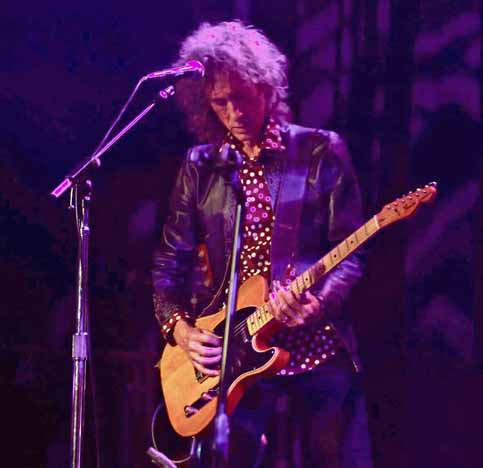
Steve Brantseg, Guitar
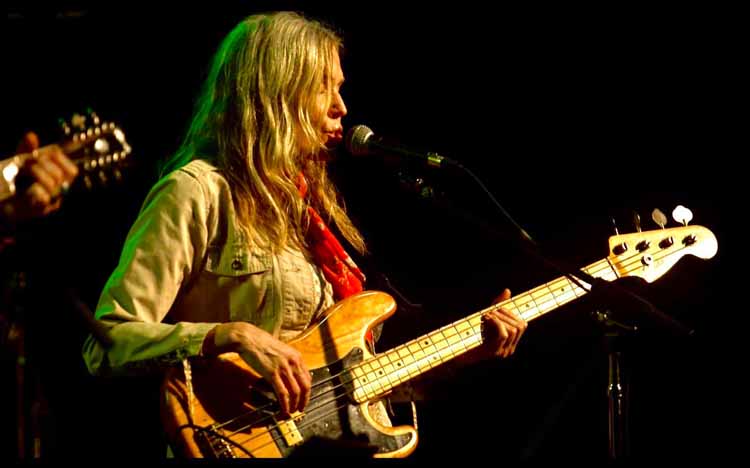
Barb Brynstad, Bass
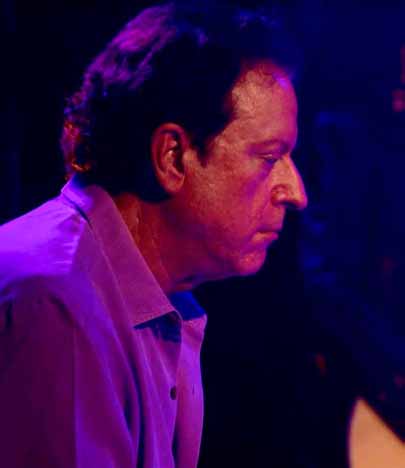
Matt Fink, Piano
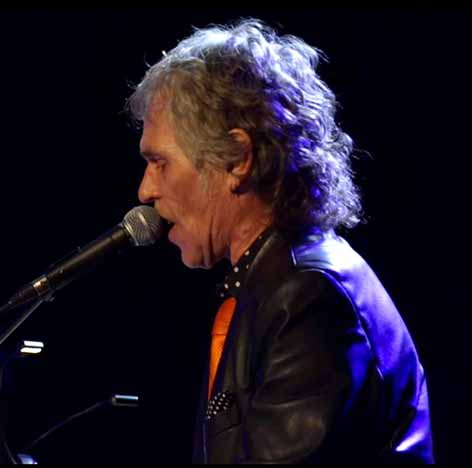
Gregg Inhofer, Organ
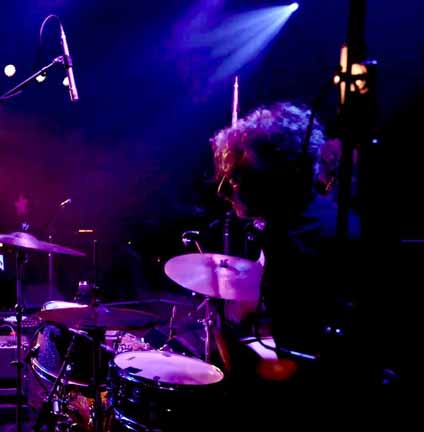
Noah Levy, Drums
Guest singer/performers included:
- Dan Israel
- Curtiss A
- Demitri Rallis and Joe Dunn
- Terry Walsh
- Courtney Yasmineh
- Lynhal Jackson
- Mary Bue
- Gini Dodds
- Becky Kappel
A highlight of the show was when Billy Peterson joined the band while Gregg Inhofer sang and played “Tangled Up In Blue.” Billy was the original bass player on the Minneapolis sides of “Blood on the Tracks.” Gregg played during the entire night, just as he was the only one of the musicians to play (piano and organ) on all of the five songs on “Blood on the Tracks.”
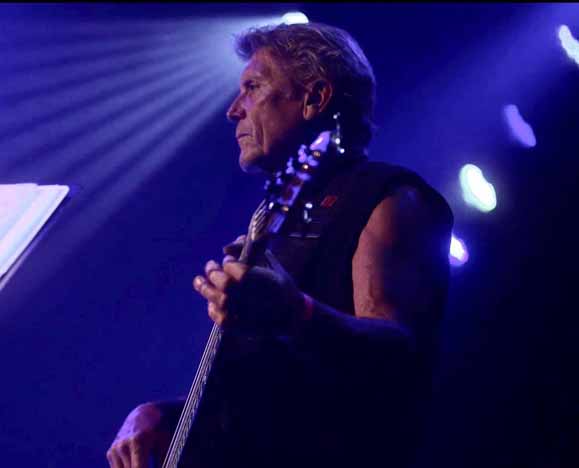
Billy Peterson
Because of the Covid-19 pandemic, only about 50 audience members could be in-house, but tickets were sold so that the show could be livestreamed around the world. Viewers provided feedback from Australia, Sweden, Norway, Germany, Belgium, Ireland, Canada and Mexico, reported Jeff Taube. In this reviewer’s opinion, the camera work, lighting, sound, pacing, and professionalism were excellent!
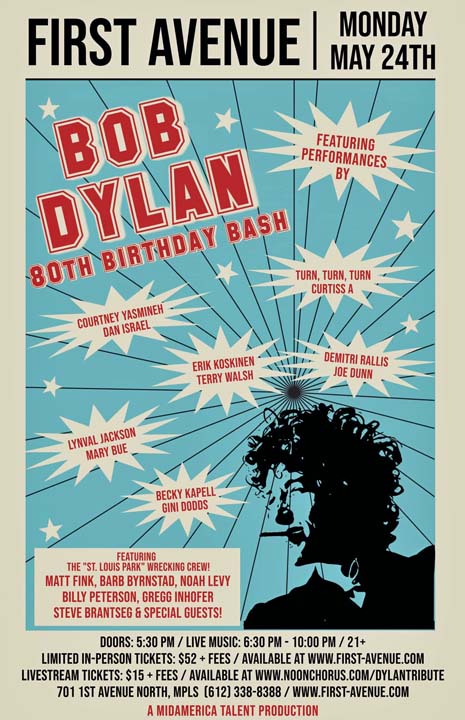
Peter Himmelman, grandson of Park legend Min Himmelman, is an accomplished musician, first recording with the band Sussman Lawrence. The following is an excerpt from the website http://www.conqueroo.com/peterhimmelman.html:
Music has been an integral part of Himmelman’s life since he was a kid growing up in the Minneapolis suburb of St. Louis Park. “I heard a lot of good music coming from behind my older sibling’s doors,” the artist recalls. He distinctly remembers hearing The Animals’ “House Of The Rising Sun” when he was 7 or 8. “That music hypnotized me – opened a door to a world where I could soften some existential feeling of loneliness.” Himmelman’s family helped form his nascent musical influences. At one time his father owned an 8-track music store and would bring home Jimi Hendrix and Janis Joplin tapes; his mother’s eclectic musical tastes ran to Ahmad Jamal and Thelonious Monk, while his uncle introduced him to John Lee Hooker’s Endless Boogie , which a young Himmelman played over and over again.
After getting his first electric guitar – a red Fender Duo Sonic – when he was 12, Himmelman soon started a rock band and began writing songs. During his high school years, he would venture over to North Minneapolis to play R&B with a circle of musicians that included future soul singing star Alexander O’Neal. In twelfth grade, he also became the guitarist (and one of only two whites) in Shangoya, an otherwise all-Trinidadian reggae/calypso band.
Leaving high school early, Himmelman used the pseudonym Sussman Lawrence and got hired as a cast member of Twin Cities, teen-geared TV show Steamroller. Besides doing comedy bits, he also got Shangoya to perform on the program. His new band – a new wave group that later assumed the Sussman Lawrence moniker performed for the first time on that show as well.
Sussman Lawrence’s 1980 debut Hail To The Modern Hero! came about as a direct result of Himmelman’s quick-witted father. “To make a record in Minneapolis in those days,” Himmelman recounts, ” you had to be especially talented or have access to a large trust fund.” After the band’s Steamroller appearance, Peter’s Dad called the studio where the band had been cutting some demos and pretended to be a “very enthusiastic” Chicago record executive. “The next day,” Himmelman relates, “the studio owner called saying that he was “suddenly eager” to press a single.” After mentioning the Chicago label’s “interest,” Himmelman himself was able to persuade the studio owner to pony up for an entire album. The group went on to make one more record, 1984’s well-received double album Pop City, but their road to success was derailed when Himmelman’s father passed away.
Mourning his dad’s death, Himmelman collected a set of new songs that he felt wouldn’t fit with the band’s tongue in cheek image. The title track and centerpiece of Peter’s first solo offering was a song called, This Father’s Day -which Peter had written and recorded on a simple tape deck in the basement of his parent’s home. It would be the last Father’s Day he would ever celebrate with his Dad. “The song created such a potent bond between my father and me…he carried that cassette around in his breast pocket until he died. In 1985, Himmelman released This Father’s Day, which Rolling Stone called “stunning.” MTV even started playing the video for the song “Eleventh Confession in regular rotation,” and Island Records wound up signing Himmelman and reissuing the album. He released two more albums on Island before moving to Epic Records
His work has consistently earned critical accolades. J.D. Considine, in the Rolling Stone Album Guide, called 1989’s Synesthesia “a delight,” awarding it with four stars. Time Magazine heralded Himmelman as one of “the New Troubadours” upon the release of his Epic debut From Strength to Strength, asserting that he writes “songs with the same emphatic edge and aesthetic urgency that impelled the Lost Generation to write novels.” In its Unstoppable Forces review, No Depression marveled how “Himmelman strips his music to its essence, tapping into a primal inspiration, investing melodies that have the sing-song simplicity of Buddy Holly or the Beatles with the yearning of a spiritual quest.”
Himmelman is also known for his raucous, unpredictable stage shows. USA Today has hailed him as “one of rock’s most wildly imaginative performers.” Among Himmelman’s personal favorite concerts was one in Chicago where he led several hundred audience-goers to a restaurant Says Himmelman, “On one hand it was a bit of a joke, but there was this strangely comforting sense of community being formed that evening.” At a show in Aspen he pulled everyone out of the club and onto a mountainside to enjoy the rest of his performance under a moonlit Colorado sky. “The club owners were furious,” Himmelman confesses, “because people left without paying their drink tabs.” However, the good publicity this incident received forced the club to ask him back. “The ticket price to my show doesn’t guarantee a field-trip, but I always strive to reach a place where time is suspended for me.” Himmelman admits.
During the ’90s, Himmelman, (now living in Los Angeles, married with four children) expanded his musical horizons to scoring a number of television shows and films, including the Disney series Bug Juice, NBC’s American Embassy and the Touchstone film Crossing The Bridge. In 2002, he earned an Emmy nomination for his work on Judging Amy, a show he has scored since 1999. Exploring different musical opportunities has long intrigued Himmelman. While living in New York in the early ’80s, he wrote music Swatch watches, Jordache jeans, and runway music for top fashion designer Issey Miyake. He’s also done national PSAs for drug awareness and written a series of songs for a teddy bear that’s currently being used to aid autistic children and rape victims.
Children’s music is another field that Himmelman has delved into with considerable success. He has made three children’s albums: My Best Friend Is A Salamander (1997), My Fabulous Plum (2000) and My Lemonade Stand (2004), with both Plum and Salamander being recognized with a Parents’ Choice Award and the Family Channel Seal Of Quality. Himmelman finds children’s music “a vast and liberating universe of possibility,” although noting that his kids songs and his rock songs “come from very distinct places.”
Growing up in St. Louis Park, Peter Himmelman lived at 2304 Rhode Island Ave.
Save
Randy Resnick is a guitarist who developed a “tapping” style in the early 1970s. He also plays upright bass and wind synthesizer. He has played with many blues and jazz luminaries, such as Don “Sugarcane” Harris, John Lee Hooker, John Klemmer, John Mayall and Freddie King. He published a CD of his own music in 1995.
He was born in 1947, and moved from Washington State to St. Louis Park, Minnesota, where he graduated from Park High in 1965. He lived on 25 1/2 Street, and the first person he met in town was Owen Husney.
One of the highlights of Randy’s young life was when he presented a Rickenbacker 12-string guitar to George Harrison at the press conference before the Beatles performance at Met Stadium in 1965. Click Here for that story.
Randy says “I moved to California in about 1969 and eventually played in bars in Orange County. I was kicked out of Disneyland for long hair and refused a refund of my tickets and I never went back.”
His composing career began in 1972 when he co-wrote several songs while a member of the Pure Food and Drug Act.
Randy has his own page on Wikipedia and 170 songs online. He can be reached on Twitter: @randulo
Photo credit: Salva1745, used by permission.
Randy playing with Canned Heat at the 15th Avignon Blues Festival, October 5th, 2012.
ART RESNICK
Randy wanted to be sure that his brother Art was mentioned, although he presumably never had an encounter with a Beatle. Instead, Art Resnick is (quoting allaboutjazz.com)
a professional jazz pianist and composer who has toured and recorded with some of the best known jazz dignitaries in the world. He has performed and recorded with Freddy Hubbard,Nat Adderly, Benny Golson, James Moody, Eddie Harris, Harry “Sweets” Edison, Bobby Shew, Richie Cole and many more.
He has toured all over Europe, Australia, and the US playing major clubs in New York, LA, Paris, Lisbon, Sydney Australia to name a few.
He also has been on 13 recordings and has two as leader:
The album “Jungleopolis” was released on July 1, 1974.
Resnick Composed and Arranged the album as well as playing Keyboards. It featured:
- Billy Peterson on Bass, Electric Bass, and Clavinet
- Paul F. F. Lagos on Drums
- Robert Rockwell on Flute and Alto Flute
“Conversations” was recorded in 1983 with Peter Ponzol in New York and released in Germany. Resnick and Ponzol produced the album and composed the songs. In addition to Resnick’s piano, Ponzol provided saxophone and flute.
Save
Rufus Webster was a jazz pianist, concert promoters, and an educator. I didn’t find out until he passed away that he had been living practically in my back yard, and I could kick myself for not trying hard enough to find him.
The first mention of Webster in the Strib archive is in 1941, when he was a member of the newly-formed “Boogie Woogie Club” at the University of Minnesota. There he earned his Masters in Music.
In 1945 Webster and Earl Bostic performed on a record called “They Raided the Joint” by Hot Lips Page and His Orchestra. That connection to Bostic may be how Webster was able to bring national acts to Minneapolis starting in 1950.
In 1950 Webster performed at Cassius’s Bamboo Room, and began his career promoting concerts featuring national jazz and Rhythm & Blues acts. His first effort was to bring Dinah Washington to the Labor Temple on October 30, 1950.
On November 25, 1950, Webster and partner D.P. Black brought Earl Bostic and his Orchestra to the CIO Hall.
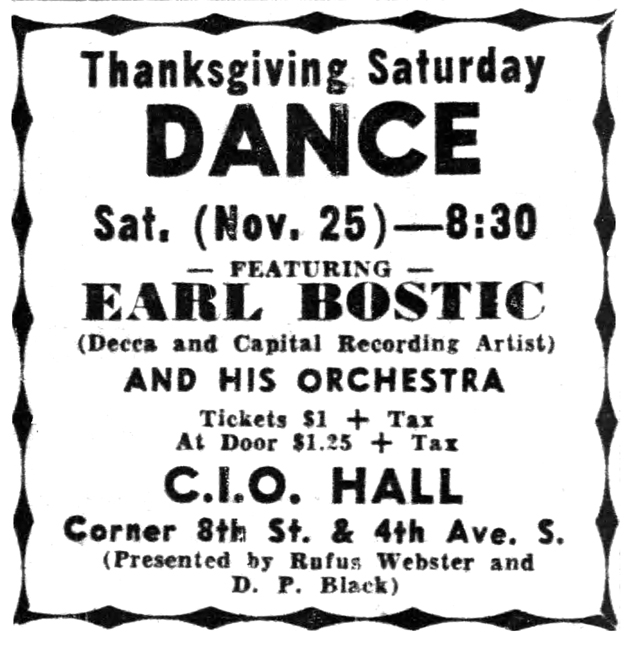
Minneapolis Star
In December 1951 Webster was working at the Flame Cafe.
In December 1953 he performed at Augie’s (when it was a straight jazz venue).
In December 1954 he was playing at the Flame Cafe in Percy Hughes’s band.
In July 1956 he was back at Augie’s, this time with strippers.
By May 1957, Webster was teaching school and playing with the Ray Komischke Quintet.
In March 1960 he was a member of the George Myers Septet, playing at the Downbeat Club in Spring Park.
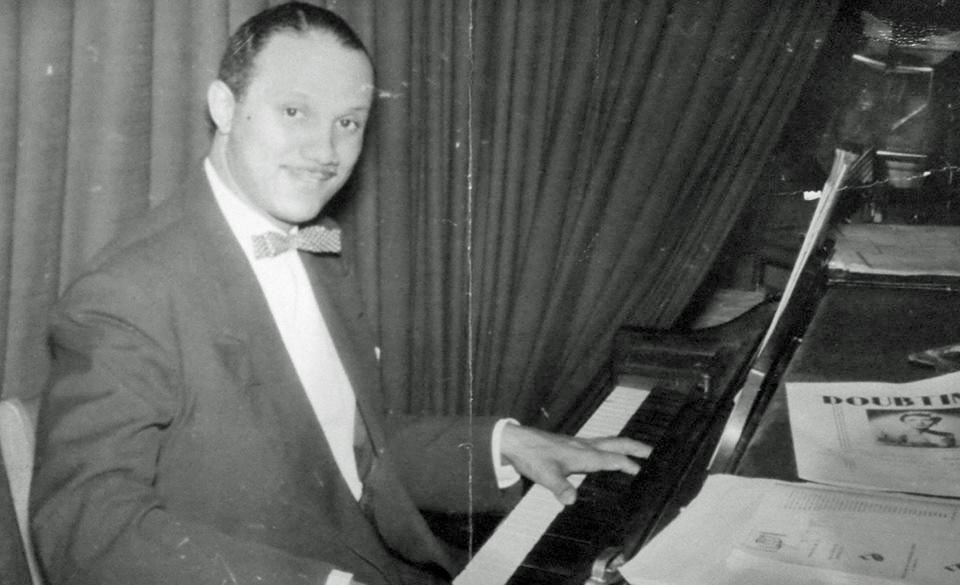
Photo of Rufus Webster courtesy Anthony Webster II
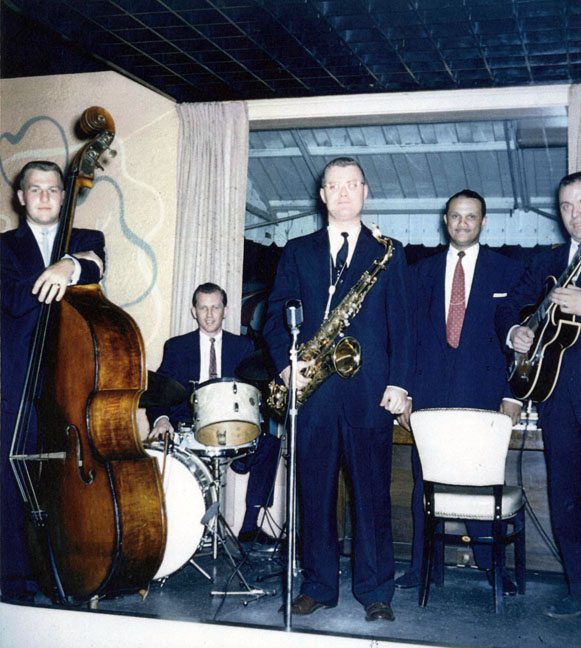
Rufus Webster and band at Duffy’s – Photo from the archives of the St. Paul Musician’s Union
Rufus Webster’s professional vita included:
- Teacher, St. Francis, Minnesota: 1955
- Social Studies Department Chairman, Pep Club Advisor, Roosevelt High School: 1960-1968
- Assistant Director of Urban Affairs, Central High School: 1968-1969
- Assistant Director of Intergroup Education, Central High School: 1969-1970
- Assistant Principal, Nokomis Jr. High
- Principal, Nokomis Jr. High: 1977 – 1978
- Assistant Superintendent of Intergroup Education and Affirmative Action: 1978-1979
- Director, Equal Education Support Department, 1979-1980
- Principal, Folwell Jr. High: 1984-1985
Webster retired from teaching in 1985. He passed away in August 2015. His last address was 2218 Hill Lane South, St. Louis Park.
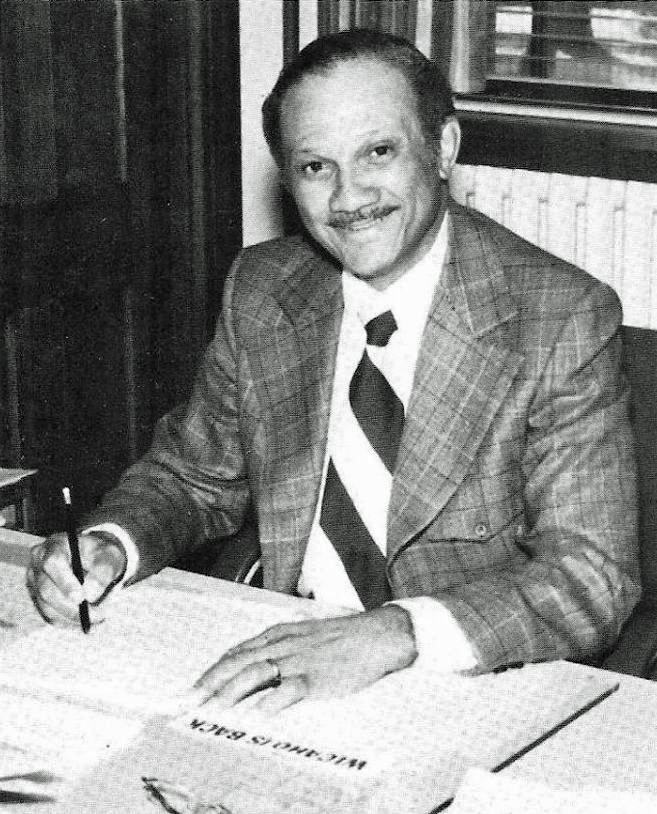
Rufus Webster in the 1970s
Amos and Danny Heilicher became businessmen early. In a 1972 article in the Minneapolis Tribune, Mike Steele wrote:
[Amos] relishes the fact that his sprawling empire began in the ’30s when he and his brother were teen-agers on the North Side, printing scorecards and selling them for a dime apiece at Gopher football games. They jumped from that into the coin-machine business, everything from penny scales to pinball machines. Around 1935 [1933] they got into the record business via coin-operated phonographs [five jukeboxes]. When the records lost popularity, they sold them as used records. When the used-record business became good, they started selling new ones and, in 1946, started a record shop at 3rd and Hennepin. Within two years they had the [regional] distributorship of Mercury Records [which supplied discs for his jukeboxes] and, by 1955, had added Columbia [RCA and other labels].
The Heilichers distributed major-label recordings to retail shops and ran record departments for dime stores and department stores (“rackjobbing”).
SOMA RECORDS
In 1954 [or 1957] Amos and Danny started the SOMA record label (Amos spelled backwards), and recorded mostly polkas, country/western, and jazz.

SOMA Studio, 1958
SOMA ventured into rock ‘n’ roll in 1959 with Bobby Vee’s “Suzie Baby,” which was a regional smash before Liberty Records bought up the master and issued it nationally. Among hits released by SOMA (and subsidiaries Garrett and Bangar) were “Mule Skinner Blues” by The Fendermen, “Liar, Liar” by The Castaways, “Run, Run, Run” by The Gestures and “Surfin’ Bird” by The Trashmen. (George Garrett was an engineer who ran the board on many SOMA recordings and later ran a record store.) Amos also had some ownership in the local recording studio, Kay Bank, where most of SOMA’s recordings were made.
More about SOMA Here and Here and Here
MUSICLAND
The Heilichers acquired Musicland in 1964, at that time a 15-store retail chain that opened its first store in Minneapolis in 1956 by entrepreneurs Terry Evenson and Grover Sayre. Musicland expanded rapidly to 48 stores under their management and merged with J.L. Marsh. At one time there were 1,300 Musicland stores. At their peak, Heilicher’s companies accounted for about 20 percent of all recordings sold in the United States.
In 1965 the Heilichers built a new headquarters at 7600 Wayzata Blvd. in Golden Valley with about 100,000 sq. ft. of warehouse space.
In 1968 the Heilichers merged Musicland with Pickwick International. Here is the rundown of companies:
- SOMA Records fell by the wayside: “We’re off that kick now. It’s a tough field to get into, like competing with General Motors. We’d prefer to sell other companies’ hits,” remarked Ira in 1972.
- Pickwick Records was run from New York by Seymour Leslie. The company “is advertised as the paperback of records and has done well by buying up old tapes by such performers as Sinatra and reissuing them on their budget label.”
- Heilicher Brothers was the distribution branch
- J.L. Marsh, Inc. was the rack jobber
- Musicland Stores was the retail division
At the time of the merger in 1968, Pickwick International, Inc. was listed on the American Stock Exchange. It was listed on the New York Stock Exchange in 1972.
In 1976 Amos (known as “Mr. A”) had a falling-out with the Pickwick board and sold his stake in the company. At the time Pickwick was the largest record distributor in the US and UK and had 280 retail record shops. It had also just been purchased by the American Can Co.
AMOS HEILICHER died on October 12, 2008, at age 90.

Amos at the 1970 Connie Awards. Photo copyright Mike Barich, St. Paul
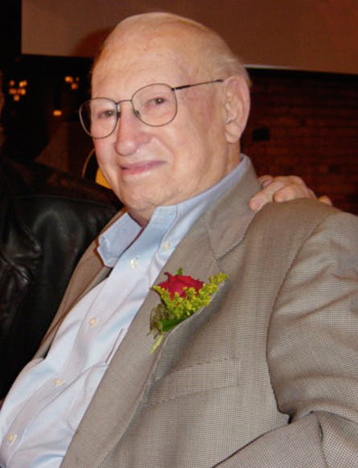
Amos, StarTribune
IRA HEILICHER, Amos’s Son and integral part of SOMA Records, died on August 2, 2011, at age 65.
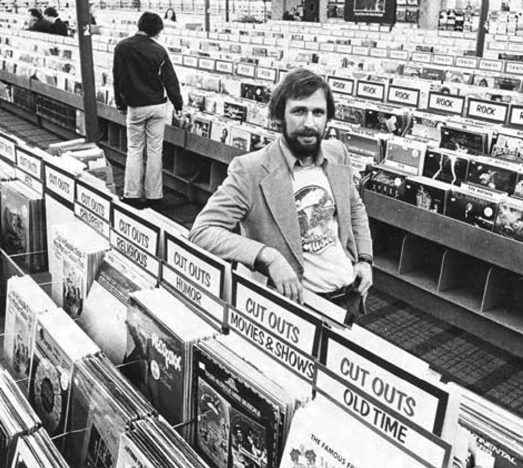
Ira in 1978, Minneapolis Tribune
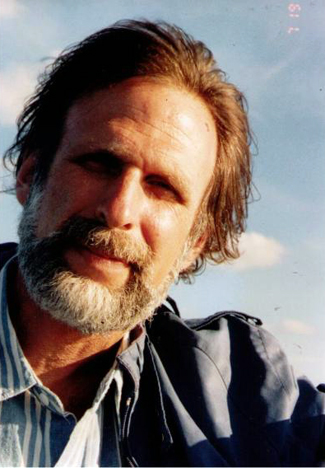
Ira, Minneapolis Star Tribune
DANIEL HEILICHER died on May 24, 2005, at age 81.
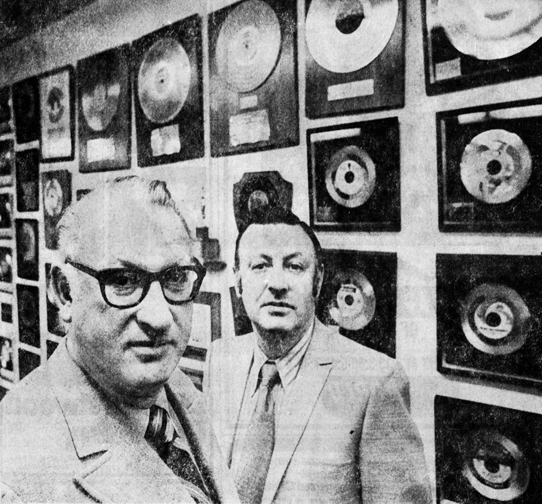
Amos and Danny, December 26, 1971. Mpls. Tribune photo by Earl Seubert
Save
The Beatles came to town on August 21, 1965, and had a terrible time.
PRELUDE
1964
The band took the Colonies by storm when they first appeared on the Ed Sullivan Show on February 9, 1964. The performance was seen by a then-record 73 million viewers. They performed five songs.
Their second appearance on the Sullivan Show was on February 16, where they performed six songs from the Hotel Deauville in Miami Beach.
Their third appearance was on February 23, 1964, which had actually been taped on February 9, before their live appearance that same day. They performed three songs.
Soon after the band had blown away Americans on the first Sullivan Show, they hit the road in the Colonies. On March 14 and 15, 1964, we were able to see their first American concert, which took place in Washington, DC on February 11. It was shown to local viewers over closed circuit TV at the Minneapolis and St. Paul Armories.

Minneapolis Tribune, March 2, 1964
Thanks to Barb Frost for posting the images below on Facebook:
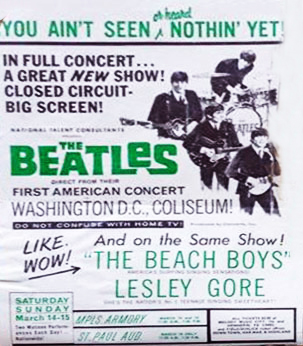
Image courtesy Barb Frost

BEATLEMANIA
It didn’t take long for Beatlemania to take hold in America. Shockingly soon, in February 1964, Baskin Robbins came out with Beatle Nut Ice Cream!
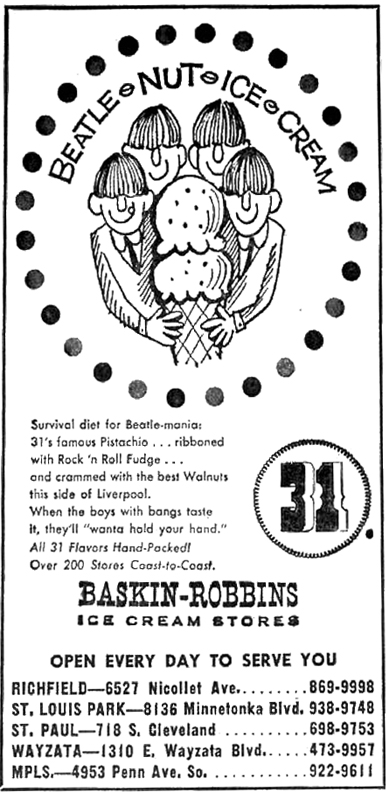
Minneapolis Star, February 27, 1964
Beatle fashions were also in vogue, with turtlenecks (available at Dayton’s), Beatle Boots, and of course, Beatle haircuts. Beatle wigs were actually popular, since some boys couldn’t wear their long hair at their jobs or at school. In a Will Jones column in April 1964, Keely Smith, who was in town to tape an Ed Sullivan show, complained that Keely Smith wigs were being retooled as Beatle wigs.
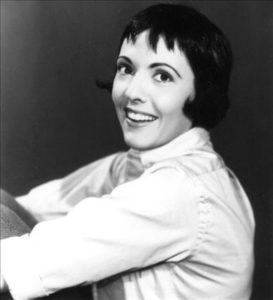
Keely Smith. Not exactly Beatle hair.
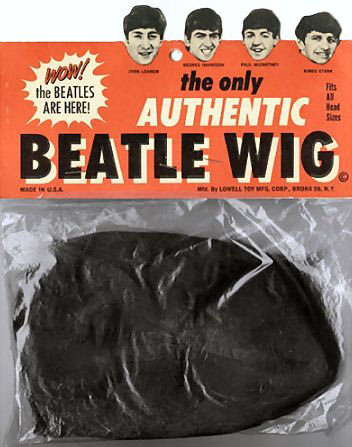
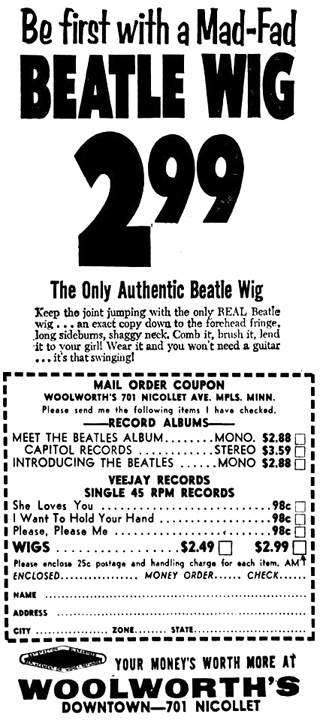
Minneapolis Star, February 20, 1964
After seeing the girls screaming, hundreds of Minnesota boys headed straight to the music stores to buy guitars, and scores of Minnesota rock bands were formed.
THE TOP FIVE
On April 4, 1964, The Fab Four held the top five spots on the Billboard Hot 100 chart, a feat that has never been equaled. “Can’t Buy Me Love” hit No. 1, while “Twist and Shout,” “She Loves You,” “I Want To Hold Your Hand” and “Please Please Me” round out the top five. In all, they had 12 spots on the charts that week. Plus, thanks to “I Want to Hold Your Hand,” “She Loves You” and “Can’t Buy Me Love,” the Beatles are the only act in the Billboard Hot 100’s history to have three consecutive No. 1 hits. Hot doesn’t describe it.
THE FEMALE BEATLES
The Tribune‘s Will Jones reported that on May 29, 1964, a group called the Female Beatles would be opening for a week at the Flamingo in St. Paul for a week. On June 7, they would appear at a Beatle Day event at Excelsior Amusement Park. They were coming from the Thunderbird in Las Vegas.
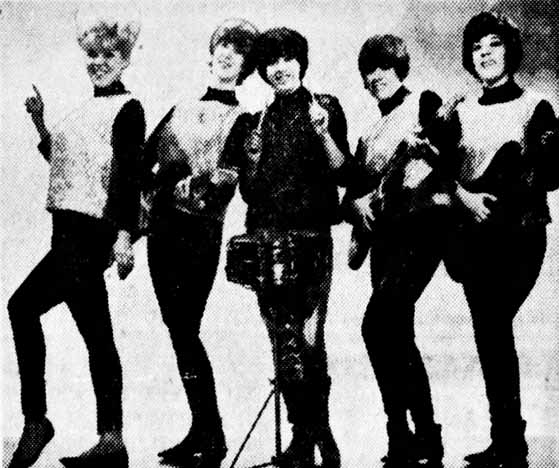
The Female Beatles, Minneapolis Tribune, May 28, 1964
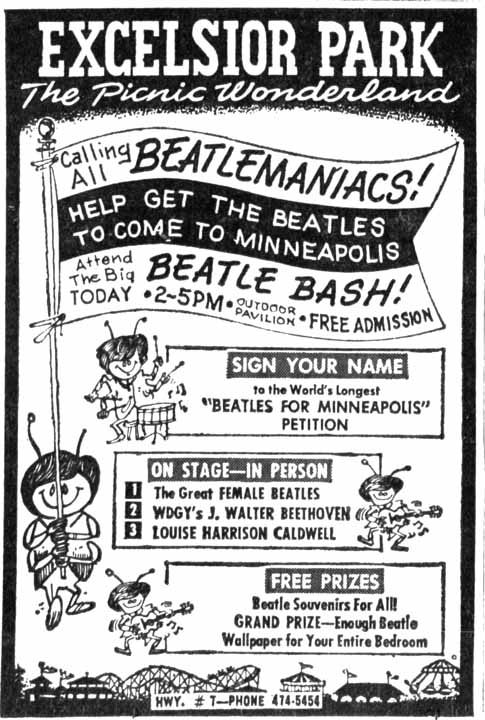
Minneapolis Tribune, June 7, 1964
Gotta wonder who won all that Beatle wallpaper…
BIG REGGIE’S BLUNDER
In April of 1964 [“Big Reggie” (aka Ray Colihan) from Danceland] was offered an opportunity to sponsor an appearance of England’s gift to music appreciation for their August 1964 tour. He grinds his teeth and admits he turned it down “because I didn’t think they’d draw a crowd in August!” By September 1964 he had realized his error and was on a plane for Chicago to try and book them in for this year [1965] at Metropolitan Stadium.
(Ann Graveson in the Minnetonka Record, August 19, 1965)
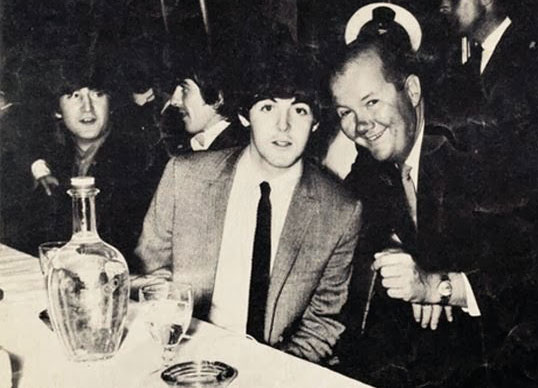
Big Reggie in Chicago, September 5, 1964
Fueling the fire was the opening of “A Hard Day’s Night” on August 7, 1964 at the Orpheum. Below is a ticket to opening day, courtesy of some good soul on Facebook:
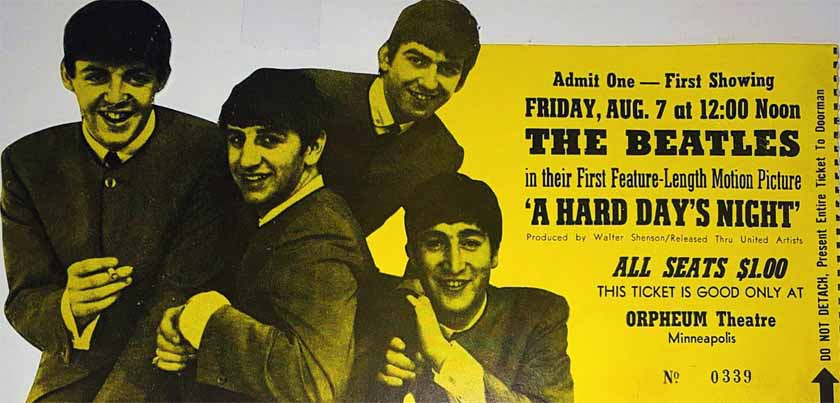
1965
Although Beatlemania was into its second year, it was still very real. Their movie “Help!” was showing at the Orpheum Theaters in Minneapolis and St. Paul, and the album of the same name had just been released. Reggie’s efforts to redeem himself worked, and the concert in Minnesota (Bloomington) was on the Beatles’ 1965 tour schedule.
More of the Minnetonka Record:
There may be nothing left of Ray to watch the fun; for weeks he has been besieged on all sides. Teenage girls (and their parents) write to him for tickets and tips on where to stay; fans have threatened to commit suicide unless he will introduce them to the Mop Tops; his phone rings at the office and at home with dozens of requests, each one more urgent (and sometimes kookier) than the last. …
“Everyone’s asking how we’re doing on tickets and the answer is good” he said Tuesday morning. “I think this is going to have the largest advance sale of any event in the Twin Cities … we estimate about 30,000. Right now i know of about 8,000 out-of-state tickets. There is a sale of 400 in Winnipeg, Canada and requests from Omaha, Denver and Kansas City. Most of these are kids coming with their parents. There’s one group of 350 fans from Chicago who are going to the Beatle show there and then get on buses and be here for another show the next night!”
Another burning question: has the fact that Ringo (drummer) married recently hurt the group’s popularity? Ray says not that he can see. New York sold out at 55,000 and Chicago’s show is already sold out for two performances of 33,000 seats each.
The rumor that Minneapolis is sold out too is adding to Ray’s woes. There definitely are seats available and these will go on sale at the Stadium. But he has been getting calls from out-of-towners who are planning to come and have been panicked by the rumors. …
The final question of how the whole thing turns out rests in the hands of the restless fans. They seem pretty determined… Ray made arrangements with a group of Beatle-lovers to sit in the stands and try and keep their neighbors from screaming. Since word of this was in the paper he has been getting angry phone calls: “We’ll scream if we want to!” He just shrugs and shakes his head. “This kind of action adults don’t know anything about.”
THE SHOW IS ON!
Reggie asked Bill Diehl of WDGY to be the M.C. Diehl went to Chicago to see them in action at their concert before the Minneapolis date and to spend a day and a half with them. He brought back 16 mm film he took of the concert at the Stock Yards Amphitheater.
Hoffbeck (see sources below) says that the concert was heavily advertised on rival rock ‘n’ roll radio stations KDWB and WDGY, one minute each hour for several months. Bill Diehl remembers that Colihan only publicized it by word of mouth and some print, but not on the radio, for fear of pandemonium (which they got anyway). This was the only ad I found in the Minneapolis papers:
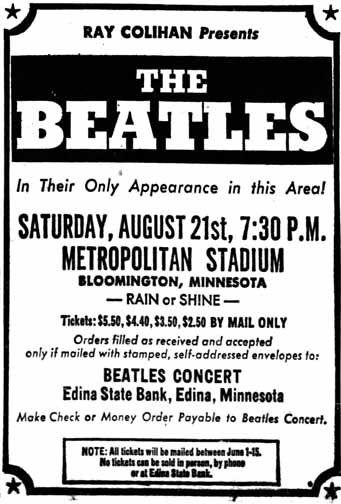
Minneapolis Tribune, May 9, 1965
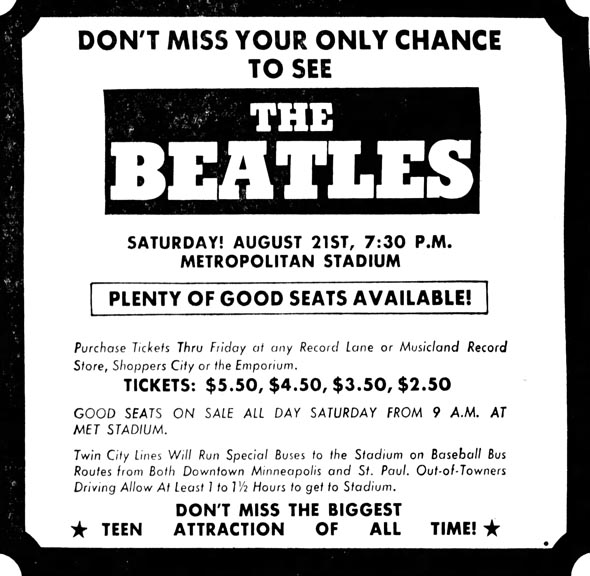
Jon Kowalski found this ad, which was probably in a St. Paul paper.
Tickets were $2.50, $3.50, $4.50 and $5.50. The group received a guarantee of $50,000 and an additional 65 percent of sales above 18,500 tickets. 30,000 tickets were sold, earning Colihan a profit even though the 40,000-seat stadium was not sold out, the only non-sellout on the tour. (Was the fee delivered in cash at the last minute in a Red Owl grocery bag?)
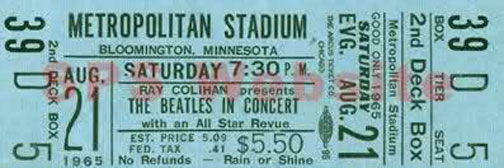
ARRIVAL
Things didn’t start well when they were attacked at the airport by 3-4,000 crazed fans when they got off their chartered plane at 4:15 pm. Ringo was the first off the plane and a fan pushed through the cyclone fence and yanked at him. Paul may have been accosted as well. Plans for some picture taking were abandoned and they barely got into their car before the mob escaped the 60 Bloomington policemen. A blogger says that Pete Heckman picked them up from the airport and took them directly to the stadium. Pete also drove them back to the airport the next day.
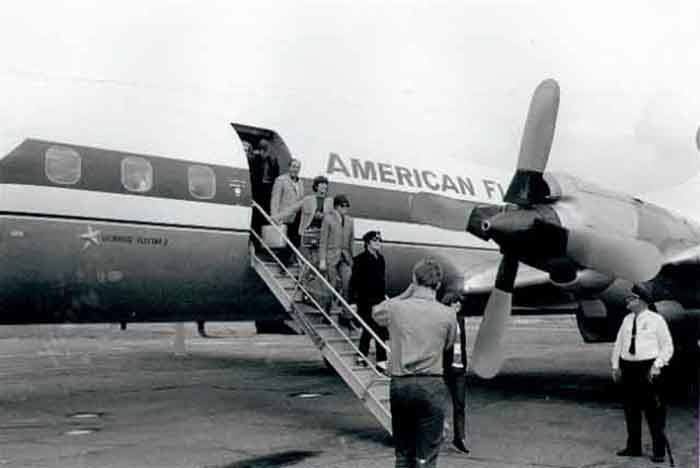
Image courtesy Minnesota Historical Society
The photo below was pulled off of Facebook, and I have no attribution for it. If it is your photo, please contact me so I can credit you.
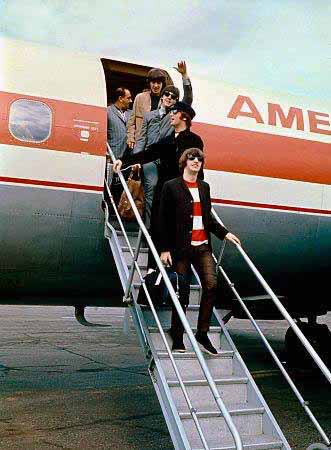
Two men stand-by with a fire hose at Wold-Chamberlain Field in case Beatles fans get out of control. August 21, 1965. Thanks to Michael Larkin!
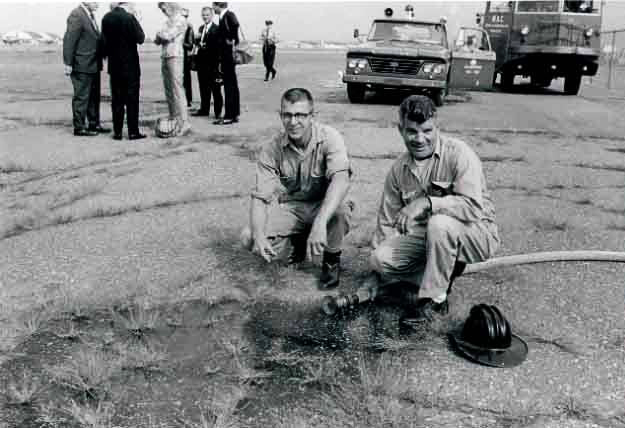
Photo by St. Paul Dispatch, courtesy Minnesota Historical Society
THE LOCKER ROOM
They waited for the show to go on in the Twins’ locker room at the Met Stadium. Ray Crump, the Minnesota Twins Equipment Manager, was with them. (See more on Crump at the end of this page.)
Reported activities included:
- Dining on salad, roast beef, mashed potatoes, green beans, and milk – Diehl later retrieved the dirty dishes and gave them away in a contest.
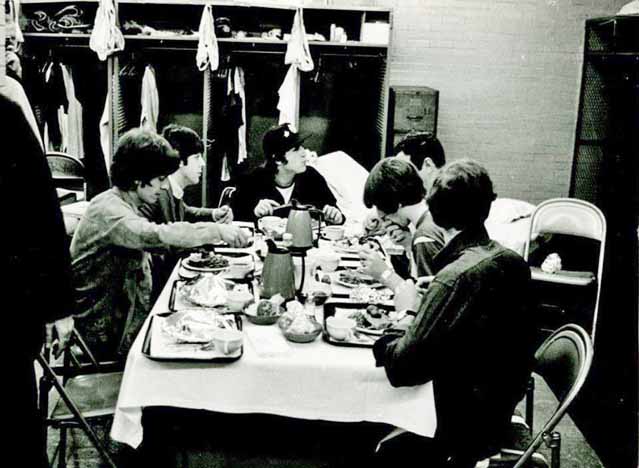
This photo was pulled off of Facebook, and I have no attribution for it. If it is yours, please contact me so I can credit you.
- Lounging on cots – Crump later sold the sheets to an ad agency for $800. The sheets were eventually cut up and given away in drawings at Dayton’s
- Ringo sat in Harmon Killebrew’s chair.
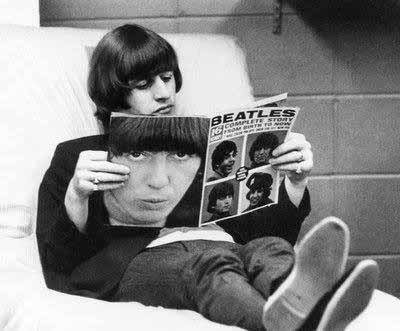
This photo was pulled off of Facebook, and I have no attribution for it. If it is yours, please contact me so I can credit you.
- Paul played guitar in a corner.
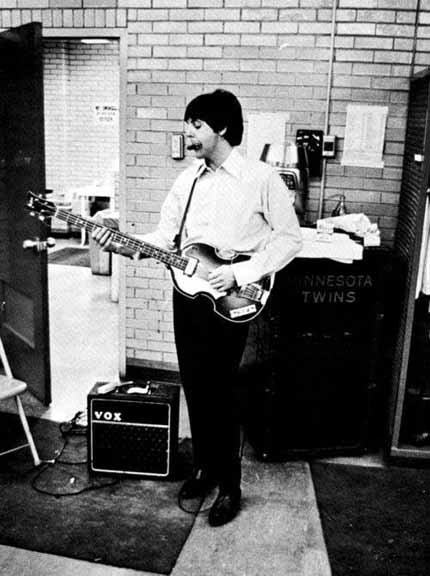
This photo was pulled off of Facebook, and I have no attribution for it. If it is yours, please contact me so I can credit you.
- John Lennon watched a wrestling match on TV.
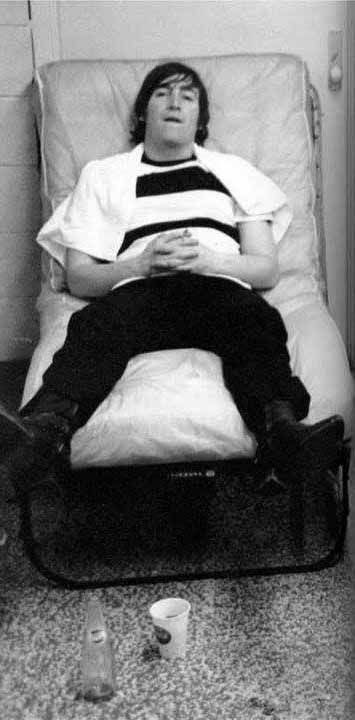
This photo was pulled off of Facebook, and I have no attribution for it. If it is yours, please contact me so I can credit you.
- Taking a sauna for the first time, according to Crump.
- Playing roulette with Brian Epstein to see who would keep the money from sales of souvenir programs. Crump said that after 45 minutes whoever won “took all the loot.”
- Crump also said that the boys were very businesslike backstage, unlike their public personae. “It reminded me of [pro]wrestlers being different on camera and off.”
RAY CRUMP PHOTOS
The photos of Ringo, John, Paul, and George with Ray Crump below were posted on the Old Minneapolis Facebook page by Jill Griffith, Crump’s daughter.
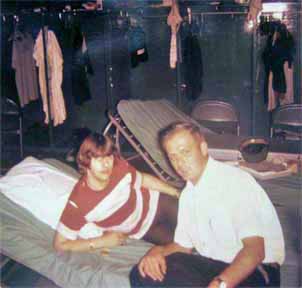
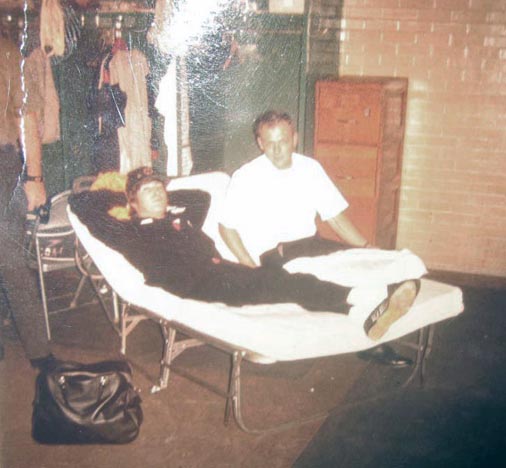
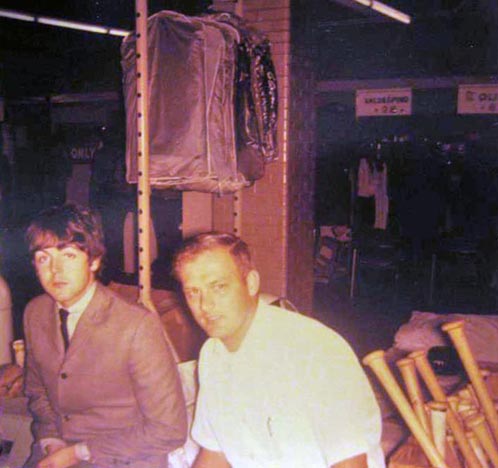
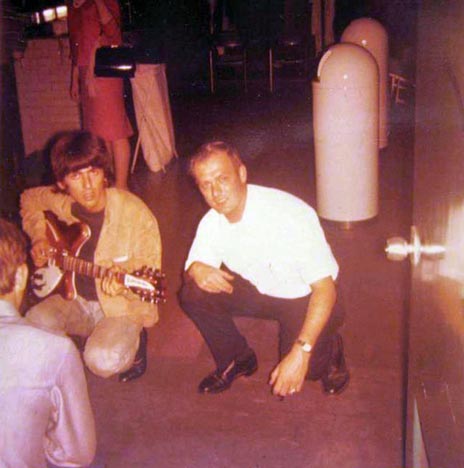
PRESS CONFERENCE
Before the concert, the Fab Four held a press conference in the Minnesota Room of the stadium. Don Powell was the Press Coordinator, in charge of keeping out teenagers!

Courtesy Don Powell
Facing the Beatles were 12 microphones, 5 TV cameras, 150 reporters, and a few teenage “observers” who had won a contest. Most of the questions were silly but then so were most of the answers. Somehow they kept coming back to their hair.
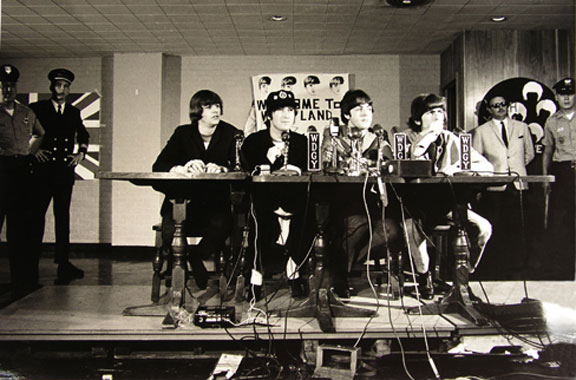
Fred Anderson reveals how a picture of the Beatles at the press conference with the second issue of Twin City a’ GoGo ended up on the cover of the third issue: a’ Go Go editor Bruce Goldstein made arrangements with Big Reggie to put copies of Issue #2 on the tables. The cover of #2 had pictures of the individual Beatles, and the mop-tops (except Ringo) looked at the magazines and played with them and such. The photo on the cover of issue #3 of the magazine was of the Beatles with Issue #2. The picture was taken by Kent Kobersteen of the Minneapolis Tribune. Fred (who worked as a copy boy there) made a print of the negative and slipped it to Bruce.
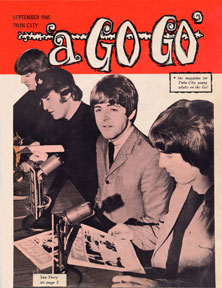
Bill Carlson (not the broadcaster) was a high school student in 1965, working with Merle Morris, a stringer for UPI. When none of Morris’ regular photographers took an interest in seeing the Beatles, Carlson got a press pass and took hundreds of photos that day with his Hasselblad and Nikon cameras. The photos were forgotten until 2007 when Carlson published them in a hardcover book called The Beatles!: A One Night Stand in the Heartland, which is available on Amazon.
The photo below was pulled off of Facebook, and I have no attribution for it. If it is your photo, please contact me so I can credit you.
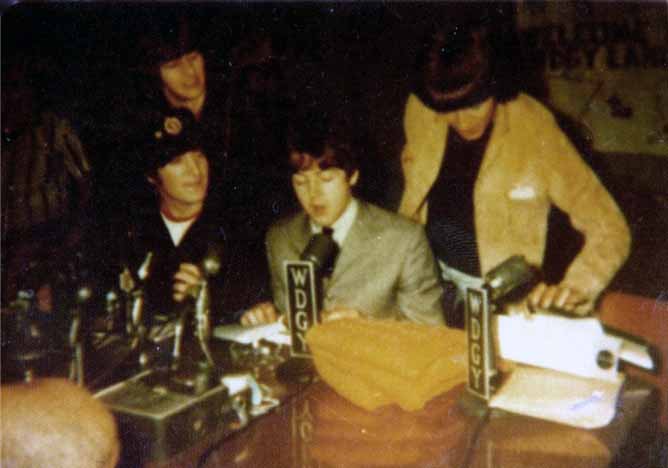
RICKENBACKER PRESENTATION
At the press conference, Randy Resnick, local musician and B-Sharp Music employee, presented a Rickenbacker 360-12 electric 12-string guitar in a Fireglo red sunburst finish to George Harrison on behalf of the musicians of Minnesota. Resnick, pictured below, made the presentation, as captured by photographer Bill Carlson. Ron Butwin, another employee of B-Sharp, was also there for the presentation. They give slightly different accounts of how the presentation came to be.
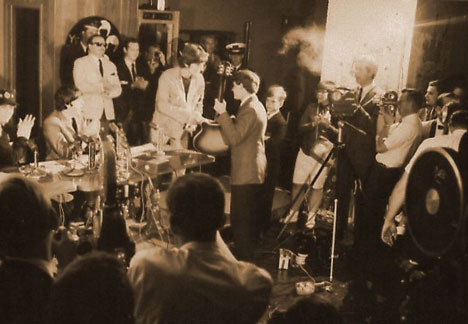
Google Images
In August, 1965, I had an idea: promote the music store where I worked by giving George Harrison, not the key to the city of Minneapolis, but the key to a guitar case, a Rickenbaker 12-string. James Lopes, the owner of B-Sharp Music, liked the idea, so I set about contacting radio stations, because that’s how we’d get the publicity machine started, in the pre-Internet era. After a lot of calling and approaching radio personalities at gigs, I finally got myself a slot at the press conference. We kept one of the keys to George’s guitar case to give away on WDGY after the concert.
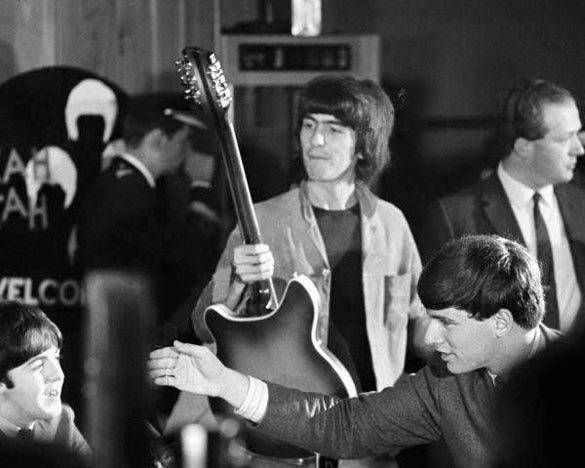
Randy Resnick shakes hands with Paul
Ron Butwin writes:
When the Remo Four – another English group – were in town a few weeks back [Randy Resnick and I] showed them the guitar when they visited our store, and they flipped over it. The group knew the Beatles, and one of the fellows said that George Harrison would love to have a guitar like this. I decided that Randy and I should present it to him when he came to town, with our thanks to the Beatles for causing the guitar business to boom.
An edited version of the press conference is on YouTube (although it occasionally gets taken down); it was clearly Randy who presented the guitar and shook the hands of all four Beatles, although Ron is apparently right there as well.
George was genuinely touched and used the guitar during the show, but it disappeared a year later after their last concert in Candlestick Park in San Francisco. [Another account says the guitar was not used on the US tour, but Harrison played it on “If I Needed Someone” on 1965’s “Rubber Soul.”]
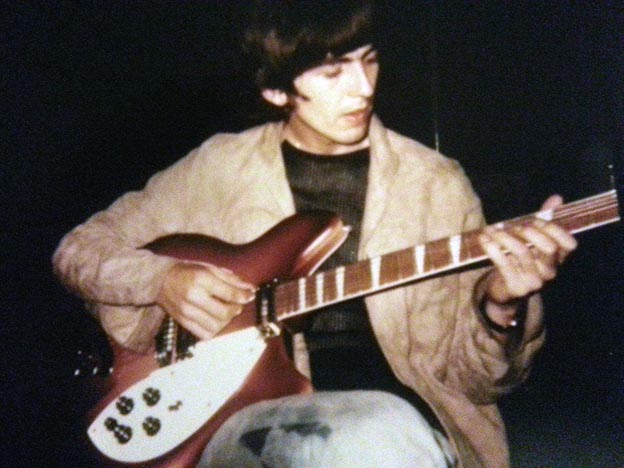
George with Rickenbacker – Image courtesy Jon Kyllo
In a letter dated 7 September, 1965, George expressed his appreciation in a letter to Butwin:
I cannot tell you how much I appreciated your generosity in giving me such an expensive guitar when we were in Minneapolis. As you know, I did have the older model, but I’ll definitely be using the new one in the future, both for recording sessions and stage appearances.
IN THE CONCOURSE
Local groups the Accents, Underbeats, TC Atlantic, and Gregory Dee and the Avanties played in the concourse of the stadium before the show. Rod Eaton of the Underbeats explains:
In those days the Minneapolis Musicians Association – the “union” – demanded “minimums” on many venues. So Reggie needed to hire a bunch of bands to meet the union minimum for the Met. But the Beatles wouldn’t allow local groups to play on their stage. The upshot of all of this is that the Underbeats and several other Twin Cities bands were asked to play in the concourse surrounding the stadium before the actual concert. None of us were happy with the arrangement – we felt it was sort of demeaning. But because it was Reggie asking we agreed. In exchange we were all given really great seats for the show.
Here’s the thing – I don’t remember playing there at all. In fact for a long time I was convinced the Underbeats didn’t play that night. But since everyone tells me we did I have to agree – it must have happened. I just don’t remember any of it. I do remember Pat and me being at the concert. I remember there was a lot of screaming and the Beatles were hard to hear. I remember they didn’t sound all that good – partly due to the noise and partly due to tired voices. And I remember listening to T. C. Atlantic play in the concourse. I’d heard a lot about the group but hadn’t had an opportunity to hear them. A year later I was their drummer.
(hear more about the experience of the Underbeats at the Beatles concert in an interview.)
THE SHOW
The show started at 7:30. Opening acts on the tour were Brenda Holloway and the King Curtis Band, and Cannibal & The Headhunters. Sounds Incorporated (not to be confused with Sounds Orchestral), was another British group managed by Brian Epstein. They had no hits but had appeared in a couple of films; their thing was apparently putting the classics to a rock beat.
The Beatles ran out of the dugout to the elevated stage at the pitcher’s mound. Enduring terrible acoustics, the lads sang 11 songs in 35 minutes. “Twist and Shout” was deleted because John had throat problems.
- She’s A Woman
- I Feel Fine
- Dizzy Miss Lizzy
- Ticket To Ride
- Everybody’s Trying To Be My Baby
- Can’t Buy Me Love
- Baby’s In Black
- I Wanna Be Your Man
- A Hard Day’s Night
- Help!
- I’m Down
There is a bronze plaque at the Mall of America at the spot where they played – home plate of the old stadium. It’s embedded in the floor in the northwest corner of Nickelodeon Universe, about 40 yards from where the closest fan would have been. Security guards and ushers were armed with smelling salts for fainting fans. The number of police has been estimated as up to 350 and came from Bloomington and Hennepin and Ramsey Counties. Reports conflict as to whether the concert had to be cut short when fans rushed the field. Hoffbeck says that one fan broke free and went running but was intercepted by police and hurled back over the fence.
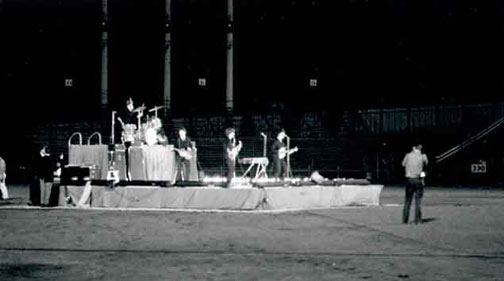
Photo courtesy Minnesota Historical Society
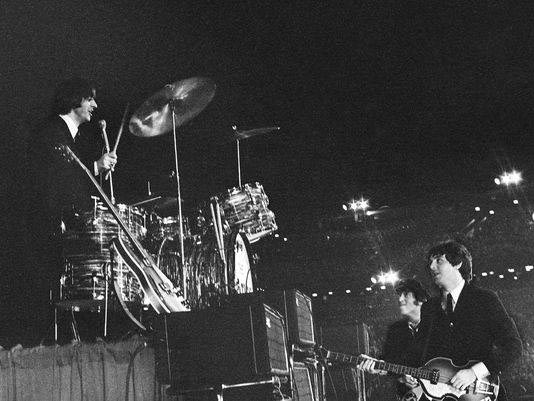
Image courtesy Minnesota Historical Society
The photo below was pulled off of Facebook, and I have no attribution for it. If it is your photo, please contact me so I can credit you.
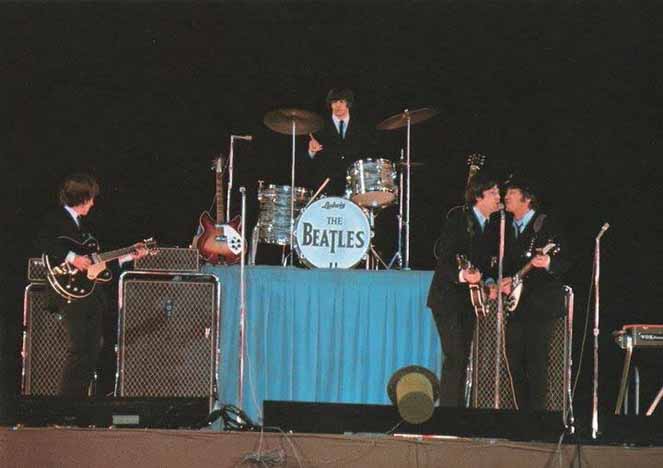
The photo below was pulled off of Facebook, and I have no attribution for it. If it is your photo, please contact me so I can credit you.
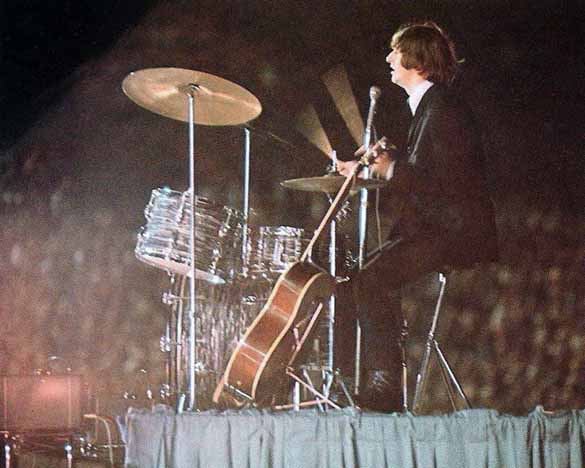
A typical Beatles exit was made with a decoy limo and a real escape in a Falconers’ laundry van (they sat on folding chairs).
RADIO STATION HI-JINKS
Rock stations WDGY and KDWB were in mortal competition during these years, and did everything in their power to associate themselves with the Beatles. Stories told by Bill Diehl, head DJ at WDGY and Sam Sherwood, General Manager of KDWB, were very different, as can be expected. I was privileged to be able to interview each of them before their passing, and hope I asked the right questions!
Sherwood said that he met the Beatles in New York back in 1964 when they were in town to appear on the Ed Sullivan Show. He hung out with them at the Plaza Hotel and secured a phone line to the room. He called Lou Riegert back at the station in Minneapolis and Lou interviewed the boys on the air. Sam also somehow (he wouldn’t say) surreptitiously obtained an acetate of each new Beatles song from a secret source in New York, hid it in his desk, and when he got the go-ahead, he transferred it to disk and put it on the air. Over the record the DJ would announce “This is a KDWB exclusive” so nobody could tape it and use it on another station. Sam said he was successful with this on all the records except for the German version of “I Wanna Hold Your Hand.”
In 1965, when Big Reggie made the deal for the Beatles to come to Minneapolis, Sherwood said that he went to Chicago and met with the “real promoter.” He was told that WDGY had a lock on it, sponsoring the press conference and emceeing the show. That decision was confirmed by Capitol Records branch manager Paul Goetz. Sherwood implored Goetz to let him participate in introducing the band. Goetz asked Diehl if Sherwood could be a part of the introduction, and Diehl said no. Sherwood told Goetz that if he couldn’t be on the stage for the introduction, KDWB would never play any Beatles songs again. Diehl said that the rep asked him if Sherwood could be on the stage as well to introduce the Fab Four, but Diehl told him that the Beatles insisted that the emcee be a member of the American Guild of Variety Artists (the performer’s union), which Sherwood was not. It went back and forth, and finally Diehl relented and allowed Sherwood to be on the stage for a brief moment.
Sherwood said that KDWB got the limo concession, with mobile phones so the boys could talk to the DJs while in transit to Met Stadium.
LOUISE HARRISON CALDWELL
Into the fray came George Harrison’s sister, Louise Harrison Caldwell. Louise had moved to the United States in the 1950s, and before becoming famous, George had come to the States to visit her. When Beatlemania hit and the group came to tour the U.S., George was the only one who had been here before.
It is likely that Louise was at the 1964 concert in Chicago, and that she met Bill Diehl there. When the Beatles came to Minnesota in 1965, Diehl invited her to come and visit, and put her up at the Thunderbird Motel, where they all went swimming. During her week’s stay, she agreed to accompany Bill to dances that he emceed, for a fee to be paid by the venue. Sometimes they would decline, but most times they would pay to have her there. The kids loved to talk to her and get her autograph, Bill remembered.
Sherwood said that KDWB was supposed to get the press conference, but because of Diehl’s friendship with Caldwell, Diehl got exclusive coverage, with the conference broadcast on WDGY, WDGY flags on all the microphones, and a “Welcome to WDGY Land” banner behind the table. Diehl said that Caldwell had nothing to do with that, and that WDGY had the press conference rights because of the agreement with Colihan.
Sherwood retaliated by telling his reporters to take all the front spots and prefacing their questions with “KDWB wants to know…” When one question didn’t start out that way, Lennon asked, “Wait a minute, doesn’t KDWB want to know?” Diehl said that someone from KDWB grabbed the line at a nearby phone booth in order to broadcast the press conference, but WDGY put two guys nearby to intone “WDGY is Number 1” and that was that.
Bill Diehl got the honor of introducing the stars of the show, prefaced with a warning that the show would be stopped if the fans rushed the stage (met with major boos). Beatles management had a lot of rules, including one that the emcee was not to tell corny jokes before the introductions. Bill faked them out with his introduction: “A funny thing happened to me on the way to the show…. THE BEATLES!!”
But Sherwood had another trick up his sleeve. To create a “headline event,” he hired a helicopter with a banner that said “KDWB Welcomes the Beatles.” The concert started, and he waited and waited and the thing didn’t come, and it was getting dark, and finally there it was, buzzing the stadium. John Lennon used his guitar to shoot at the helicopter, and Sherwood got a huge kick out of the stunt. Nobody has turned up any photos of the helicopter so far.
Another Minneapolis-related tidbit about Louise Caldwell was that in 1964, a record was made of interviews she gave with disc jockeys from five cities (none from Minnesota). The record, “All About the Beatles,” was issued – at least here – on Recar Records, a polka and country label started by George Garrett. An unopened copy, complete with a card you could mail in for a Beatles photo album, was recently for sale for $250. (Recar LP 2012)
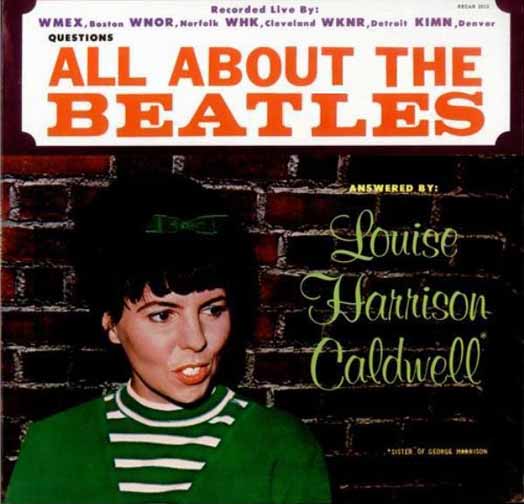
Image from Discogs.com
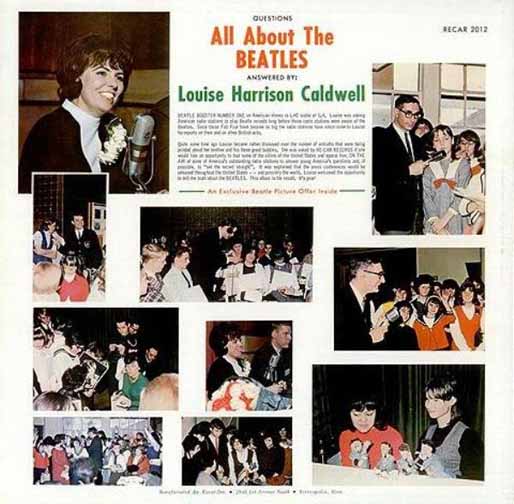
Image from Discogs.com
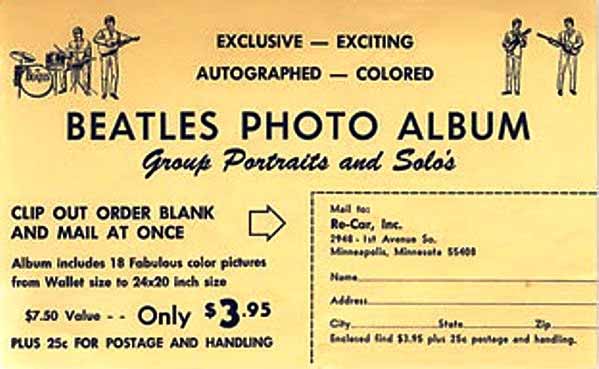
Image from Discogs.com
THE LEAMINGTON MOTOR LODGE
Their not-so-luxurious accommodations were the entire 5th floor of the Leamington Motor Lodge (not the hotel) at 4th Ave. and 10th Street in downtown Minneapolis. Built in 1962, it would have been relatively new in 1965, but it was still a “motel” and not proper digs for our heroes. Decoys were set up at much better billets, but word got out and the place was mobbed with girls trying to get in. Bill Diehl remembered “grown women” climbing up downspouts on the outside of the building trying to get in, with cops pulling them down.

The Leamington Motor Lodge, many years later
Police Inspector Donald R. Dwyer did not mince words expressing his disdain for the mop tops, calling them a “typical traveling troupe,” akin to circus performers. He claimed he’d found a girl in Paul’s room and charged him with making a “false hotel reservation.” Fortunately, the girl was able to prove that she was 21 (and from Cleveland). Dwyer told the Minneapolis Star that “Those people are the worst I have ever seen visit this city,” and in a press conference said “if they did not come [back] it would be too soon for me.”
But Diehl said that he was up there with the Beatles, and that there was no way that, with all the money invested in them, that Brian Epstein would allow them to be involved with the scandal of having girls in their rooms, and that the police lied about what went on. Diehl said that the whole thing was blown completely out of proportion, and when the Beatles said they’d never come back to Minneapolis, Diehl said he didn’t blame them. (McCartney did return, though, on June 4, 1976, with his band Wings. The show at the St. Paul Civic Center did sell out.)
The photo below may have been taken at the infamous LML. In it we see the Beatles with various radio station personalities, including Johnny Canton.
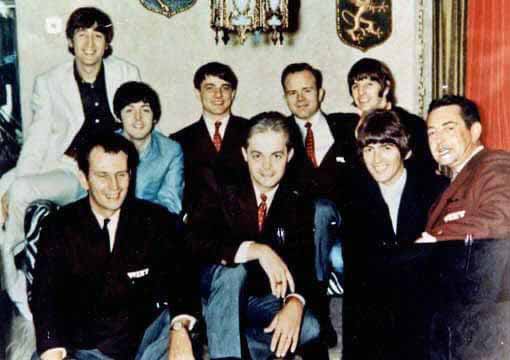
From the personal collection of Johnny Canton
The Leamington Motor Lodge, saturated with the stale cigarette smoke of thousands of traveling salesmen, was mercifully demolished in February 2008, after being used as a homeless shelter in the 1990s.
ESCAPE FROM MINNESOTA
The group emerged from the motel at 11 the next morning. As their chartered Electra airplane headed to Portland, Oregon, one of its engines caught fire while on automatic pilot – apparently the human being pilots were busy Meeting the Beatles. The plane made it to Portland and was replaced by a Constellation aircraft for the rest of the tour. The Electra later crashed in Oklahoma in 1966.
AFTERMATH
After the concert, Big Reggie was heard to say “Their manager just told me this was the best behaved bunch of kids they had played to yet..”
Correspondent Richard reports that “the next day my friends showed me certificates they had gotten that stated that they had seen the Beatles live at Met Stadium. The format of the certificate was loosely based on the format of a graduation certificate.”
Met Stadium was demolished in 1985, and the Mall of America sits on the site today.
In 1995 KSTP-TV produced a video called “The Beatles: Minnesota Mania!” The video includes an extensive interview of Bill Diehl and members of Minnesota bands from that era. It also includes the footage Diehl took of the Chicago show that immediately preceded the Minnesota appearance. The production is now available on DVD from VideoBeat.
B-Sharp Music burned to the ground in May 2005, destroying autographed photos of the Beatles.
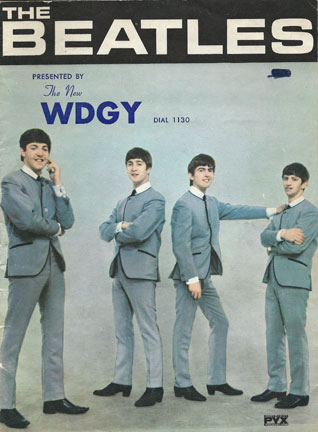
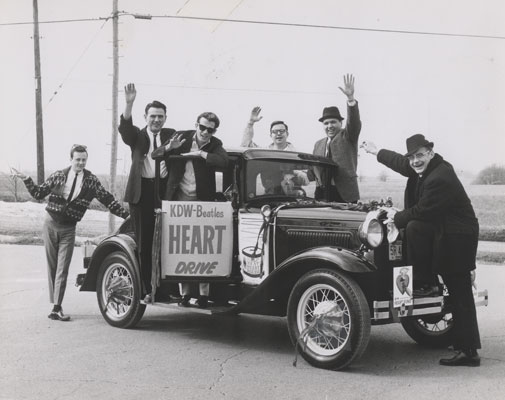
Lou Riegert, James Frances Patrick O’Neill, Don Bowman, Charlee Brown, Sam Sherwood, & Car Owner. Photo courtesy Sam Sherwood
DON’T BE FOOLED
In 1979, Melvin Records released a bootleg EP entitled Visit To Minneapolis, which claimed to contain three songs and the press conference from The Beatles’ 1965 Minneapolis concert. Closer inspection proved them to be excerpts of the Houston performance on August 19, 1965. One giveaway is that the record included the song “Twist and Shout,” which the band didn’t do in Minneapolis because John was having throat problems.
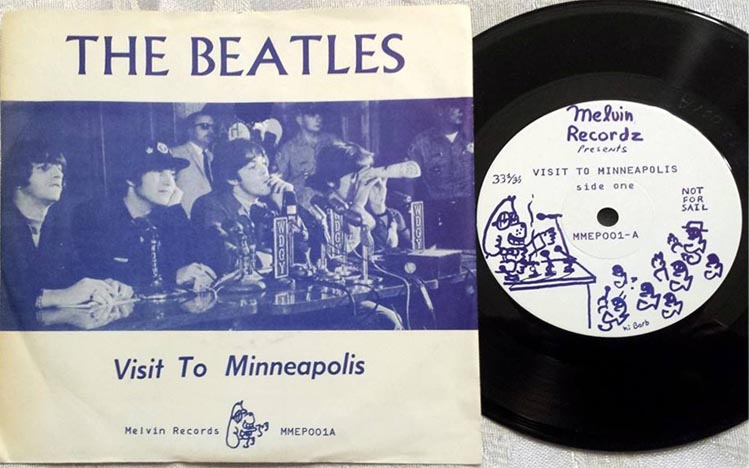
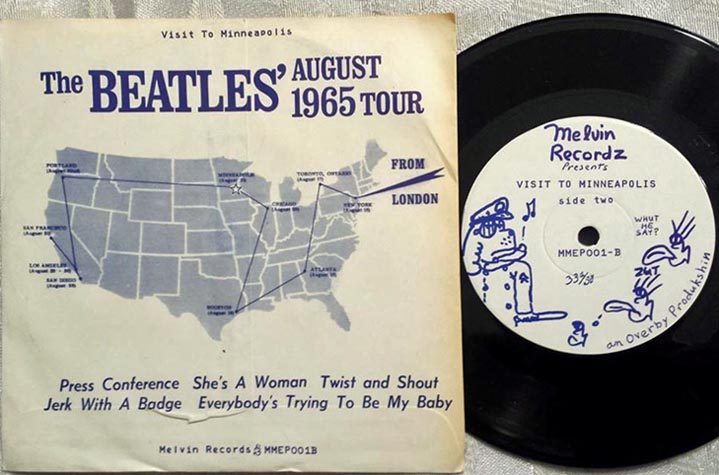
50th ANNIVERSARY
Here’s an article that came out in 2015 about the 50th Anniversary of the concert:
Remembering the Beatles’ concert at the old Met
By Mike Hanks, Sun Current. Published August 26, 2015 at 10:16 am
After five decades, the stories are nearly as legendary as the Fab Four.
Aug. 21 marked the 50th anniversary of the only concert the Beatles performed in Minnesota. The concert, held at Bloomington’s former sports stadium, has provided many famous tales in Minnesota folklore. And plenty of those whose names are attached to the tales are still alive five decades later to share them.
The concert attracted Beatles fans, many female, from around the Twin Cities, and beyond. One of the most famous tales from the concert, however, belonged to a man who had little interest in the lads from Liverpool, and he had no idea he’d have a chance to meet them on Aug. 21, 1965. Never in his wildest dreams did he think he’d spend eight hours of his day hanging out with them as they quietly whiled away the hours prior to their short performance on the field of the former Metropolitan Stadium, now the site of Mall of America.
Ray Crump of Bloomington was 29 years old when Beatlemania swept through Minnesota. Crump knew who they were, but he wasn’t much fascinated by the music or the band that had many teenage girls swooning. Crump was a country music fan. “I didn’t know a whole lot about them,” he said.
Crump’s brush with the Fab Four came because he worked for the Minnesota Twins as the team’s equipment manager. Crump didn’t travel with the team, and he went to the stadium that day to take care of baseball-related business, never expecting to cross paths with John, Paul, George or Ringo.
The band was using the visiting team’s locker room as its headquarters that day, at least that was the plan. When Crump crossed paths with Beatles manager Brian Epstein, however, a deal was struck to open up the home team’s clubhouse for the band, on one condition: Crump would be there at all times. Although the Twins were on the road, team equipment and personal property of the players – stored in their lockers – remained in the clubhouse. Crump was the gatekeeper to all of it and wasn’t about to leave it unattended, he recalled.
Deal struck, Crump would go on to famously spend eight hours with the lads, watching them gamble their shares of the revenue from the day’s program sales and enjoying dinner with them. Crump posed for pictures with each of the band members, and took black-and-white photos of his own as he attended the press conference the band held prior to their performance, at Ringo Starr’s insistence, Crump said.
Crump compares the band to pro wrestlers, the likes of which he had dealt with periodically. Wrestlers were businesslike in the locker room, entertainers in the ring. The Beatles were very similar; they saved their showmanship for public eye, Crump explained.
Crump listened to their show, as best as it could be heard, from a dugout of the stadium. He didn’t know much about them at the start of the day, but by the end of the night he knew “they weren’t going to be a flash in the pan,” he said.
Crump spoke with Starr two years ago. He had contacted Starr, offering to give him copies of his pictures from 1965. Starr called him personally, and remembered the autographed baseball Crump gave to the band, bearing signatures that would soon represent the American League champions. Crump was planning to attend Starr’s concert at Mystic Lake Casino two years ago, but had his leg amputated shortly before the concert and was unable to attend, or present the photos to Starr. He hopes to have a chance to do so this fall when Starr performs in downtown Minneapolis, he noted.
Thousands of fans have stories and memories of the one night the Beatles performed in Minnesota. Many of those stories belong to teenage girls of the 1960s. One of them belongs to Greg Perrine of Conway, Ark., who grew up in Bloomington and worked at the stadium as a 13-year-old.
Perrine was interested in the concert because of all those teenage girls he knew would be attending the show. (By his estimate 80 percent of the fans at the concert were female.) Using his employee badge, Perrine went to the stadium hours before the show and gained entry with his friend Mike. The two spent the afternoon and evening at the stadium, and had perfected a British accent to impress the girls at the concert. It worked, Perrine recalled.
Perrine has vivid memories of several moments from that day. Early in the afternoon he saw a guy signing autographs. The guy looked like Starr, although his hair didn’t appear to be as dark as it did on the album covers of the 1960s, according to Perrine. He saw one of the autographs, and it was signed by Richard Starkey, so Perrine and his friend didn’t think it was Starr. Although the duo was convinced at the time that it wasn’t Starr signing an autograph under his birth name, all these years later Perrine is still not sure whether it was Starr or not.
Perrine doesn’t remember much about the opening acts. The only act he remembers was Cannibal & the Headhunters, as he knew of them from their version of “Land of a Thousand Dances,” he said.
Perrine watched the concert from a camera pit in the upper deck. He borrowed a pair of binoculars from a girl sitting behind him. As he focused in on Paul McCartney, McCartney said “hello” to him as Perrine watched from afar. At least Perrine would like to think so. He suspects thousands of girls experienced a similar moment.
As an opportunistic 13-year-old, Perrine didn’t realize he was going to be part of music history. “It didn’t seem like a historic event,” he said. Although it may not have been the most important night of his young life, it had a profound effect on him, he said. Music has been a part of his life ever since, from performing in garage bands to attending numerous concerts throughout the decades. Nowadays, Perrine can be found in his Arkansas garage in his free time, working on vintage guitars and amplifiers he buys and sells, he explained.
There are thousands of stories from that concert, and Jeanne Andersen of St. Louis Park has collected plenty of them.
Andersen was too young to attend the 1965 concert, but her fascination with the music of the 1950s and ’60 has never waned, and for the past decade she has collected stories about many of the bands that were part of the local music scene back then. Through her chronicling of those stories, she has also dedicated significant time to the Beatles’ performance in Minnesota, which she shares online through her Twin Cities Music Highlights web page.
Andersen’s website illustrates the faded, and differing recollections, of Beatles fans. She has had the fortune of interviewing key figures involved with the promotion of the concert, as well as the two men with differing stories behind the Rickenbacker 360-12 electric 12-string guitar that was presented to George Harrison during the press conference hours before the concert. Andersen’s information about the presentation includes excerpts from emails she received personally from the two men involved in the guitar presentation, and their differing accounts of the incident.
SOURCES
The above information comes from a number of sources, including:
- Interview with Bill Diehl
- Interview with Sam Sherwood
- Article by Jon Bream and Kevin Odegard in the StarTribune
- “Instamatic Memories, The Beatles in Minnesota,” by Steven R. Hoffbeck, Minnesota History Magazine, Spring 2007. Click here to download a pdf of this very well researched article.
Save
Save
By Daniel Holm
The Chancellors band from Minneapolis, Minnesota, was comprised of talented young musicians from the Twin Cities region. Dan Holm, 4110 Upton Ave. S., Minneapolis, Bandleader, played bass and later lead guitar throughout the life of the band. John Hughes, 3819 Glenhurst Ave., on drums and David Rivkin, 3725 Glenhurst Ave., lead guitar, were both from St. Louis Park. Mike Judge, 7309 Union S., Richfield, played rhythm guitar. All participated in vocals and the group was known for its tight harmony.

1965
Dan Holm, playing lead guitar, founded The Continentals. Steve Adams of Minneapolis, rhythm guitar, and John Hughes (before moving to St. Louis Park) on drums, played their first gig at Southwest High School, April 6, 1962.
A newspaper article from the Spring of 1963 states, “During the past school season the Continentals have played for events sponsored by the Southwest high school Indianettes, St. Louis Park High School, Susan B. Anthony Junior High School, and the Bill Carlson television show. Lake Harriet and Minnetonka Yacht clubs, Southwest Activities Council, and Anoka High School have recently had the Continentals play for their parties.”
Tom De Biaso of De La Salle High School came in on bass guitar for the summer of 1963 and John Hughes moved to St. Louis Park. Steve Adams and Tom De Biaso both dropped out of The Continentals that autumn. This opened the door for John Hughes’ neighbor, David Rivkin, to join the band and Mike Judge to come in shortly after.
First performing as The Continentals, the group changed their name to The Chancellors in 1963 due to a redundancy of the Continental name in the local market. The Chancellors remained popular, playing the upper Midwest into the early 1970s. In 1965 they graced the cover of local music magazine Twin City a Go Go.
Represented by St. Louis Park residents Ira Heilicher, 4241 Basswood Road, and Dick Shapiro, 4440 W. 25th St., The Chancellors were the first group that the partnership of Path Musical Productions Company (later, Central Booking Agency with Bill Diehl) approached. Path Productions produced The Chancellors’ October 13, 1964, recording session at Kay Bank Studio in Minneapolis that yielded “Little Latin Lupe Lu,” “YoYo,” “So Fine,” “Surf Beat,” “Charlie Brown” and “I Can Tell.”
“Little Latin Lupe Lu/YoYo” was released under the Soma record label, owned by Amos and Daniel Heilicher, in the United States and on Apex records in Canada.
The Chancellors’ cover of the Bill Medley classic debuted on the WDGY Tiger Survey chart December 26, 1964, climbing to #1 in Minneapolis on January 23, 1965, and remaining at #1 for 3 weeks. “Little Latin Lupe Lu” was listed on the WDGY and KDWB Minneapolis “Top Forty” for 11 weeks. The recording also listed in the “Top Forty” in Chicago, Kansas City, Omaha, and St. Louis radio markets.

January or February 1965
“YoYo,” written by Mike Judge in the American “Rock-a-billy” style, was included on the German album “Eagle 301” in 1975, and the Belgium album “Inferno 1001” in 1988 (reissued on CD in 1996).
The “B” side of “So Fine,” written by James Gribbles, was “ I’m A Man” by Ellas McDaniel (Bo Diddley), recorded by The Chancellors on May 12, 1965, and released the same year. “So Fine/I’m A Man” also reached the “Top Forty” on Mid-America charts.
Several of the The Chancellors recordings were included in the compilation album “The Big Hits Of Mid-America Volume II,” on Soma Records, released in 1965 and “The Big Hits of Mid-America, The Soma Records Story 1963-1967,” CD format, on Plum Records, released in 1998. Also in 1998, Sundazed Music, Inc. of Coxsackie, NY, distributed “The Soma Records Story Vol. 1, Vol. 2 and Vol. 3.”
On May 3, 2008, the Mid-America Music Hall of Fame (formerly known as the Minnesota Rock/Country Hall of Fame) inducted original members Holm, Hughes, and Rivkin. Mike Judge, who died on July 11, 1996, was inducted posthumously. Ron Butwin of St. Paul, Minn., who replaced John Hughes when Hughes entered military service in May of 1966, was also inducted. Kevin Bowe, rhythm guitar, performed with Holm, Hughes, and Rivkin at the Hall of Fame.
David Rivkin, lead guitar with The Chancellors for three years (9/63-9/66), was also recognized at the 2008 Mid-America Music Hall of Fame for Lifetime Achievement in the music industry.
Subsequent members were Ralph Burger, lead guitar; Jim Farragher, drums; Bruce Bartl, keyboards; Jerry Harvieux, bass; John Rawson, bass; and Cheri Thorne, vocalist. Doug Ahrens performed with the group as a substitute drummer. Woody Woodrich occasionally filled in on guitar.
The Chancellors disbanded at the end of 1967. Dan Holm resurrected the group with original drummer John Hughes for one year from May 1971 to 1972.
Holm, Hughes, Rivkin, and Judge played a reunion performance at the Medina Ballroom in 1982.
John Hughes died from Covid at 2:15 pm on Sunday, January 3, 2021. His wife Elaine, his niece Sandy and her husband, and I were in his room at the VA Hospital Covid unit when he passed. He was the greatest drummer I ever worked with in 25 years. He will be missed. Dan Holm
Save
Save
Save
Save
Save
Save
I don’t usually cover bands; that falls to Tom and Denny at www.minniepaulmusic.com The exceptions are those from my home town of St. Louis Park, Minnesota!
Members of the band included:
-
- Cliff Siegel (aka “Little Cliffie” Stone): Lead Singer. Cliff was often described as a cross between Mick Jagger (Rolling Stones) and Eric Burden (The Animals). He lived at 3108 Louisiana in the Park and was in the Class of 1964. Cliff has become Lauren Siegel and worked at KARE 11.
-
- Rick Levinson: Rhythm Guitar – 4216 W. 25th Street, Class of 1966. The name the High Spirits was born during a conversation in Rick’s kitchen. Also billed as Rick Anthony, he left the group in 1966 and went on to become a doctor. With fellow physicians, Rick went on to form a very successful Minneapolis band called Dr. Rock.
-
- Bob Cohen: Lead Guitar. Bob was from Golden Valley. He replaced Rick Levinson in 1966. He had been in the Vigilantes with Rick Beresford and Randy Resnick. Bob lives in L.A. and continues to be a technology wizard.
-
- Owen Husney: Lead/Rhythm Guitar – 2580 Vernon Ave., Park High class of 1965. In 1967, Owen switched to bass to accommodate the addition of lead guitar player David Rivkin. Owen became a music publisher and the man who discovered and managed Prince. He continues to be a very successful executive in the music industry with Warner Brothers.
-
- David Rivkin: Lead Guitar – 3721 Glenhurst, Class of 1966. David had come from the Chancellors in 1965 and left the High Spirits in late 1968 to join Stillroven. David sang backup on the High Spirits’ “(Turn on Your) Love Light” while still with the Chancellors.
-
- Doug Ahrens: Drummer. Doug was from Southwest Minneapolis, Class of 1965. Prior to the High Spirits, Doug had been in a band with Mike Judge, who went on to be a guitar player/singer for the Chancellors. In 1967, Doug went into the National Guard and was replaced by Brad Burgeson.
-
- Jay Luttio: Keyboards. Jay was from South Minneapolis, Class of 1965. Jay sang backup on all High Spirits records. Jay has always been the ultimate keyboard guy, able to transition from Piano Lounge entertainer to solid blues keyboarding in a nanosecond. He became a successful financial accountant.
-
- Rick Beresford: Rick used the name Rick Becket, and was from Edina, Class of 1966. he and Bob Cohen had been in the Vigilantes, along with Randy Resnick, who lived on 25th Street around the corner from Owen Husney. Rick joined the group in April 1965 at the age of 16, playing bass and singing harmony. He left the High Spirits in 1967. Rick has continued to play music and is currently in a Minneapolis band called the Blues Benders with two of his sons.
-
- Frank Prout: Bass – 5201 W. 28th Street, Park High class of 1964. Frank had been a member of Gregory Dee and the Avanties, and joined the High Spirits in late 1966. He left the group in 1967. Frank passed away in July 2017.
-
- Tim Millette: Tim was the original bass player; he left the band in the spring of 1965 to join the Lords. Tim writes:
I also played with Jojo Smith, the Deep End, and others. My longest lasting gig was with the Fabulous Wanderers, with Tinker Todd, Phil Lamont, and Bruce Norstad, who was inducted into the Rock/Country Hall of Fame with Damon Lee and the Diablos. I also worked with David Anthony, Bill Roslansky with Stagefinders, and Marsh Edelstein with Marsh Productions. Bill and I ran for a long time the Barn, later to be called the Purple Barn. Bill and I also worked together at His and Hers (in the Foshay Tower), Young America (local clothing store for men), Nic-O-Lake Records (where a lot of records were made in the basement. If recalling it correctly I think Dave Dudley recorded “Six days on the Road” there. I also was the bar manager for Bill, Stu Swartz (father I think owned part of Channel 9) and Dean Constantine who had a dance show, I think on Sunday mornings. We finished our last gig as the house band for Pudge’s on Ford Parkway in St. Paul when they first opened. We played some at the old CC Tap, Papa Joe’s on Northern, Crest a Go-Go in Fairbault for many years, and countless bars in the metro area. We did have a hit with “Road Runner,” but once I realized I wasn’t going to be a star, it was time to start a regular job.
The High Spirits’ first hit was a raveup of Bobby “Blue” Bland’s “(Turn on Your) Love Light,” recorded on May 7, 1965 and issued on Soma Records. The B side was “Tossin’ and Turnin,” recorded at the same session. Rick London, the group’s manager, says that the session cost $500, borrowed from Cliff’s uncle. “We paid him back with the royalties and had enough left over for one more recording session. It was a three track studio at the time and we went from turning on the lights to cutting the master in just a few hours.” Rick played tamborine on the session. The record did well in the Twin Cities, and hit Number 1 in both Kansas City (the band performed in KC on two occasions) and Dallas during the fall of 1965, and also was beginning to do well in California. A Top 40 chart from San Jose in September 1965 showed that the record was ranked Number 33 in that market.
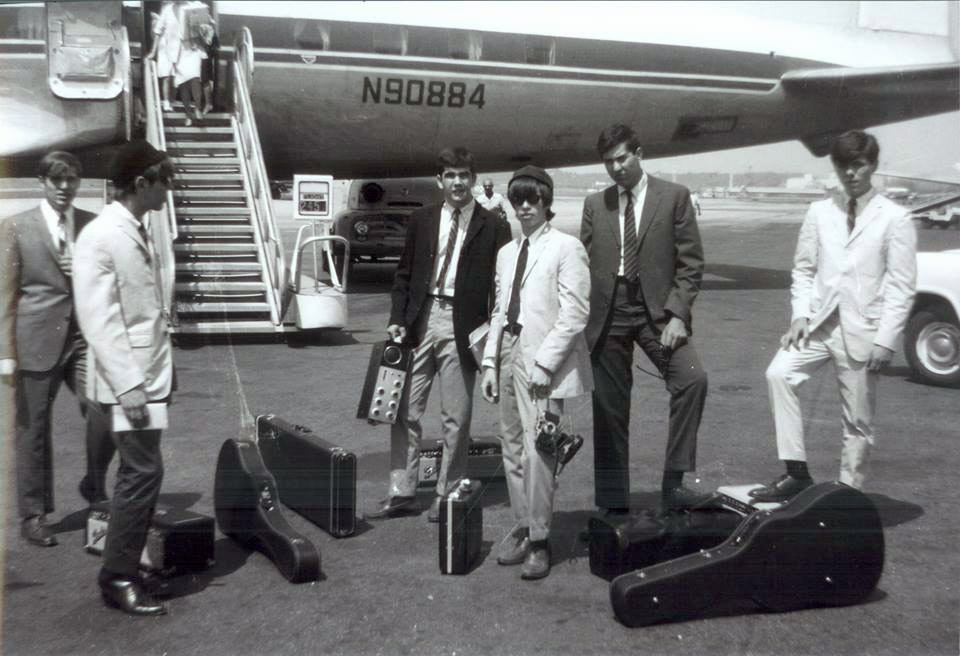
The High Spirits in Kansas City, October 1965
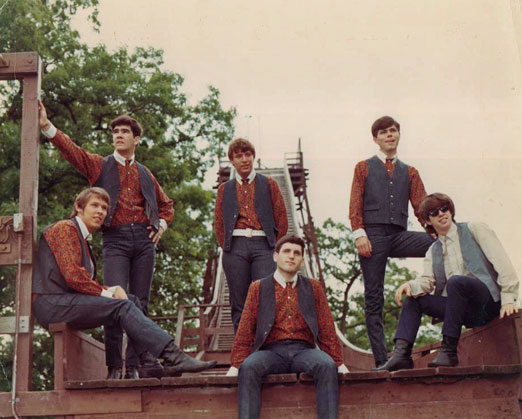
Photo courtesy Owen Husney
Their second release was “I Believe” (not the Frankie Laine song), recorded on January 12, 1966, and released on Soma. It was written by rhythm guitar player Rick Levinson. The flip side, recorded at the same session, was “Bright Lights, Big City,” a cover of a Jimmy Reed/Animals tune. The record did not do so well, and manager Rick London was replaced by Ira Heilicher.
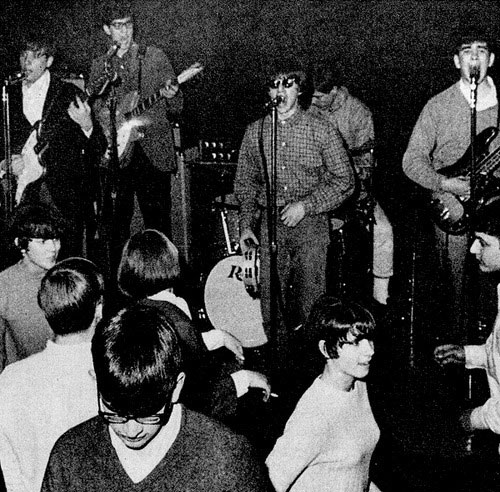
Photo above is from a 1965 newspaper feature on the bands of the Twin Cities.
The High Spirits were not so high-falutin’ that they were above playing the Class of 1965’s All Night Party or Park High’s Tropical dance on April 30, 1966! Good for you, boys! The photo below from Steve Lutjens may be from one of those early appearances.
-
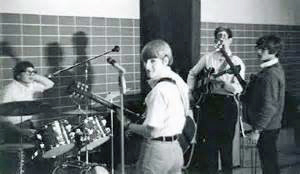
From Rick Beresford:
Doug Ahrens and I reformed the band in 1968 with some musicians including Tom Hopp, now a country music writer from Steamboat Springs. We played for another year before the High Spirits finally folded altogether in 1969. However, many of the original High Spirits started playing reunion gigs in 1984, 1998, and 1999. We performed at the Medina Ballroom, the Fine Line, the Cabooze, and Mills City Music Festival. We played the reunion gigs with many of the original Twin Cities bands from the ’60s including Gregory Dee and the Avanties (the first group Frank Prout played in), the Chancellors, the Trashmen, Underbeats, Del Counts, Canoise, the Litter, and the Castaways. It was great to renew acquaintances again.
In 1968 the band took on a more psychedelic tone.
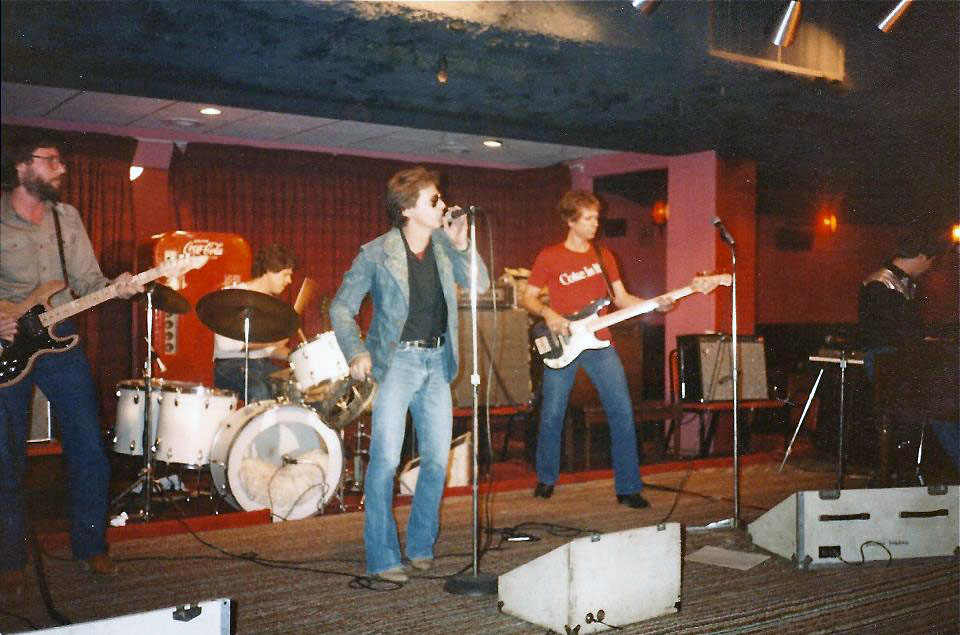
High Spirits Reunion, 1982
The music of the High Spirits can be found on the “Big Hits of Mid-America” compilation of Soma records.
On May 26, 2006, the High Spirits were inducted into the Minnesota Rock/Country Hall of Fame.
50th REUNION!!
On August 29, 2015, the band had a historic reunion at the St. Louis Park Class of 1965’s 50th Reunion and tore the place apart! All six original members were present! See the video Here. And see Jon Bream’s story in the StarTribune Here.
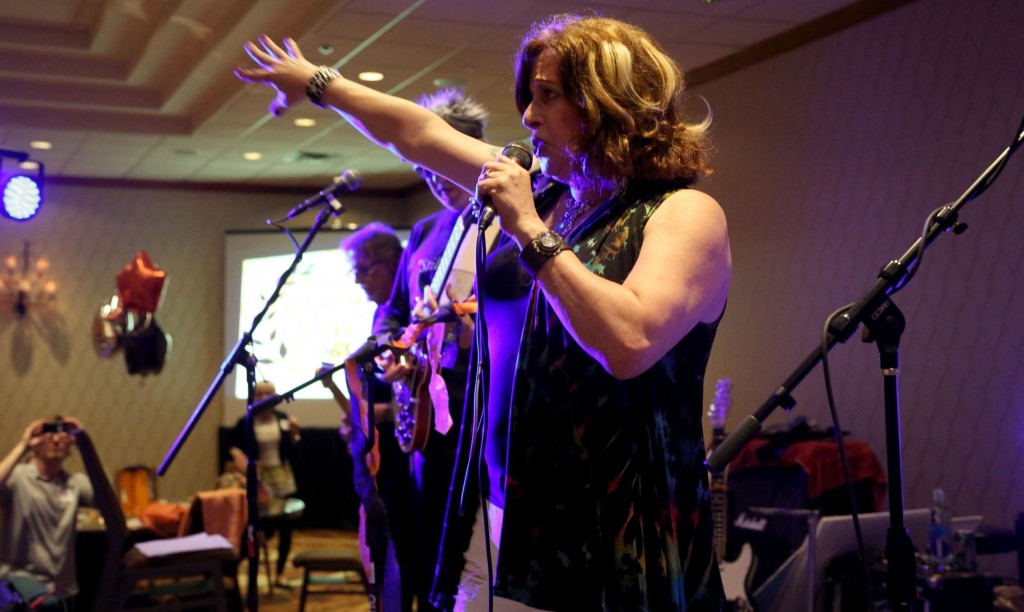
Photos above and below by StarTribune photographer Kyndell Harkness.
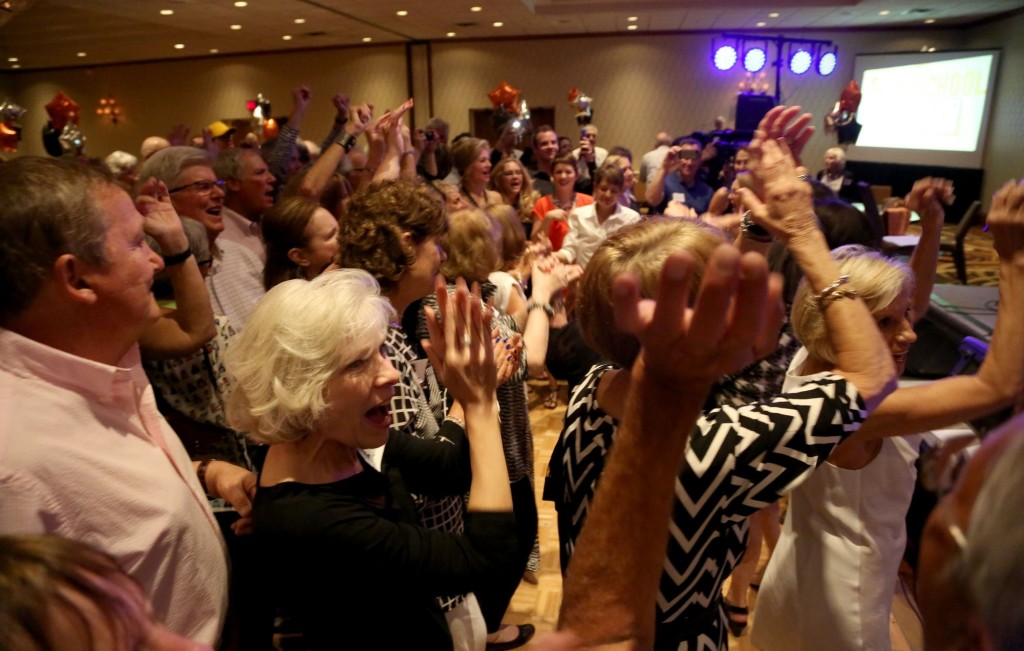
Can you spot me in this picture?
Top 40 Charts from Minneapolis and Denver show the popularity of “(Turn On Your) Love Light.”
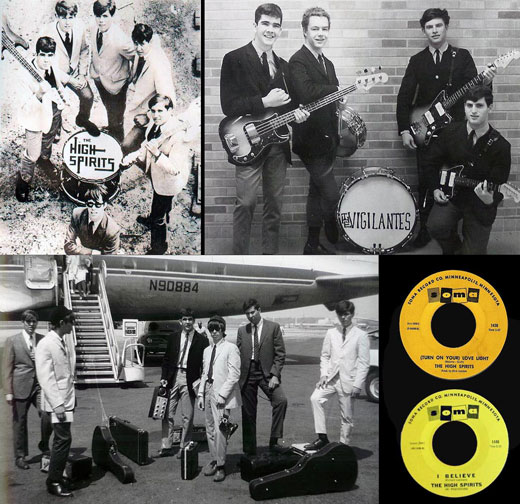
Collage courtesy Timothy D. Kehr
Timothy D. Kehr wrote:
- The “sound of The Spirits” is created by six hard-working, dedicated young artists. Seventeen year old leader Rick Anthony is the youngest, largest (6’4″) member. He plays rhythm guitar, sings bass, and does most of the writing and arranging. Eighteen year old bass player Rick Becket [Beresford] also sings high harmony and falsetto and writes an occasional tune. Classically trained on the cello, Rick sets down The Spirits arrangements on paper. Versatile eighteen year old John Paul Luttie plays seventeen instruments, including his electric organ. Lead guitarist Owen Husney is also eighteen. He credits his unique sound to sweater fingers and natural reverberation. Drummer Doug Ahrens, also eighteen, lays down the hard sound that rounds out the High Spirits instrumentally. Nineteen year old “Little Clifford” Stone is the oldest and teeniest (5’4″) “Spirit.” He has been singing since the age of nine, and has a repertoire of more than five hundred songs. The High Spirits acknowledge a dept to the Rolling Stones, Animals and Chuck Berry for their inspiration, but the “sound of the Sprits” is theirs alone. It’s sure to keep exciting the airwaves and tantalizing dance halls for years to come.
Save
Save
ME AND THE MONKEES
Okay, I love Minnesota music, but my favorite band is still the Monkees. Can’t help it – I was 10 years old in 1967. I didn’t buy Tiger Beat and only had one of their albums, but somehow my parents let us watch the show, which was hilarious when you’re 10. Mike Nesmith was my favorite Monkee – he was tall, serious, and smart, and I guess I related to that. Don’t know if I knew that he was married and had a kid. Much later in life I got the Monkees Music Box and got more familiar with their repertoire, especially Mike’s twangy story-songs. Very un-Monkee-like, but very cool.
I saw them in:
- Baltimore in 1986, on the heels of their comeback and the re-running of their shows on MTV. I recorded them all on my VCR!
- Baltimore in 1987
- DC in 1989
- Micky solo on a package tour in DC in 1991. He did not look happy but there were only about 20 of us. It was an outdoor amphitheater and it poured rain before and after, but cleared up just for the show, which included some incredible acts. He would not sing my request, which was “Sometime in the Morning.”
- The great 930 Club in DC. We had been to Wolftrap in Virginia to see Dylan and then sped like the wind back to town to see the Monkees second show. Amazing!
- 2012 at the State Theater in Minneapolis – described in excruciating detail below.
- 2021 at the State Theater in Minneapolis – their Farewell Tour with Micky and Mike.
MONKEES IN MINNESOTA
The following is a list of the shows the Monkees performed in Minnesota, as much as I could assemble. Please contact me for any additions, corrections, or stories.
1966
The Monkees hit the TV airwaves on September 12, 1966 at 7:30 pm, as attested to by this page from the Minneapolis-St. Paul edition of the TV Guide. Most of us remember the show in Saturday morning reruns, but it was a prime time show when it premiered!
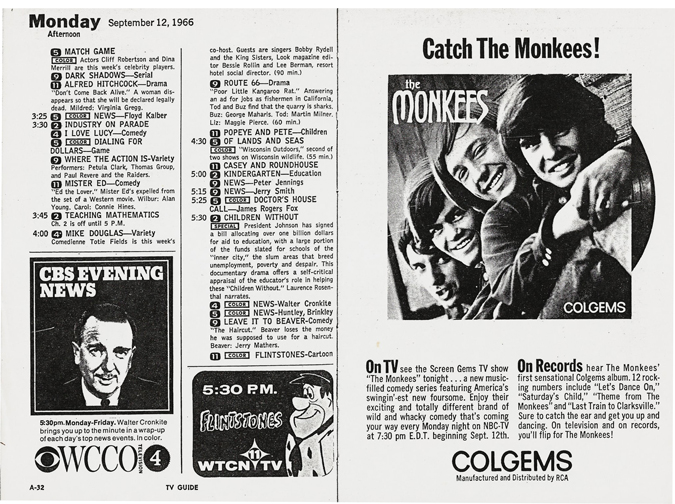
Image courtesy Jeff Lonto
The Monkees were a phenomenon, although perhaps guys didn’t wear Monkee boots like they wore Beatle boots. And certainly they didn’t wear those double buttoned shirts, did they? What about this gear?
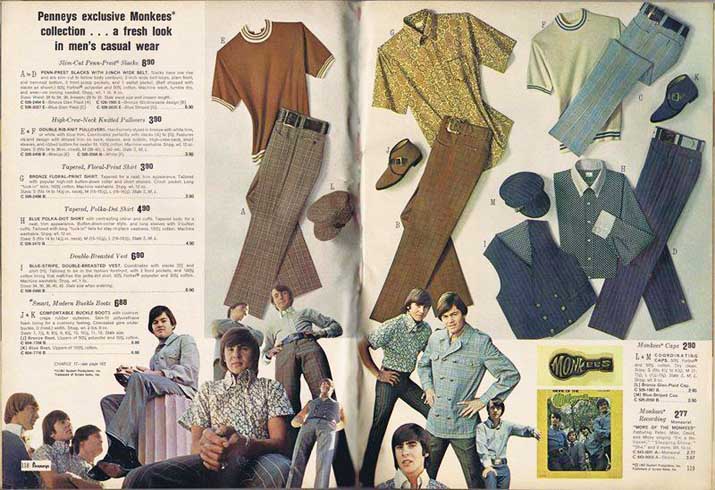
Monkeewear from the Penneys catalog
1967
Not exactly in the Twin Cities, but close enough, Will Jones reported on August 3:
The younger set in Hayward, Wis., still hasn’t quite simmered down after a surprise visit last weekend from The Monkees… The Buffalo Springfield were appearing in the Big Top tent at Tony Wise’s Old Hayward layout last Saturday night. Earlier, they had appeared in Chicago, where The Monkees also were appearing, and the two groups had partied together there.
The Monkees decided Old Hayward would be a gassy place for another party. So after their appearance in Chicago Saturday, they flew to Duluth in a chartered DC6 – the band, their road managers and agents and assistants and girl friends, a party of 26 in all. From Duluth they chartered a Greyhound bus and roared to Hayward with a police escort.
They arrived for the tail end of the Springfield’s bash in the tent, and then continued with a late jam session in the tent. They took over the old train that is parked at Old Hayward serving as a restaurant and bar, partied there all night, slept in the Pullman, and breakfasted the next day on such delicacies as corn flakes drenched in orange juice before taking off.
KDWB TAKEOVER
Race riots and curfews in Milwaukee brought the Monkees to Minneapolis a day early, so on Friday, August 4, 1967 [right after our own race riot], KDWB arranged for them to take over the airways on the afternoon before their concert at the St. Paul Auditorium. A remote was set up at their hotel, the Capp Towers Motor Hotel at 9th and Minnesota in St. Paul. Although the location was announced as “Secret City,” there was a crowd of screaming girls outside listening to their transistor radios.
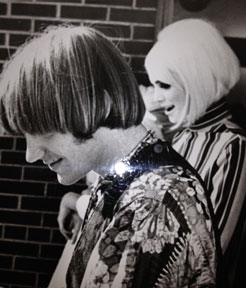
Photo copyright Mike Barich
On hand were DJs Jimmy Reed and Charlee Brown, and General Manager Sam Sherwood. Photographer Mike Barich was there with his girlfriend Vicki Peters, shown above with Peter Tork in a photo taken by Barich. (Victoria Peters was from West St. Paul and was Miss October 1972.) Barich remembers that they were listening to rival station WDGY over their transistor radios, a fact Mike picked up on and mentioned during the broadcast.
It appears that Mike Nesmith started at 2pm, and he would tell the kids outside to scream on cue. Mike (and apparently everyone) called KDWB the “Dirty 630” and had fun at the expense of the ads, including sacred Dayton’s – it was meant to be satiric, I suppose, but comes off a little mean. Peter Tork took over at 5 and played some groovy tunes and B-sides. Somehow the subject came up that he had been kicked out of Carleton College. Davy Jones was on for a nanosecond, and Micky Dolenz took on the serious topic of the Monkees playing their own instruments. It is now 15 Monkee Minutes past the hour. They seemed to genuinely enjoy being DJs for the day. At 6, a very excited John Hamilton took over for Tac Hammer as the gang headed out to the concert.
Back in St. Louis Park, Phil Kitchen recorded over four hours of the show on his reel-to-reel. That material, with additional material from their arrival at the airport provided by Curt Lundgren, is available Here.
Interesting were the musical ads by big stars, including Spencer Davis for Great Shakes. Ray Charles and Los Bravos each did ads for Coke. A frequent ad was for Dad’s Root Beer: “That’s My Pop!” But someone explain why KDWB would advertise a Ray Conniff album? For that matter, why is a Ray Conniff album on the wall of the “A Date With Dino” set?
LEAPING, SCREAMING TEEN-AGERS CHEERED ROCK GROUP
Opening the concert were Australian pop star Lynne Randell and New York band Bobby Dick and the Sundowners (Google them!). Mike played the Sundowners’ song “Always You,” which was very Association-like. Over 15,000 Monkees fans attended the concert (the Minneapolis Tribune’s Brian Anderson reported 10,800.) Anderson’s review relied mostly on the opinions of 16-year-old Keith Follese, a member of the local group the Youngsters. The review was much like that of the Beatles’ visit in 1965, with remarks about how the screams from the audience drowned out the music.
Micky Dolenz did “some sort of strange, unintelligible impersonation” which Keith though was some rat from King Leonardo’s cartoon show. Peter Tork sang a song that sounded like “Jimmy Crack Corn” – “Keith didn’t know what it was either, but agreed it was ‘a mess.’ Monkee Mike Nesmith then poured a bucket of paper (ha-ha) over Monkee David Jones to the delighted screams of the early and pre-teens.” They flashed movies of their zany antics interspersed with scenes from the Alabama freedom rides. All agreed that the screams prohibited judgment of their proficiency and probably was responsible for a bunch of mistakes. Oh well, who cares??
A Facebooker remembers: “I saw the Monkees when they were at the Roy Wilkins auditorium. I remember the bucket of paper being “poured” over Davy. Davy then took off his shirt and everyone screamed. Oh, how fun it was being young.”
Another Facebooker, Paul Zafke, posted his ticket!
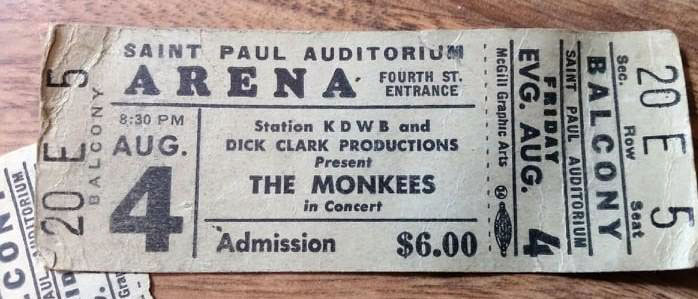
MIKE BARICH WAS THERE!
New in 2021 are the photos below, recently scanned after resting in Mike Barich’s basement for 50 years. He probably took them to be included in the Insider, but to my knowledge they were not. Thanks, Mike!
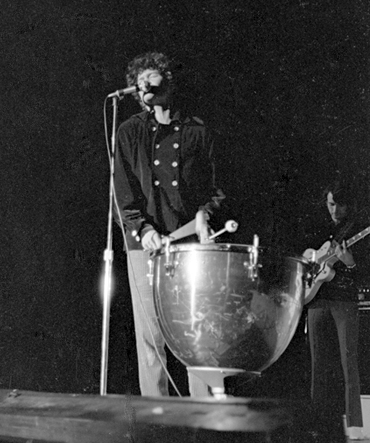
Micky, probably doing “Randy Scouse Git.” Mike on the right. Photo copyright Mike Barich
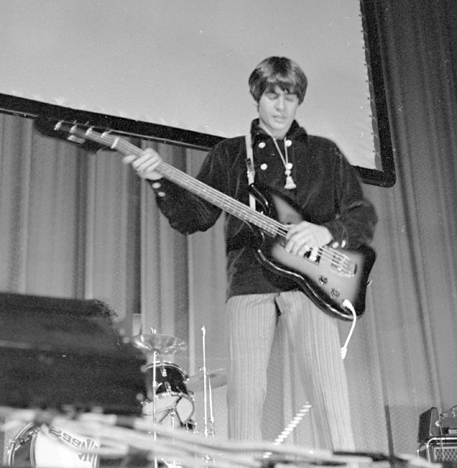
Davy on Bass. Photo copyright Mike Barich
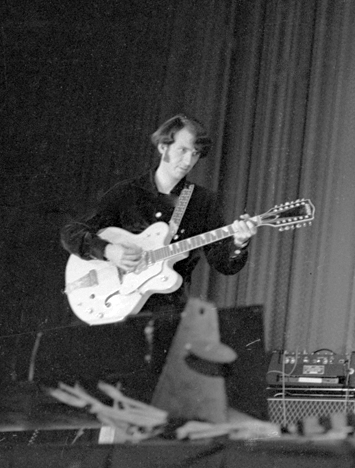
Mike, sans Wool Hat. Photo copyright Mike Barich
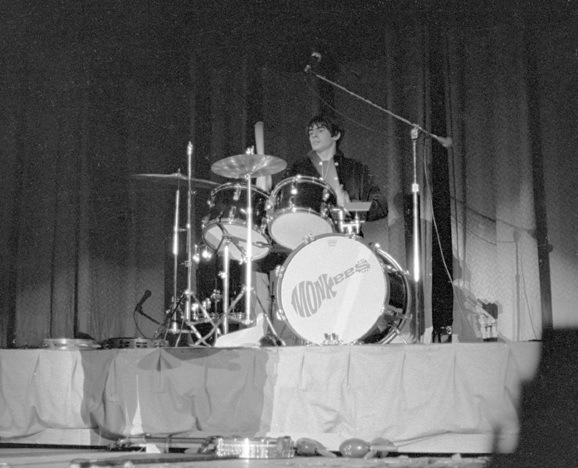
Davy on the iconic Monkees drums. Photo copyright Mike Barich
WHERE WAS JIMI HENDRIX?
An oft-repeated story is that Jimi Hendrix once opened for the Monkees. Was that really true? According to this article in Mental Floss magazine by Kara Kovalchik, published on July 17, 2012, it was, and Jimi was supposed to have come to our town.
It sounds like an elaborate joke today: legendary acid rock guitarist Jimi Hendrix working as the warm-up for a teenybopper group like The Monkees? But back in 1967, the pairing actually made a little bit of sense for both acts.
Micky Dolenz was the first Monkee to “discover” Hendrix; while visiting New York in the spring of 1967, a friend advised him to check out this amazing musician in the Village who played the guitar with his teeth. Dolenz was impressed but didn’t remember the guitarist’s name until he saw The Jimi Hendrix Experience onstage at the Monterey Pop Festival several months later. The Monkees were about to embark on a U.S. concert tour and Dolenz strongly recommended hiring Jimi Hendrix and his band as their opening act. Peter Tork and Michael Nesmith supported the choice; both were anxious to be accepted as serious musicians and believed that Hendrix would lend them some credibility among rock critics and older record buyers. “Besides,” Tork would later say, “it would give us the chance to watch Jimi Hendrix perform night after night!”
Jimi, on the other hand, thought The Monkees’ music was “dishwater,” but his manager convinced him to sign on for the tour. Hendrix already had three hits in England but was virtually unknown in America. His manager wanted to capitalize on the buzz generated by his client’s Monterey Pop performance, and The Monkees were just about the biggest act in the country at that time. What could go wrong?
Plenty, as it turned out.
The Monkees’ young fans were confused by the overtly sexual stage antics of Hendrix, and when he tried to get them to sing along to “Foxy Lady” they stubbornly screamed “Foxy Davy!” The Jimi Hendrix Experience played just eight of the 29 scheduled tour dates; then, on July 16, 1967, Jimi flipped the Forest Hills, Queens, New York, audience off, threw down his guitar and walked away from Monkeemania.
INTERVIEW WITH MONKEE MIKE
On August 5, 1967, the day after the concert, an interview appeared with Mike and Brian Anderson in the Tribune which was held just before the concert. It was most distressing to a Monkee fan. He called Monkee music “inane, banal,” and “tripe,” saying that the Beatles is where to go for good music. “Our only point is no point.”
“These 13-year-old kids just want to use us for growing up, and that’s fine with us. God willing, they will have forgotten about us by the time they’re 20, and that’s the way it should be.” When asked about the future, he predicted that the group would go on for about three years, the kids they’re playing for now would grow up, and they would make way for a new group. The kids may not remember us, but they’ll know there was something that brought them some fun back in their teens.” [Be sure to see my comments on their 2021 Farewell Tour below.]
Nesmith said that the guys on TV were the same guys in real life. The TV show made no sense, and the guys would do anything for a gag. He also said that the audience at their shows only hear a “rumble” on stage, but they try to spice it up a little with movies, costume changes, and other diversions. “These kids have been cheated so many times by groups who just play for 12 minutes, that we want to give them a real show.”
LIQUID PAPER
The article did mention that Mike was “super-rich,” with seven cars and a Lear jet. This was all Monkee money. Once he quit the Monkees, things weren’t so easy. But as many people know, his mother, Bette Nesmith Graham, was the inventor of Liquid Paper, in Texas in the 1950s. She sold the business to the Gillette Corporation in 1979 for $47.5 million and ongoing royalties. She died in 1980 and Mike got his inheritance of $25 million at that time. In 2000, the Liquid Paper product and brand name was acquired by Newell Rubbermaid (now Newell Brands).
1969
The Duluth News Tribune blog tells us: The first time [the Monkees came to Duluth] was on Sept. 6, 1969. They performed twice at the Duluth Auditorium. A story that ran the next day said, “The afternoon audience was small but enthusiastic. Attendance in the evening was better, and Arena-Auditorium officials said 3,806 youngsters in all saw the group. “Earlier in the day, Superior police had to disperse a crowd of young girls — about 200 — who had gathered near the motel at which the group was reportedly staying. They were disappointed. The Monkees already had left for their afternoon show.”
1975
The Monkees made a sweep through Minnesota in 1975, with stops at:
- The Bel Rae Ballroom on June 22, 1975
- The Gibbon Ballroom on June 26, 1975
- The Paradise Ballroom in Waconia with Butch Automatic and the 4-Speeds, on June 27, 1975
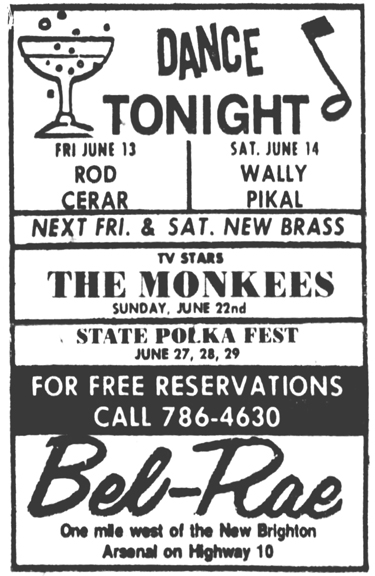
Minneapolis Star, June 1975
They must have had a good time at the Bel-Rae, because they came back on Christmas Day, 1975.
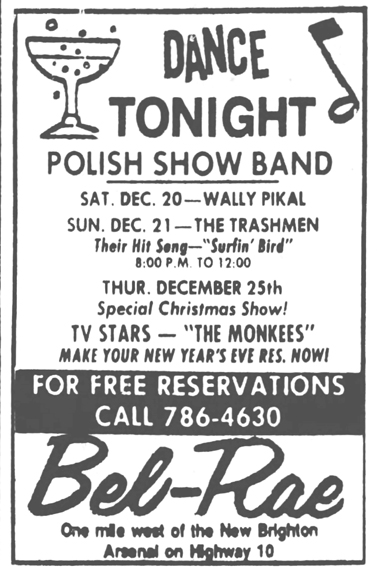
Minneapolis Star, December 1975
1986
The Monkees’ first reunion (without Mike Nesmith) was in 1986. It was their 20th Anniversary, and reruns on MTV had made them a hot property again. They embarked on an 86-city concert tour, stopping at the Carlton Celebrity Room in Bloomington. (The Mall of America sits near that site now.) One show turned into three, on August 20-22. Jon Bream of the Strib gave his approval, sprinkling words like “goofy” and “zany” liberally into his review.
Also on the bill were Gary Puckett, Herman’s Hermits (without Peter Noone), and The Grass Roots (with Rob Grill).
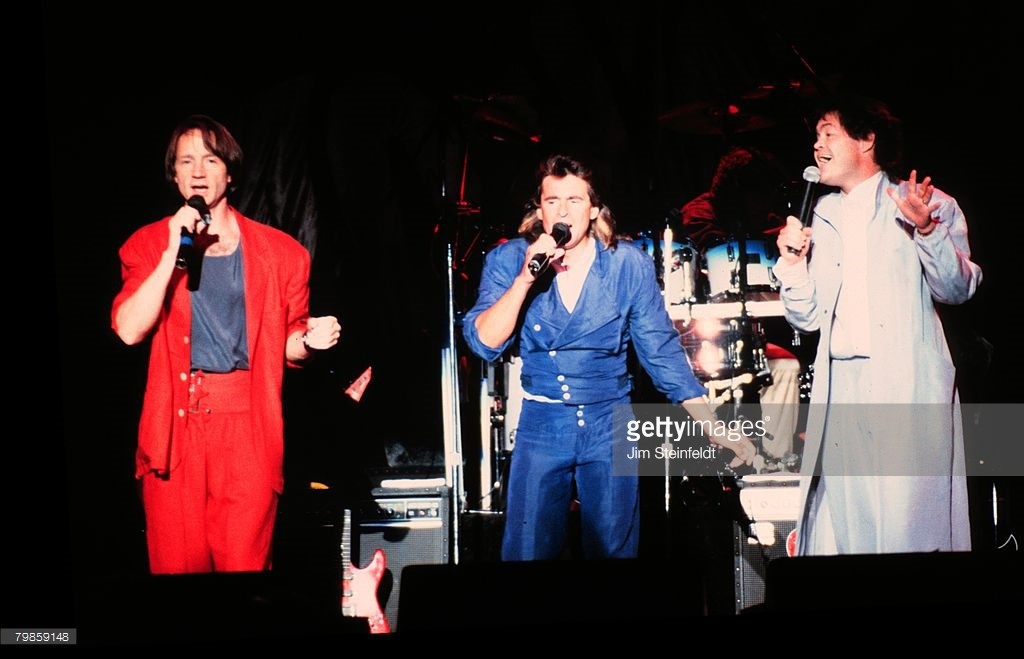
Photo taken by Jim Steinfeldt
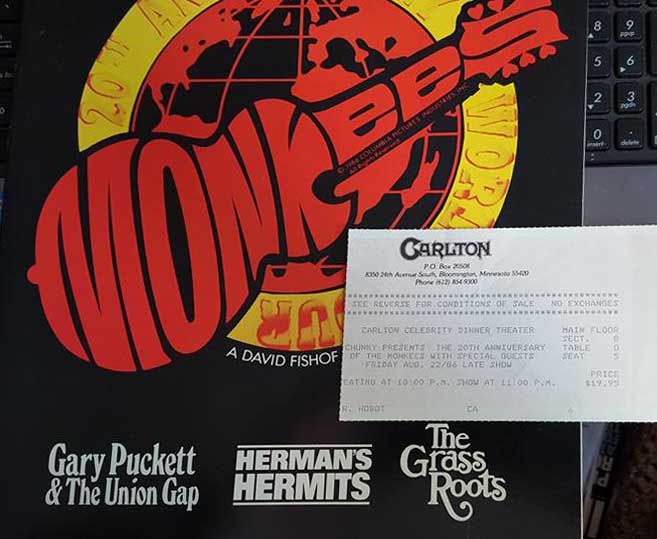
Kerri Carlson posted a picture of her program and ticket on Facebook.
The show came to Duluth on November 9, 1986.
1987
The Monkees appeared at the State Fair, on the Grandstand on August 30, 1987, with Weird Al Yankovic, two shows. The Strib’s review said that the trio cut down on the antics and concentrated on their music, which seemed “misguided and disappointing to fans,” but the approach also misfired because the singers were “overpowered by their nine backup musicians.” (September 4, 1987)
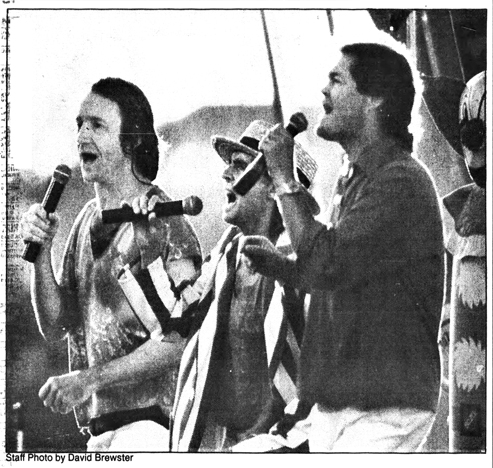
Minneapolis Tribune, August 31, 1987
1997
The Monkees performed at the State Theater on August 9, 1997. (I couldn’t verify this.)
2011
Micky, Davy, and Peter toured in 2011, appearing at the Weesner Amphitheater at the Minnesota Zoo on July 1 and 2, despite the fact that a government shutdown had closed the Zoo to the general public. After an initial 25 minutes there was an 80 minute rain delay, but they resumed for another 55 minutes. The delay cut their set list from 37 to 23 songs, but nobody was complaining, reported StarTribune music reporter Jon Bream, who generally gave the concert a good review.
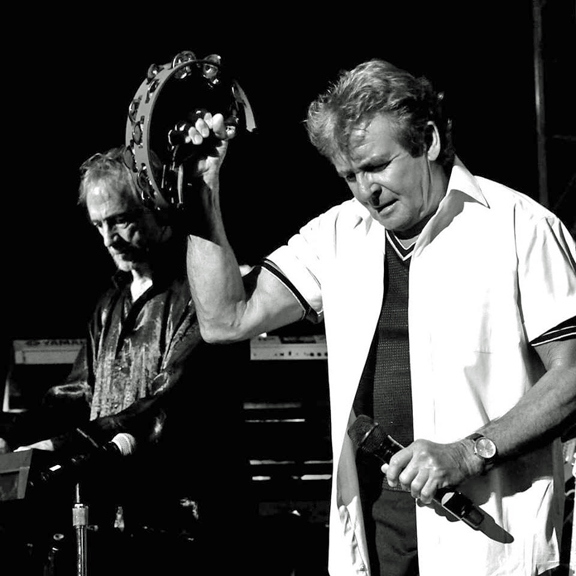
Peter and Davy at the Zoo, July 1, 2011 – Photo courtesy Steven Cohen
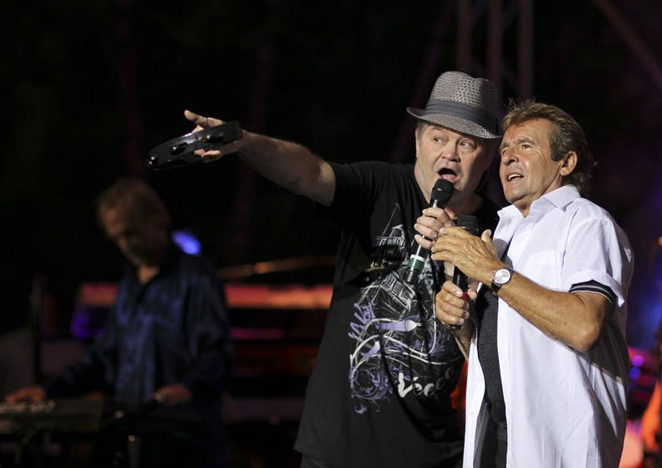
Minneapolis StarTribune, July 5, 2011. Photo by Jeff Wheeler
2012
Jon Bream was not so impressed with the 2012 Happy Together tour at the State Fair on August 27, 2012, which included Micky as a solo act.
THE MONKEES WITH MIKE AT THE STATE THEATER, 2012
The Monkees concert on November 12, 2012, at the State Theater in Minneapolis was Pre-Fabulous!! Perhaps it was because they had fun here in 1967 that the Monkees made Minneapolis one of only 12 shows on their historic 2012 tour. Davy Jones had died of a heart attack on February 29, and Mike finally decided to join Micky and Peter for a reunion tour. Here are my observations from this landmark show:
- Their show was met with screams after every song. I got my Primal Scream therapy out of the way for the next year. I pity our neighbors. And Steve, although he said he had a good time. He was 17 in 1967..
- The audience was decidedly gray, but there were lots of people of all ages there too.
- There was only one guy at the merchandise table and he was swamped, taking in money hand over fist. T-shirts were $35 and “programs” were $25. I say “programs” because they were pretty much worthless. I didn’t get mine until after the show, hoping it had a song list in it, but it didn’t have much of anything.
- I called Ticketmaster within the first five minutes tickets were available and we were about a block away. What is the secret?
- They didn’t engage is a lot of chatter, but they did Monkee around a little bit. When Peter’s keyboard didn’t work Mike threatened to go out for a sandwich.
- When they say “She,” everyone joined in at “Hey!” That was fun.
- The program was basically chronological, with efforts to take turns with each of their songs. (i.e., Micky would sing one of his, Mike one of his, and Peter with one of his few)
- Video and photos were on a center screen at all times.
- They started with a full band, then did a set with just the three of them: Mike on guitar, Micky on drums, and Peter on bass. Sounded great!
- There was a substantial set of songs and a video montage from “Head.” Peter marveled: “And that was just from one movie!”
- They did “Daily Nightly” live for the first time ever on this tour, citing problems in the past reproducing the sound of the Moog synthesizer. (“Daily Nightly” is the one that goes “questions with no answers.” Like Dylan’s song, lots of Monkees’ song titles have nothing to do with the song.) Micky said it was the first rock ‘n’ roll song done with a Moog. They showed a picture of it – Mike said it was as big as a Buick. Micky needed to read the words, and kept looking at Mike (who wrote the song) as if to say “what the heck does this mean?” Mike just shrugged. Just my impression. Very funny!
MIKE NESMITH
As hoped, Mike did a LOT of his songs. They each basically did their own songs, except Mike did one of Micky’s. Mike played the same 12-string the entire show, and played keyboards on one song. One song – “Sweet Young Thing?” was unusually dirge-like, but otherwise they were all just like the records. Mike’s son Christian played guitar and did backing vocals. Mike is a bazillionaire and doesn’t need the money – this was a real gift to Monkee fans. Mike’s official web site is www.videoranch.com
PETER TORK
Peter was great! His silly dance during “Auntie Grizelda” was a hoot. He did everything: rhythm guitar, bass, keyboards, percussion, banjo. “For Pete’s Sake” was a highlight. He did one song I didn’t know – it was a weird segue from another song where Micky’s mike wasn’t working very well and may have been an ad lib or a new song he did. Peter seemed to be having the best time. Peter’s web site is www.petertork.com
MICKY DOLENZ
Micky sang most of the songs, as expected. He also played drums, but didn’t do a lot of that at the same time. He explained the origin of “Randy Scouse Git” and donned a replica of his old poncho to hit the big drum when he did it. He was amazing doing “Goin’ Down.” His sister Coco did background vocals. His web site is www.mickydolenz.com
DAVY JONES
The band paid tribute to Davy by showing two full-length videos and another montage. The “Head” segment featured Davy’s black-and-white song and dance number that he did with Toni Basil. It was nice, respectful, but not maudlin. At the end Micky explained that they didn’t know how they were going to sing “Daydream Believer,” and then Mike suggested that the audience sing it. Two young fans came onstage and did a great job, and of course everyone knew the words. The band didn’t do any of his other songs.
It was a perfect venue and a wonderful show – thank you, Monkees!!
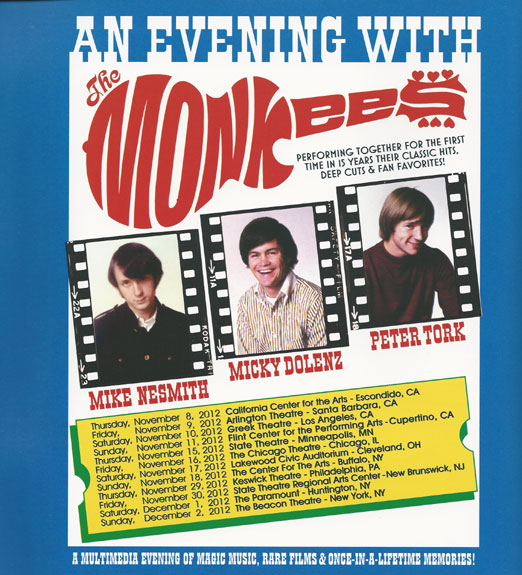
2013
Mike Nesmith did a solo show at the Fitzgerald Theater in St. Paul on April 5, 2013. The audience undoubtedly included some pure Monkees fans like me, but by and large these were hard core MIKE NESMITH fans. He played only songs that he had written, and introduced each one with a “mini-movie” setting. He started off with a Monkees song, “Papa Gene’s Blues,” but did only one other, “Some of Shelley’s Blues.” “Different Drum” was done as a French waltz, and he only attempted the high note on “Joanne” once. The rest were songs I didn’t know, I’m ashamed to say, but the audience reacted with glee at every one and he seemed genuinely touched at the reception. Nonetheless I’m glad I went, if only to hear that familiar Texas drawl again. Peter Tork was also touring solo – I didn’t heard of any Minnesota dates.
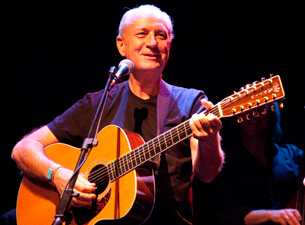
THE DEATH OF PETER TORK
Peter died on February 21, 2019, after a long battle with cancer. He was 77. This was a huge story nationally and locally, sparking many tributes on Facebook and discussions and memories of the Monkees. Peter was much loved.
And Peter had a significant connection to Minnesota. Peter Halsten Thorkelson was born in Washington, DC, in 1942, and he graduated from high school in Connecticut in 1959. From there he enrolled at Carleton College in Northfield. Upon his death, the school shared some information about his time there, as reported by Chris Reimenschneider of the Minneapolis Star Tribune on February 22, 2019:
Carleton representatives have shared a photo from the 1963 edition of the Algol yearbook that shows the young P.H. Thorkelson standing alongside his dorm mates from the fourth floor of Burton Hall. Judging by the photo, it looks like that may have been the party floor that year.
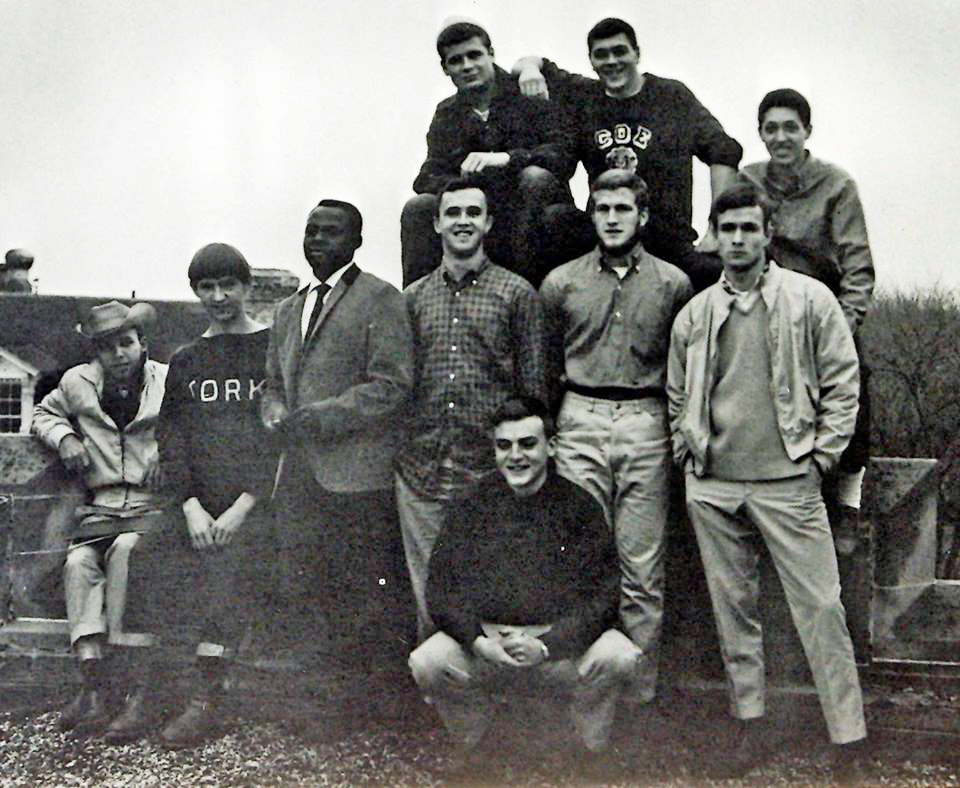
Photo from Minneapolis Star Tribune
The future rock and TV star is pretty easy to spot in the picture, not only because of the similar smirk and haircut that would appear on television sets across the nation just three years later, but also because he’s wearing a sweatshirt that reads “Tork.”
A 1982 article on Tork from the school’s newspaper, the Carletonian, was also dug up following his death. In the interview with then-student Sam Delson during a period when he was playing solo acoustic gigs, the Monkee recounted his rather abysmal academic performance but otherwise fun time while studying in Northfield – which included an initial stretch in 1959, followed by a break and then two more years before he was finally kicked out in 1963 “for low grades and missing chapel,” he said in the article.
Originally from Connecticut, Tork declared himself an English major at Carleton and was also an intramural wrestler, but apparently neither of those were his main pursuit while at the school.
“There were no women in my home town, but there were women at Carleton,” he enthused in the story, “even though they lived on the other side of campus in closed dorms and visitation was allowed only two or three times a year.”
The October 1967 issue of Flip Magazine apparently contains this quote from a classmate: “About the only place where Peter didn’t take his banjo was class, when he went to class. When he did attend classes, he usually went barefooted. All the teachers and professors thought that he was tremendously intelligent, but they would get mad at him because he wouldn’t study.”
The 1982 article also described the dedication that later students had to their famed alumnus. In November 1979, the “Gang of at Least Three and Not Over Sixteen Hundred” absconded with the portrait of the college’s first president and demanded return only if the Great Hall be renamed after Tork. After negotiations lasting five months, the students settled for a ceremony and plaque dedicating the Sayles-Hill game room as the “Peter Tork Memorial Pinball Area.”
2019
Mike Nesmith and Micky Dolenz performed at Mystic Lake Casino on March 14, 2019. This show was only a month after the death of Peter Tork, and must have been extremely difficult for the two remaining Monkees. In fact, the show was billed as, “The Monkees Present: The Mike and Micky Show.” It had been booked months before Peter’s death. Both Peter and Davy were given tributes during the show. Mike sang a good number of songs that he had written, although reviewer Chris Riemenschneider noted that he was a bit rusty and had to read lyrics from an iPad all evening.
Riemenschneider ended his review with this:
Without Jones and Tork, the canned comedic aspects of past Monkees tours was largely absent. Even with the tinge of sadness behind it, though, this wasn’t a heavy-hearted show by any means. Nobody would ever want to see that from the Monkees. (Minneapolis Star Tribune, March 16, 2019)
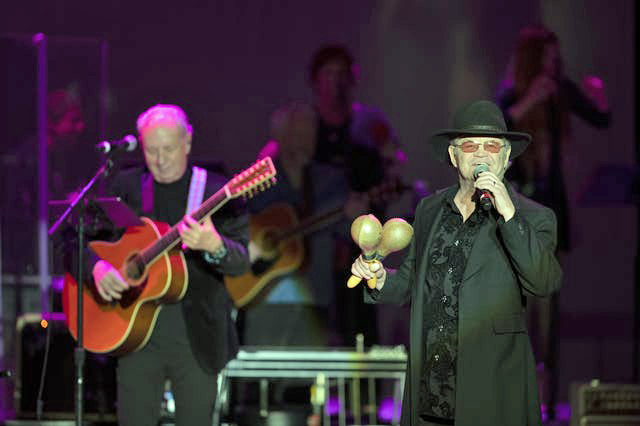
Mike and Micky, Mystic Lake. Photo by Jeff Wheeler, Minneapolis Star Tribune, March 16, 2019
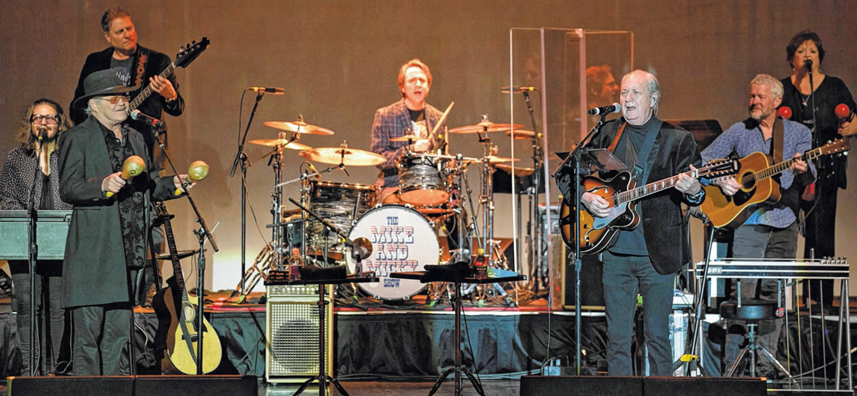
Photo by Jeff Wheeler, Minneapolis Star Tribune, March 16, 2019
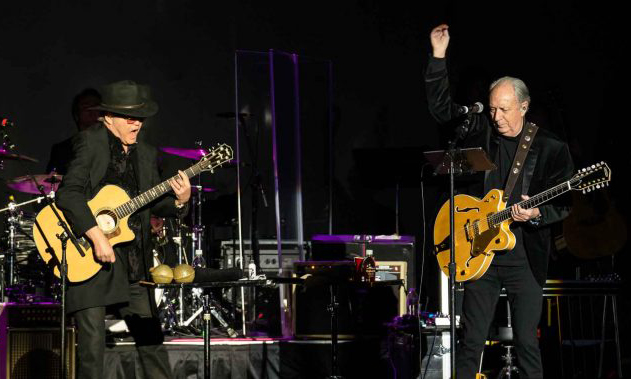
Micky and Mike. Photo courtesy Jeff Wheeler.
2021
The Monkees Farewell Tour began on September 10, 2021, in Seattle, and ends at the Greek Theater, “Where it all Began,” in Los Angeles on November 14, 2021. The two surviving members of the Prefab Four stopped by the State Theater in Minneapolis on November 7. I was lucky to be there.
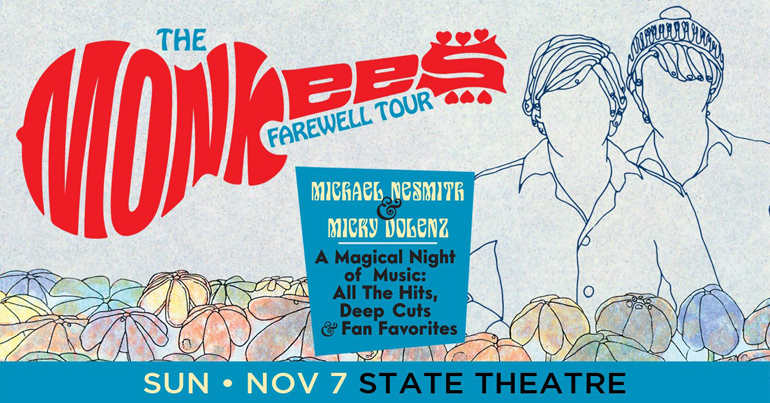
Reading my notes now from the 2012 concert, it wasn’t as great, but it was more emotional. They started with “Good Clean Fun,” which ends with “I told you I’d come back and here I am.” It was just Micky and Mike – Micky called him “Nez,” and so will I. Neither of them played any instruments, except that Micky played some tambourine and his usual timpani on “Randy Scouse Git.” The roadie who brought them out wore the poncho, though. Nez walked kind of hunched over, but was funny and sang well. The audience was subdued during the first half, perhaps because of the absence of Davy and Peter, and the lack of Monkee business. The band was fantastic! I didn’t know that Micky’s sister Coco was singing backup until he introduced the band during “Goin’ Down.” She’s great.
We weren’t supposed to take photos, and the lighting washed out their faces anyway, but Gary Hubbell’s clandestine shot was better than mine.
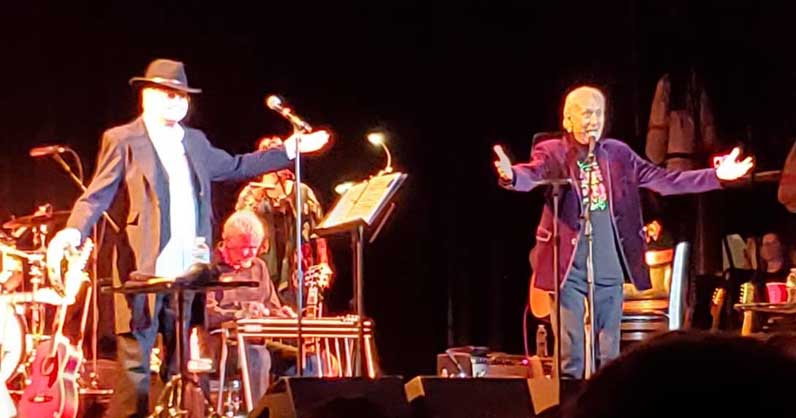
Photo courtesy Gary J Hubbell
In a lot of ways, this concert was about how we’ve changed, but the Monkees have stayed with us. The second half belonged to Nez. He talked about how he imagined us listening to their music as eight-year-olds (I was nine), and how something in their music stayed with us all through our lives. As he sang the next song, “While I Cry,” he made everyone (including himself) cry, and he barely got through it. I just typed in his 1967 interview (above) how he was so flip about how we would forget the Monkees, and he was so wrong.
It’s true that we did change. “Pleasant Valley Sunday” was a put-down about our parents’ generation living out in the suburbs, and now it’s about (most of) us, taking care of our lawns and barbequeing in back yard. Nobody cared. It’s part of our youth, and we all loved the song and always will.
“She” and other songs were reworked into emotional ballads that hit the heart. A newer song written by someone associated with Oasis didn’t appeal to me – not a Monkees song. Lots of Nez’s songs were done, including “Diff’rent Drum.” Love that song.
Fortunately most people (at least in our section) stayed seated. Not that I oppose dancing or gratitude, but I’m old, as were most of the audience. “I’m a Believer” got people the most excited. Also “Stepping Stone.” There was no encore. Masks were required, as was proof of Covid vaccination. Our tickets were about $100 each, on an advance deal through radio station WDGY.
Goodbye, Monkees. I’ve loved you since I was nine, and will forever.
THE DEATH OF MIKE NESMITH
Not even a month after their last concert, Mike was gone. It was announced on Friday morning, December 10, 2021, that Mike had passed away from a heart attack at the age of 78. This was shocking news to anyone who had just seen him so recently. It was revealed that he had had a quadruple bypass three years ago, and that he had been in hospice care a few days before he died.
My observations were that he had seemed frail and stooped over as he walked across the stage, but his voice was strong as ever. He did, however, leave the stage several times, and it was hinted that he needed to sit down and/or take a hit of oxygen.
More important, during his monologue in the second half, he had come to terms with his legacy and finally understood that Monkees music was not for grown men his age, but for those 8-year-olds in their basements.
When the news of his passing came out, so many of my friends contacted me to let me know – I guess everyone who knows me knows what a huge Monkees fan I am. I’m glad I was able to see that last show, and be in the same room with my favorite Monkee. Rest in peace, Nez.
Save
The musical Pettiford family came to Minneapolis from Oklahoma in 1929.
- Harry “Doc” Pettiford was born in Ohio in 1888. He had been a veterinarian played drums. He died
in about 1942. - Leontine Pettiford was born in 1892, reportedly of Choctaw extraction. She played piano.
Their children were:
- Lenontine, born 1911
- Harry, Jr., born 1912 – sax
- Cecelia, born 1914
- Ira, born 1916 – trumpet and later bass
- Marjorie, born 1917
- Alonzo F., born 1920 – banjo, trumpet. Alonzo died on May 20, 1947 at age 26
- Oscar, born 1922 – violin, piano and later bass. Oscar left Minneapolis in 1942 when Charlie Barnet hired him to play bass duets with his bass player, Chubby Jackson. In 1947 he was with Duke Ellington.
- Rosa/Rose Mae, born 1925
- Ellen/Helen, born 1927
- Alice, born 1932
The sisters played either sax or clarinet.
Brothers Bobby and David Rivkin are two St. Louis Park-bred musicians, each distinguished in their own right. Their brother Stephen E. Rivkin is a film editor and producer with a long list of films to his credit.
David Rivkin was associated with three major Twin Cities bands. After three years in a folk duo called the Dynamics, he spent four years with the Chancellors, who had huge local hits with “Little Latin Lupe Lu,” “Yo Yo,” and “So Fine.” In 1965 David left the Chancellors to join the High Spirits. In late 1968, David moved to join Stillroven, which, by that time, had already recorded their hits “Hey Joe” and “Little Picture Playhouse.” He did record an album for A&M with the group, however, which may or may not have seen the light of day. David went on to prosper in the music business as a songwriter, session musician, record promoter, producer and engineer, both locally and nationally. (The link downloads a pdf that no doubt needs updating.) In 2008 David was inducted into the Minnesota Music Hall of Fame.
Born Robert Rivkin in 1956, Bobby Z (a childhood nickname) played drums for Prince and the Revolution from 1978 to 1987. Also a successful producer and songwriter, Bobby has worked with influential artists such as Boy George, Aswad, Manhattan Transfer, Alexander O’Neal, Eric Leeds, Colin Hay (Men at Work), Jonny Lang, George Thorogood, Wendy and Lisa, Garrison Keillor and others. Bobby has been a National Trustee with The National Academy of Recording Arts and Sciences (Grammys) in 2000. In 2008 Bobby was inducted into the Minnesota Music Hall of Fame.
Brother Stephen E. Rivkin is a respected film editor and producer, most notably on the Pirates of the Caribbean series. Read more about him on imdb and wikipedia.
The amazing Rivkin family grew up in St. Louis Park, and attended my grade school! Our city counts them among our most distinguished native sons.
Save
On June 12, 1964, the Rolling Stones played to 283 unimpressed Minnesotans at Danceland, capacity 2,000.
Apparently only Mike Waggoner of the Bops thought to bring a camera. The photo below is a screen shot taken by Robb Henry from a TV news feature about the event.
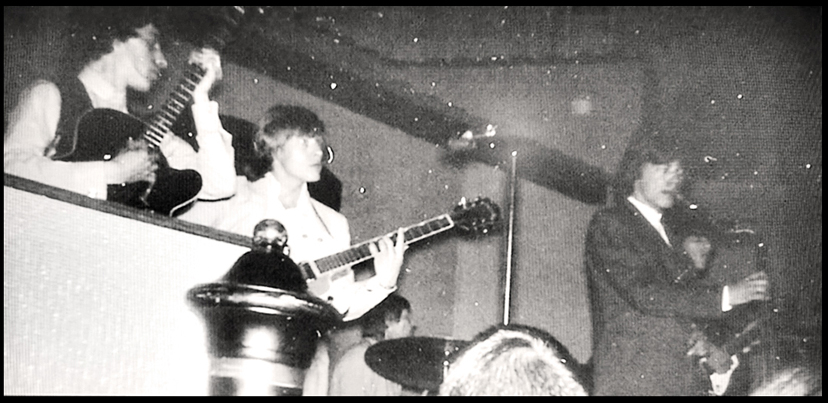
Photo by Mike Waggoner, courtesy Robb Henry
Reasons for the small turnout include some or all of the following:
- Although they made radio appearances earlier in the day, Danceland owner Ray Colihan deliberately didn’t advertise the concert for fear that too many kids would show up and he’d lose his license. But word of mouth failed to bring in the fans, and he lost money on the $2,000 he paid the Stones.
- A $6.00 admission fee also kept the kids away in an era where tickets were generally $1.50. (After 10pm tickets went to half price and more people showed up.)
- In an interview Colihan says that he booked the Stones about a month too early, before they were popular in the Cities. The only single that had been released in the States was “Not Fade Away,” which had only first appeared on the Billboard chart on May 2. Their first top ten, “Time is on my Side,” wouldn’t come until October. Read more about Danceland and Colihan
- This from www.minniepaulmusic.com : “In 2011 Larry Wiegand reported that the Rave-Ons were playing at Marion Hall in Bloomington on the night The Rolling Stones played at Danceland in Excelsior. Larry said The Rave-Ons drew a crowd of roughly 500, at least double the crowd size for The Stones (estimates vary from 150 to 250). Some of the people at the Stones concert went to see the Rave-Ons after the concert in Excelsior.”
NOT AT THE PROM
One claim is that all the kids were at the Prom, attending a giant Battle of the Bands. That’s not true, at least at the Prom, since it was closed that night.
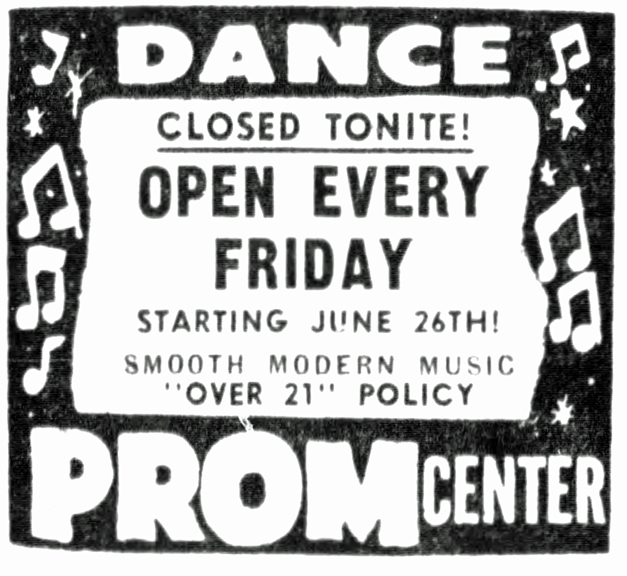
Minneapolis Tribune, June 12, 1964
On July 14, 2014, The Excelsior-Lake Minnetonka Historical Society held an event called “Danceland Burning: Big Reggie’s, the Rolling Stones, and 40 Years of Music Memories at Danceland,” an open mic event to recall stories about Big Reggie’s. The event brought together, either live or on video, people who were involved with the event that night. Here are the often contradictory accounts of this mythical event!
TRANSPORTATION
Limo driver Dick Sather says that he picked the boys up from the airport in a nine passenger Cadillac limosine, but was told to wait until their manager came around with his car. Time went by and the boys were complaining that they were hungry, so Dick set off to their first destination, KDWB studios, for an interview. Unfortunately he went the wrong way on 494, which was under construction, and they were an hour and a half late. Somehow they got to WDGY for a second interview and then to their hotel, the Sheraton. Dick picked them up there to bring them to Excelsior, and delivered them through the loading dock. He stayed in the limo and listened to the Twins game during the concert.
Someone else says that Big Reggie himself picked them up from the airport in a limo. Jagger rolled down the window and spit.
Pat Maher, Colihan’s assistant, remembered when he picked them up at the airport “they were a scruffy bunch of guys who looked like they’d flown in the luggage compartment. This was the first big English band to come to this area.”
Yet another person said they ate lunch at the Lincoln Del before heading out to Excelsior.
THE SHOW
- When the doors opened there were less than 20 people in attendance.
- Things were so bad that they were pelted with eggs and tomatoes
- After about five songs the audience started booing
- Jagger started to answer heckling with jeers
- They only played for an hour and walked off.
- They played two sets.
- They said they’d never come back to Minnesota.
- Brian Jones walked across the street to the Anchor Inn to order a can of soda and they couldn’t understand him.
- Richards and Jagger mixed it up with some local tough guys – sometimes a baseball bat is mentioned.
- One guy said Mick broke the jaw of a guy from Mound in a bar behind the stage.
- Danny Stevens heard that Mick might have kicked someone.
- In his 2010 autobiography, Life, Keith Richards did not specifically mention the Danceland concert. He did observe that there was a big difference between the atmosphere in the big cities and in the hinterland. People would heckle them because of their long hair and they’d have to make quick getaways as they motored across America.
- In his autobiography, Stone Alone, Bill Wyman remembers the audience reacted with “curiosity and disbelief” but that they warmed up to them toward the end.
- Dan Holm of the Chancellors noted that it was graduation day for a lot of local high schools, which may have also contributed to the small crowd. He says that the Chancellors were also on the bill – not as the warmup band for the Stones but an attraction in their own right. After meeting the Stones backstage, he observed that, not only did they not play very well, their “personal (can we say hygiene) appearance was wanting. The Rolling Stones were on a promotional tour being billed as ‘The Rolling Stones from England.’ People were curious about an English band, but they were not the draw that the local bands were. I remember Mike Waggoner & The Bops and a third band. Mostly I remember how skinny and scruffy The Rolling Stones appeared.”
- Danny Stevens says that Danny’s Reasons were in attendance.
- Larry LaPole, country singer and songwriter for the Trashmen, thought the poor reception was because the band came on wearing makeup in the English theatrical tradition, and this didn’t sit well with 1960s Minnesotans.
- One young fan remembers that the Trashmen played Danceland the next night and drew 2-3 times the number of dancers, packing the place.
- Dave Yorks is quoted extensively in the Lake Minnetonka Online site (link at bottom):
- Jagger bantered and mixed with the audience
- Richards looked “out of it”
- They played until midnight
- No violence, polite applause
- No encores
- Jon Bream of the Minneapolis Star Tribune: These longhaired Brits were virtually unknown in the Twin Cities, with only one album and no U.S. hits as they undertook a nine-city debut tour that culminated at Carnegie Hall in New York. The crowd was sparse as the Stones, sporting turtlenecks, played covers from the album – “Not Fade Away,” “Route 66” and “I Just Want to Make Love to You” – and their own “Tell Me.” The set was short and the reception was less than enthusiastic, according to someone who attended.
- A follow-up article by Bream on November 25, 1997, quoted David Rivkin of the Chancellors as saying “It was a short set” and that the crowd “jeered and booed.”
- “They were a lot more conservative back then,” observed Jane David in the interview. “Mick Jagger didn’t jump around much.”
- Nancy Olmstead said they looked kinda stoned – not dynamic and low key.
MIKE WAGGONER
It is well established that Mike Waggoner and the Bops also performed that night. Here’s the scoop straight from Mike:
I think it was an off night .. maybe a Thursday. Ray “Big Reggie” Colihan called me the prior week or ten days earlier and we chatted about the show. The Stones were very, very green .. no real hits; a lot of blues covers. Anyway, Ray asked if we could come out as he wasn’t sure what to expect, and needed a solid band just in case. We did a couple of hours, then they did their stuff. Don’t remember many other details simply because it was no big deal like it was with other groups we worked with there and elsewhere. I worked a couple of shows there with Jerry Lee, one with Brian Hyland, (Ittsy Bikini song), Roscoe and the Green Men (big draw), and I think The Everlys. Not sure on that one as we worked a number of shows with them elsewhere including the Prom, Kato, Turf and Surf Ballrooms as part of a Dick Clark Caravan deal, etc. I know The Champs used to summer in Excelsior and did appear on stage in the park but not sure about the ballroom as it was not used for many years for skating or dancing, and was used for boat storage.
I don’t recall any concerns about too many people showing up but who knows. There was very little advertising except for a few mentions by my dear friend Bill Diehl on WDGY .. where I later was a jock from ’69 – ’75. (Bill was my radio mentor, always dear friend, and very influential in getting me into the biz). I love him dearly. [Mike was on the air as King Michael.]
The Stones, I don’t believe all had amps or equipment except for their guitars. They used some of our backline gear and sound system. They borrowed a drum set (via Ray) from B Sharp. And that was that part of the deal. I have a picture someplace of Bill Wyman which also shows our PA speakers. Kinda’ cool. The fact of the matter is that no one really knew about them and they didn’t seem to be a big deal. That is why there are very few pictures or specifics to rely on for history. I do remember one of the guys had on a big belt buckle and jeans. Not sure who .. but the buckle stands out! They did arrive in a limo type car, and the vehicle got backed up on the rear ramp that was used to get bands, pop, beer, etc into the dancehall. We met them initially out there as we were unloading our trailer and gear. As I recall they were very modest and quiet. Polite greetings were exchanged, and that was that. There was a dressing room behind the stage with a curtain separating that area from the stage. I would assume that they hung out in there with their handler.
Finally, the albums that Bill gave away on London label didn’t have Stones vinyl inside. The covers were Stones but the discs were not. The promo copies had not yet arrived. [Reportedly the disc were classical records from London.]
It was quite a ho hum night, and a small crowd. Maybe 300 at most. The stories and the “retells” are very entertaining, and as said in a Kris Kristopherson song, “Partly truth and partly fiction.” But all is well that ends well and they certainly ended up selling more records than we did!
No other bands, no eggs, no tomatoes (people don’t usually go to a teen dance armed with eggs and tomatoes .. that should dispel that suspicion.)
Pat Maher, Colihan’s assistant, remembered that the Rolling Stones definitely were not booed off the stage: “The Stones were not overwhelmingly received, but the crowd eventually warmed up to them.”
RICHARD VIOLETTE
Here’s a new (2021) account that has come in from one of the audience that night, with lots of details. Thank you, Richard!
One of my closest friends at St. Louis Park High School was Jerry Armstrong, who excelled at playing the guitar and singing. Like many teens in the Park, he was encouraged in his musical development by his parents, and was totally dedicated to his passion. Jerry took guitar lessons from Jim Johnson, the lead guitar player of the Underbeats, one of the most popular bands at the time.
This is how we came to hear about the then-unknown Rolling Stones coming to Danceland. Jim told Jerry that a band from England was to perform there and encouraged Jerry to see them, even giving him promo tickets. Since Jerry and I were both 15 years old, Jerry arranged to have his mother drive us to the event. We would be getting a ride home from some older St. Louis Park students as we planned for a late night.
We arrived at Danceland at around 8 pm in the evening, and at first only about 40 people were there. By about 10 pm the crowd had grown to around 300 people. There were a lot of people coming and going. Danny Stevens, a well-known and very popular local performer in Minneapolis, was there but not performing.
Once the Rolling Stones took the stage, we went up front – Jerry wanted to observe chord changes and lead guitar riffs. We both enjoyed the sound, and thought they were great. It is true there was small group of preppy types that hassled and heckled the Rolling Stones. That’s not uncommon for that era. In the early ‘60s there was a clash of culture with teens and new trends emerging. The heckling was from only from that one small group of tough guys. Usually security would deal with them. The rest of the crowd was into the sound. The Stones did get some good feedback from the crowd depending on the song. The group did not look shabby. Their outfits were more mod style with a tailored European look. Not a style any of us were hip to at the time. It was noticeable that Mick became aggravated by the heckler. It was mostly one guy.
The Stones played for maybe an hour and some before they took a break. Jerry was very impressed by the band. A guy approached Jerry and we decide to approach the band, which was gathered in a corner of the dance floor. Jerry engaged them in a conversation focused on the sound and chord changes. I mentioned to the band that my mother was English and that I had family in England. They gave me a nod, and I noticed right off that they had heavy accents and they mumbled words. But they were cool and hip. The conversation was very short – only a few minutes. Mick Jagger did walk around the dance floor and interact with the crowd. There was no violence inside Danceland. I heard later that people said the band had tomatoes and eggs thrown at them. I did not observe any aggression aimed at the band, other than the small amount of heckling from the thugs.
After a break in a back room, they came back and did another set. This time the sound seemed a little off. During the first set the band’s sound was better and more together. Jerry and I were still impressed with the group; they were nothing like any other band we had known. Again they were hassled a little by that same group. It was a small group of maybe five guys. Some people said they were part of a gang. I heard a reference to the Southside Associates, but I am not sure.
By this time to was getting close to midnight, so we had to leave to catch our ride home. Jerry and I were standing outside close to the front door. There were some fist fights going onside. We heard that there were several local gangs in the area that night. This was a good time to leave. One of the local gang members was struck in the face with a club at the exit door just as he was leaving. Some people claimed it was one of the Stones who hit him. The guy with the club did have long hair. I saw him from behind. We were very close to the front door when it happened, but I could not say for sure if it was one of the Rolling Stones. It was dark and it happened very fast. The gang member went down quickly and people came to attend to him. I recognized him as one of the guys that had hassled the band and Mick on stage.
The night at Danceland with The Rolling Stones from England was one for the history books. The next time I would see the Rolling Stones was in concert in 1981 at the St. Paul Civic Center. But nothing can replace those early days when you can observe a performer in the early stages of a great music career.
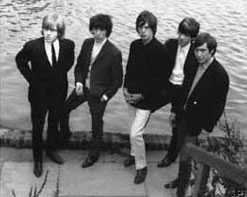
Was this photo taken at Lake Minnetonka? Hard to say.
AFTER THE SHOW
It seems clear that the band split up and got into at least two different cars.
Limo driver Dick Sather says that he waited in the limo during the concert, and afterwards the band got in and he took them to the hotel. He remembers girls chasing the Stones, and their boyfriends making fun by asking for Dick’s autograph. He obliged, but not with his real name!
Timothy D. Kehr took some of the Stones back to town in his four door ’57 Chevy (yellow with a white top). Mick sat in front with Kehr, and in the back were Charlie Watts, Bill Wyman, and the Stones’ road manager, Ira Sidelle, a friend of Kehr’s (which explains why they were in his car). Kehr swears that some kids from town had gotten hold of some eggs and pelted the car on the way out. Kehr took those in his car to Friar Tuck’s on W. 7th Street in St. Paul, a drive-in restaurant (the others went straight to the hotel). They had never seen a drive-in before, and ended up staying for two hours, ordering everything on the menu, just to see the carhops.. hop. They stayed at the Bloomington Motor Lodge by the airport, Kehr remembers. (Darel Leipold says the Holiday Inn, also by the airport.)
Jon Bream interviewed three women who said that they were invited back to the Holiday Inn where the band was staying and watched a Lon Chaney movie called “Dead Man’s Eyes” on TV. Brian Jones threw a lawn chair into the hotel pool from the balcony and Bill Wyman bought a Hershey bar. Later, Watts and Richards jumped into one of the women’s blue Impala with her, her sister, and one of the other girls to get burgers at Maximilian’s near Lake Calhoun. (StarTribune, November 25, 1997)
Gary Reins must have shown his appreciation, because afterwards Brian Jones reached into the car and grabbed the only souvenir songbook that was distributed that night. Here is a scan of it, thanks to Gary and his wife!
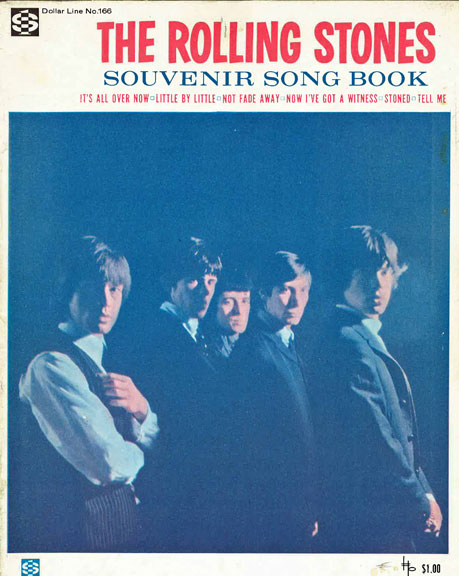
And finally, Jack Dunn reportedly took them back to the airport the next day.
Whatever happened, it was a disaster and the Stones stayed away from the Cities until 1972.
An item in Billboard, December 12, 1964, said that British Invasion bands were not doing well at concerts, despite heavy radio airplay. Big Reggie had paid the Dave Clark Five $25,000 for two concerts, one in Des Moines, and although they grossed $10,000 in Minneapolis, Colihan lost $4,000 on the date, and his loss with the Stones was even larger. Big Reggie used to say with some amount of pride that he was the only promoter to lose money on both the Rolling Stones and the Beatles!
YOU CAN ALWAYS BELIEVE WHAT YOU WANT
A long-running rumor is that an incident that happened during this trip inspired Jagger to write one of the Stones’ biggest hits. It involves a local Excelsior character named Jimmy Hutmaker. Jon Rukavina tells us:
I actually knew Jimmy Hutmaker because when I lived in Excelsior in 1974. I rented a room at his parents’ house. Jimmy was what we call these days special needs and quite so. He would walk the streets day and night talking to himself but if he saw someone he knew he’s snap out of wherever he was in his mind and have a conversation then right back into his world. Jimmy’s dad Dick owned the barber shop on Main Street.
Excelsior resident and businessman Darel Leipold has written a pamphlet called Mr. Jimmy, His Life and Times: The Rolling Stones in Excelsior and a Bit of Excelsior History. His telling of the event is that Jimmy was working at the Amusement Park, stacking the weighted milk bottles, and had the opportunity to meet Jagger backstage at some point the night of the concert. The next morning, he said he went to Bacon Drug to get a cherry Coke, but got a regular Coke instead. Mick Jagger came in, saw him, remembered his name, and asked “Why so bewildered, Mr. Jimmy?” Jim responded, “Because I ordered a cherry Coke, but they didn’t bring that, and that makes me feel kind of dead. I want you to know, you can not always get what you want.” Jim then followed Mike to the prescription counter where Mick got a prescription filled.
Could this have actually happened? My opinion: NO. Reasons:
- Timothy D. Kehr pointed out that he took the band away right after the show, and they had to be in Omaha the next day, making it quite infeasible that he would go all the way back to Excelsior the next day to get a prescription filled. Timothy didn’t believe it but never made an issue of it because he didn’t want to burst Mr. Jimmy’s claim to fame.
- A prescription from who?
- Danny Stevens postulates that the “prescription” could have been a card that heroin addicts in England could get and present to get a dose in order to prevent them from going into withdrawal or committing crimes to get more. Although this was only 1964, one of the group could have had one of these cards and could have presented it at the Bacon Drug pharmacy.
- Stevens suggests that the encounter could have taken place at the drug store between the first and second set, but would the store have been open that late? Besides, Jimmy was supposed to be working, according to Leipold.
- Leipold seems to indicate that Hutmaker was known simply as Jim or Jimmy before the incident, and only became “Mr. Jimmy” after the song came out.
- A web site called Songfacts has many opinions about who the real Mr. Jimmy was.
The song “You Can’t Always Get What You Want” was released in July 1969 as the B side of “Honky Tonk Woman.” Jagger has apparently made no move to clear this up; some speculate that he didn’t want to share royalties with Mr. Jimmy.
Mr. Jimmy attended the Bridges to Babylon tour at the Metrodome on November 25, 1997, by winning a WCCO contest that required a written entry of 25 words or less. Mr. Jimmy won easily in his age bracket with the help of Bob Bolles. He was driven to the concert in a limo by Bill Keeler and signed autographs, dressed in a tuxedo. He did not get to meet Mick, and Mick did not sing the song.
Mr. Jimmy enjoyed his fame, carrying with him a business card with his photo, and the words “Mr. Jimmy, Roving Ambassador, Excelsior, Minnesota. ‘You Can’t Always Get What You Want.'”
Bacon Drug closed in 1994. Hutmaker died on October 3, 2007, at the Excelsior Nursing Home.
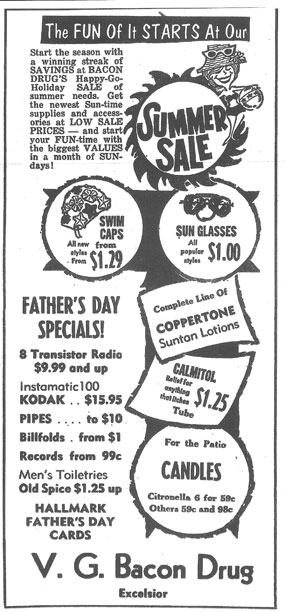
Minnetonka Record/Minnetonka Lake Living Special Section, June 1964. In case you can’t read it, that’s Calmitol, Relief for anything that itches.
Read an extended description of the concert on the Lake Minnetonka web site.
STONES REDUX
And what’s this? 57 years later, the Stones were back in town, and someone in their organization had found the picture at the top of this page! They blasted it on their jumbotrons or whatever they call them now, and the crowd went wild! Robb Henry again caught footage of this historic event – a screen grab of a short movie is shown below.
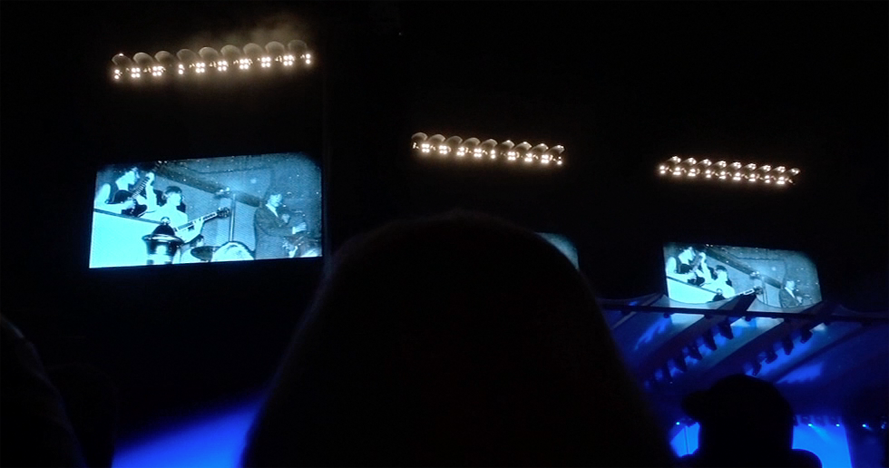
Photo courtesy Mike Waggoner and Robb Henry
Save
Save
Of all the great rock ‘n’ roll groups playing around the Twin Cities in the mid-sixties, the one that really broke out into the Big Time was the Trashmen. Of course, national fame came based on the silly novelty tune “Surfin’ Bird,” but keep playing their eponymous LP and you’ll hear some of the best surf music ever recorded!
There are many books, magazines, and websites around that will tell the story of the T-Men, including their page at minniepaulmusic.com so this page won’t go into the all the details, but here are a few tidbits:
MIKE JANN TELLS IT FROM THE BEGINNING
On October 8, 2017, lead guitar player Tony Andreason was given the second annual Bill Diehl Award. His childhood friend and official Trashmen historian, Mike Jann, delivered these words at the ceremony:
Thank you for the opportunity to say a few words on behalf of my friend, Tony — whom I’ve had the pleasure of knowing now for over some 60 years! I was introduced to Tony back in about 1955 when the nuns at the grade school Tony and I attended (and I had graduated from) heard that we both played guitars. They put the word out that we should get together and meet up — with our instruments.
Now there were not nearly as many guitar players back in ’55 as now-a-days. So the first time I heard Tony play at the school’s Talent Show, his picking nearly “knocked my socks off” — to quote an old saying. I couldn’t believe what I was hearing! So I called him and we got together for our first guitar picking jam. …And when I learned that he, like me, enjoyed country music — that was an instant bond — that would last through the years.
Case in point: One Saturday night we were parked in my ’48 Plymouth on a hill overlooking Crystal Lake in Robbinsdale — with the car radio on. A while later, a police officer came up and asked, “What are you boys doing in there?” One of us replied: “We’re listening to the Grand Ole Opry — from Nashville — on the radio! …The reception is better up here by the lake. …Less interference.” The cop said something like: “Well, maybe, O.K., fellas…” and left — probably scratching his head. …There was no beer in that car.
We would get together for regular jam sessions as often as possible — usually in his parents’ basement in North Minneapolis. After a while, word got out what we had been up to — and we were invited to perform at a few Sunday evening church suppers in the area. Hey, they paid us maybe $10.00 for the two-some! We were happy to get the gigs!
By then, I was brave enough to sing some Johnny Cash songs — while Tony would play the lead guitar parts, just like Luther Perkins did for Johnny! Our little musical interlude would have Tony usually playing at least one instrumental tune — like the “Guitar Boogie Shuffle” or some variation while I played rhythm guitar for him. Don’t think I got nervous up front — cause I knew he was there behind me — and could pick out an instrumental on his guitar at any time (…to save my ‘vocal ship’ from sinking)!
In about 1957, someone asked us if we would like to be in a Knights of Columbus Talent Contest in downtown Minneapolis. We decided to give it a try! Tony was recalling that the Grand Prize was maybe $50.00 and a recording session for the winning act. Tony led off picking his instrumental arrangement of the “Guitar Boogie Shuffle.” Then we hit the judges with me vocalizing a Homer & Jethro parody version of the old classic “On Top of Old Smokey” — and somehow we won the Grand Prize! We beat out the accordion player that probably played “Lady of Spain” — and maybe a couple of classical piano players, etc..
The Grand Prize took us down to Kay Bank Recording Studio on Nicollet Ave. South, Minneapolis. We recorded two songs — one a song I had “written” and the other was Tony playing an instrumental medley on his guitar. We received a couple of acetate copies of “our session” to take back home.
In about 1959, Tony started playing out at the Crystal Coliseum for teen dances on Friday nights with various rock bands, including Jim Thaxter and the Travelers. As I listened to his talented guitar playing, I knew there was ‘a change a coming.’ …That our little two-some was about to change direction completely for Tony, as local rock bands started calling him to play lead guitar for teen dances.
And little did ANY of us know then that Tony would return to Kay Bank six years later in 1963 — with three other bandmates by the names of Steve Wahrer, Dal Winslow and Bob Reed — better known as the Trashmen — to record a hit song that would put Kay Bank and Minneapolis back on the pop music charts! Reaching No. 4 on the Billboard Pop Singles chart was just part of “Surfin’ Bird” history!
In the Fall of 1963, I vividly recall the night when the “Surfin’ Bird” 45 single record was first played on the radio — the Wednesday evening’s “Pick to Click”(-??) listener call-in program on Wonderful “Wee-Gee”, WDGY! Tony, myself and Larry LaPole were working on recording some demos.
Tony asked me for my car keys so he could go out and turn on the car radio to monitor what was happening on WDGY. Some time passed while the girls were singing — and all of a sudden, Tony came running back in and excitedly announced: “They played our record! He watched the recording in progress for a while — and then went back out to the car. After another few minutes, he came back in again to tell us that they had played “Surfin’ Bird” again! If I recall, he made a third trip into our makeshift recording room to announce that the “Bird” had been played a third time — due to listeners calling in to make the Trashmen’s record the winner for night — the most requested “Pick to Click” favorite record.
That would dramatically change the direction for the future of the 4-piece Trashmen band!
However ironic, the record had to be taken off of radio airplay for the next few days while records were quickly pressed up and shipped to local record stores — to make supply meet up with teen demand for what we were referring to as an ‘overnight hit’!
Reaching No. 4 on the Billboard Pop Singles chart in early 1964 was just part of the “Surfin’ Bird” history! Well on its way to No. 1, the chart action was ‘rudely interrupted’ by a 4-piece group hailing from England.
Over time, Tony became very proficient in the recording studio — many times calling upon what he had learned in his High School Orchestra days at Patrick Henry High School and later at McPhail School of Music in Minneapolis.
In 1966-1967, we started a record label — or two — to help promote some of David Anthony’s bands that he was booking. Tony was willing and able to offer help with what he had learned ‘the hard way’ in the recording studio. Amongst other projects, he worked with and produced the South 40 “Live at Someplace Else” album on Metrobeat. He was always willing to share his musical knowledge and guitar tricks or secrets with most anyone who asked him for advice. …Whether that be in the studio or after a Trashmen gig — while signing autographs out in front of the stage.
In 1989, Steve Wahrer, the voice of “Surfin’ Bird,” passed away. Since Tony always had a very good ear for hearing and imitating voices, it fell upon him to teach himself to “sing” ‘the Bird.’ After all, he had heard it …how many thousands of times coming from behind him on stage when Steve would sing “the Bird” — while playing his drums.
…After the frequency of the Trashmen’s gigs in the U.S. lessened, it came as NO SURPRISE to me that Tony joined a bluegrass band — “The Platte Valley Boys.” Because back in our earlier jam session days, Tony might start the conversation by saying something like, “Mike, you gotta hear this!! I just got this brand-new Jimmy Martin album, or this one by the Stanley Brothers” — or maybe a Lester Flatt and Earl Scruggs song. And there was always a catchy bluegrass harmony part that Tony would try to get me to sing along with him. …But I just ‘fell flat’ trying to hit those harmony parts!
Finally, The Platte Valley Boys provided that ‘harmonious’ platform and Tony could add his part to those tight, clean bluegrass harmonies that he loved so much. Yes, Brian Wilson and the Beach Boys’ ‘rocking’ to “Be True to Your School” might come close — but Tony really got his bluegrass “chops” and guitar licks in with his 15-plus years performing with The Platte Valley Boys!
But Tony, as a member of “The Trashmen” — never foresaw that decades later, they would play to sold-out crowds in Europe. …Tours to countries all over — Spain, France, Germany, Italy, Austria, England, Sweden, Denmark, etc.
In conclusion, I wish to thank Bob Reed, Dal Winslow, Steve Wahrer — and especially my friend through it all, Tony — for allowing me to tag along “on the ride” all these many years!
Like fine wine, Tony’s instrumental and vocal talents have only improved with age. I am proud of Tony’s musical accomplishments — and even more proud to call him my friend!
Thank you!
Mike Jann
Random Notes on the Trashmen:
The band first appeared at the Prom Ballroom as simply “Dal Winslow, New Sensation.” Dal explains that the name “The Trashmen” seemed too “out there” for the ballroom, so he was chosen as the front man in an era of teenage idols.
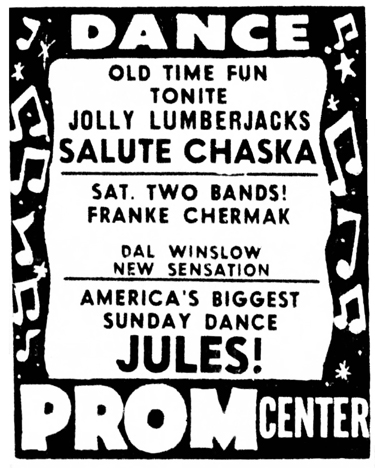
Minneapolis Star, September 13, 1962

Minneapolis Star, September 15, 1962
It appears that their next show at the Prom was under their own name, on January 19, 1963. Again they were described as a “New Sensation.”
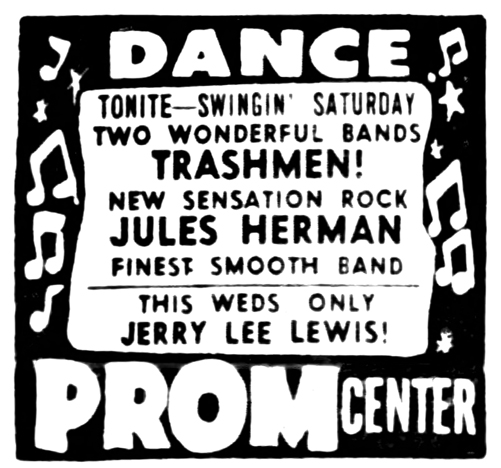
Minneapolis Tribune, January 19, 1963
Other Fun Facts:
- Despite their landlocked situation, three of the four band members actually did go to California, where they absorbed the Dick Dale sound and rode the waves.
- The famous album cover in front of the trash truck was taken at Wally McCarthy’s Lindahl Olds at 494 and Penn Ave. Tony remembers it was about 30 degrees that day, so they were anxious to get the shot done quickly! Scenes from “Fargo” were later shot at the same location. It’s now Best Buy headquarters.
- “Surfin’ Bird” entered the Billboard Charts on December 7, 1963, and stayed there for 13 weeks, peaking at #4 on January 25, 1964.
- The song was originally to be called “Surfer Bird,” but Bill Diehl suggested that “Surfin'” leant a little more action to it.
- Reaction to the song was mixed; in January 1964 Will Jones reported that one Texas listener offered a radio station there “any amount of money” to take it off the air. “The station told him to send his money to the March of Dimes, and smashed its copy of the record….Meanwhile the Minneapolis record company that created the hit is lining up extra pressing plants in Michigan and California to keep up with the demand for the disk.”
- The B-side of “Surfin’ Bird” was “King of the Surf,” the best surfin’ song of all time, bar none! The sudden success of “Surfin’ Bird” required that a flip side be written quickly, and Larry LaPole was enlisted to write it. Larry had never been to California, but fellow Minneapolis Tribune writer Mike Jann gave Larry a column that Will Jones had done on July 28, 1963, with definitions of surf terms. The column, “Avast, Gremmies–Surfing Tide is Rolling In,” has virtually all the terms Larry used in the song.
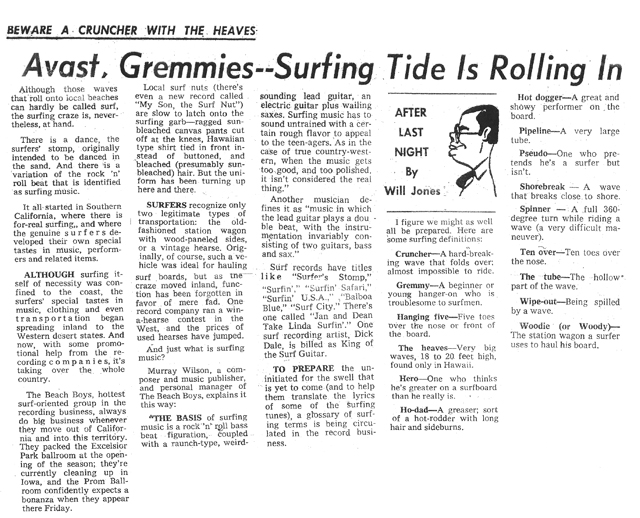
July 28, 1963
- On December 8, 1963, Irv Letofsky wrote a two-page feature on the Trashmen for the Minneapolis Sunday Tribune – “Trashmen ‘Have the Beat Kids Love.'” Although Tribune music critic Dan Sullivan “applied the rare superlative ‘It’s the worst song I’ve ever heard,’ It matters not. The beat’s the thing. (Surfin music’s the thing, too, although surfing style of dancing hasn’t really reached the Midwest, informants say. It’s coming from the West Coast.)”
- George Garrett noted that the name the Trashmen might have come from a record about a trash man that was out about three years ago. [Probably “Trashmen’s Blues” by Tony Kai-Ray] “But we like what the disc jockeys do with the name… like ‘Back up and get a load of this.'”
- On January 12, 1964, a party at Kay Bank Studio celebrated 500,000 in sales for “Surfin’ Bird.” Will Jones reported it as “one of the more remarkable parties of the season,” hosted by officials from SOMA, distributor; Garrett Records, producer; and Kay Bank, where the record was made. It was also a launch party for “Bird Dance Beat” and the “Surfin’ Bird” LP. “The party was attended by disk jockeys, record peddlers, and a few young persons whose function was to dance The Bird.”
- “Bird Dance Beat” (b/w “A-Bone”) charted on February 8, 1964 and stayed for seven weeks, peaking at #30 on March 7, 1964.
- The “Surfin’ Bird” album, on Soma Records, hit the Billboard Chart on February 15, 1964, and stayed there for 15 weeks, peaking at #48. It was available at Record Lane and Musicland for $2.88. 2013 eBay prices range from $120 to $1,000 for a copy autographed by all four members. And where were the Trashmen on the day their big album hit the charts? Southtown!
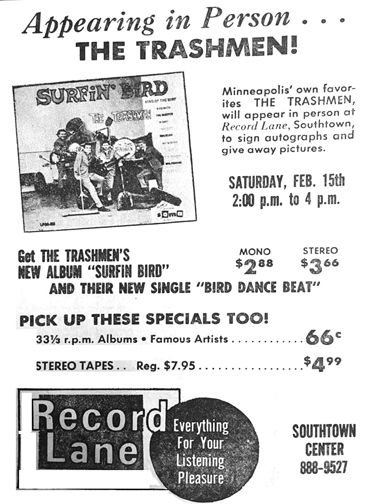
Courtesy Richfield Historical Society
- A third single release, “Bad News” b/w “On the Move” hit the Billboard Bubbling Under charts on May 16, 1964, but by then the Beatles had hit and surf was over.
- In late 1964 the group went on a tour of South America. A planned tour of the UK in 1965 had to be postponed because of the British Invasion but they finally made it in 2010.
- Another gem from Will Jones was a rumor that the Beatles and the Trashmen were going to team up to form a new group. The name of the new band? The Litterbugs!
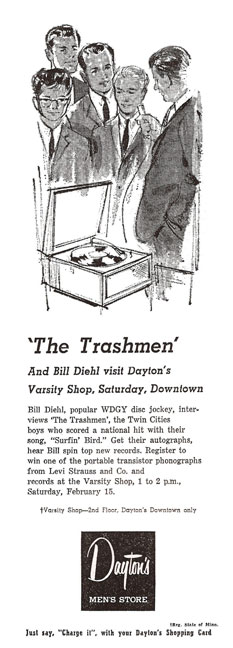
SURFIN’ BIRD ON BANDSTAND
On January 4, 1964, the Trashmen were featured on “American Bandstand” – only the show was too cheap to fly out the entire band, so Steve Wahrer (the drummer and singer) was sent out there alone. To the day 59 years later, Tony Andreason remembered that Steve was given no prep time, no instructions, and no expectations. Worse, being the drummer, Steve was not used to performing in that way. On the spot, he invented the Bird, and did a creditable job. Afterwards he talked to Clark, but he was out of breath! Tony stresses that Steve was an excellent rock drummer and an excellent rock singer, and that performance did not show off his many talents.
Timothy D. Kehr was a force in the Twin Cities music and television arenas for over 45 years. The following are his radio and TV achievements. Information was provided by Timothy and by his good friend Tom Garry.
MUSIC
Timothy started promoting concerts and music when he was still in grade school. Before he had graduated from high school in 1964 he was a veteran music reviewer, booking agent for most of the Twin Cities top teen bands, and was friends with Danny and the Juniors, Bobby Darin, and other bands of the era.
Timothy went to probably every rock ‘n’ roll show at the Prom Ballroom, including the ill-fated Winter Dance Party on January 28, 1959. In the book The Day the Music Died, author Larry Lehmer describes a 12-year-old Timothy as a backstage regular, interested more in the music business than the music. He was well-known by the security guards and had access to the dressing room in the basement, where the performers were playing cards. He had brought a photo of Buddy Holly, hoping to get it autographed. I mentioned to Timothy that I had come across this reference while re-reading the book, and he responded, “I AM EVERYWHERE!” And he was!
When the Rolling Stones made their infamous appearance at Danceland, it was Timothy who was responsible for getting them to and from the gig, and it was his car that was pelted with tomatoes (but not eggs).
In college he produced “Liar, Liar,” by the Castaways (Billboard #12). In 1967 he arranged and produced “Nowhere to Run” By the More-Tishans. He also published two music publications: the Music Scene and the Insider. He also hand picked the original members of the Litter (“Action Woman”).
He once gave a custom made guitar to John Lennon and spent time with the Beatles in Chicago.
After graduation Timothy went on to secure recording contracts for Crow (“Evil Woman Don’t Play Your Games With Me”), Northern Light (“Minnesota”) and others.
In 1967 and ’68 he wrote the column “Musically Yours” for the local TV Digest.
From April to June, 1967, he edited nine issues of the Music Scene newsletter for B-Sharp Music Store, owned by Jim Lopes.
From July 2 to December 18, 1967, he edited 12 issues of the T.M.C. Insider for the Trestman Music Store.
From 1968-1980 he worked for Columbia and Epic Records, Motown, 20th Century, and Polydor. During this time, Billboard Magazine named him executive of the year from 1972 through 1978. While at these companies, he was given numerous Gold Records for his contributions to the success of many hit records and artists.
In 1980 Timothy left the record business to open his own advertising agency in the Twin Cities. However, in 1983, he briefly returned to the music business to manage John Maddock, a children’s entertainer and produce two albums by Maddock under the name of “Captain Cookie.” At the same time he also developed himself as a local television personality as a host of late night television from 1976-1986 and as a talent in television ads. (see below)
For nearly 20 years he owned and managed multiple popcorn stands at the Minnesota State Fair. One of his more famous employees was a young friend, Kenny Rogers, when Timothy helped the First Edition secure a stage spot at the Fair for a couple of years.
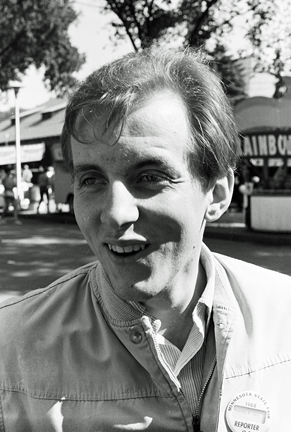
Timothy at the Fair, 1968. Photo copyright Mike Barich, St. Paul
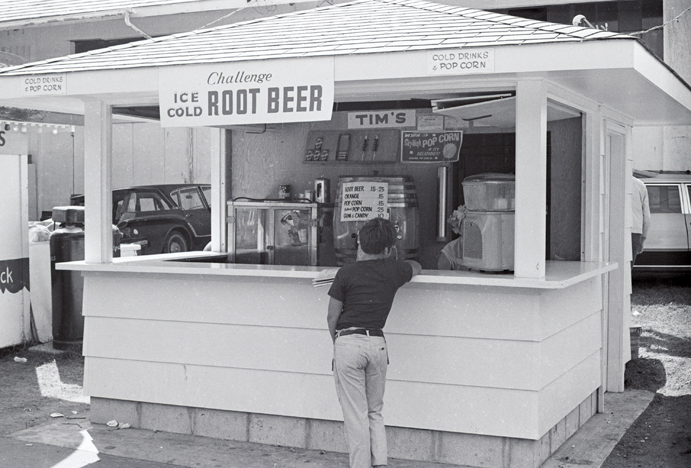
Tim’s Popcorn Stand, September 2, 1968. Photo copyright Mike Barich, St. Paul
In 2005 Timothy was inducted into the Minnesota Rock/Country Hall of Fame. And in 2006 he was inducted into the Iowa Rock and Roll Hall of Fame. From 1997 to his death he was also a voting member of N.A.R.A.S. (the Grammy awards.)
In 2010 Timothy was inducted into the South Dakota Rock ‘n’ Roll Hall of Fame, and he was also inducted into the North Dakota Rock ‘n ‘ Roll Hall of Fame.
In November and December 2010 Timothy broadcast the True Oldies Christmas Show on 740AM WDGY from 10AM-1PM on Saturdays. He used his personal collection of 100s of rock ‘n’ roll Christmas CDs. The Christmas CD collection includes everything from Bill Haley to Danny and the Juniors to Bobby Rydell to the Beatles to Bobby Vee to Paul and Paula to Jackie Wilson to Jimi Hendrix to Dion to Jimmy Buffett.
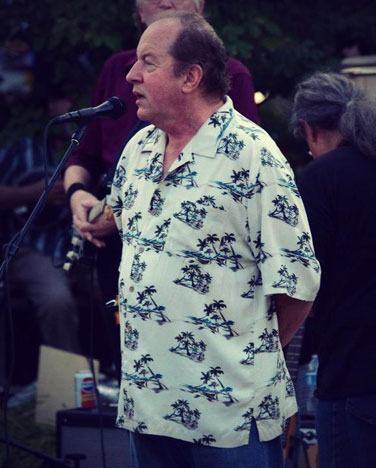
Photo by Neil Schloner
TELEVISION
Timothy’s on-air “debut” was Sunday, February 15, 1976 on WCCO-TV at 10:30AM. The program was “The Serials.” He sold the idea to WCCO-TV on a trial program using a beginning episode in an Ace Drummond serial. The program drew more than 400 letters of praise and WCCO-TV put the program on the air for 13 weeks. “The Serials” was broadcast Saturdays at 2:00 PM beginning April 10, 1976.
Timothy’s next program on the air came on May 28, 1978 (Memorial Day weekend). He planned an all night movie party from midnight til 5:00AM on KSTP-TV, showing all 12 episodes of Flash Gordon. Timothy was the emcee, broadcasting live from a car dealership. He underwrote the program. The event was in a manner worthy of Los Angeles. There were searchlights, free popcorn, prizes, trivia questions and Timothy hosting between chapters of the movie. The Twin Cities had been used to midnight sign-offs prior to Timothy’s all night TV shows.
Timothy returned on all future holidays and on a regular basis on KSTP-TV through April 30, 1982. On May 30, 1982, KSTP-TV attempted to duplicate his unique shows with their own show and host. He moved to WTCN-TV to compete against KSTP-TV. Timothy won.
In August 1982 Timothy brought his shows which were now broadcast from 12 Midnight Til 2:00AM On KMSP-TV and broadcast them through 1987.
In 1988 and 1989 Timothy broadcast a half-hour show called “TV Classics” on KTMA-TV, Channel 23, at 10:00PM every Friday night. His sponsor was the Chef Cafe at Franklin and Chicago in Minneapolis (pictured below). Here is one of his famous chicken commercials.
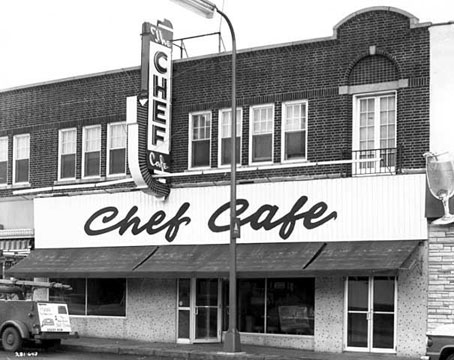
And here is a still of Timothy, eating that famous fried chicken:
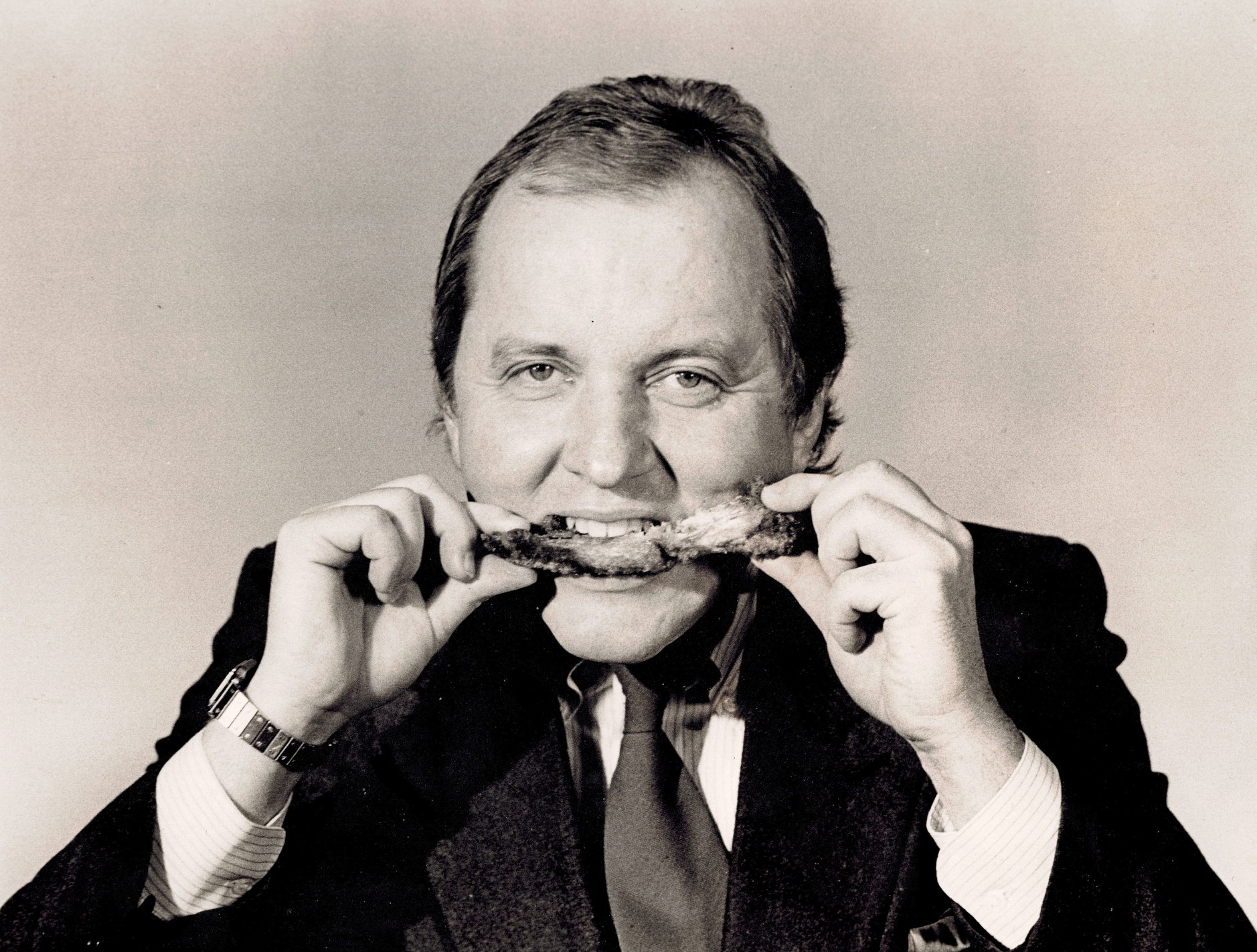
Photo taken March 8, 1989 – copyright Mike Barich
Since those early days of “Late Night Movies With Timothy D. Kehr,” Timothy appeared in many radio and TV commercials which were continuous from 1978 through today.
In 1980 Timothy started his own advertising agency, which was in operation until his death. Two of his more memorable commercials were “Chicken Wings” and “Sober Cab,” which aired for years.
Timothy was creator, host, producer, and underwriter of these programs, many of them broadcast years before there was any programming past midnight. He also used his own library of public domain films to broadcast on his programs. He was a true pioneer in Twin Cities broadcasting without ever receiving a paycheck from any station.
Timothy D. Kehr passed away on September 10, 2013, after a battle with melanoma cancer. I don’t remember how I first got introduced to Timothy (perhaps through Patrick Devine), but he became my mentor very early in the course of my Twin Cities rock ‘n’ roll odyssey, even though he really didn’t know me from adam. He introduced me to dozens of people, gave me countless pieces of information, corrected me when I was wrong, and supported me 100 percent. I will miss him as a source of knowledge and experience, but mostly as a friend who returned every phone call and responded to every email. IN ALL CAPS.
Thank you, Timothy.
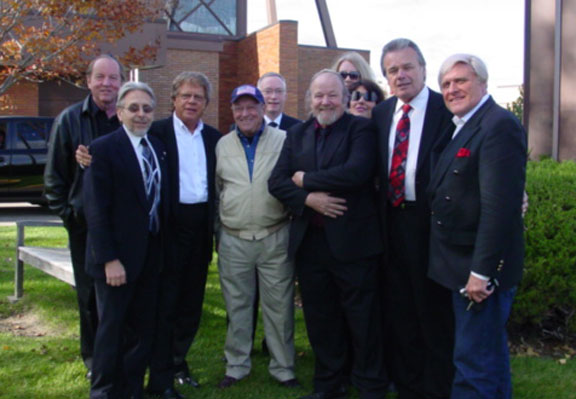
Timothy D. Kehr, Dennis Libby, Marsh Edelstein, Larry LaPole, Mike Jann, Doug Spartz, Cindy Spartz (tall blonde in back), Barbie & Tony Andreason, and Danny Stevens at the funeral of Amos Heilicher, 2008. Photo courtesy Dennis Libby and Mike Jann
Article from StarTribune
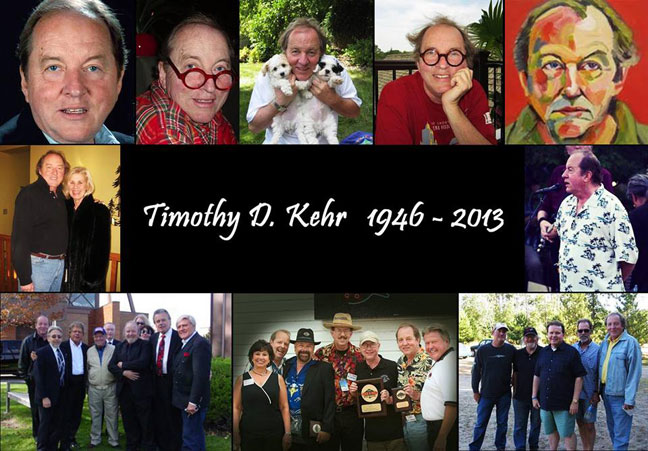
Collage from The Minnesota Museum of Rock & Roll History Facebook Page
Save
There are many articles, websites, and videos that tell the story of Tiny Tim and his career. This page focuses on his life and death in Minneapolis.
Herbert Buckingham Khaury was born in New York in April 1932. He came to national prominence when he appeared on the very first episode of “Rowan and Martin’s Laugh-In,” on January 22, 1968. He only had one “hit song,” but it was a big one – a 1920s chestnut, “Tip Toe Thru the Tulips.”
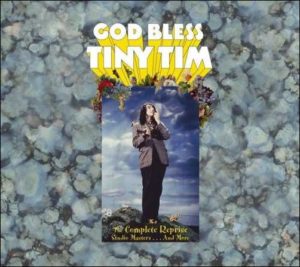
LOCAL PERFORMANCES
On October 18, 1968, Tiny Tim played the Metropolitan Sports Center. Local band the Sir Raleighs opened up the concert, which also included Joe Tex; Tommy Boyce and Bobby Hart; and the Young Rascals as the headlining act.
David Hicks remembers:
I was an usher for Bob Sims (who had the ushering concession) from 1966 to 1971 and I saw many of these concerts. The Tiny Tim concert at Met Center was sort of neat to me. He entered the stage (the stage was not at the end of the arena but on the side right in front of the hockey benches) with the lights out from one of the entrances for the hockey team and I was asked to escort him to the stage. He had a wireless microphone which was quite new at the time, and was talking to the crowd in an eerie voice as we entered the arena. There I was walking with Tiny Tim escorting him by the elbow from the dressing room to the stage. For a 17 year old kid it was quite a thrill.
WINTER CARNIVAL 1970
The WDGY Winter Carnival Spectacular, February 4, 1970, was a “terrible flop,” according to the Insider, with less than 1,500 in attendance. Performing were Tiny Tim, Al Martino, and Johnny Nash. The Cowsills were also mentioned in the brochure. Arne Sagarsky was the booker of the show.
A blurb in the Tribune dated February 15, 1970, reported that the Tiny Tim show lost $10,000, but the loss went to the promoter (presumably Sagarsky) and not the Winter Carnival. Only 1,000 attended his show, despite his recent appearance on Laugh-In. Maybe all the performers were at the same show and the reporter was blaming it on Tim?
COMPETING EVENTS
On January 6-10, 1971, Tiny appeared at the International Auto Show ’71 at the Minneapolis Convention Hall. WDGY advertised the show on its 30 Star Survey. Appearing with Mr. Tim would be Miss Vicki, Pat Butram (sic) (Mr. Haney on “Green Acres”), and Barnabus and Donna Wandrey from “Dark Shadows.”
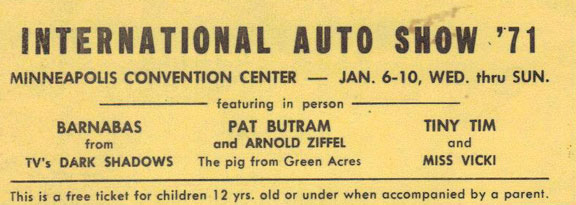
On the last day of the Auto Show, January 10, 1971, Tiny Tim was booked at the Depot. After a week where people could get to see him for free, not to mention seeing him on KSTP-TV’s “Dial 5” program, this may not have been the smartest move.
And, as would be expected, by all accounts this show was poorly attended. Tiny didn’t care, telling Star reviewer Scott Bartell that “even if there’s only one person – the tables and chairs are listening.” Tiny was interviewed by local TV columnist Forrest Powers, where it was revealed that Miss Vicki was pregnant and that Mr. Tim had not been asked back to “Laugh-In,” the show that launched his career.
But according to Bartell, it wasn’t necessarily a bad show – in fact, he called it “funny and engrossing.”
He began with “The Waltz of the Bells” and “The Good Ship Lollipop.” Then he brought the band in for a super-long medley beginning with a World War I tune asking war critics, “What kind of American are you?,” switching to “Bad Moon Rising,” and proceeding through a very mixed bag of perhaps a dozen more fragments of songs. … He gives different treatment to all his songs — relative reserve on older tunes; writhing on the floor and throwing his necktie away on “Great Balls of Fire,” singing “Yankee Doodle Dandy” through a bullhorn to get the old Victrola effect – yet he stamps each song with his own identity and people can’t help laughing and enjoying themselves.
At the same time he commands a strange respect – perhaps for sheer guts, but also because he does some things very well. For instance, he manages a duet with himself, imitating Sonny and Cher on “I’ve Got You Babe.” I guess it is that ambiguity that makes his work so captivating.
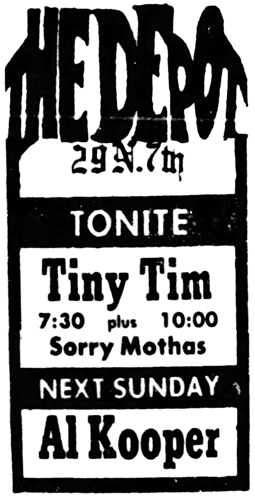
Tiny Tim had bottomed out in 1992, and moved to Des Moines to be near his new manager, local promoter Steve Plym. He was still there in January 1995.
In September 1996 Tiny performed at Lee’s Liquors in Minneapolis.
MISS VICKI
Tiny Tim married “Miss Vicki” on The Tonight Show on December 17, 1969. The event was watched by 40 million people (84 percent of the viewing audience in New York City, cited David Richards of the Washington Post). Victoria Budinger, age 17 at the time, later revealed that the marriage was a “loveless sham.” The couple had a daughter named Tulip Victoria in 1971, separated in 1972, and divorced in 1977.
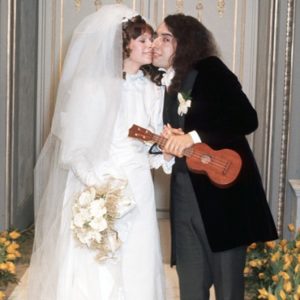
Tiny Tim marries Miss Vicki
Locally, record store owner Don Leary capitalized on the event by placing this ad in the Minneapolis Star: (thanks to Bill Roy for the find!)
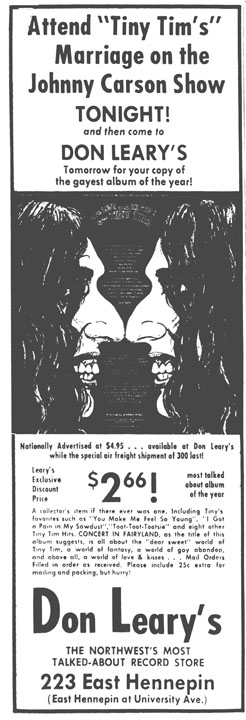
MISS JAN
A 1984 article reported that Tiny Tim was down on his luck and he was about to embark on a tour with a circus in Illinois. He told reporter Bill Stokes that he had been secretly married on June 26, 1984, to Jan Alweiss, but the marriage was being annulled because he refused to have sex with her unless it was to create children, and she didn’t want to have kids. He remarried Miss Jan at a horror theme park on Halloween, 1994, on The Tonight Show With Jay Leno, but they divorced in June 1995.
MISS SUE
On August 18, 1995, Tiny, at age 60, married his third wife, Miss Sue (Susan Marie Gardner), a 39-year-old Harvard honors graduate. The wedding was held in a Catholic church in Minnetonka with 700 guests and scores of TV reporters in attendance. Sue spent her early childhood in Minnetonka and Hopkins, with pictures of Tiny Tim plastered on her walls. The family summered in the Twin Cities and spent winters in the San Diego area. In 1975, when Sue was 19, her mother Janice died of cancer; Janice had met her husband of 28 years at St. Louis Park High School.
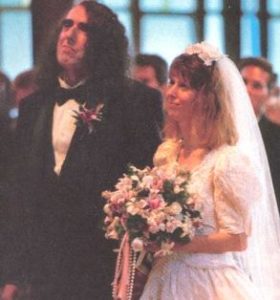
Tiny Tim marries Miss Sue
Miss Sue had an exceptional sensitivity to chemicals; in an August 23, 1995, Sun-Sailor reporter Jay Maxwell noted that she was living in a hotel in Eden Prairie – Tiny lived in another room in the same hotel – until their new house was rid of any materials that would irritate her condition. Filmmaker Max Sparber identified the house as 5145 Zenith Ave. So. in Minneapolis.
THE DEATH OF TINY TIM
On September 28, 1996, Tiny collapsed and fell from a stage after a heart attack just as he began singing at a ukulele festival [Ukulele Hall of Fame] at the Montague Grange Hall in Montague, Massachusetts. He was hospitalized at the nearby Franklin County Medical Center in Greenfield for 11 days before being discharged with instructions not to perform again because of his health. His response was “If I live 10 years, it’s a miracle. Five years, it’s even more of a miracle. I am ready for anything that happens.”
Sparber noted that Tiny performed for a free meal at the Lincoln Del in St. Louis Park a week before he died. Fishman’s Deli, the successor to the Lincoln Del, was said to have a photo on its wall of him buying a large sausage, taken at that visit.
Sparber says that Tiny’s penultimate performance was for the Minneapolis League of Catholic Women.
While playing at a gala benefit at the Woman’s Club of Minneapolis on November 30, 1996, Tiny had a heart attack on stage. This account was on the Internet but the origin is unclear.
Tim almost fell coming up the marble staircase and Miss Sue tried to support him. Miss Sue asked him how he was feeling and Tiny told her he wasn’t taking his medicine (he had a habit of this). There was a lovely dinner, but Tiny didn’t eat much. After the meal, Tiny was introduced to the bandleader, and was given a very cold reception. The bandleader didn’t know Tim was to perform that night. He refused to have his band back Tiny on stage saying the band didn’t know the songs. Tiny asked, “You don’t know I’m Looking Over a Four Leaf Clover?” Tim was told he would have to play without accompaniment. Tim would be called to perform at 9:00 PM. 9:00 arrived, then 9:30 and 10:00 went by and he still hadn’t been called to perform. Sue wanted to get her stepmother and tell her that Tiny was going home, because he was exhausted and didn’t feel well. Sue’s stepmother went to find the lady in charge. The bandleader called a break without introducing Tiny. It was a terrible insult to him. A guest vocalist should always be introduced at the end of a set, when the crowd is warmed up. The crowd had filtered out of the room leaving on a few people. This was a deliberate insult by the bandleader. The lady who ran the affair went up to the microphone and introduced Tiny to an empty room. Tiny got up and stood at the microphone. The cords were tangled around his feet and his ukulele was out of tune.
Tim was sick but didn’t want to disappoint the guests. People were applauding him. Sue went to take his arm because of the uneven footing and because she could see him shaking. He waved and blew kisses to the audience, something Tim always did at the end of every show. Sue took Tim’s arm and asked if he was all right. He just stood there and said, “No, I’m not.” Those were the last words he ever spoke. Tim collapsed on the stage. A doctor started CPR. The ambulance was there in a matter of minutes. They worked on him for half-hour, there on the floor. The EMT’s told Miss Sue that Tim would probably not make it, but Sue already knew that. They worked on Tim for another hour and fifteen minutes at the Hennepin County Medical Center before they gave up. Miss Sue was with him when he died.
The Star Tribune reported that over 700 people attended Tiny Tim’s funeral at the Basilica of St. Mary in Minneapolis on Wednesday, December 4, 1996. Footage can be seen Here.
There was a cast of characters that could have filled a Dickens novel. Women in long fur coats, women in black leather jackets, one guy in a Vikings jacket, another in a purple business suit, a bag lady with her cart in tow, children in their Sunday best, men with dreadlocks, women with beehives. They came to honor the ukulele player with fluttering falsetto voice and Dickensian name, Tiny Tim.
The mass featured the playing of Tiny’s song “Sunshine Cake” from a 1971 children’s album. “Everyone called him Tiny during the service except when the priest said prayers, when he was referred to as Herbert Khaury.” Over 500 people filed past the open casket, where Tiny lay with his ukulele, a stuffed rabbit, his rosary beads, a book about children, and some tulips. All the local an entertainment TV networks were represented. Miss Jan sobbed by the casket.
Tiny Tim’s remains are entombed in a mausoleum in Lakewood Cemetery, Minneapolis.
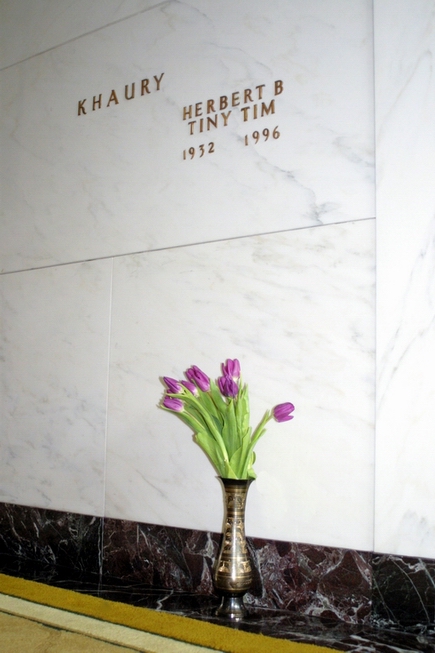
God Bless us all, Tiny Tim.
SOURCES
“Tiny Tim searches for new applause under the big top” – Bill Stokes, Chicago Tribune Service – Onward, October 2, 1984
“Miss Vicki speaks out: My Bizarre Marriage to Tiny Tim” – Hillary Sweeney, Star Magazine, February 28, 1995
“God Help Us Every One – Tiny Tim: Fame, Failure and the American Dream” – David Richards, Washington Post, February 19, 1995
“Engagements: Gardner-Khaury” – Minneapolis Star Tribune, August 3, 1995
“Vases, towels top Tiny Tim’s wedding gift list” – People – Minneapolis Star Tribune, August 1995
“Miss Sue’s marriage is the latest in string of life-altering events” – Jay Maxwell, Sun-Sailor Lifestyle, August 23, 1995
“Third wedding and a … Tiny Tim and Miss Sue are married in Minnetonka” – Jay Maxwell, Sun-Sailor Lifestyle, August 23, 1995
“Unconventional Pop Figure Tiny Tim Dies” – (Associated Press) Washington Post, December 2, 1996
“Characters convene to mourn Tiny Tim” (from staff reports) – Minneapolis Star Tribune, December 5, 1996

